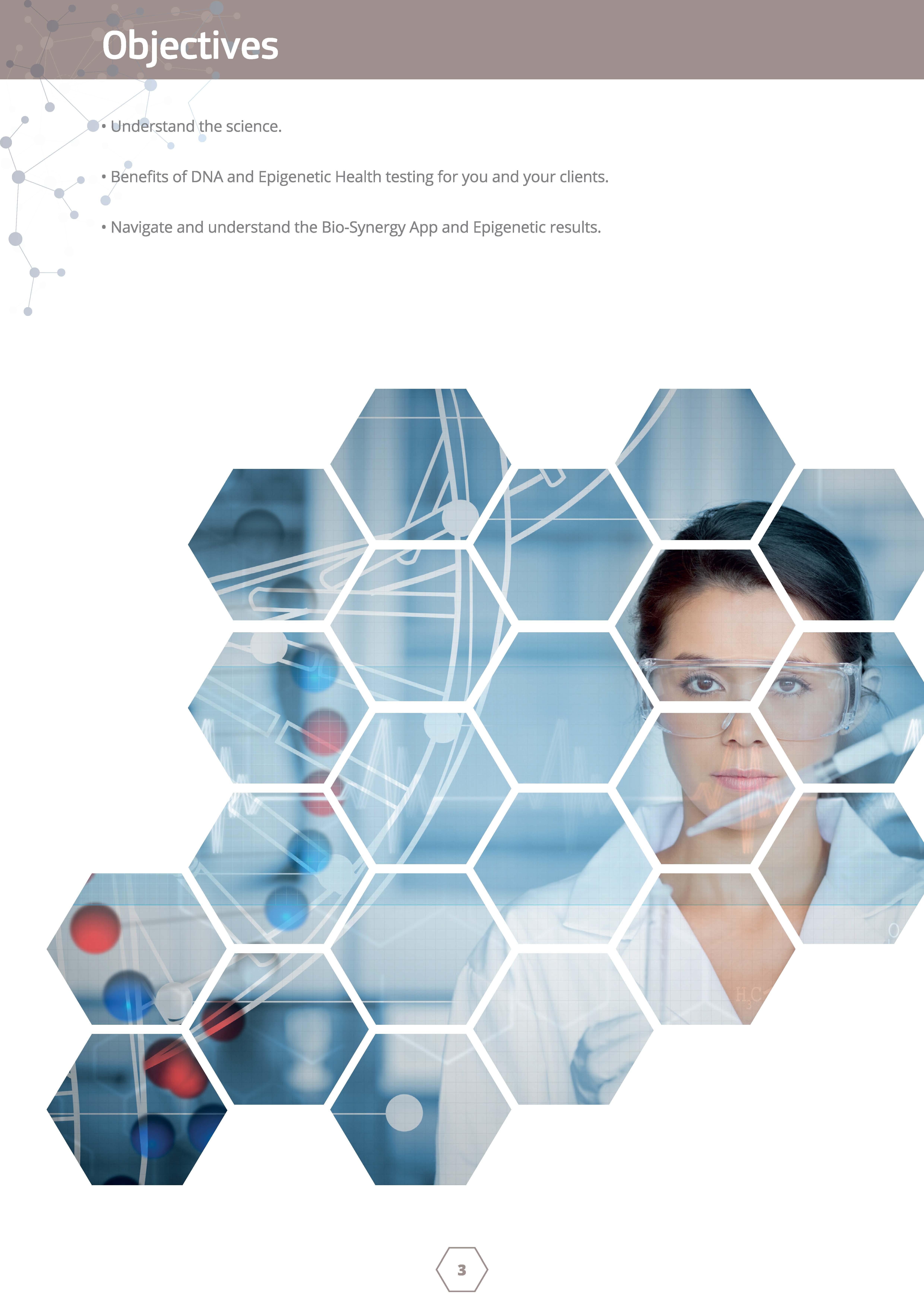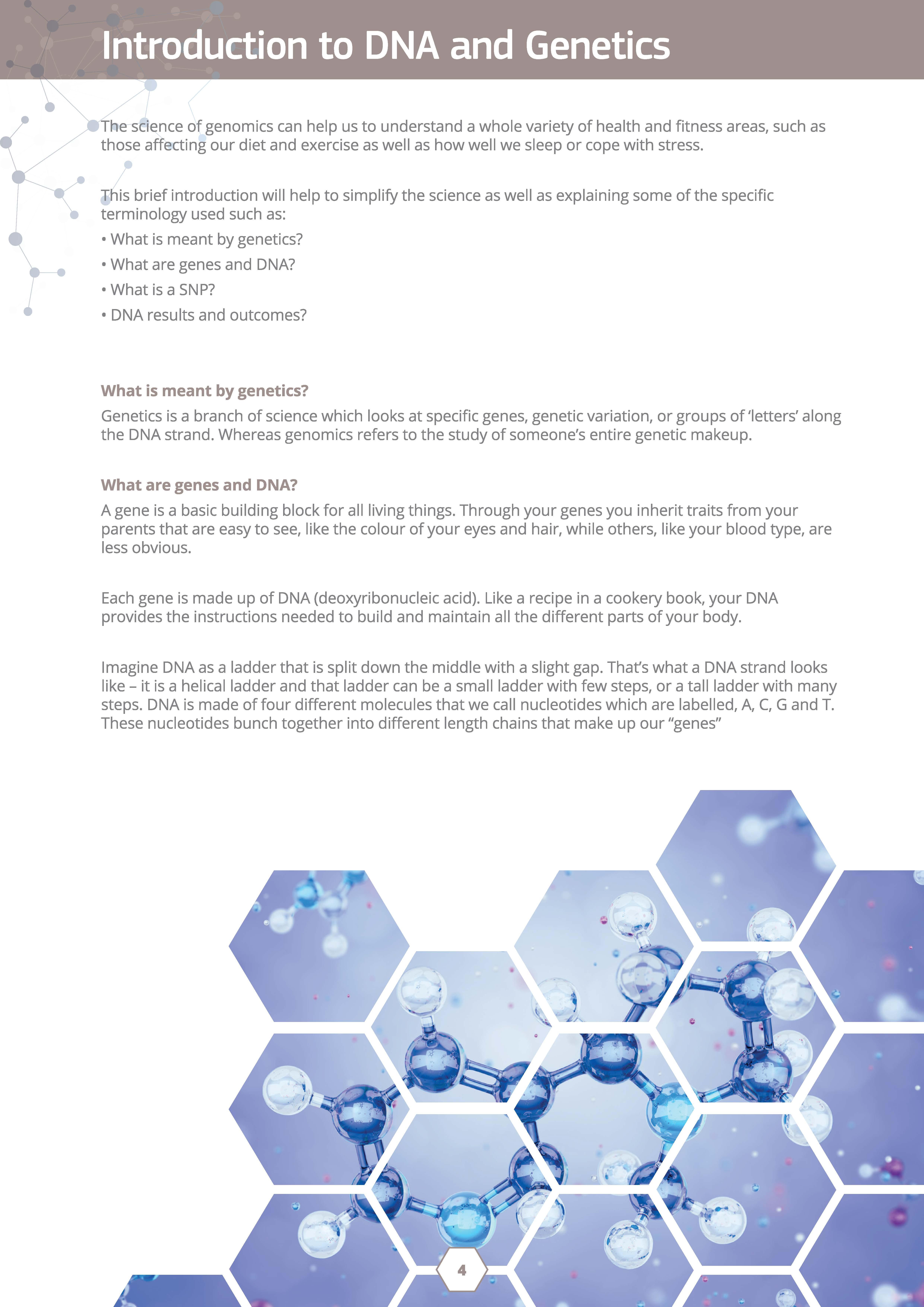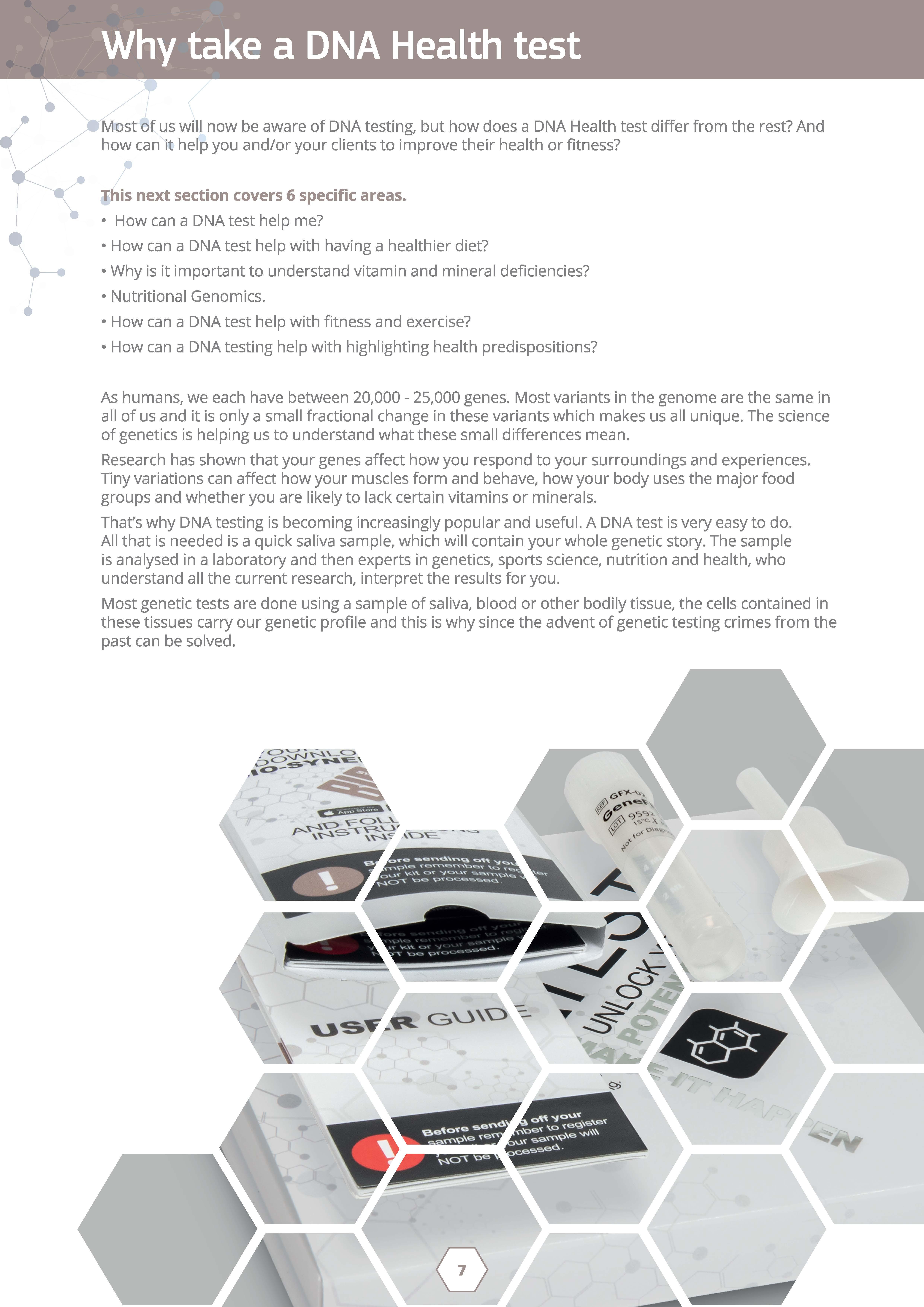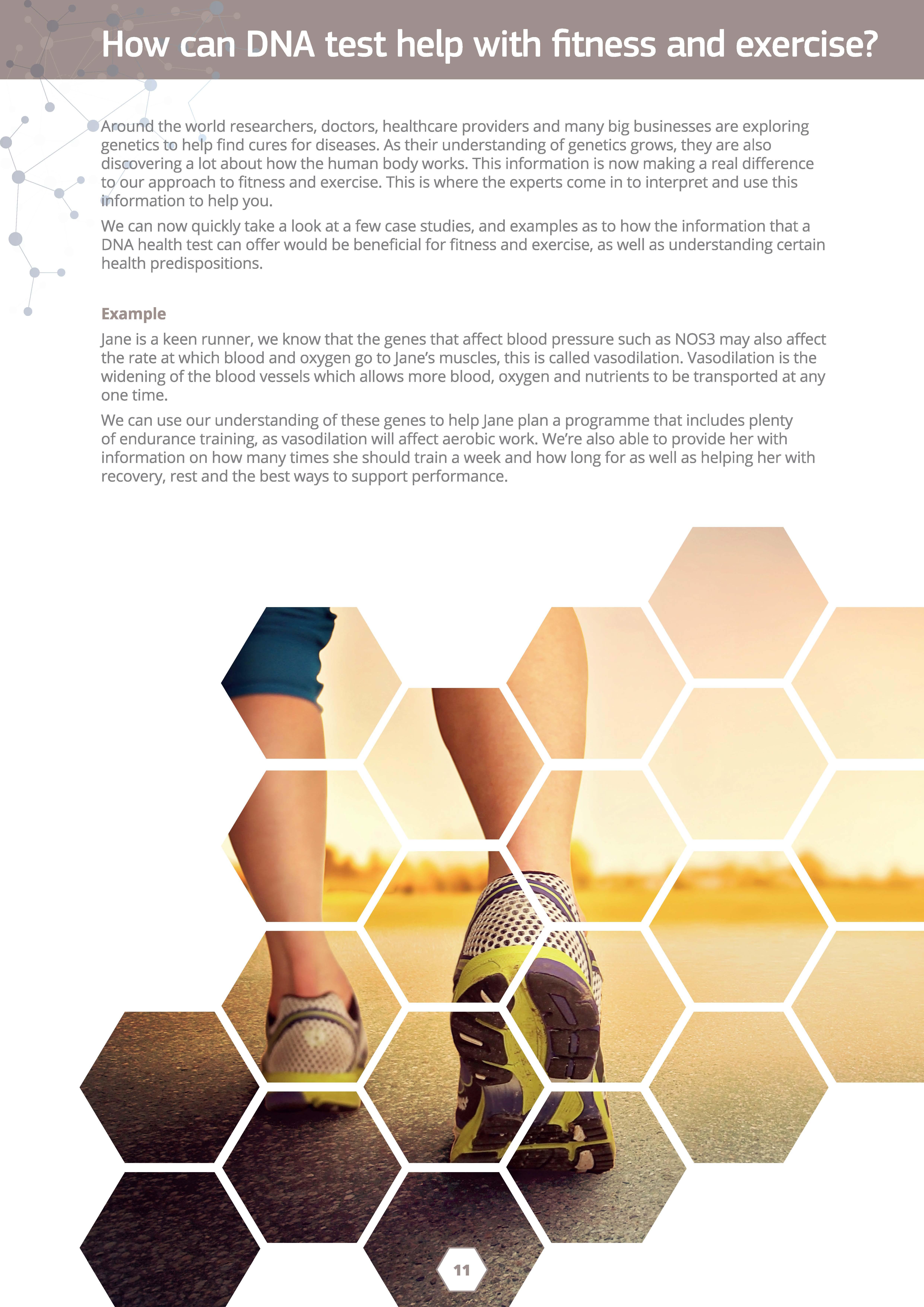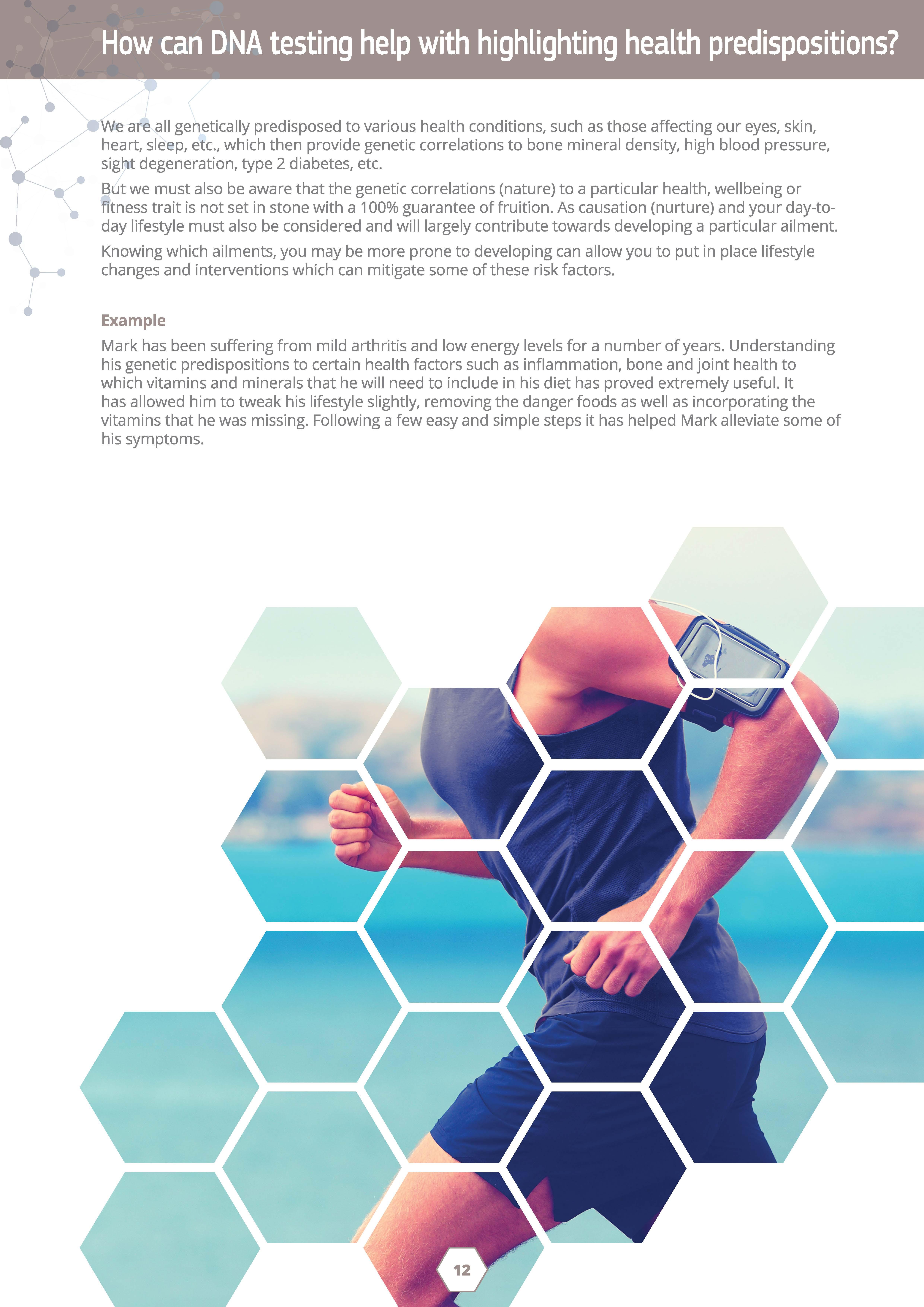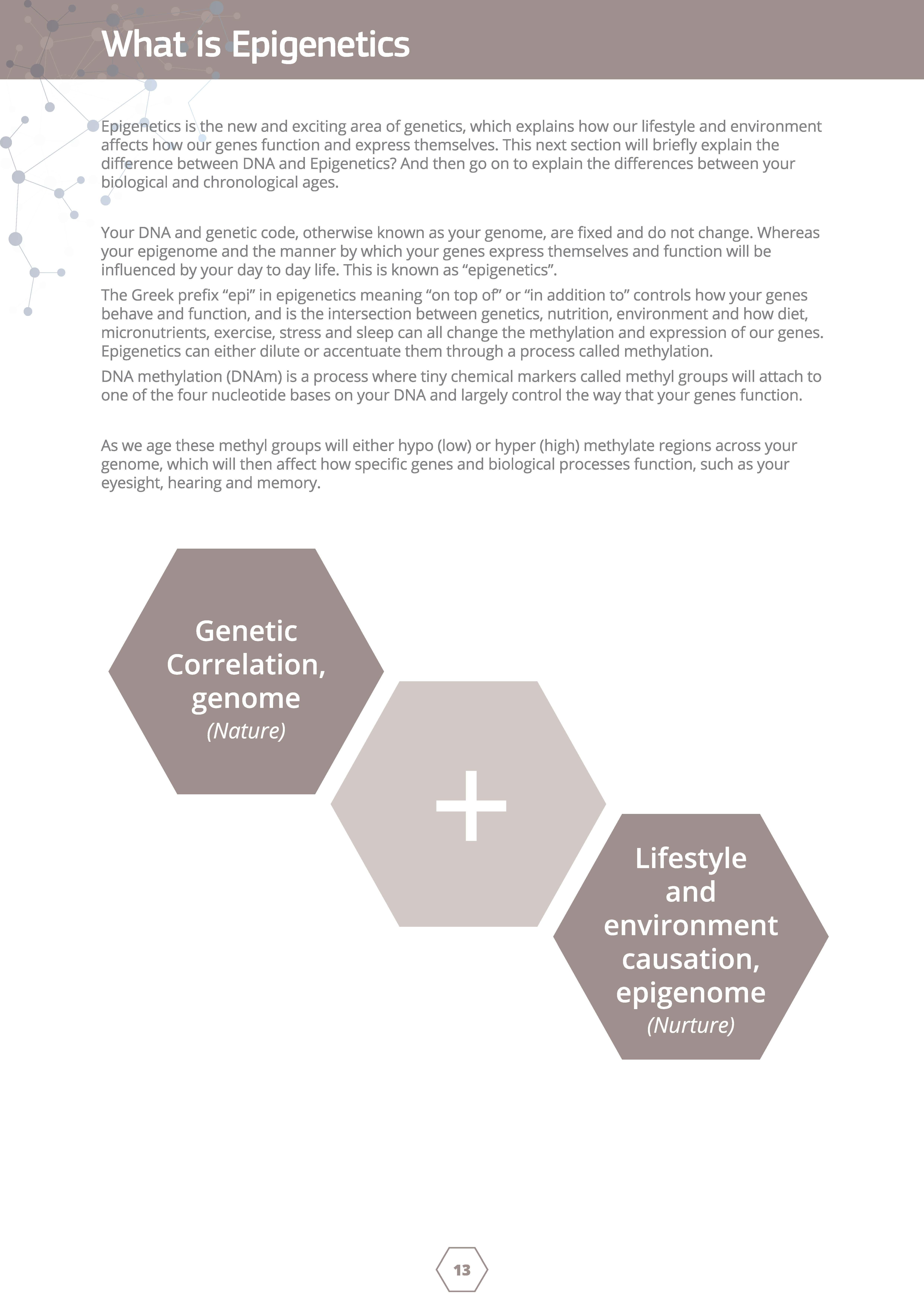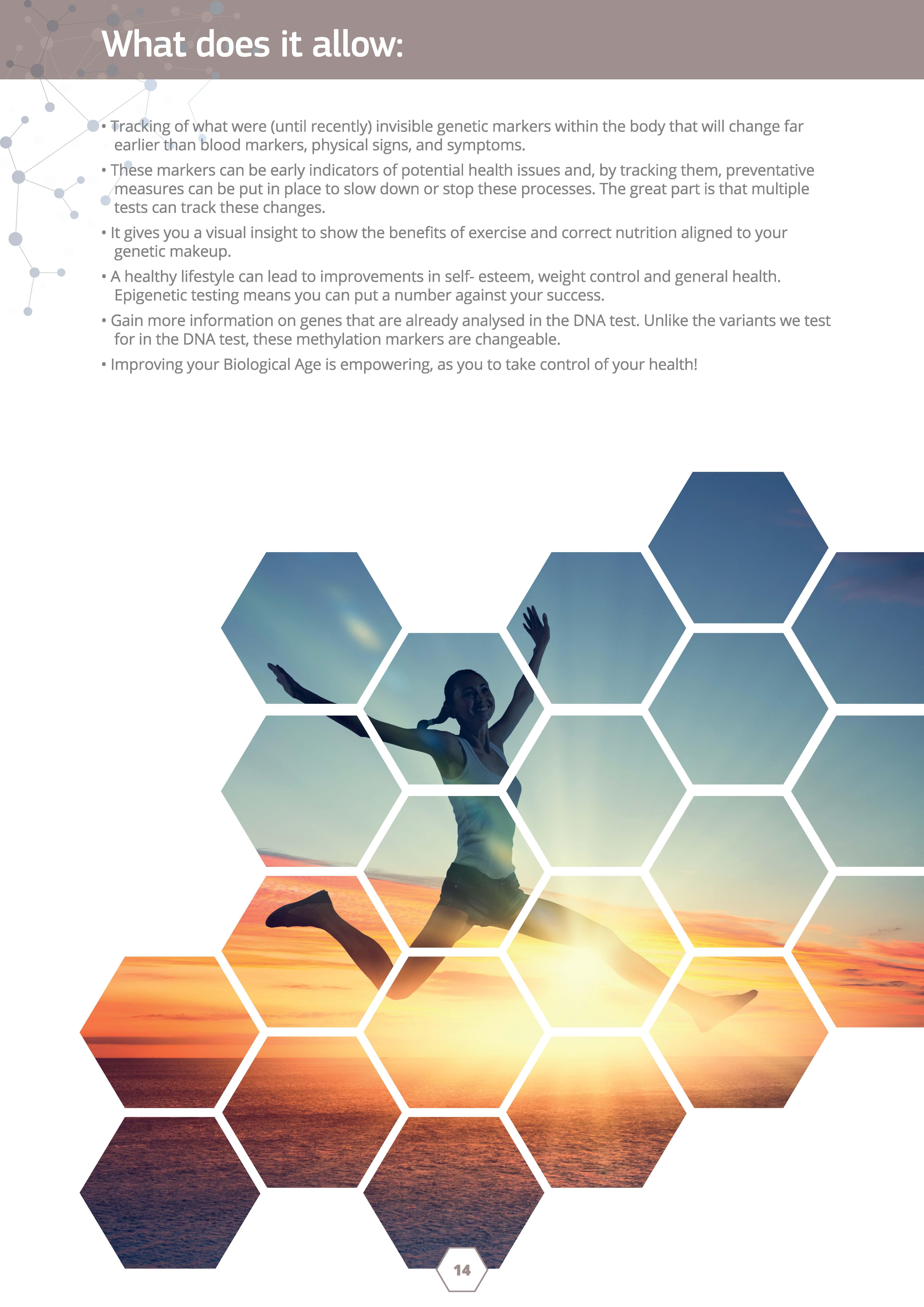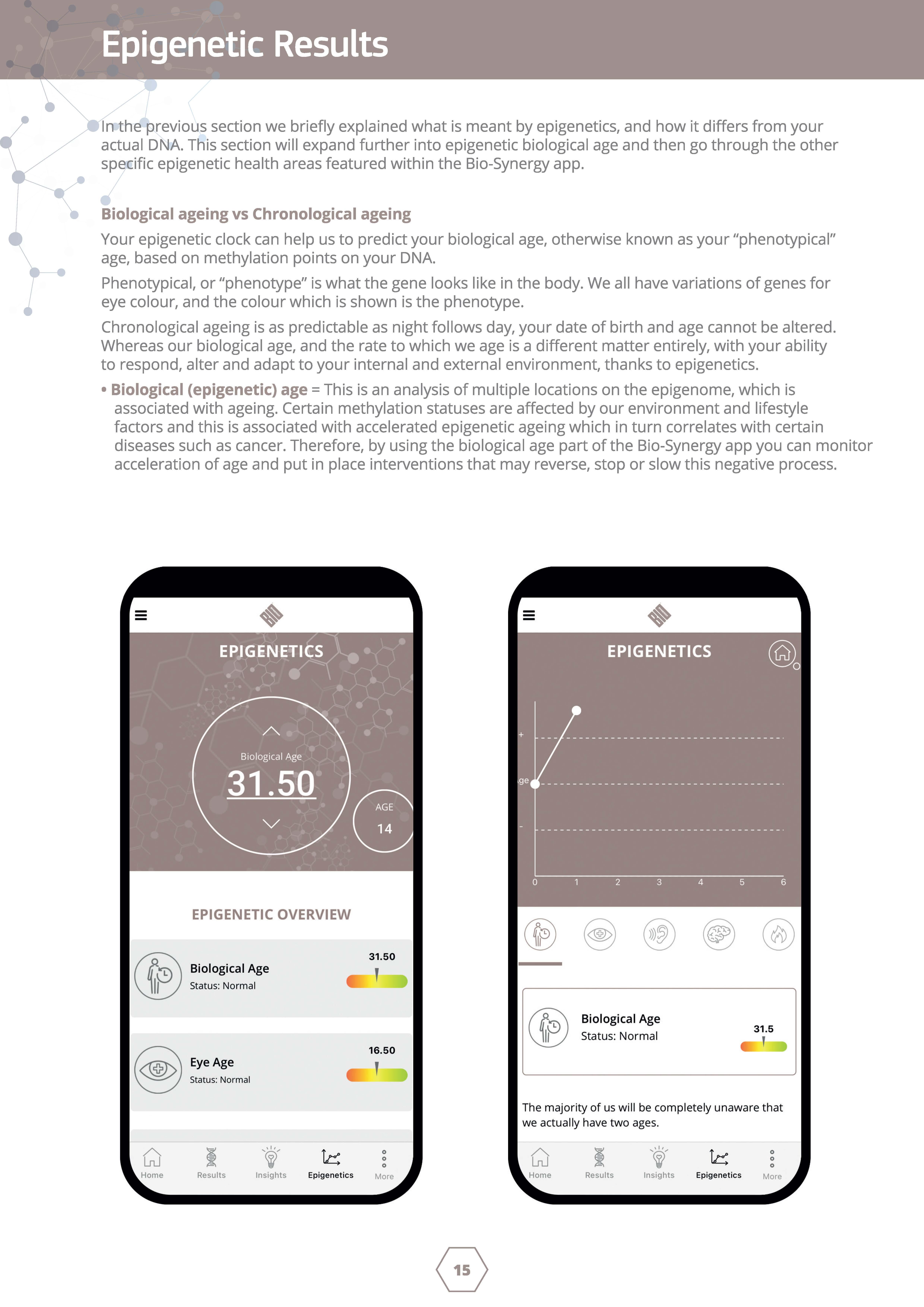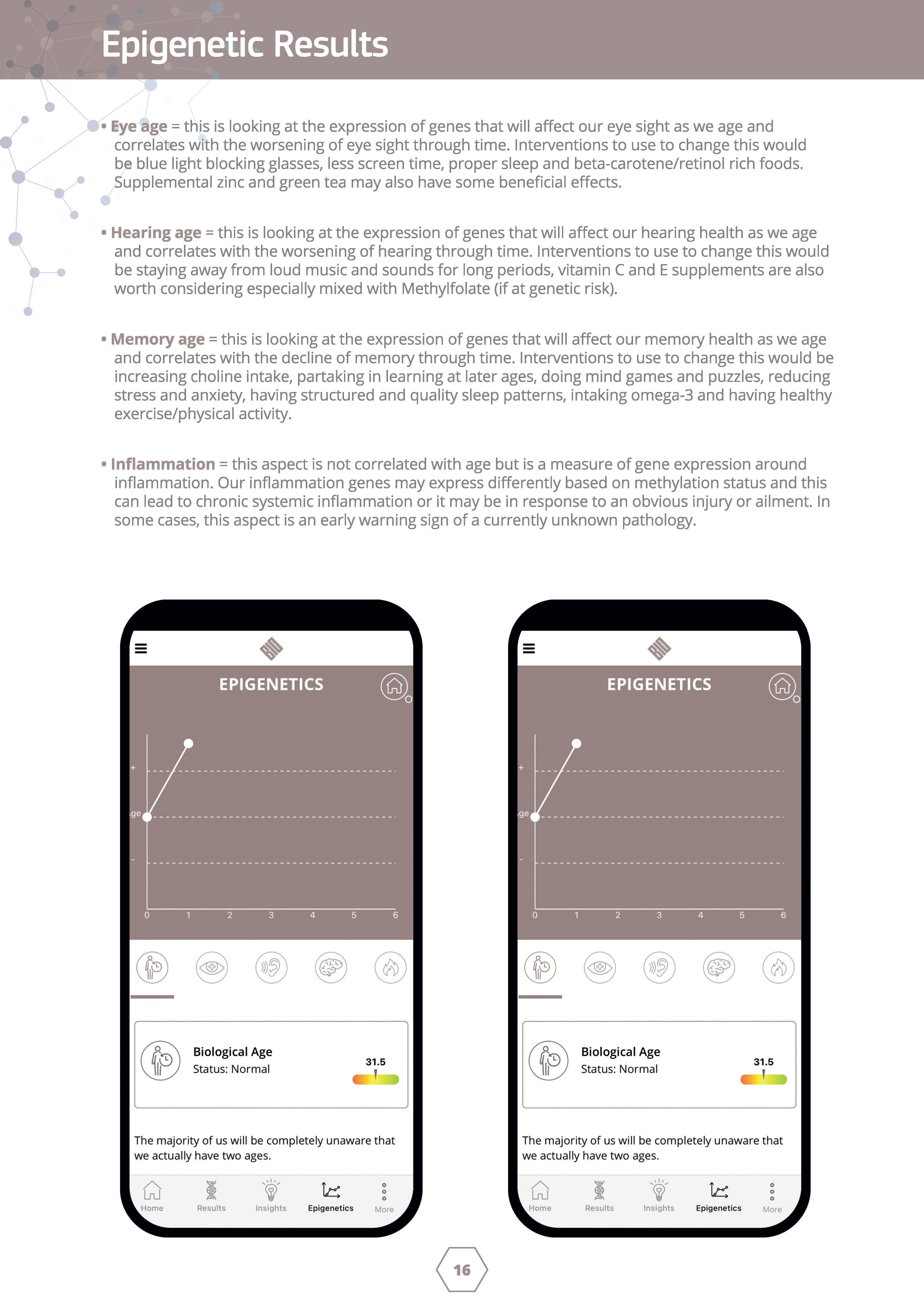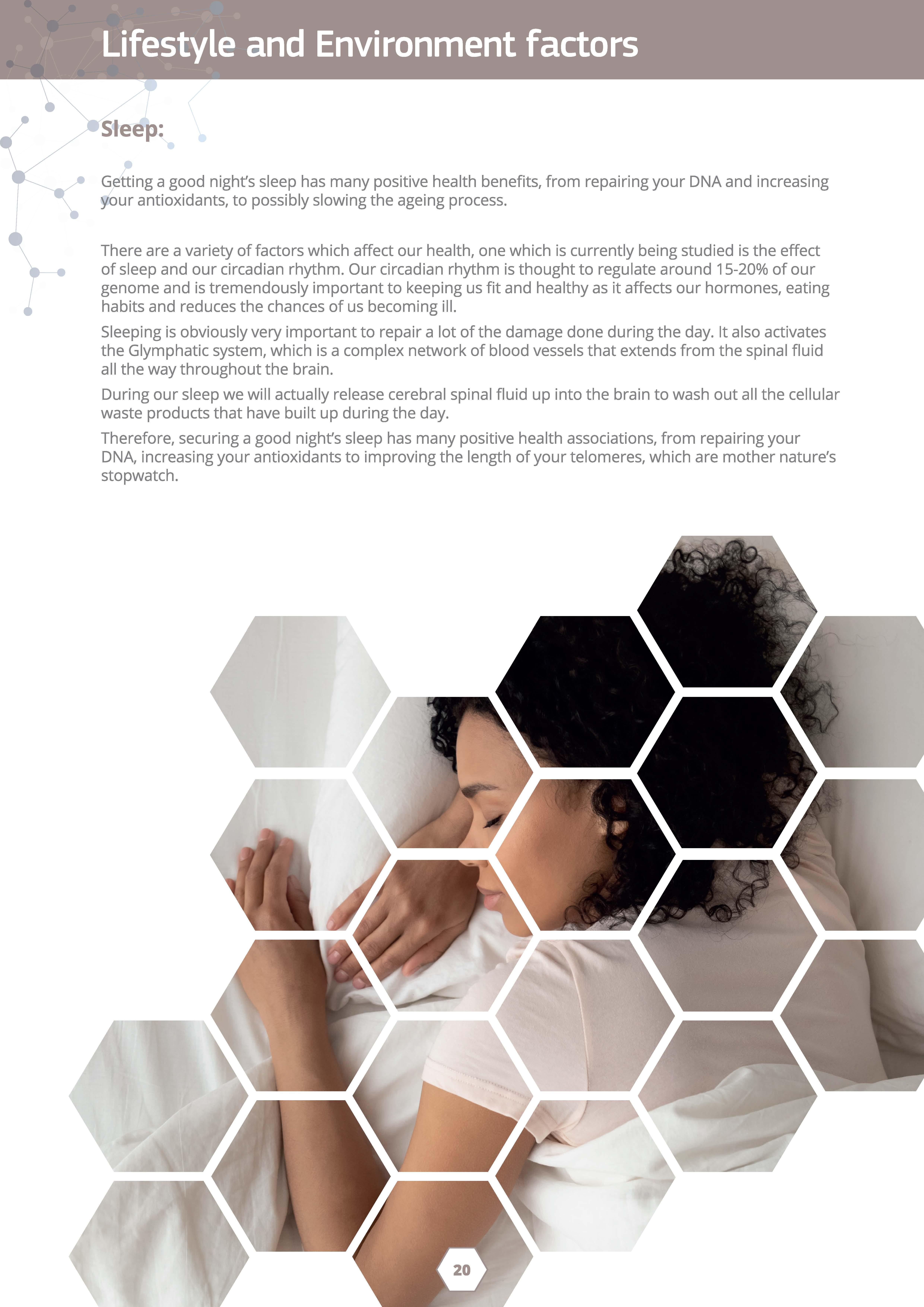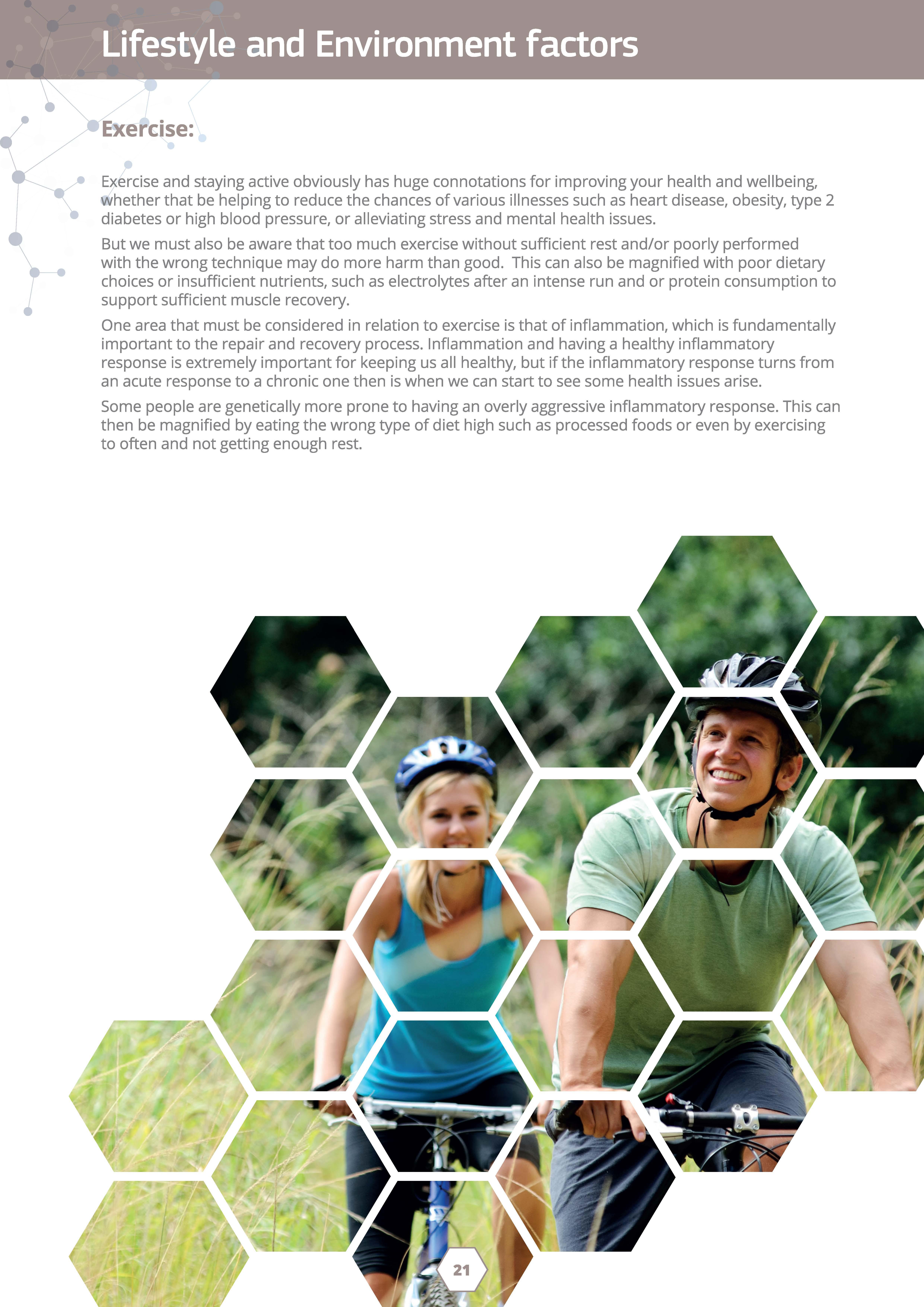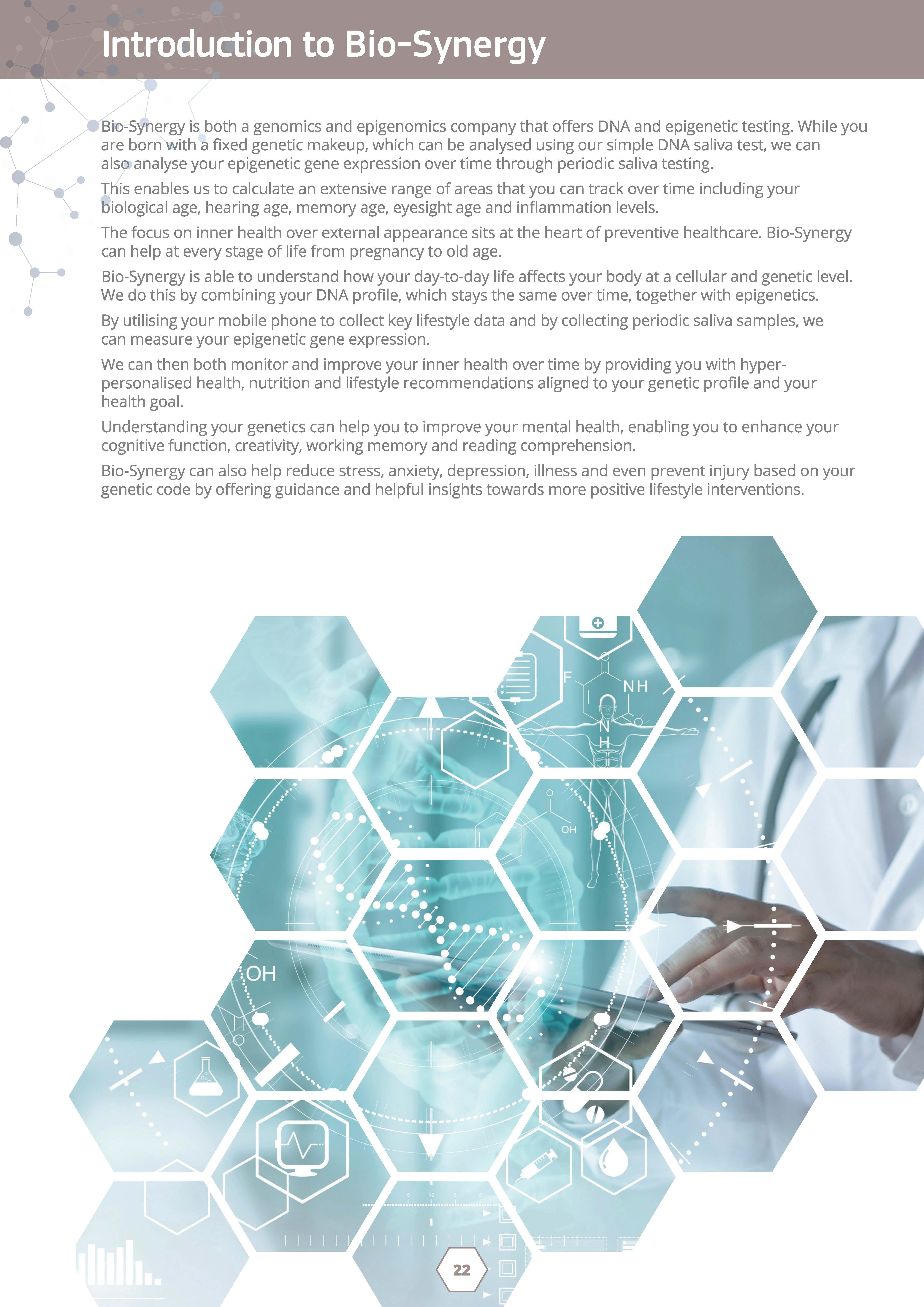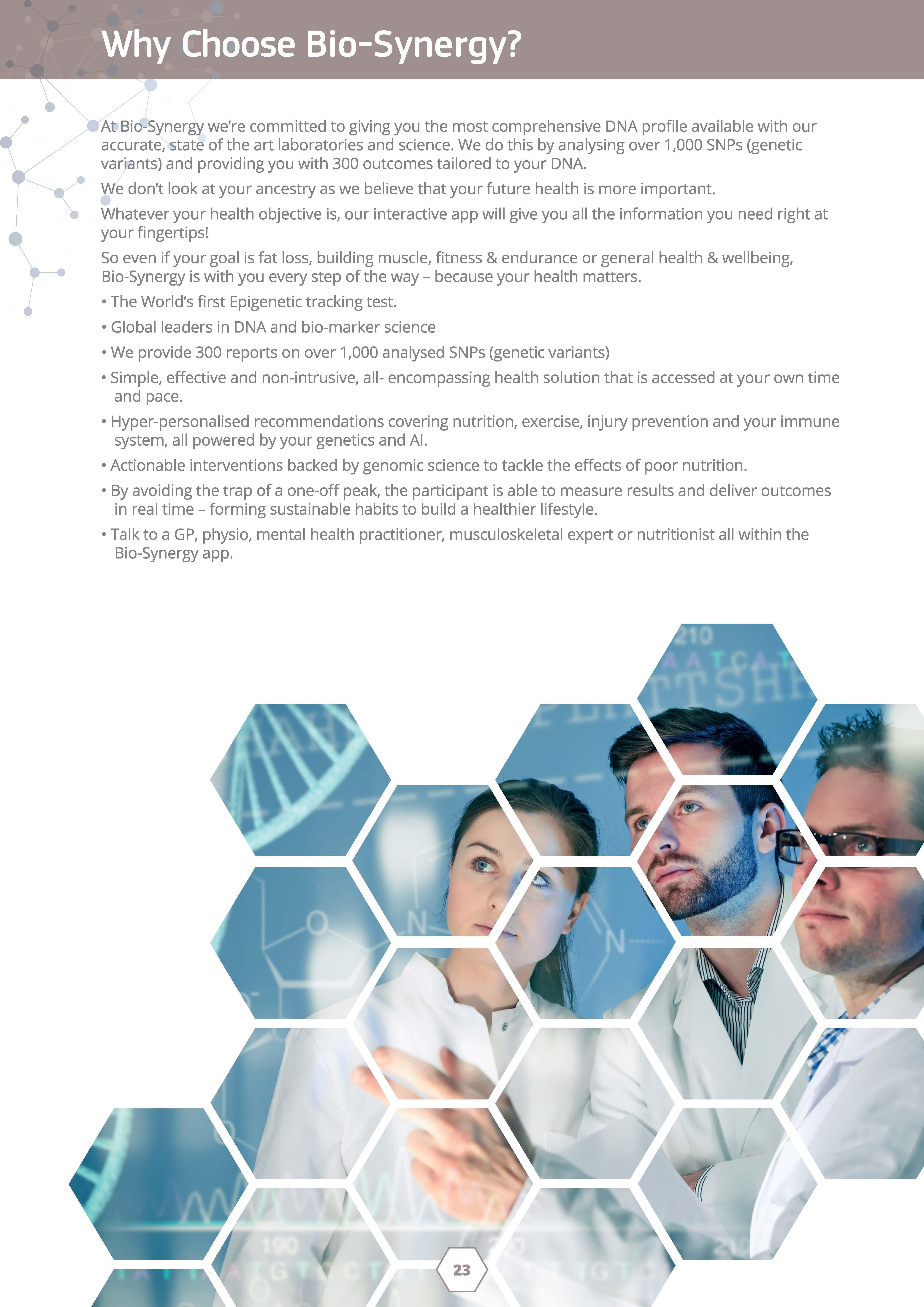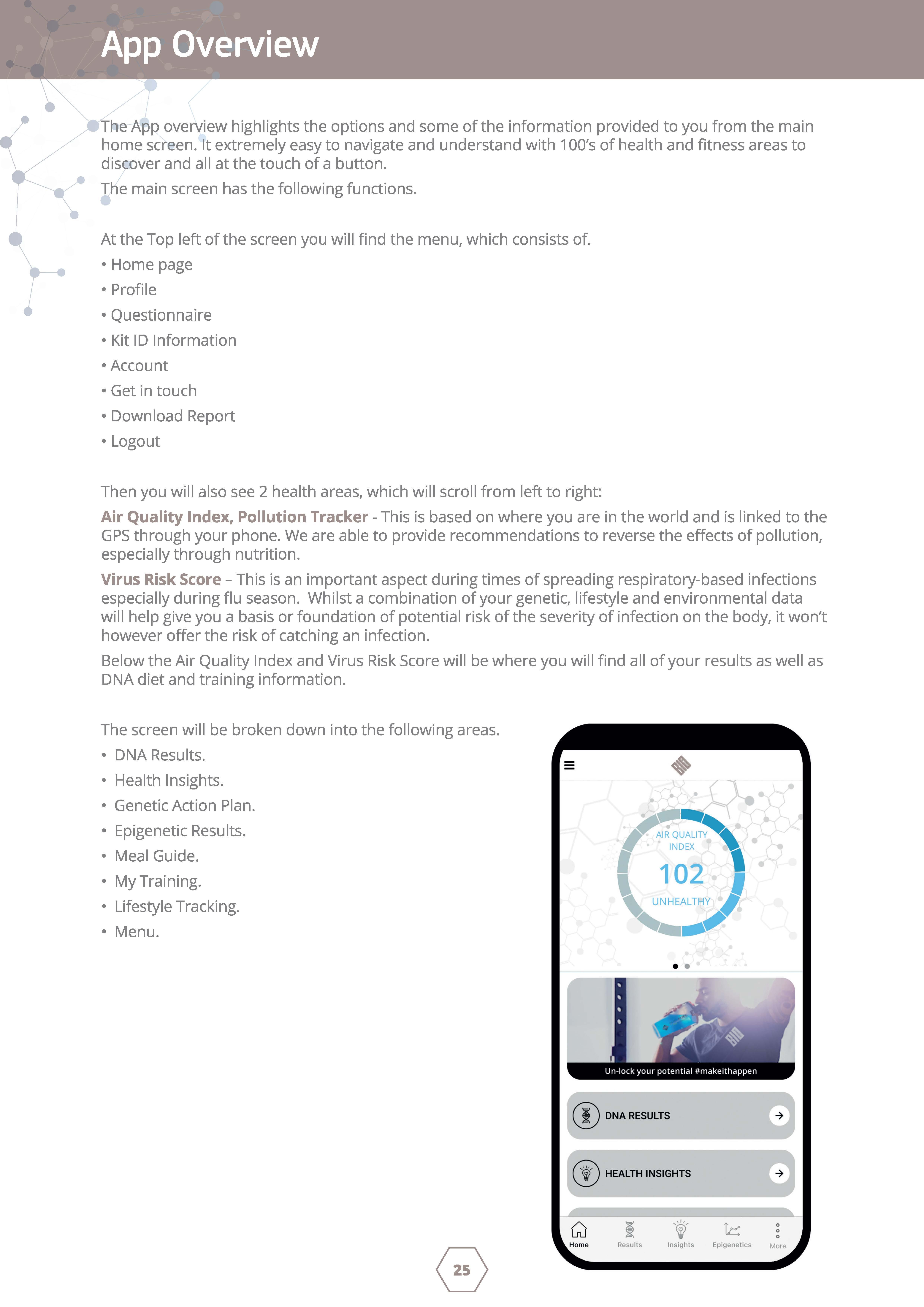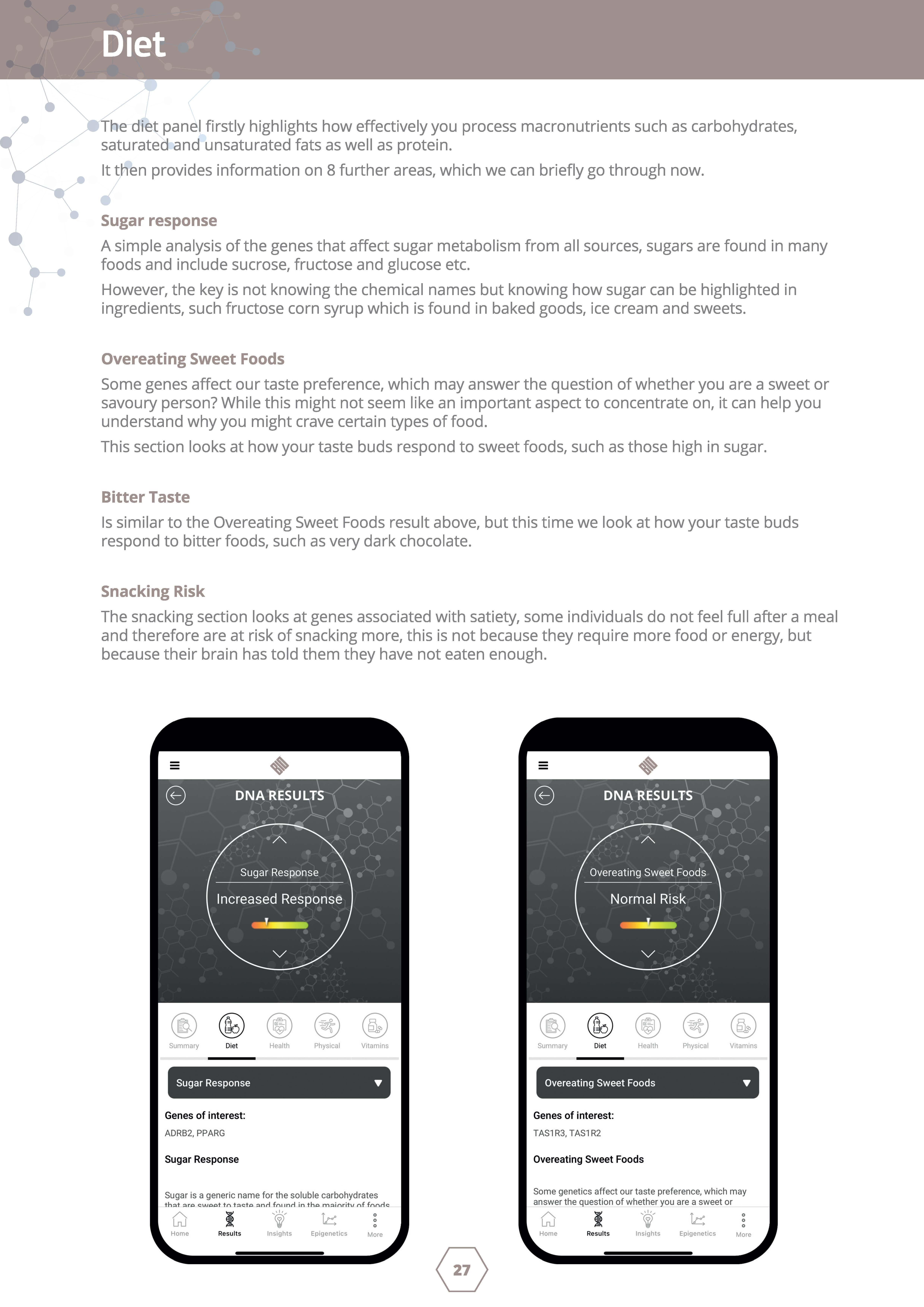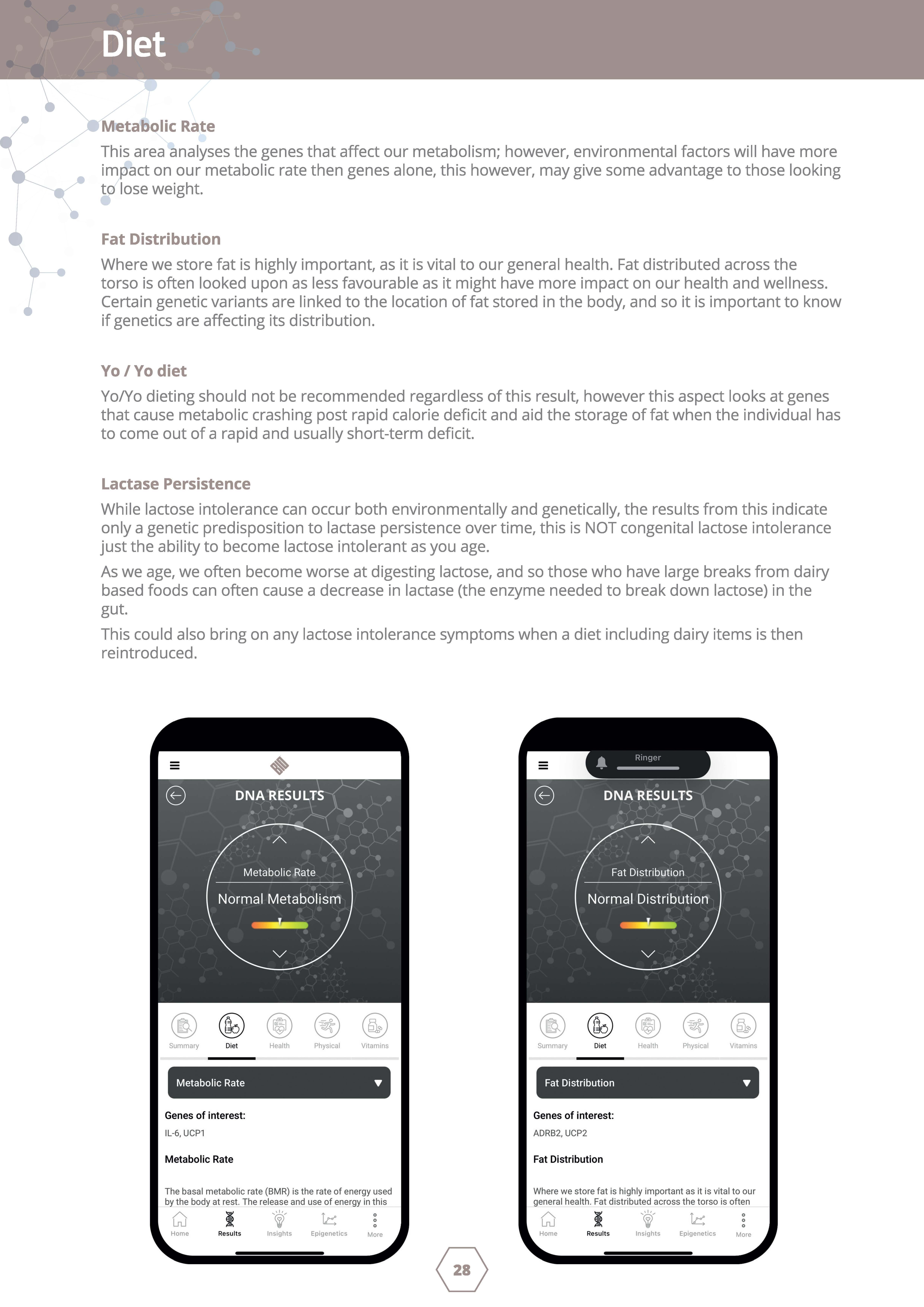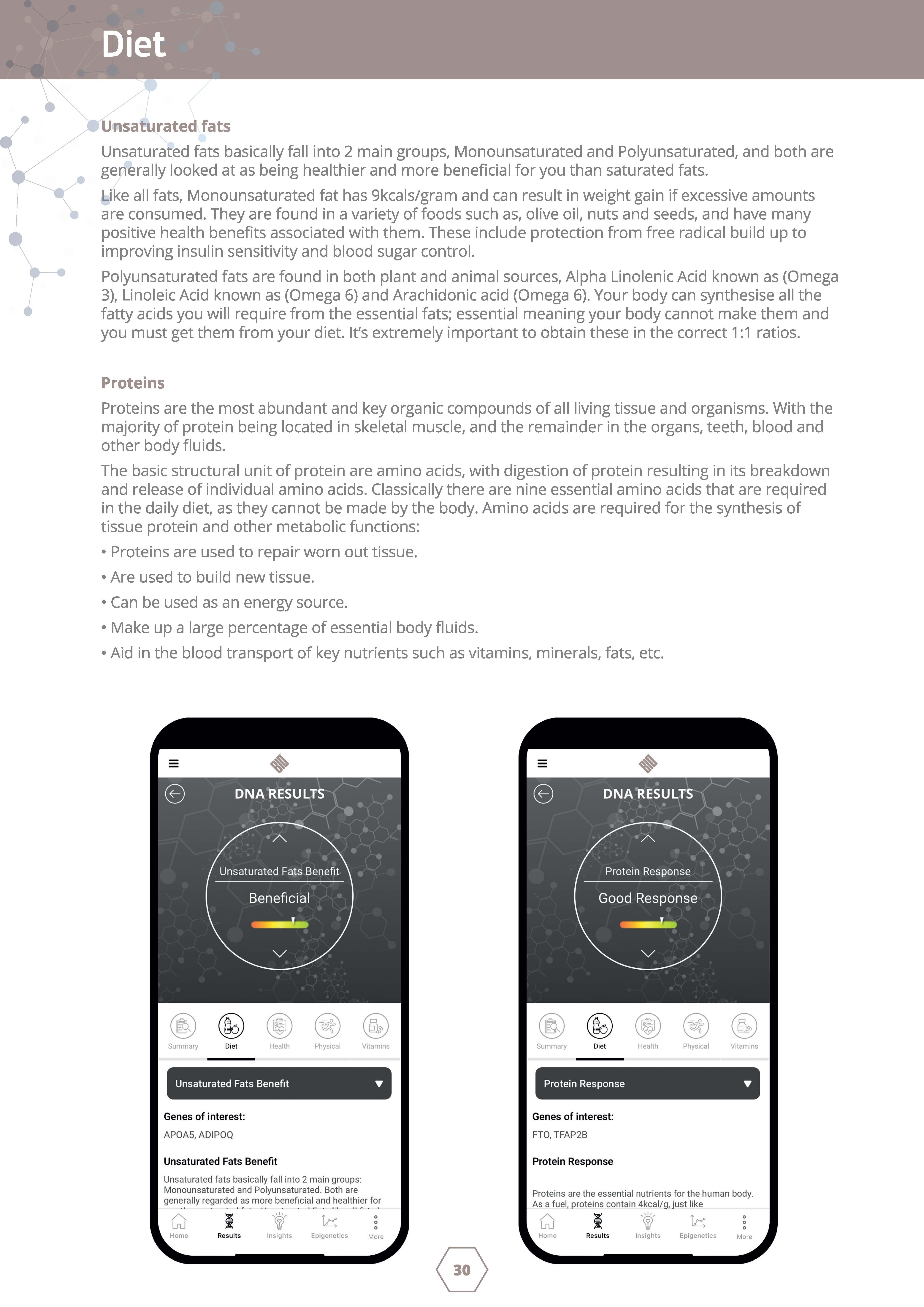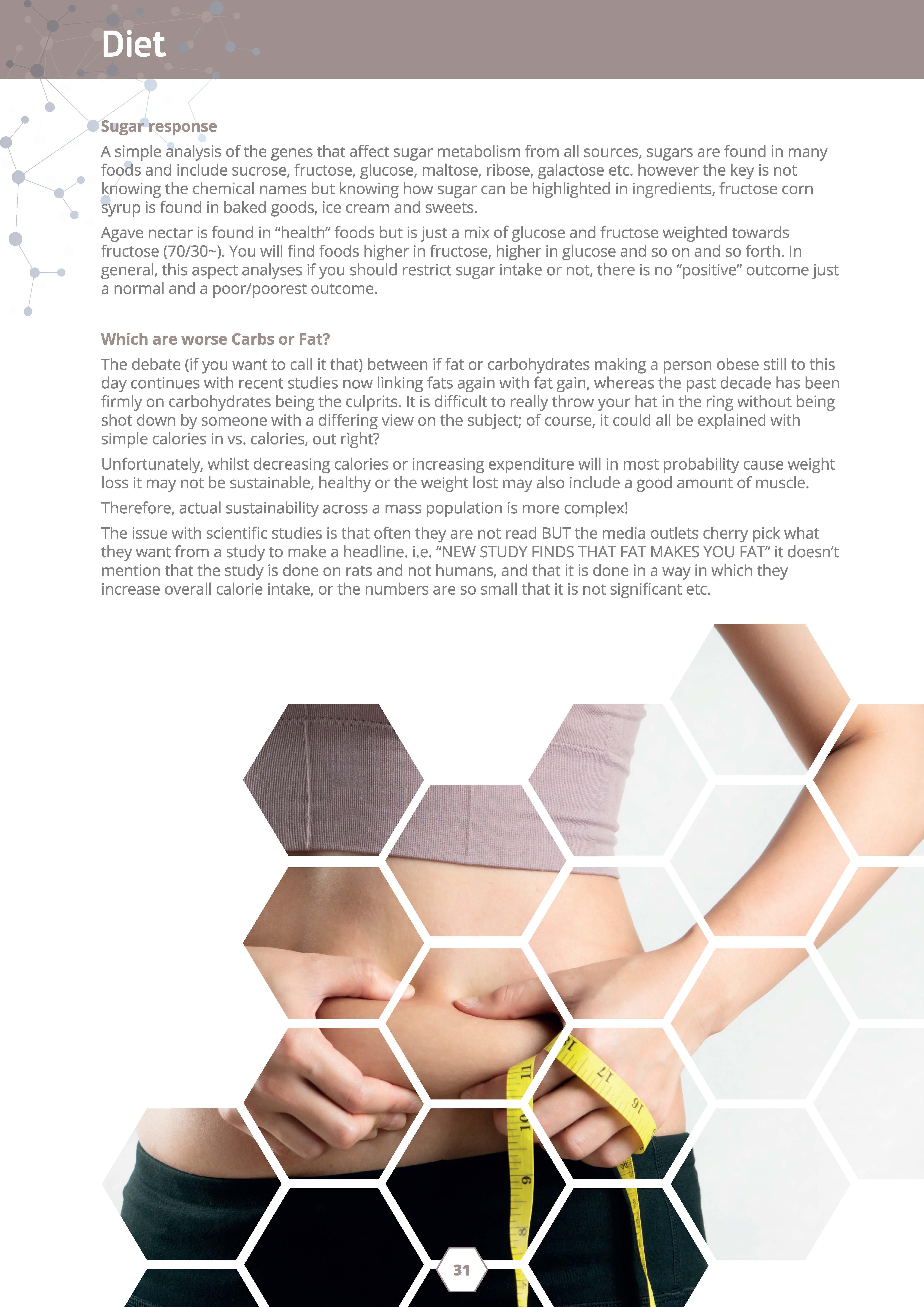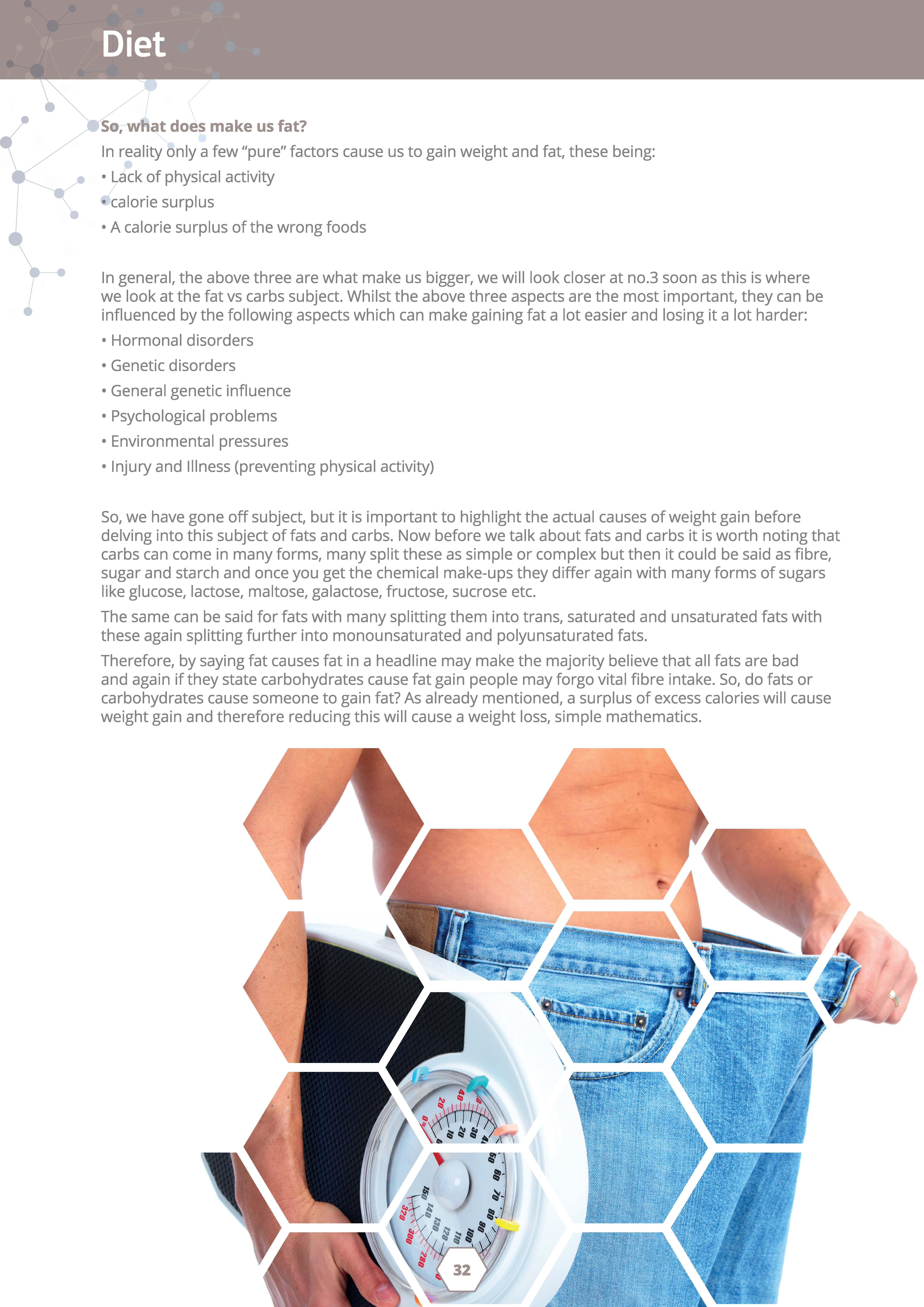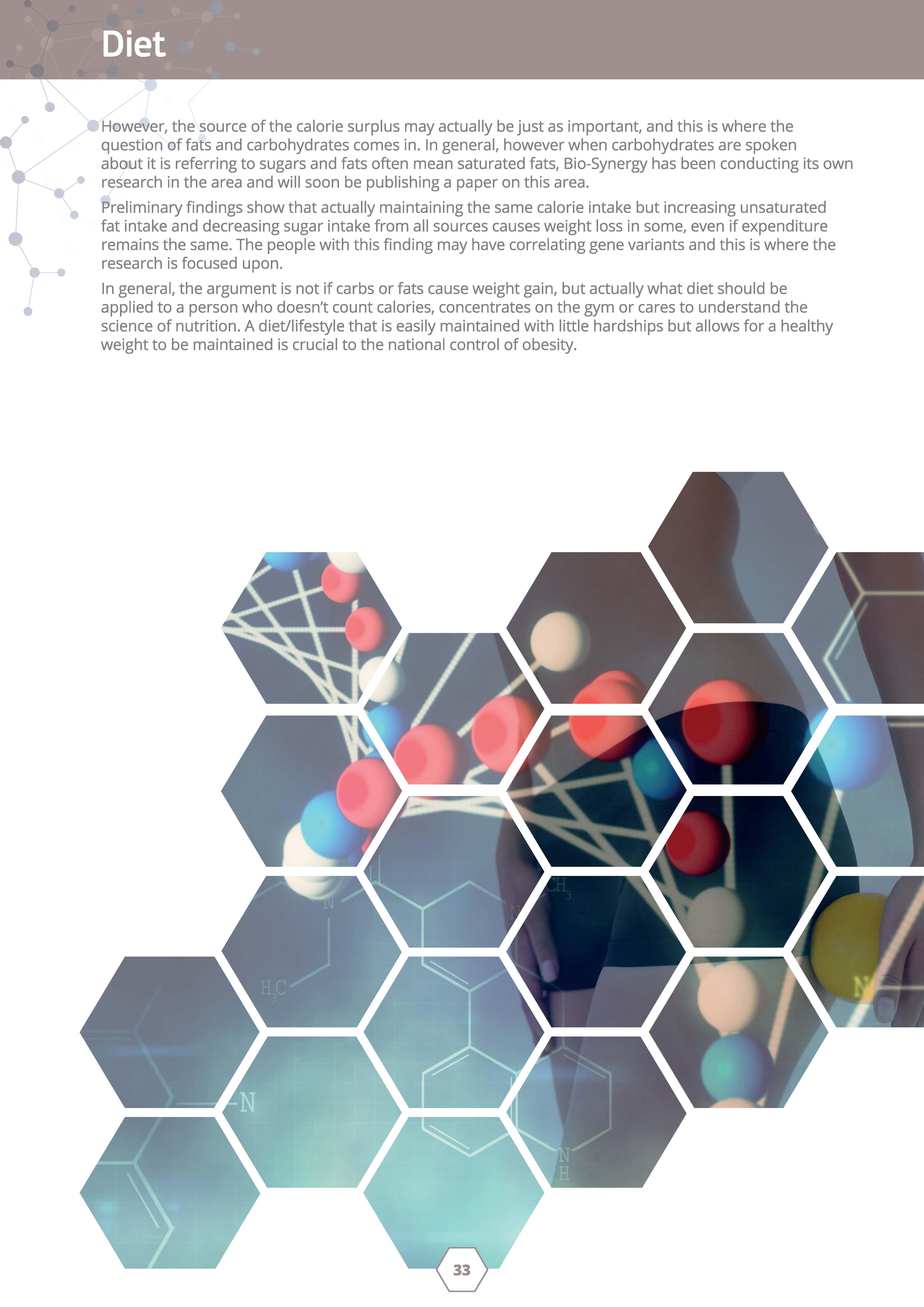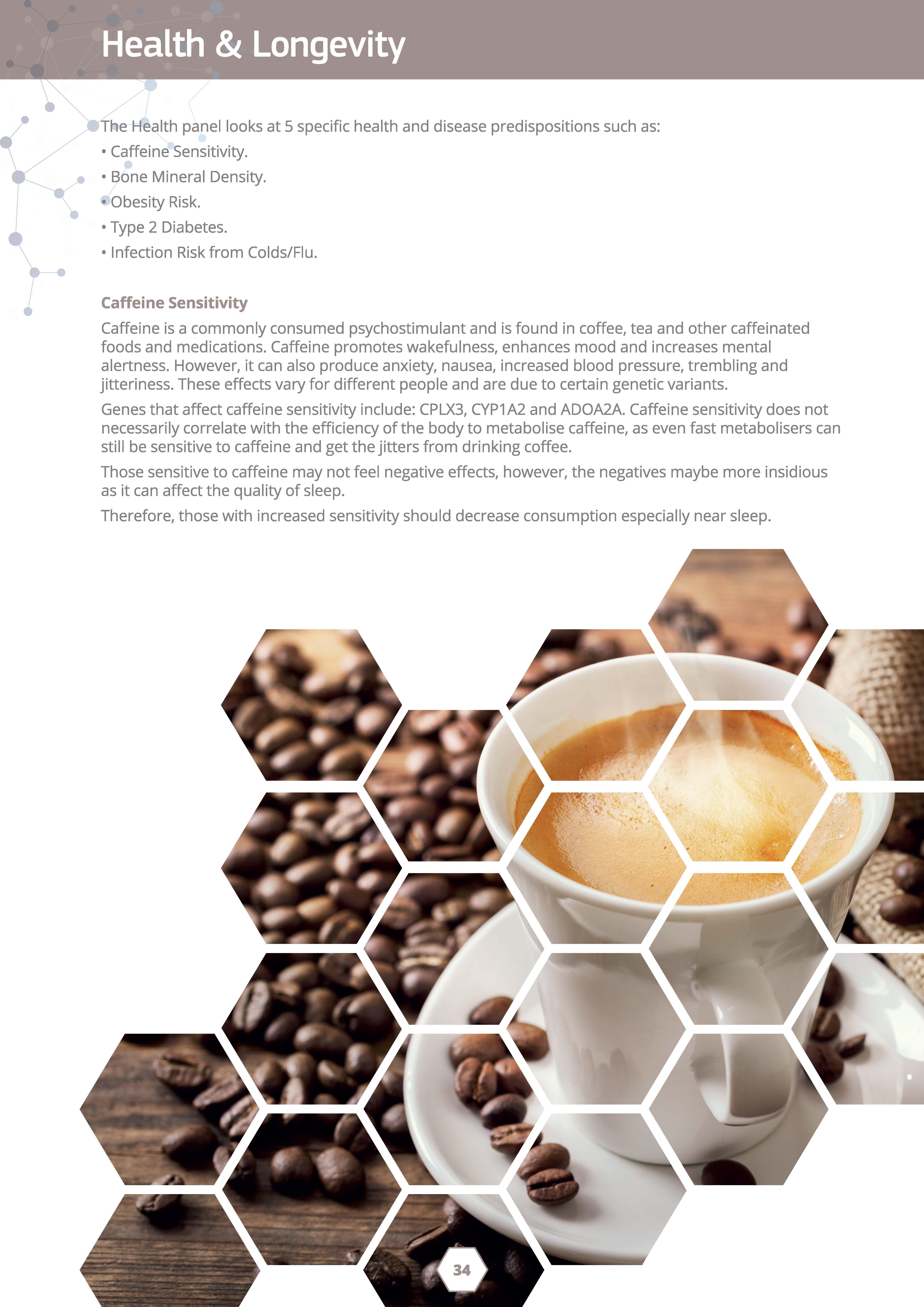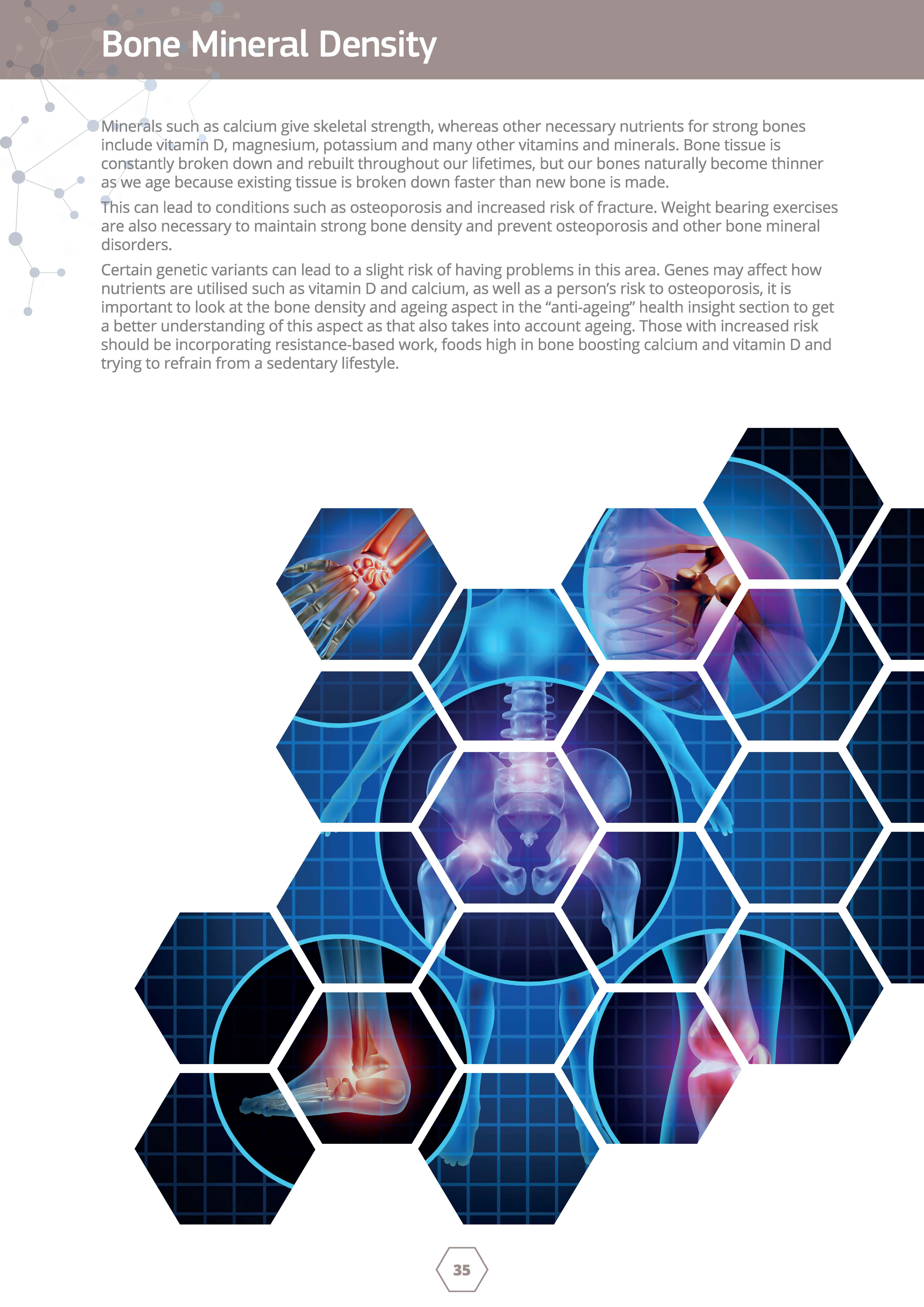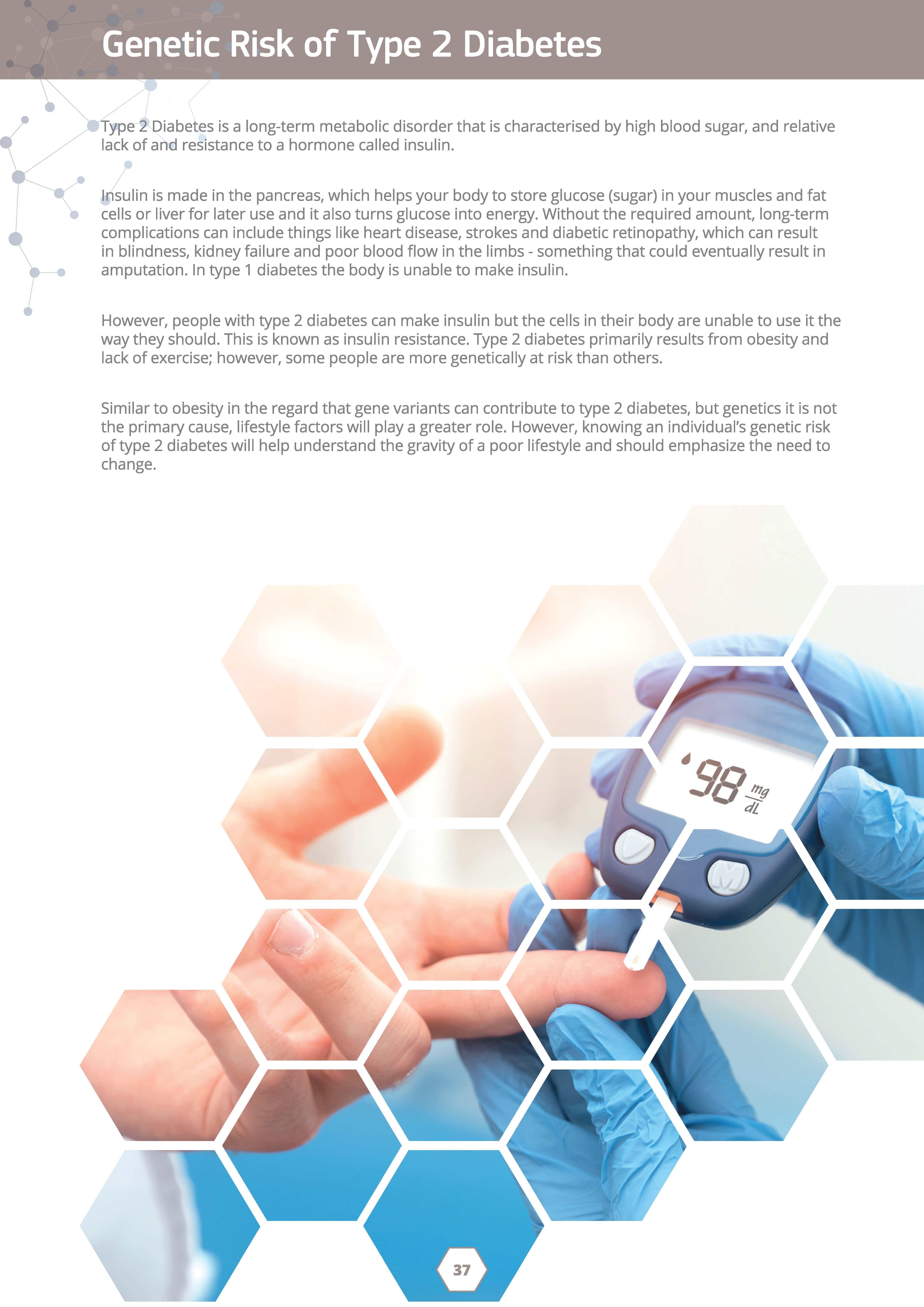Genetic Risk of Infection Risk f ram
If you have an increased risk of illness it is important that you try to boost your vitamin and mineral intake. This should mainly be through food but could also be supplemented with Vitamin C, Vitamin D and Zinc. The virus score now effectively replaces this aspect. •
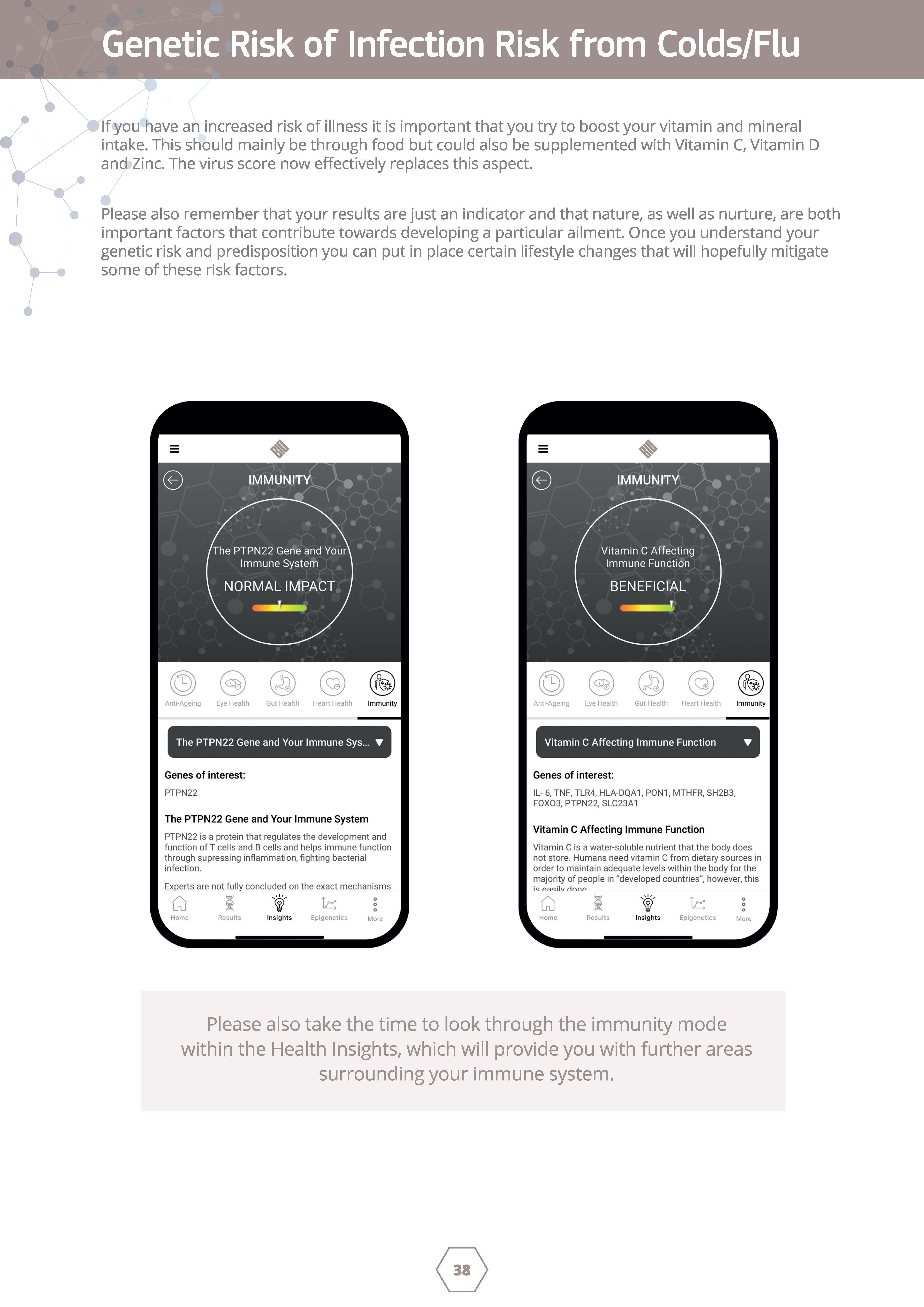
Colds/Flu
and
Anti-Ageing Eye Health Gut Health Heart Health Imm unity The PTPN22 Gene and Your Immune Sys " Genes of interest: PTPN22 The PTPN22 Gene and Your Immune System PTPN22 is a protein that regulates the development and function of T cells and B cells and helps immune function through supressing inflammation, fighting bacterial infection Experts are not fully concluded on the exact mechanisms CJ i -w tt:: Home Results Insights Epigenetics More Anti-Ageing Eye Health Gut Health Heart Health Immun ity Vitamin C Affecting Immune Function " Genes of interest: IL-6, TNF, TLR4 HLA-DQA1, PON1, MTHFR, SH2B3, FOX03, PTPN22, SLC23A 1 Vitamin C Affecting Immune Function Vitamin C is a water-soluble nutrient that the body does not store. Humans need vitamin C from dietary sources in order to maintain adequate levels within the body for the majority of people in "developed countriesH, however, this is:: .,:,:1s::ilvrlnn.,:, Home Results Insight s Epigenetics More Please also take the time to look through the immunity mode within the Health Insights, which will provide you with further areas surrounding your immune system. 0
Please also remember that your results are just an indicator
that nature, as well as nurture, are both important factors that contribute towards developing a particular ailment. Once you understand your genetic risk and predisposition you can put in place certain lifestyle changes that will hopefully mitigate • some of these risk factors.
•
Physical and Sport is featured in our next section, which covers 11 unique genetic traits associated with athletic performance and exercise.
These include
•
• Muscle Power (MP)
• Muscle Stamina (MS)
• How to use MP/MS for Reps?
• 02 Usage.
• Anaerobic Threshold.
• Recovery Rate.
• Muscle Mass.
• Injury Risk.
• Soft Tissue Inflammation.
• Lean Body Mass.
• Power to Weight Ratio.
• Exercise Effect on Weight.
For further information on each of these please reference the text below, we also help explain how you use Muscle Power and Muscle Stamina for reps as well as Time Under Tension.

•
Muscfe Power (MP)
This is an area that analyses genes that look at an individual's ability to produce high levels of energy over a short period of time and their affinity to gain fast twitch muscle fibres with power or strength-based training. If looking to gain muscle power through training you need to look at lower reps, higher sets and more rest. The idea is to move a heavier weight to damage the muscle fibres more, the weight needs to be under control.
To adapt training this can be achieved in a number of ways, such as change order of exercises or days of training, adapt volume and intensity through sets, reps, rests and training methods. Methods can include, negative
• training, 5 x 5 training, cluster sets. If you want to do extra reading into this area, look into the strength velocity curve and periodisation of training.
Muscle Stamina (MS)
This is an area that analyses genes that look at an individual's ability to produce low/intermediate levels of energy over a long period of time and their affinity to gain slow twitch muscle fibres with endurance and stamina-based training. Look to periodise your training - adapt training at least every 4 weeks - to stop plateauing and allow progression unless you are trying to maintain current condition.
If looking to gain muscle stamina through training you need to look at higher reps, less sets and less rest. There are a number of different methods of training that can be utilised such are tri-set, pre- and post-exhaust and matrix training. But you would need to learn about energy system development as this links to different ways of training.
Below is how an example of an algorithm using gene variants can correlate to real world performance: Fitness performance has largely been attributed to the intensity and frequency of training, quality of coaching and the time and overload that an individual has been training for. The abilities of an individual to perform the physiological demands for performance can come down to genetic traits, it is thought that up to 66% of athletic status is heritable with genetic variants influencing strength, V02 max, endurance, recovery and injury.
It is unwise to consider that singular polymorphisms have a great impact on overall fitness performance, however a combination of many genotype variations may show superior overall impact. Polygenic algorithms have the potential to help predict fitness performance, injury, disease and traits within individuals and therefore may be viable to helping individuals tailor programmes and interventions which better suit them.
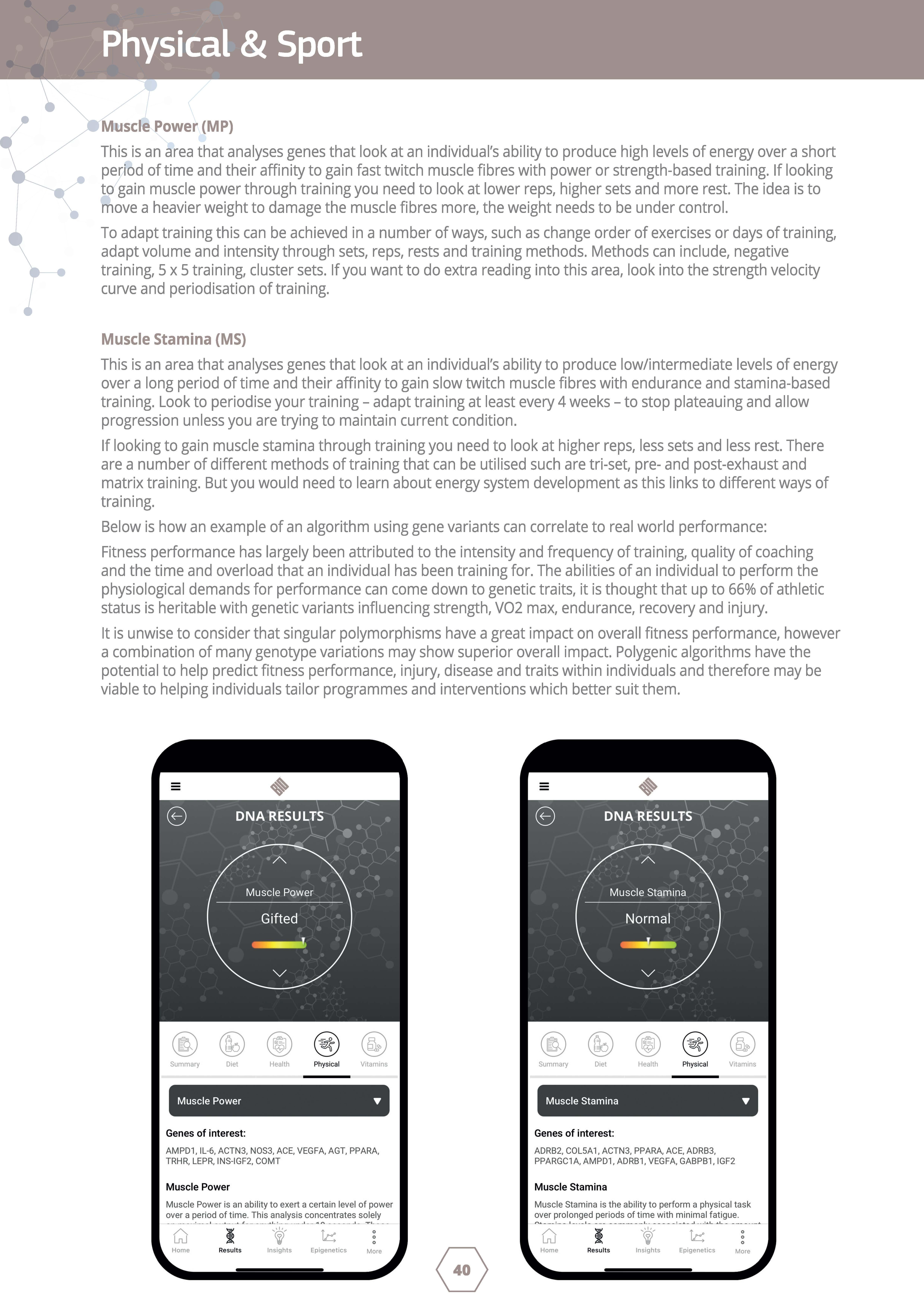
Summary Diet Health Physical Vitamins Muscle Power T Genes of interest: AMPD1, IL-6, ACTN3, NOS3, ACE, VEGFA, AGT, PPARA, TRHR, LEPR, INS-IGF2, COMT Muscle Power Muscle Power is an ability to exert a certain level of power ~~e! ~=~i-~d- o~ ti~~~ s~~I~ Home Resu l ts Ins ghts Epige net cs Mo re 0 Summary Diet Health Physica Vitam ins Muscle Stamm a T Genes of interest: ADRB2, COL5A1, ACTN3, PPARA, ACE, ADRB3, PPARGC1A, AMPD1, ADRB1, VEGFA, GABPB1, IGF2 Muscle Stamina Muscle Stamina is the ability to perform a physical task over pro l onged periods of time with minima l fatigue. ,..._. ___ __' ·· _____ ,. _, ,_ _________ Home Re su lts Insights Epi genetics More
•
HOWTO USE MP/MS FOR REPS?
Time Under Tension
We use muscle power and muscle stamina to calculate your "time under tension" for each set that you perform (i.e. how long each specific movement takes to complete).
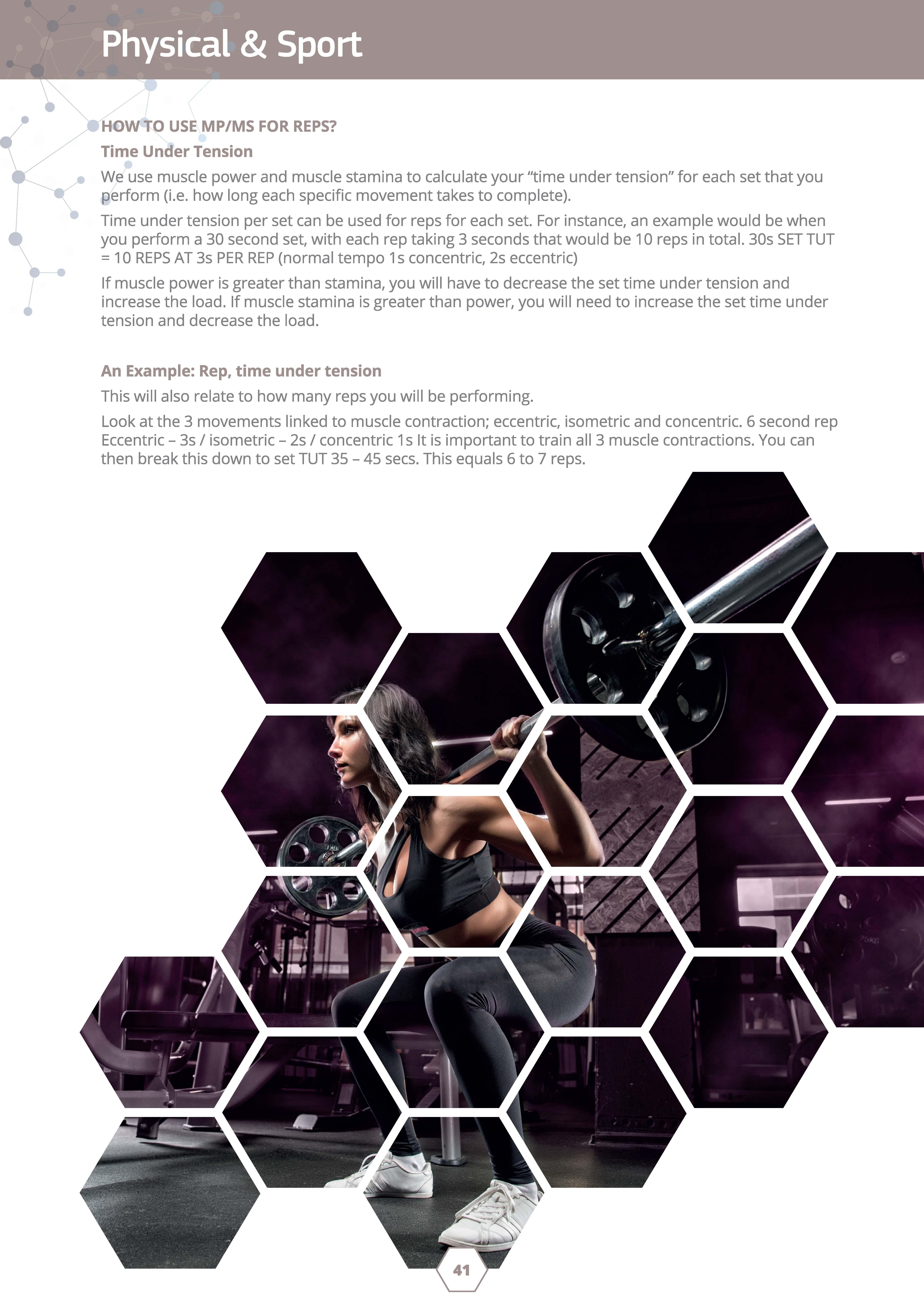
Time under tension per set can be used for reps for each set. For instance, an example would be when you perform a 30 second set, with each rep taking 3 seconds that would be 10 reps in total. 30s SET TUT = 10 REPS AT 3s PER REP (normal tempo 1s concentric, 2s eccentric)
If muscle power is greater than stamina, you will have to decrease the set time under tension and increase the load. If muscle stamina is greater than power, you will need to increase the set time under tension and decrease the load.
An Example: Rep, time under tension
This will also relate to how many reps you will be performing.
Look at the 3 movements linked to muscle contraction; eccentric, isometric and concentric. 6 second rep Eccentric - 3s / isometric - 2s / concentric 1s It is important to train all 3 muscle contractions. You can then break this down to set TUT 35 - 45 secs. This equals 6 to 7 reps.
02 Usage
This area looks at genes that are associated with an individual's ability to gain an increased V02 max. In essence those who are gifted have a higher potential "ceiling".
Anaerobic Threshold
This area looks at genes associated with superior anaerobic thresholds by helping combat lactate build up. Again, like 02 usage those who are gifted have a higher potential "ceiling''. If you have a gifted outcome you can often train longer compared to those with a reading of normal. This information could be beneficial for laying out how many sets you can perform, how long a training session could last, and how long a distance could be undertaken.
Using the Anaerobic Threshold marker will also help you calculate your "work to rest "ratios if designing interval, ladder or fartlek training. For further understanding look into energy system development.
Recovery rate
This area looks at genes associated with recovery from high intense activity and it works on two levels: The recovery needed between high intense exercises. The recovery needed between sessions.
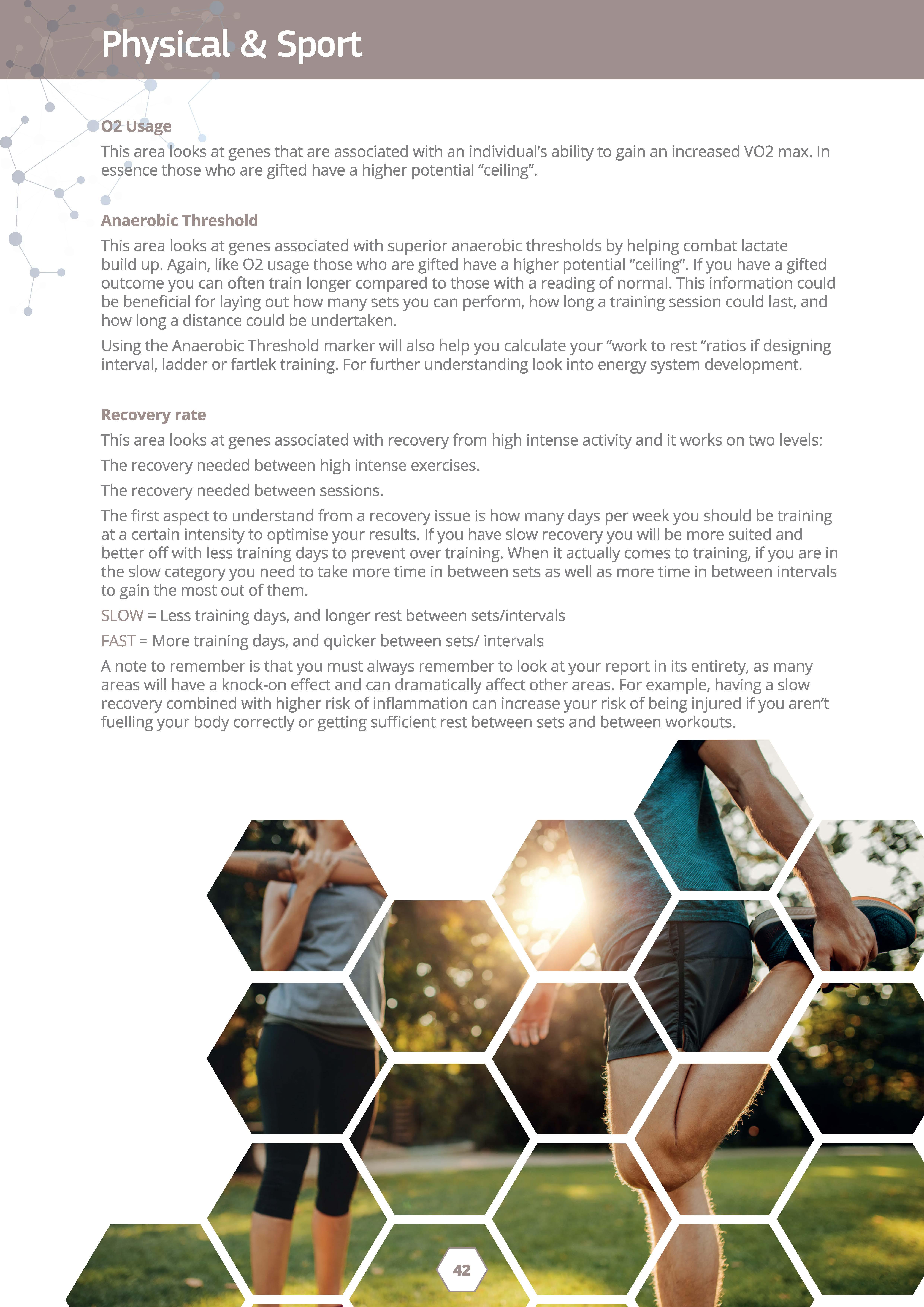
The first aspect to understand from a recovery issue is how many days per week you should be training at a certain intensity to optimise your results. If you have slow recovery you will be more suited and better off with less training days to prevent over training. When it actually comes to training, if you are in the slow category you need to take more time in between sets as well as more time in between intervals to gain the most out of them.
SLOW = Less training days, and longer rest between sets/intervals
FAST = More training days, and quicker between sets/ intervals
A note to remember is that you must always remember to look at your report in its entirety, as many areas will have a knock-on effect and can dramatically affect other areas. For example, having a slow recovery combined with higher risk of inflammation can increase your risk of being injured if you aren't fuelling your body correctly or getting sufficient rest between sets and between workouts.
•
Muscle Mass
• the "gifted" outcome. The gene MSTN affects muscle mass, and is a hot topic in sports:
MSTN Variance
This area looks at the individual's natural affinity for muscle mass and the response of increased hypertrophy to a stimulus such as resistance training. Most individuals will be "normal" in this category, with some having "increased" and very few 1-2%- will have •
MSTN is a gene that makes instructions for producing the protein myostatin, a protein that is part of the transforming growth factor beta family (TGF~). The TGF~ family of proteins control the growth of tissues in the body, myostatin is found nearly exclusively in the skeletal muscles where it is active before and after birth.
The protein actually controls skeletal growth by restraining it, preventing muscles becoming excessively large. Current research that surrounds myostatin is based around its potential treatment in muscle wasting disorders. Animals that have mutations in the gene MSTN show greater muscle mass, strength and in some circumstances reduced bodyfat, which can be known as myostatin-related muscle hypertrophy.
Bio-Synergy looks at multiple variants within the gene MSTN, these include the well-known ones associated with myostatin related hypertrophy which are rare and also the lesser studied variants which may show other more commonly in the population but also bring about some form of performance boost.
Bio-Synergy looks at all the variants and breaks the results down into three potential outcomes and this result is found in the muscle health, health insight:
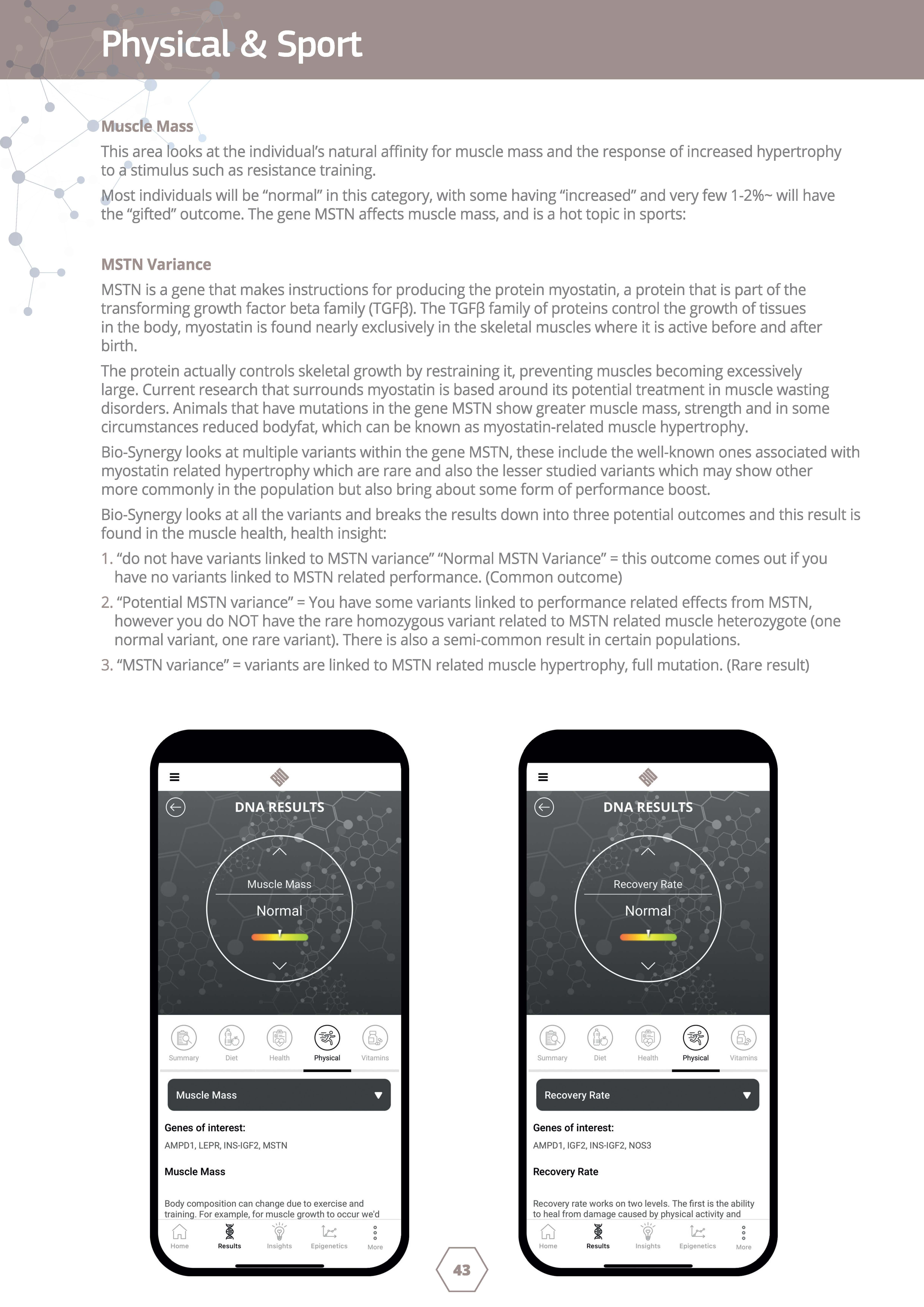
1. "do not have variants linked to MSTN variance" "Normal MSTN Variance"= this outcome comes out if you have no variants linked to MSTN related performance. (Common outcome)
2. "Potential MSTN variance"= You have some variants linked to performance related effects from MSTN, however you do NOT have the rare homozygous variant related to MSTN related muscle heterozygote (one normal variant, one rare variant). There is also a semi-common result in certain populations.
3. "MSTN variance"= variants are linked to MSTN related muscle hypertrophy, full mutation. (Rare result)
Summary Diet Health Physica l Vitamins Muscle Mass • Genes of interest: AMPD1, LEPR, INS-IGF2, MST N Muscle Mass Body composition can change due to exercise and tra i ni ng For example, for muscle growth t o occu r we 'd Home Re sults Insights Epigenetics More 0 Summary Diet Health Physical Vitamins Recovery Rate • Genes of interest: AMPD1, IGF2, INS -IG F2, NOS3 Recovery Rate Recovery rate works on two l eve l s. The first i s the ab il it y to hea l from damage caused by physica l activ ity and Cl I -w TL:: Home Resu l ts Insights Epigenetics More
Injury Risk
This looks at the genes associated with soft tissue injury, mainly around ligament and tendon ruptures
Inflammation
This is a general area on soft tissue-based inflammation and not systemic inflammation, it is best to look at the immunity mode in full to understand other areas of inflammatory risk
Lean Body Mass
This area looks at genes associated with a higher lean body mass, therefore naturally higher body mass when fat is deducted.
Power to weight ratio
This area looks at genes associated with a higher lean body mass, therefore naturally higher body mass when fat is deducted and also considers genes associated with power, which will give some individuals a superior power to weight ratio.

How effective exercise is on losing weight
This aspect analyses how some individuals respond better to exercise in terms of weight loss.
• • •
Summary Diet Health Phys ca l Vitamins Injury Risk .., Genes of interest: COL5A1, GDF5, COL 1A1 Injury Risk Collagen is the most abundant protein in the body and is what makes up our skin and connective tissues. Certain genes affect how our co ll agen is made as well as its Tc Home Re sults Ins ights Epigeneti cs More 0 Summary D et Health Physical Vitam ns Power-To-Weight Ratio .., Genes of interest: LEPR, TRHR, AMPD1, ACE, INS-IGF2 Power-To-Weight Ratio Power-to-weight is an important measurement for many sports and activities , especially those that are weight Ci I ·w re Home Resu l ts Insights Ep igenetics More
• •
The vitamin panel is probably one of the most important to read through and fully understand, as vitamins & minerals form the backbone for our health.
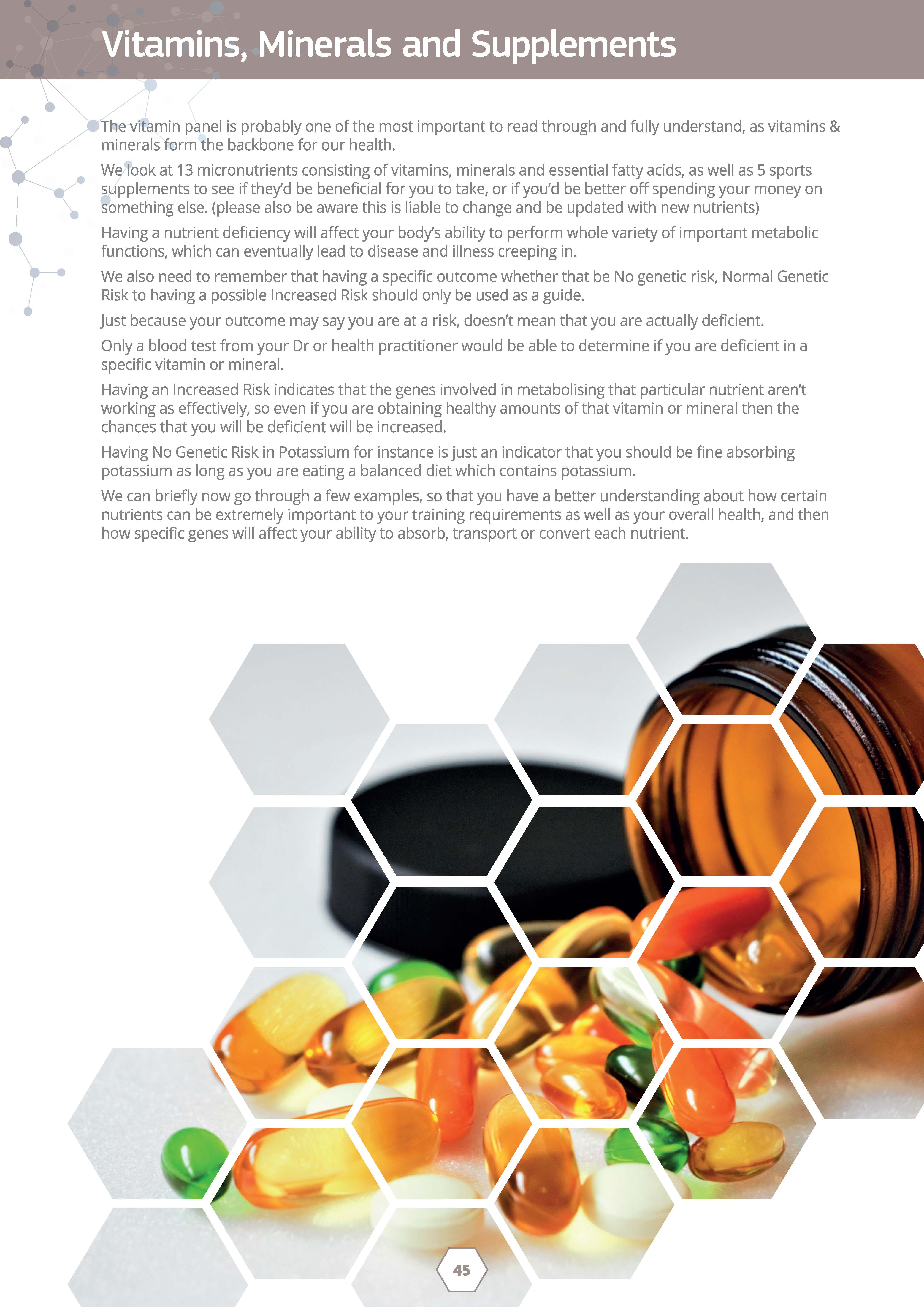
We look at 13 micronutrients consisting of vitamins, minerals and essential fatty acids, as well as 5 sports supplements to see if they'd be beneficial for you to take, or if you'd be better off spending your money on something else. (please also be aware this is liable to change and be updated with new nutrients)
Having a nutrient deficiency will affect your body's ability to perform whole variety of important metabolic functions, which can eventually lead to disease and illness creeping in
We also need to remember that having a specific outcome whether that be No genetic risk, Normal Genetic Risk to having a possible Increased Risk should only be used as a guide.
Just because your outcome may say you are at a risk, doesn't mean that you are actually deficient.
Only a blood test from your Dr or health practitioner would be able to determine if you are deficient in a specific vitamin or mineral.
Having an Increased Risk indicates that the genes involved in metabolising that particular nutrient aren't working as effectively, so even if you are obtaining healthy amounts of that vitamin or mineral then the chances that you will be deficient will be increased.
Having No Genetic Risk in Potassium for instance is just an indicator that you should be fine absorbing potassium as long as you are eating a balanced diet which contains potassium.
We can briefly now go through a few examples, so that you have a better understanding about how certain nutrients can be extremely important to your training requirements as well as your overall health, and then how specific genes will affect your ability to absorb, transport or convert each nutrient.
Vitamin D
Vitamin Dor the sunshine vitamin, which is actually a hormone has many positive health benefits, such as maintaining strong bones, modulation of cell growth, hormone, neuromuscular and immune function, as well as the reduction of inflammation.
• It plays a pivotal role in exercise-induced muscle damage and recovery, as well as being crucial for the absorption of calcium into the bones. It's also essential for optimal hormone regulation and function, which obviously goes hand in hand with testosterone levels and improvements to strength, speed, • power and recovery.
Research is clearly demonstrating the importance of Vitamin Don our health; and unfortunately, Vitamin D deficiency affects almost 50% of the world's population.
Some of the elements contributing towards this include lifestyle factors, such as reduced outdoor activities, obesity, environmental factors, such as living in the northern hemisphere, air pollution, poor dietary choices and genetic factors.
Studies show that almost 10% of the human genome may be regulated by Vitamin D, so obtaining sufficient levels is crucial to your health, fitness and longevity. There is one particular gene called CYP2R1 which, depending on your variation, can affect how efficient you are at converting vitamin D into the main circulating form.
The general consensus is that 1,000 IU (international unit) of vitamin D3 per day generally raises your serum 25hydroxy levels by Sng per ml. But if you have certain genetic variations, which reduces your ability to absorb vitamin D3 effectively then this might not be the case - so a slightly higher dose will be more beneficial.
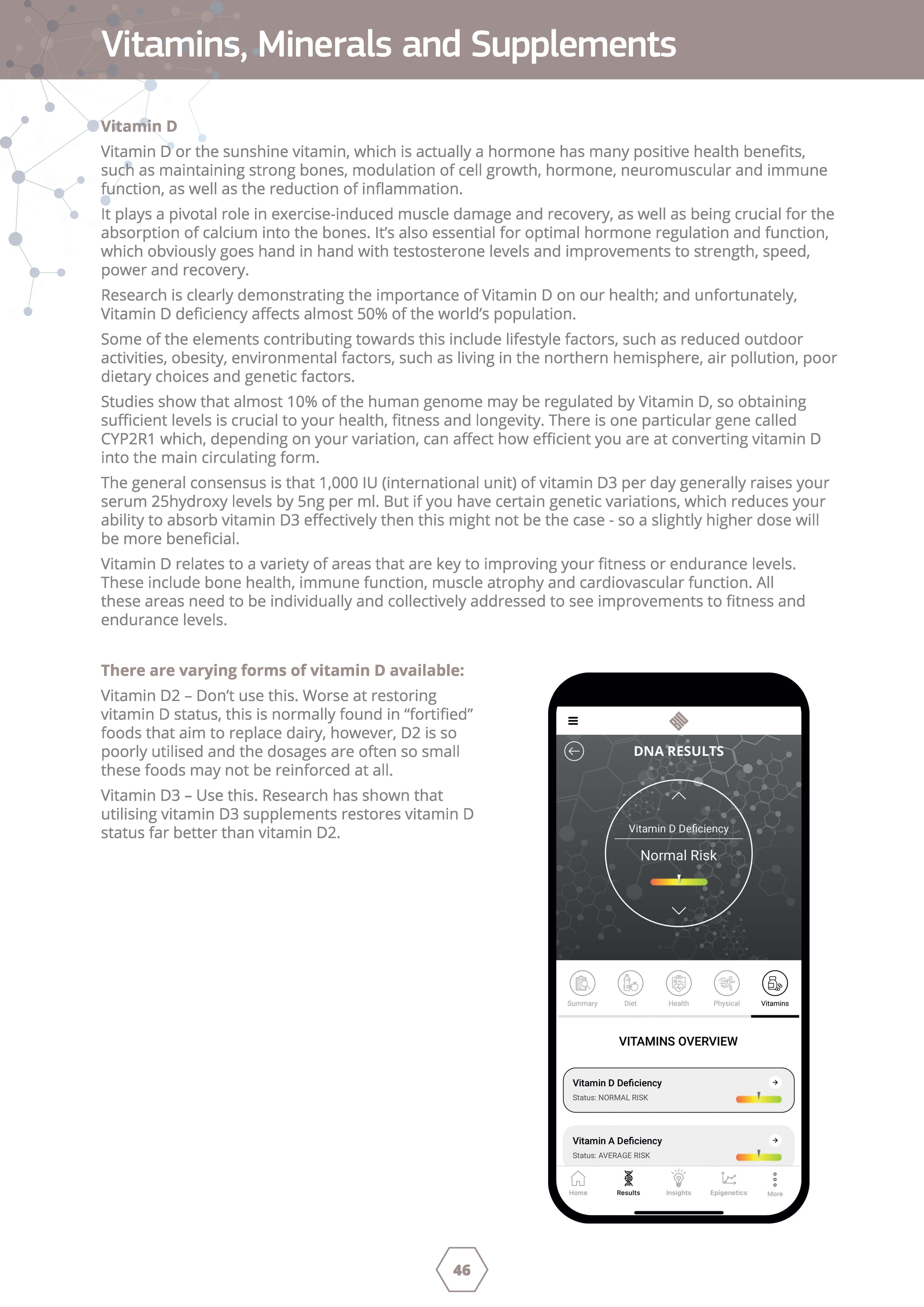
Vitamin D relates to a variety of areas that are key to improving your fitness or endurance levels. These include bone health, immune function, muscle atrophy and cardiovascular function. All these areas need to be individually and collectively addressed to see improvements to fitness and endurance levels.
There are varying forms of vitamin D available:
Vitamin D2 - Don't use this. Worse at restoring vitamin D status, this is normally found in "fortified" foods that aim to replace dairy, however, D2 is so poorly utilised and the dosages are often so small these foods may not be reinforced at all.
Vitamin D3 - Use this. Research has shown that utilising vitamin D3 supplements restores vitamin D status far better than vitamin D2.
0 Summary Diet Health Phys cal Vitami ns VITAMINS OVERVIEW Vitamin D Deficiency Statu s: NO RMA L RISK Vitamin A Deficiency Statu s: AVERAGE RISK LJ I Home Res ult s i' IL:: Insights Epigenet cs More
Vitamin A
Vitamin A is more than just a single nutrient, but a broad group of related nutrients, each providing us with differing health benefits. Vitamin A is also called "anti-infective" vitamin and many of the body's defences against infection depend on an adequate supply.
Retinoids
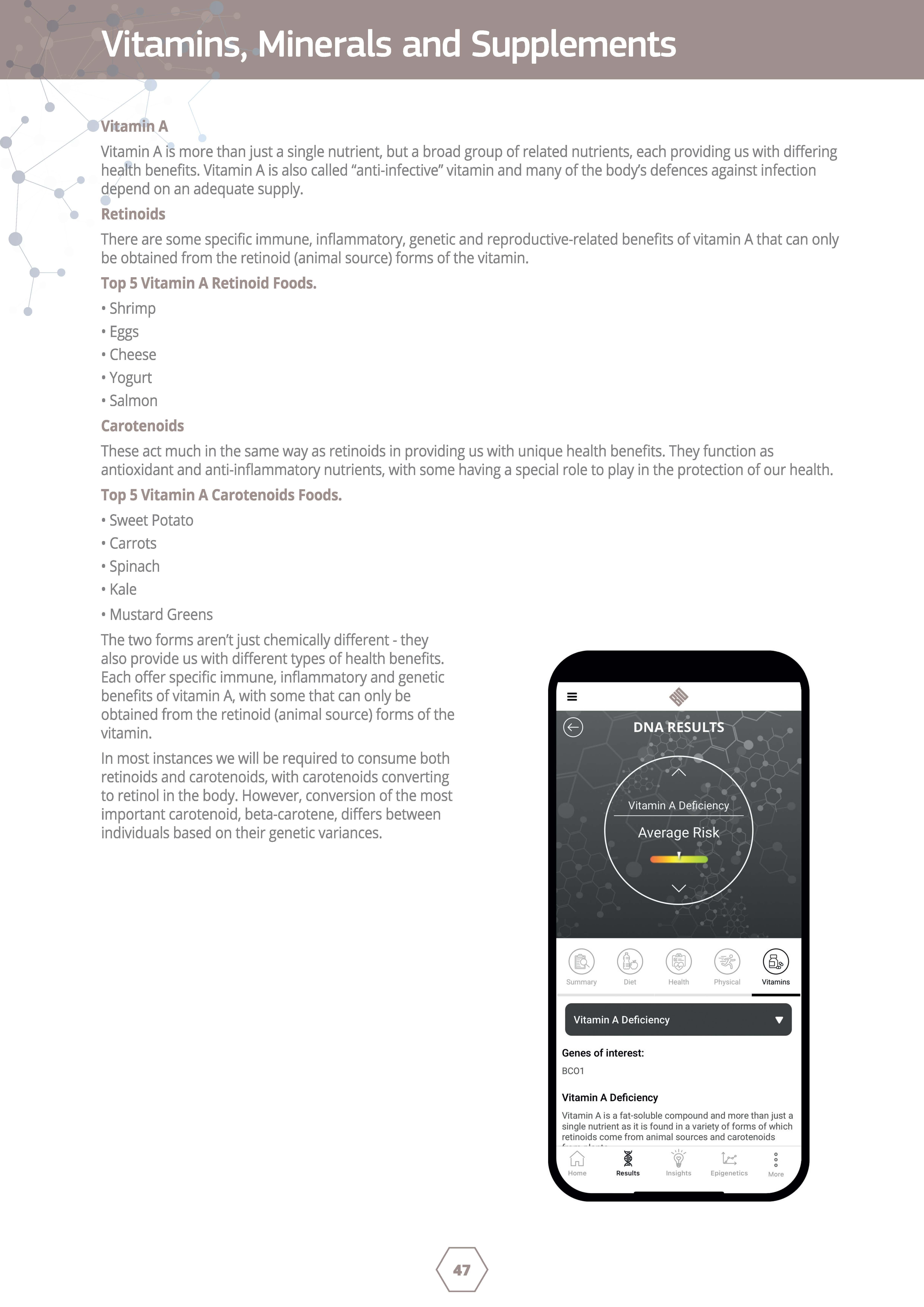
There are some specific immune, inflammatory, genetic and reproductive-related benefits of vitamin A that can only be obtained from the retinoid (animal source) forms of the vitamin .
Top 5 Vitamin A Retinoid Foods.
• Shrimp
• Eggs
• Cheese
• Yogurt
• Salmon
Carotenoids
These act much in the same way as retinoids in providing us with unique health benefits. They function as antioxidant and anti-inflammatory nutrients, with some having a special role to play in the protection of our health.
Top 5 Vitamin A Carotenoids Foods.
• Sweet Potato
• Carrots
• Spinach
• Kale
• Mustard Greens
The two forms aren't just chemically different- they also provide us with different types of health benefits. Each offer specific immune, inflammatory and genetic benefits of vitamin A, with some that can only be obtained from the retinoid (animal source) forms of the vitamin.
In most instances we will be required to consume both retinoids and carotenoids, with carotenoids converting to retinol in the body. However, conversion of the most important carotenoid, beta-carotene, differs between individuals based on their genetic variances.
• •
0 Summary Diet Health Physical Vit ami ns Vitamin A Deficiency • Genes of interest: BC01 Vitamin A Deficiency Vitamin A is a fat-soluble compound and more than just a single nutrient as it is found in a variety of forms of which retinoids come from animal sources and carotenoids Home Resu lt s Insights Epigenetics More
•
Iron
Iron is an essential nutrient required by every human cell. The main function of iron is to transport oxygen to our cells and tissues for energy production.
An iron deficiency is the most common nutritional disorder in the world and the leading cause of anaemia. Without anaemia, iron deficiency is usually associated with inefficient energy metabolism and a reduced muscle strength and endurance.
It is also important to know that there are 2 types of dietary iron: Heme iron, which is contained in meat and fish, and Non-Heme iron that can be found in fruits, vegetables, pulses and legumes.

Top 5 Non-heme Iron Foods.
• Soybeans
• Lentils
• Spinach
• Sesame Seeds
• Olives
Top 5 Heme Iron Foods.
• Shellfish
• Liver
• Red Meat
• Turkey
• Fish
A lack of iron in the diet can cause fatigue, decreased performance (energy/ATP production), concentration and learning weakness, sensitivity to cold, pale skin, hair loss, brittle nails, palpitations, dizziness, increased susceptibility to infections. For athletes - increased pulse and lactate levels and decreased aerobic capacity.
The iron aspect looks at the risk of low levels of iron in the blood, however iron should not be supplemented without discussion with a physician after a blood test.
•
Magnesium
As half the world's population is deficient in magnesium, so it's no wonder that many of the negative health connotations associated with deficiency are so prevalent. Magnesium is an essential mineral and cofactor for over 300 metabolic reactions in the body, and is the second most abundant electrolyte in the body and is required for the production and transfer of energy for protein synthesis, so this is one of the reasons you should be eating your greens, as without healthy levels of magnesium you will be impairing muscle growth and regeneration.

Magnesium and calcium have antagonistic roles in normal muscle contraction - magnesium acting as the muscle relaxer, with calcium used as the stimulator. With excess of one or the other leading to impaired performance, reduced recovery and increased chance of injury.
With athletes or those who exercise frequently losing a tremendous amount of magnesium, as well as other nutrients when they sweat.
Adults that consumed less than the RDA of magnesium were 1.5 to 1.75 times more likely to have elevated (-reactive protein (CRP) levels, which is a key marker of inflammation. This was compared to those who consumed at least the RDA, and with soil depletion levels at around 75%, it is becoming increasingly difficult to consume the levels of magnesium that you will need from your 4 main food groups.
Top 5 Magnesium foods
• Pumpkin Seeds
• Spinach
• Swiss Chard
• Soybeans
• Sesame Seeds
Overall, magnesium is important for Immunity, nerve function, blood pressure and general health. It can also help those who are having trouble sleeping and should be supplemented by anyone who has genetic risk and those in intense training.
Magnesium Citrate - Common form, good in higher dosages to replenish magnesium levels and treat constipation. High dosages cause laxative affects.
Magnesium Oxide - Poorly absorbed but can be used in formulas for heartburn
•
• is a good all-round choice.
Magnesium Lactate - Not often seen in supplement form, used in foods. However, some studies link this form to treating anxiety
Magnesium Chloride - Well absorbed and can be used for constipation, general magnesium levels and •
Magnesium Ma late - greatly absorbed and less likely to cause laxative affects. A great choice for those wanting to just increase magnesium levels.
Magnesium Tau rate - A great choice for those wanting to decrease blood pressure and increase magnesium levels.
Magnesium L-threonate - The best form for improving brain health.
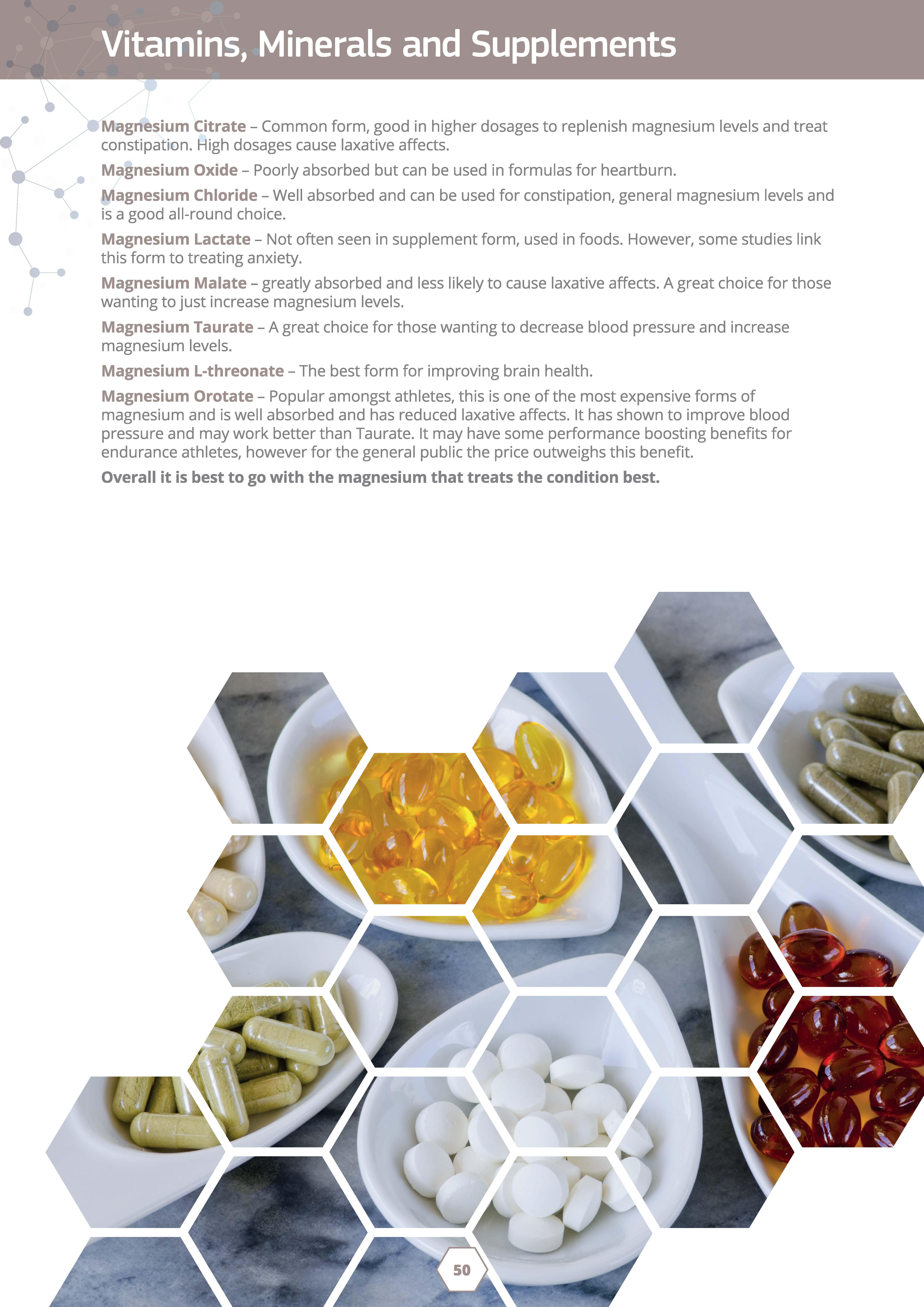
Magnesium Orotate - Popular amongst athletes, this is one of the most expensive forms of magnesium and is well absorbed and has reduced laxative affects. It has shown to improve blood pressure and may work better than Tau rate. It may have some performance boosting benefits for endurance athletes, however for the general public the price outweighs this benefit.
Overall it is best to go with the magnesium that treats the condition best.
•
Potassium
Potassium is an essential nutrient that constitutes 5% of the mineral content of the body. Adults should aim to obtain 4,700mg per day. It is found in varying amounts in a plethora of foods and carries a whole host of important roles, from maintaining healthy blood pressure, improving kidney function and stabilising fluid and electrolytes
Having a potassium deficiency (hypokalemia) can have an array of symptoms, from high blood pressure, headaches and dehydration. If potassium levels are too high (or low) then our heart and nervous system
• will be affected.
It is important to understand the synergy of potassium and sodium as well. They exist in a partnership; every time the body requires potassium you will also need sodium to maintain balance. Importantly, with blood pressure issues increasing it could be related to the average diet becoming depleted in potassium with higher concentrations of sodium.
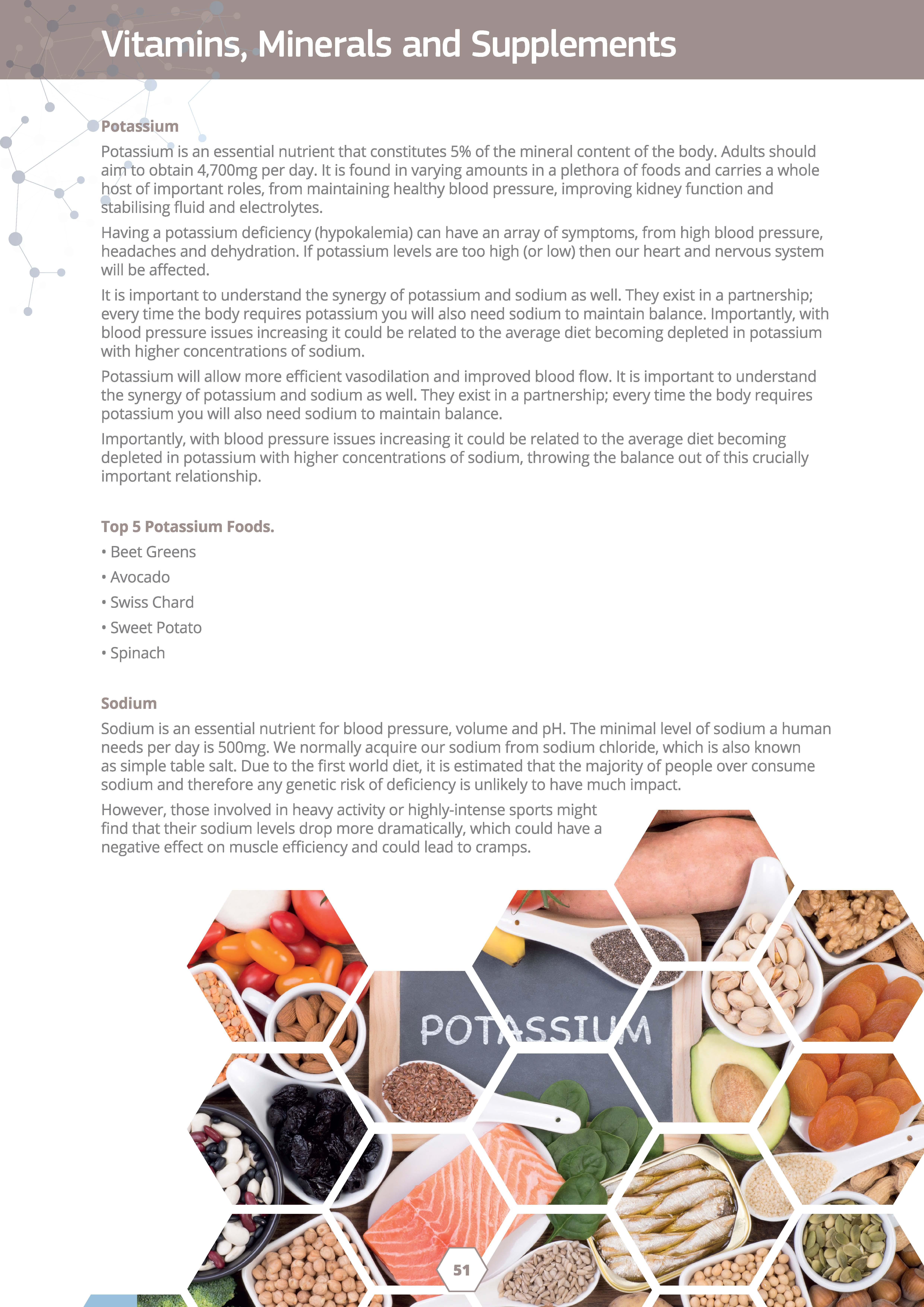
Potassium will allow more efficient vasodilation and improved blood flow. It is important to understand the synergy of potassium and sodium as well. They exist in a partnership; every time the body requires potassium you will also need sodium to maintain balance.
Importantly, with blood pressure issues increasing it could be related to the average diet becoming depleted in potassium with higher concentrations of sodium, throwing the balance out of this crucially important relationship.
Top 5 Potassium Foods.
• Beet Greens
• Avocado
• Swiss Chard
• Sweet Potato
• Spinach
Sodium
Sodium is an essential nutrient for blood pressure, volume and pH. The minimal level of sodium a human needs per day is 500mg. We normally acquire our sodium from sodium chloride, which is also known as simple table salt. Due to the first world diet, it is estimated that the majority of people over consume sodium and therefore any genetic risk of deficiency is unlikely to have much impact. However, those involved in heavy activity or highly-intense sports might find that their sodium levels drop more dramatically, which could have a negative effect on muscle efficiency and could lead to cramps.
•
Vitamin B6
Vitamin B6 is part of a family of 8 vitamins that are all essential to life and all provide us with a variety of health benefits. It is crucially involved at several points during the metabolism of protein, carbohydrates and fats and most importantly with the enzyme that draws carbohydrates (glycogen) out of storage from inside the cell requires B6 for its activity. Hence why it is such an important nutrient for improving your energy systems and athletic performance.
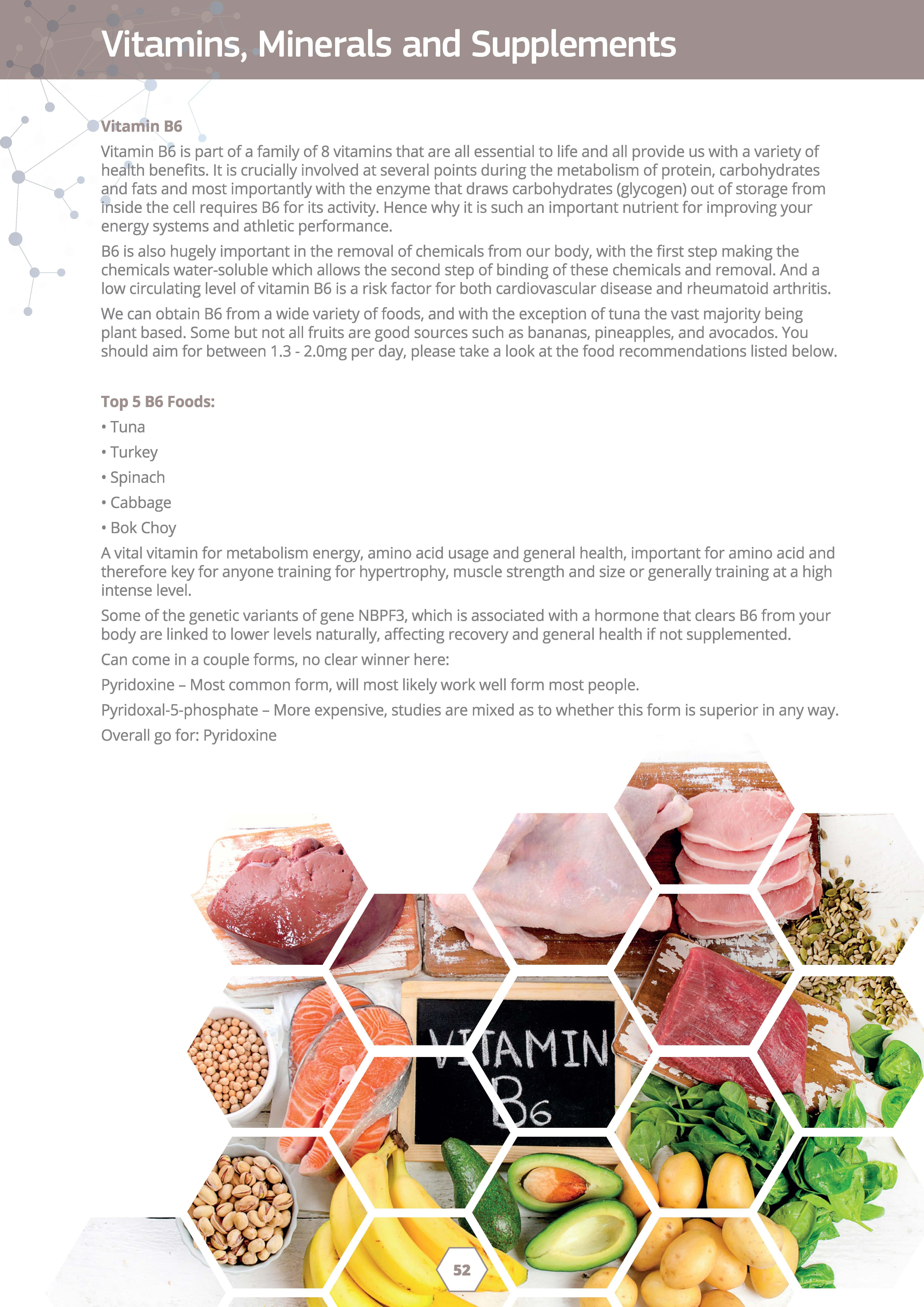
B6 is also hugely important in the removal of chemicals from our body, with the first step making the • chemicals water-soluble which allows the second step of binding of these chemicals and removal. And a low circulating level of vitamin B6 is a risk factor for both cardiovascular disease and rheumatoid arthritis. We can obtain B6 from a wide variety of foods, and with the exception of tuna the vast majority being plant based. Some but not all fruits are good sources such as bananas, pineapples, and avocados. You should aim for between 1.3 - 2.0mg per day, please take a look at the food recommendations listed below.
Top 5 B6 Foods:
• Tuna
• Turkey
• Spinach
• Cabbage
• Bok Choy
A vital vitamin for metabolism energy, amino acid usage and general health, important for amino acid and therefore key for anyone training for hypertrophy, muscle strength and size or generally training at a high intense level.
Some of the genetic variants of gene NBPF3, which is associated with a hormone that clears B6 from your body are linked to lower levels naturally, affecting recovery and general health if not supplemented. Can come in a couple forms, no clear winner here:
Pyridoxine - Most common form, will most likely work well form most people.
Pyridoxal-5-phosphate - More expensive, studies are mixed as to whether this form is superior in any way. Overall go for: Pyridoxine
Vitamin B12
Vitamin B12 as the name suggests is part of the B complex of vitamins, which are involved in energy metabolism and other biological processes. B12 is one of the most common deficiencies and affects the whole body, from brain to bone.
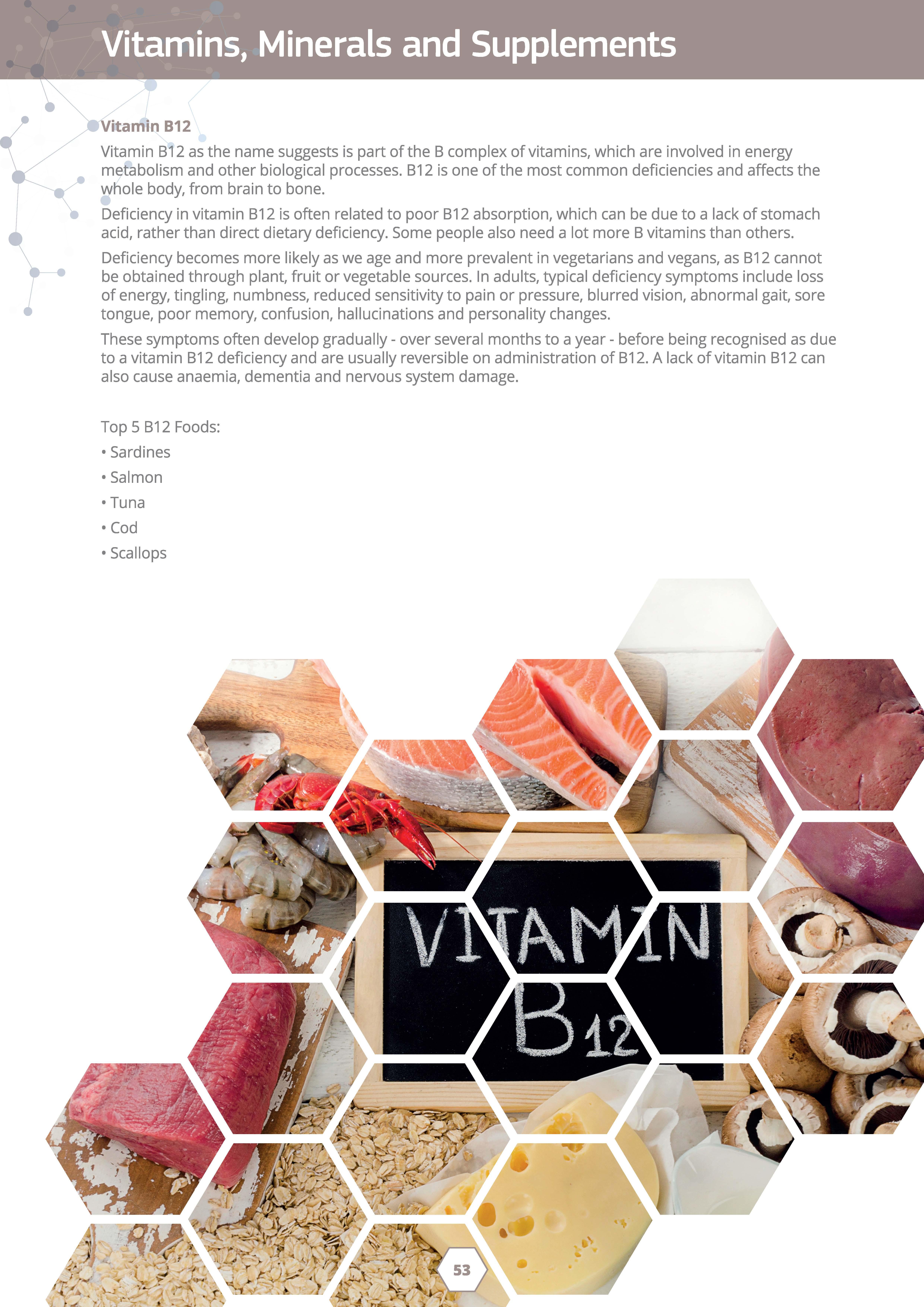
Deficiency in vitamin B12 is often related to poor B12 absorption, which can be due to a lack of stomach acid, rather than direct dietary deficiency. Some people also need a lot more B vitamins than others.
Deficiency becomes more likely as we age and more prevalent in vegetarians and vegans, as B12 cannot be obtained through plant, fruit or vegetable sources. In adults, typical deficiency symptoms include loss of energy, tingling, numbness, reduced sensitivity to pain or pressure, blurred vision, abnormal gait, sore tongue, poor memory, confusion, hallucinations and personality changes.
These symptoms often develop gradually- over several months to a year - before being recognised as due to a vitamin B12 deficiency and are usually reversible on administration of B12. A lack of vitamin B12 can also cause anaemia, dementia and nervous system damage.
Top 5 B12 Foods:
• Sardines
• Salmon
• Tuna
• Cod
• Scallops
• •
•
The popularity of vegan type diets has seen an increase in vitamin B12 deficiency, but even if you are eating food groups which contain healthy amounts of vitamin B12 you may still be at risk of deficiency. This is because the B vitamins come from meat and eggs.
Common variations in the FUT2 gene (a gene which creates an enzyme that breaks down fibre-like molecules) will either decrease or increase vitamin B12 absorption, and thus deficiency might be an issue to some.
Around 50% of the general population will have genetic variants that encode for 15% lower blood vitamin • B12 levels than normal. Whereas, 30% of the general population will have a variation of FUT2, which can result in higher blood levels of B12.
Improving your blood and oxygen production as well as distribution is one of the areas that are key to enhancing your performance and recovery. B12 deficiency can impair performance by reductions in blood flow and cardiovascular function, as well as inhibiting the conversion of foods to energy - which all athletes crucially need.

There are a variety of vitamin B12 supplements:
Cyanocobalamin - Most common form, this is a synthetic form. May be ok for those who are young and don't have genetic variants linked to B12 deficiency.
Methylcobalamin - A natural form, shows to have better retention in the body, this should be used for those with the genetic variants linked to B12 deficiency or those above 60.
Overall go for: Methylcobalamin
• •
Folate
Folate (vitamin 89) is a natural nutrient found in food, (hence why its name sounds like foliage and the Latin form of folium, meaning "Leaf') and is used for methylation, which is a mechanism that is used by our cells to regulate gene expression and function.
It's also responsible for the synthesis of brain neurotransmitters, dopamine, norepinephrine and serotonin. Also, extremely important for reducing homocysteine levels in the blood, which is a biomarker and indicator that is linked to increased risk of heart attacks, strokes and cardiovascular disease
Folate is a blood cell manufacturer and aids in immunity, energy and has importance in pregnancy. Take if at genetic risk of folate deficiency, during pregnancy (as directed by your physician).
Top 5 Folate Foods:
• Lentils
• Asparagus
• Spinach
• Broccoli
• Beets
Comes in two main form in supplements:
Folic acid
The most commonly found folate supplement, for those with certain genetic variants (scoring increased risk on the folate result in the Bio-Synergy app DNA results) they will not be able to utilise folic acid correctly, therefore it is worth using an alternative. It should be noted that folic acid should still be used in pregnancy as per current guidelines regardless of DNA results.
Methylfolate
This form should be used by those with increased genetic risk in the DNA results. This supplement bypasses the need for conversion which folic acid requires.
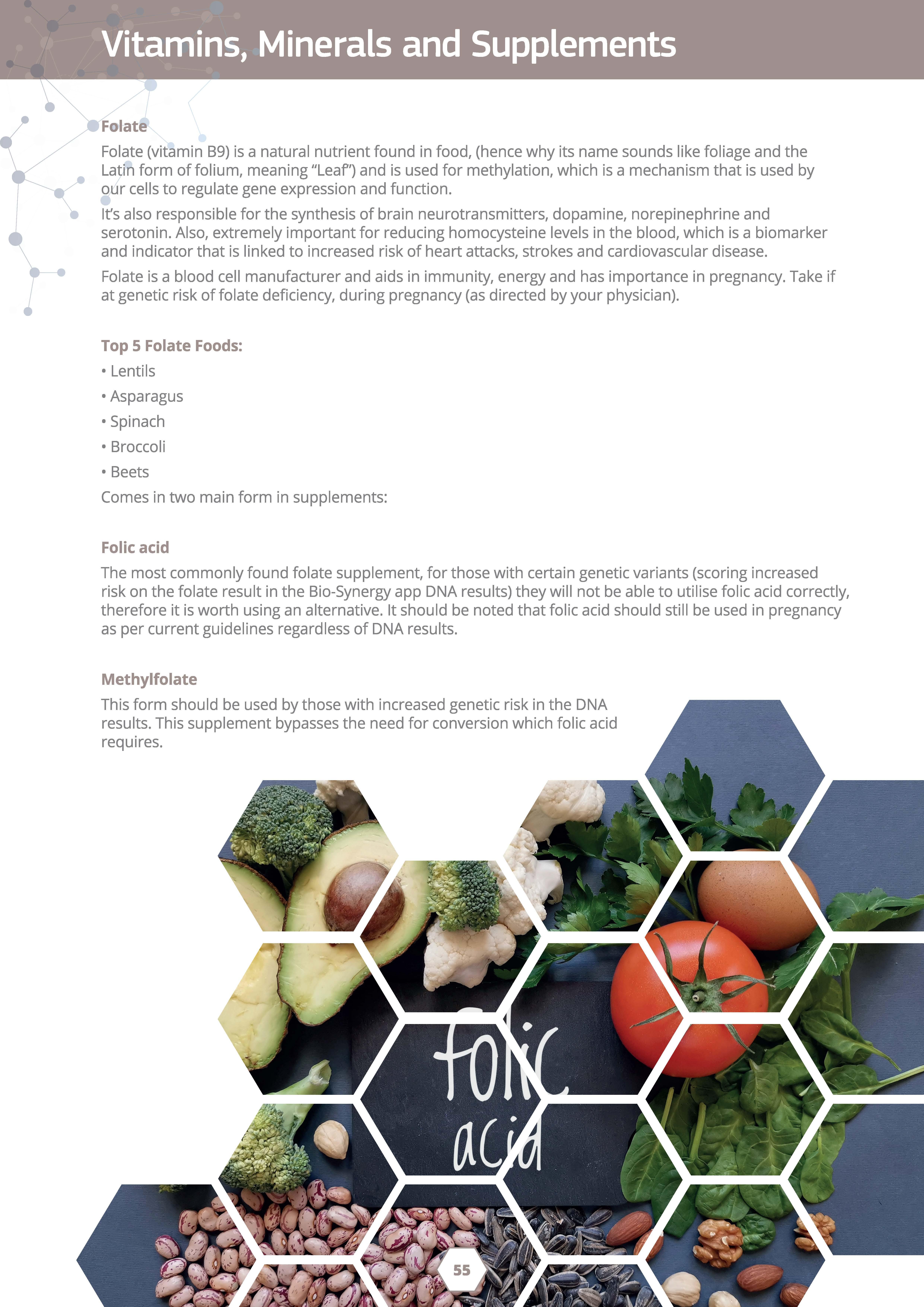
•
Selenium
Selenium has many important functions in the body and is one of the main antioxidants that protects us from disease and ageing as well as regulating our hormonal balance. Lower levels of selenium in humans have been linked to a higher risk of cancer, heart disease, inflammation, asthma and other diseases.
A selenium deficiency would increase susceptibility to infection and has been associated with nearly all types of disease. Dietary intake of selenium is dependent on its content in food and the bioavailability of its chemical forms

The selenium content of food varies according to the concentration of selenium in the soil. Therefore, the same foods may have significant differences in selenium levels depending on where they have been grown.
Top 5 Selenium Foods (Animal sources)
• Tuna
• Shrimp
• Sardines
• Salmon
• Cod
Top 5 Selenium Foods (Plant sources)
• Brazil nuts
• Tofu
• Brown rice
• Sunflower seeds
• Mushrooms
Omega 3 fatty acids
Omega-3 fatty acids include 3 different fatty acids shortened to ALA, EPA and DHA, which are all essential, meaning we cannot produce them in our bodies, so we have to consume them in the form of food.
They are extremely important to your health and offer a variety of benefits to both your body and brain.
• Omega 3 can also help combat the pro-inflammatory response seen from diets higher in grains, vegetable oils and processed foods.
Systemic inflammation being one of the leading causes of cardiovascular and heart disease, helping to minimise its effects may prove beneficial with a good amount of Omega 3's in your diet.
Increasing Omega 3 levels will help reduce inflammation and improve recovery rates significantly. They are also extremely effective at reducing DOMS (delayed onset muscle soreness), which you may encounter after going for a particularly strenuous run or session.
There are a variety of Omega 3's from Alpha Linolenic Acid (Omega 3) which is found in chia seeds, flaxseeds, walnuts that are sources of plant-based Omega 3. The main issue is trying to obtain sufficient and effective amounts of both (DHA) and (EPA) from plants, which is extremely difficult, as humans don't convert them efficiently; so animal sources will need to be the main supplier. Animal sources of (Omega 3) are high in both (DHA) and (EPA) which are missing from plant sources, with both being required to maintain correct function
ALA (Omega 3) is important however as it helps decrease expression of a variety of PRO- inflammatory genes, and as much as 85% of [ALA] being broken down to be used as an energy source. Timing of your Omega 3 with meals will also increase the uptake of nutrients in each meal, and even though Omega 3's creates an anti-Inflammatory response in the body, this response doesn't interfere with repair: rather, it only helps with injury healing and collagen deposition.
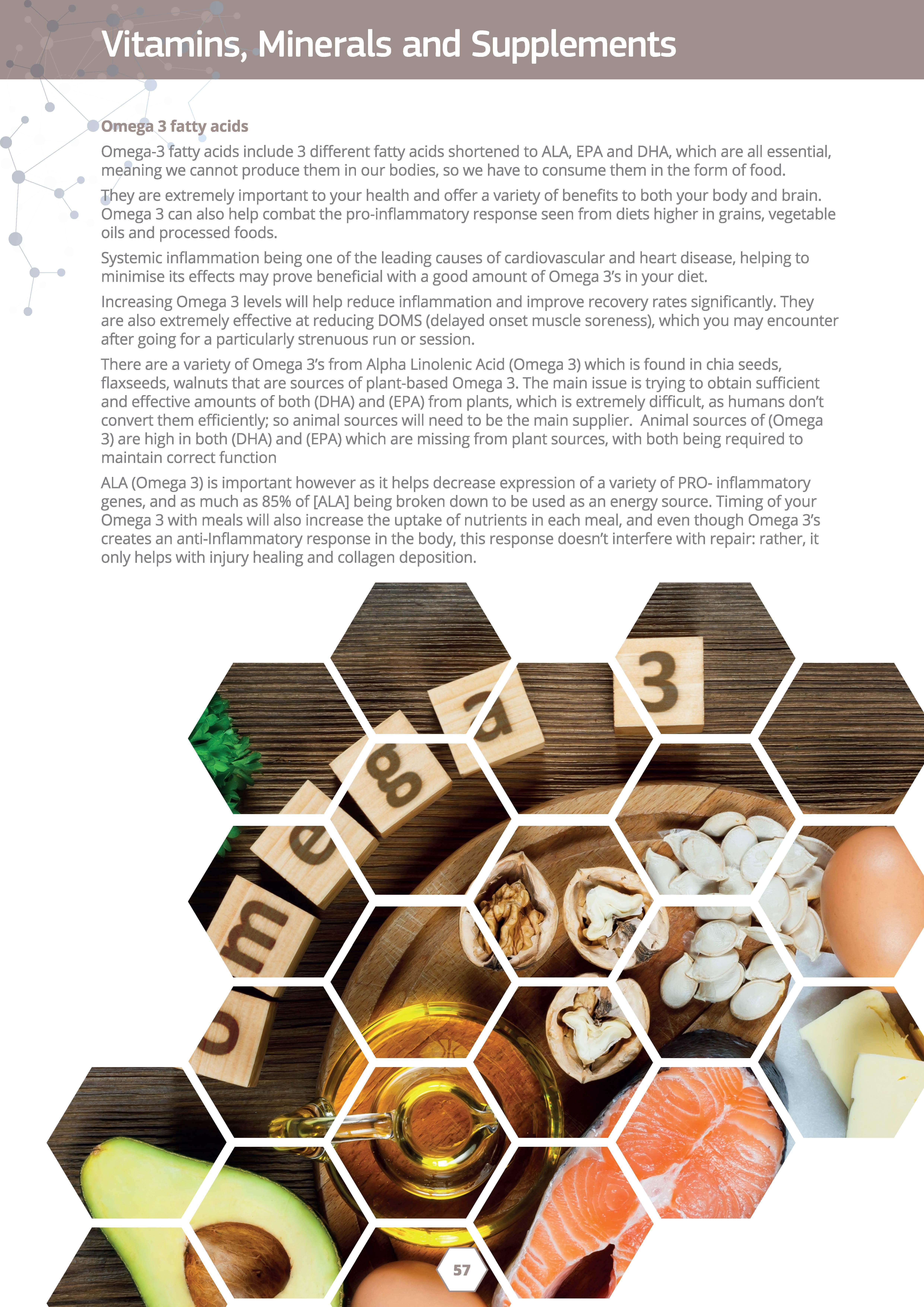
•
Studies have indicated that a diet rich in essential fatty acids, and higher Omega 3 fatty acids (i.e. Linolenic acid [ALA], eicosapentaenoic acid [EPA], and docosahexaenoic [DHA] have been generally associated with decreased biomarkers of inflammation and increasing overall health.

ALA forms of omega-3 fatty acids for improvement and prevention of the following health conditions:
• Cardiovascular disease
• Hypertension
• Excessive blood clotting
• Pregnancy/lactation
•PMS
• Fibrocystic breast disease
EPA and DHA forms of omega-3 fatty acids for improvements and prevention of the following health conditions:
• Cardiovascular disease
• Hypertension
• High cholesterol
• Diabetes
• Excessive blood clotting
• Alzheimer's and Parkinson's disease
• Nervous system development
• Depression
• Bipolar disorder
•
Calcium
Calcium is the best-known mineral needed for strong bones. As one of the most abundant minerals in the body, Calcium is mostly located in the bones and teeth. Other necessary nutrients for strong bones are vitamin D and magnesium, along with many other minerals and vitamins.
• Low calcium intake has been associated with a multitude of disorders, such as a risk of hypertension, preclampsia, premenstrual syndrome, obesity, polycystic ovary syndrome and hyperparathyroidism.
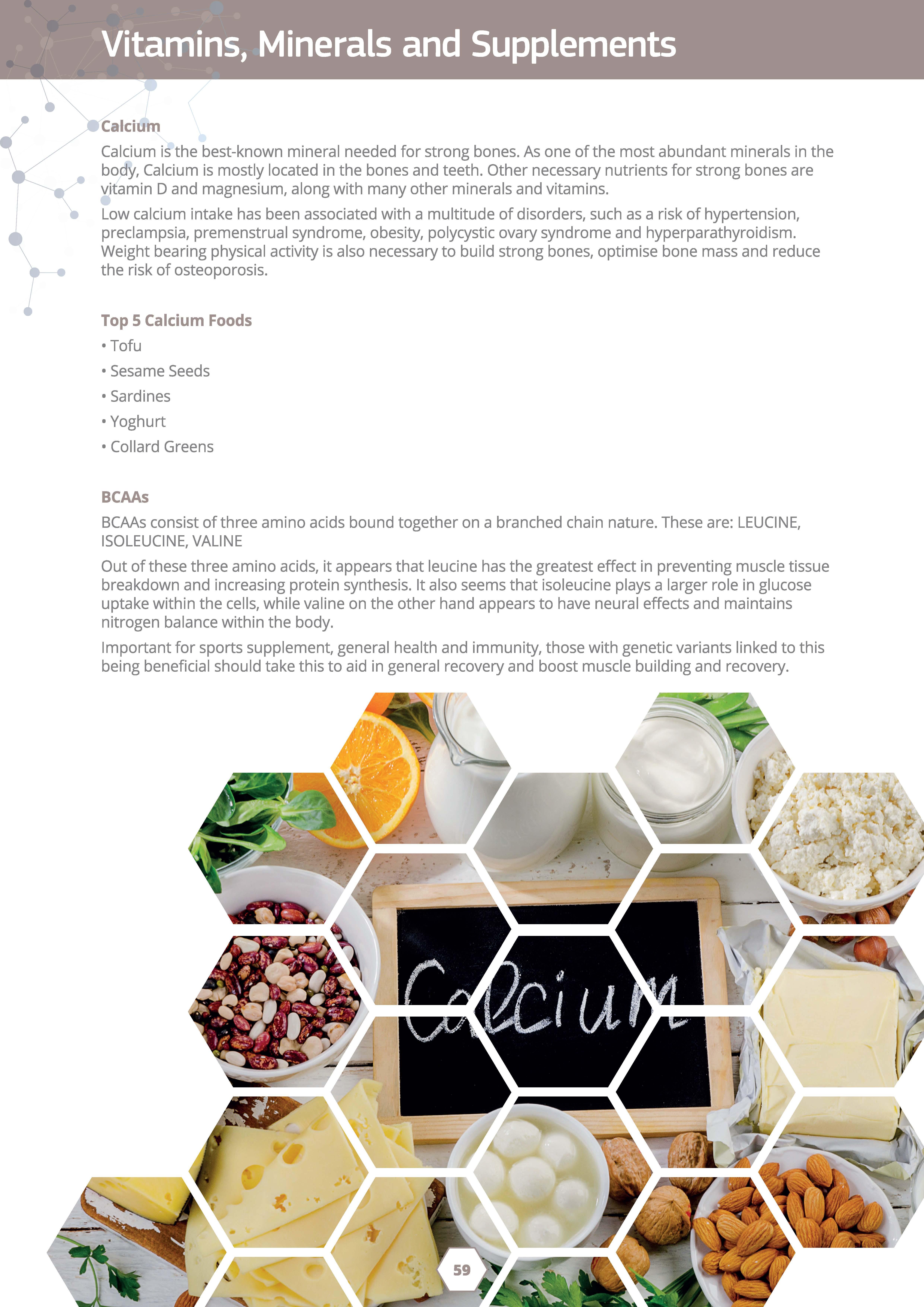
Weight bearing physical activity is also necessary to build strong bones, optimise bone mass and reduce
• the risk of osteoporosis.
Top 5 Calcium Foods
• Tofu
• Sesame Seeds
• Sardines
• Yoghurt
• Collard Greens
BCAAs
BCMs consist of three amino acids bound together on a branched chain nature. These are: LEUCINE, ISOLEUCINE, VALINE
Out of these three amino acids, it appears that leucine has the greatest effect in preventing muscle tissue breakdown and increasing protein synthesis. It also seems that isoleucine plays a larger role in glucose uptake within the cells, while valine on the other hand appears to have neural effects and maintains nitrogen balance within the body.
Important for sports supplement, general health and immunity, those with genetic variants linked to this being beneficial should take this to aid in general recovery and boost muscle building and recovery.
• •
Those in the "not essential" category should only take BCMs if on a restricted diet (lower whole proteins) or restricting calories to lose weight whilst training intensely however EMS (essential amino acids) are superior for those on restricted protein diets, BCMs are better suited to those who are meeting protein needs but are training intensely.
BCM supplements have the same components. Leucine, lsoleucine, Valine, however they will have differing ratios of each. Those with a genetic increase in benefit should use a ratio higher in Leucine, this often looks like 6:1 :1, 8:1 :1. Those wishing to take BCMs without the genetic benefit should look at lower ratios 4:1 :1 as an example. Those with a balanced diet will not require BCMs in most circumstances
Choline
Choline is a water-soluble nutrient that is neither classified as a vitamin or a mineral but is often grouped with the B-complex family. Until recently it was incorrectly thought that we could produce enough internally to meet our daily needs.

Luckily choline is contained in a wide variety of food groups with eggs, chicken, salmon and brussels sprouts all containing good levels. Deficiency can cause a host of health issues from reduction in metabolism and transport of lipids from the liver, muscle damage, methylation and down regulation of neurotransmitters.
Choline is important for brain health and supplements are known as nootropics, they aid in thinking tasks and learning.
Top 5 Choline foods:
• Eggs
• Fish
• Beef
• Beans
• Nuts
However, in supplement form alpha-gpc is the best method to get usable choline into the body.
Glutamine
Glutamine is not an essential amino acid but is considered conditionally essential and the most common found in the body. It has a variety of important roles, from metabolising protein, reducing muscle breakdown, boosting immune, digestive and brain function, to helping the body to produce the Human 6rowth Hormone. One of its most important roles is maintaining a nitrogen balance throughout the body Glutamine is used by a variety of organs such as the kidneys, liver, small intestines, with the skeletal muscle also accounting for 70% of glutamine production. It is extremely useful for intestinal and digestive • health as the tissue lining that protects the intestines prefers glutamine as its fuel source.
•
Top 5 Glutamine Foods.
• Bone Broth
• Grass Fed Beef
• Spirulina
• Cottage Cheese
• Asparagus
An important amino acid, sports supplements and digestive aid, it is required in times of injury, inflammation, illness and can be handy for those at genetic risk of injury. Athletes on a restricted diet or are close to overtraining may also benefit from glutamine. You will usually only find the one form of L-Glutamine and if it is pure it should sink in water.
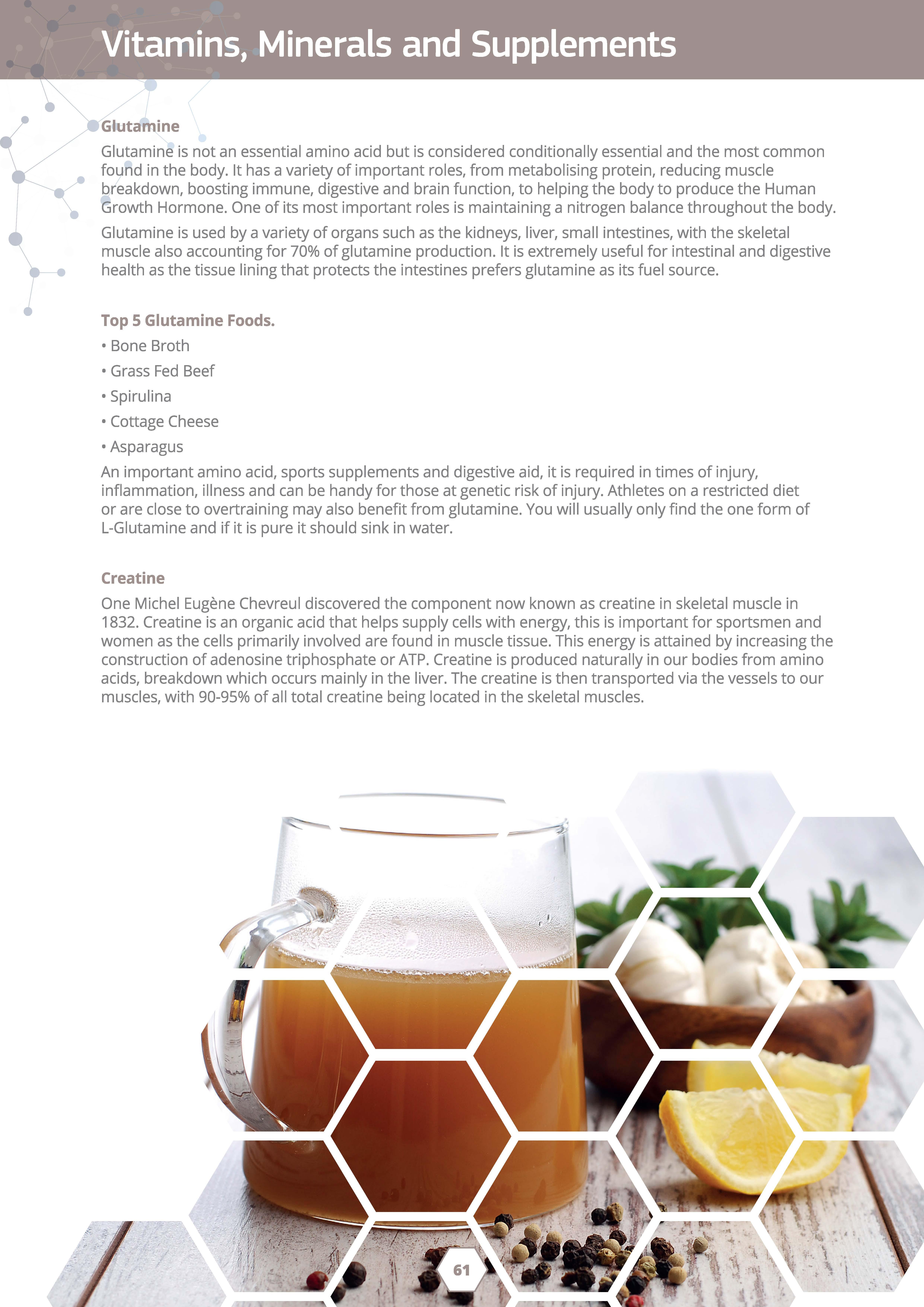
Creatine
One Michel Eugene Chevreul discovered the component now known as creatine in skeletal muscle in 1832. Creatine is an organic acid that helps supply cells with energy, this is important for sportsmen and women as the cells primarily involved are found in muscle tissue. This energy is attained by increasing the construction of adenosine triphosphate or ATP. Creatine is produced naturally in our bodies from amino acids, breakdown which occurs mainly in the liver. The creatine is then transported via the vessels to our muscles, with 90-95% of all total creatine being located in the skeletal muscles.
As creatine is manufactured by the body from the amino acids: L-methionine, L-arginine and glycine it is not an "essential" nutrient, this being the case 50% of all our stored creatine comes from food, and meat in particular, studies show that vegetarians have a much lower creatine store within the skeletal muscles as non-vegetarians. Now this doesn't mean that vegetarians should supplement actual creatine, although that is an option
Top 5 Creatine Foods .
• Herring
• Pork
• Beef
• Salmon
• Tuna
A more natural method of lifting the creatine levels would be to supplement foods that contain the abovementioned amino acids thus allowing the body to synthesize the required creatine.
Creatine is well studied and should be utilised by healthy power athletes, weightlifters, sports people in general who have any maximal/submaximal and others, this aspect analyses if increasing creatine will aid in power-based sports. It is important to note that loading dosages are not necessary and that there are a number of potential creatine supplements:
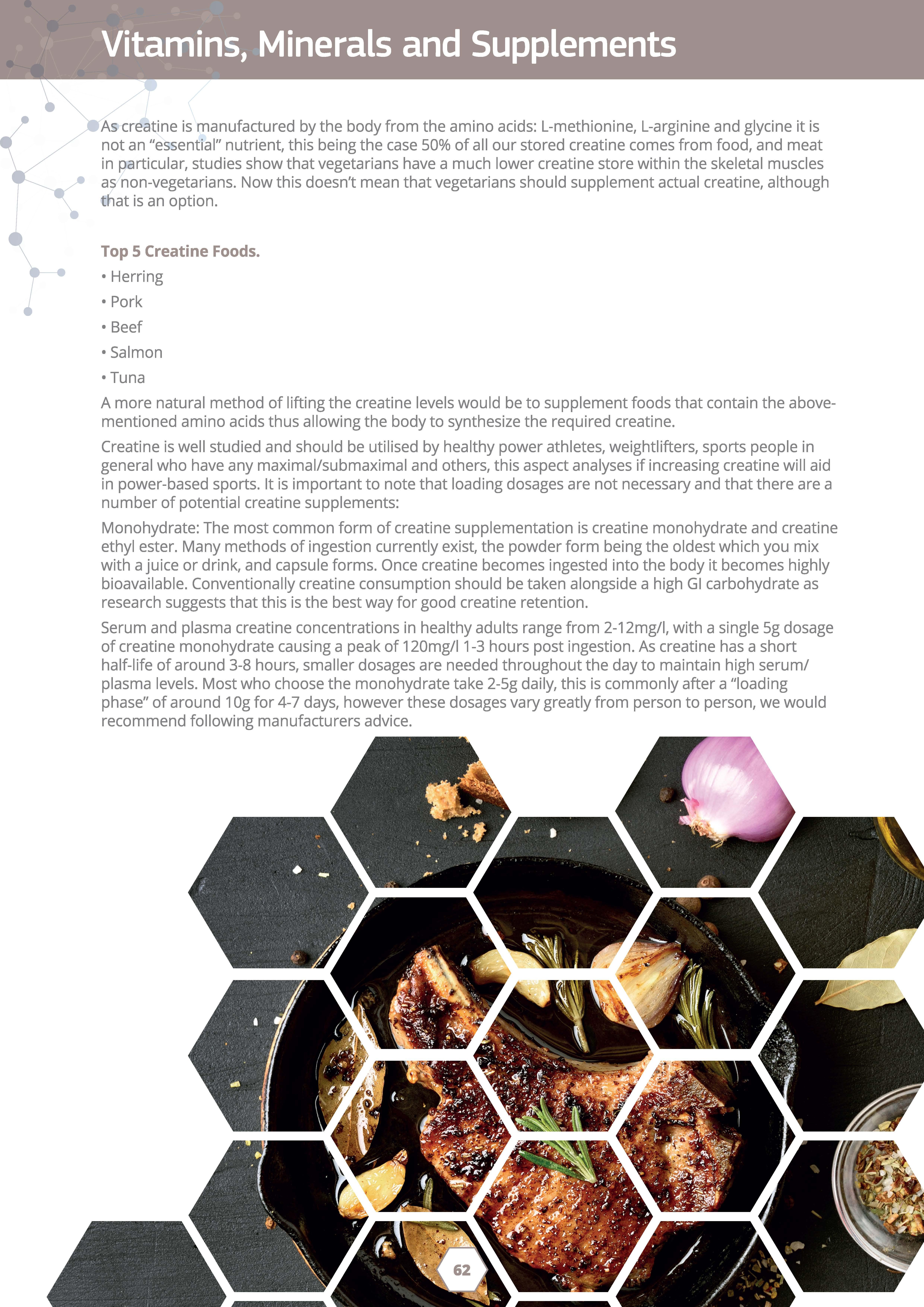
Monohydrate: The most common form of creatine supplementation is creatine monohydrate and creatine ethyl ester. Many methods of ingestion currently exist, the powder form being the oldest which you mix with a juice or drink, and capsule forms. Once creatine becomes ingested into the body it becomes highly bioavailable. Conventionally creatine consumption should be taken alongside a high GI carbohydrate as research suggests that this is the best way for good creatine retention.
Serum and plasma creatine concentrations in healthy adults range from 2-12mg/l, with a single 5g dosage of creatine monohydrate causing a peak of 120mg/l 1-3 hours post ingestion. As creatine has a short half-life of around 3-8 hours, smaller dosages are needed throughout the day to maintain high serum/ plasma levels. Most who choose the monohydrate take 2-Sg daily, this is commonly after a "loading phase" of around 10g for 4-7 days, however these dosages vary greatly from person to person, we would recommend following manufacturers advice.
• •
• •
Buffered: Kre-Alkalyn is a buffered form of creatine monohydrate, the claims being that it can cause greater creatine retention at a lower dosage and with lower side effects. However, most research suggests that this form has no difference in effect compared with monohydrate. Any research that says otherwise has been found to be biased and/or made by the manufacturer.
reatine ethyl ester (CEE): CEE is the second most common form of creatine on the market against monohydrate, it has been hyped to have higher absorption and a longer half-life than that of monohydrate. However, as of now no peer reviewed studies have shown to back up these claims. The ISSN have shown that the added ethyl group actually reduces effectiveness of the supplement against the monohydrate version.
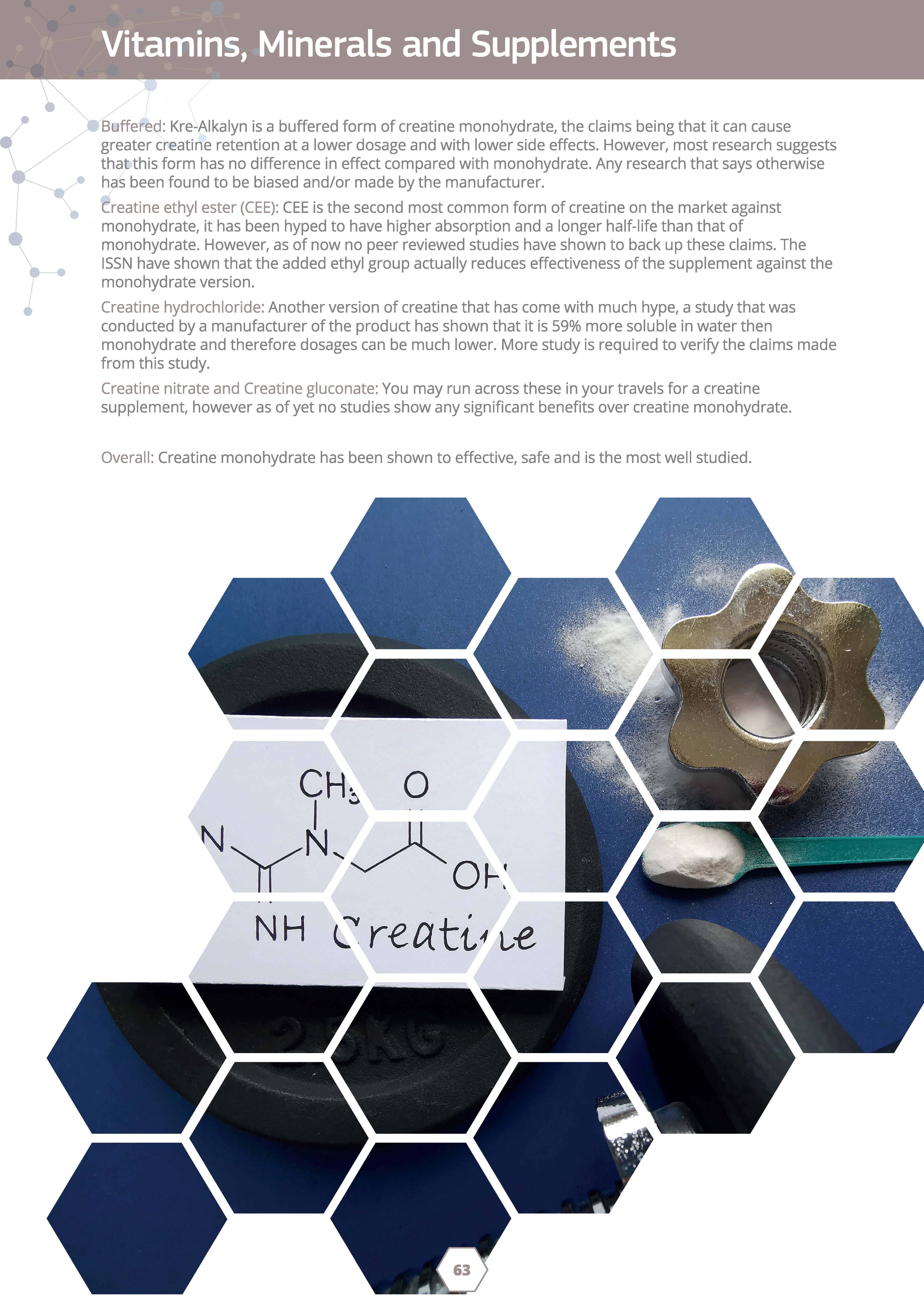
Creatine hydrochloride: Another version of creatine that has come with much hype, a study that was conducted by a manufacturer of the product has shown that it is 59% more soluble in water then monohydrate and therefore dosages can be much lower. More study is required to verify the claims made from this study.
Creatine nitrate and Creatine gluconate: You may run across these in your travels for a creatine supplement, however as of yet no studies show any significant benefits over creatine monohydrate.
Overall: Creatine monohydrate has been shown to effective, safe and is the most well studied.
NH
Beta-alanine
Beta-Alanine, commonly known as alanine, is a non-essential amino acid, and unlike the majority of amino acids, it's not used to synthesise proteins. Once consumed, beta-alanine is quickly converted to carnosine, which is then stored in your skeletal muscle. •
• Beta-alanine is extremely effective at reducing lactic acid build up in your muscles during intense exercise, which can lead to an increase in performance. It can also be used post exercise to buffer and remove the lactic acid that has built up - allowing the body to recovery more effectively
Top 5 Alanine Foods.
• Cod
• Pork
• Cured Beef
• Turkey, Eggs
This aspect correlates with the muscle stamina aspect found in the DNA result.
Arginine
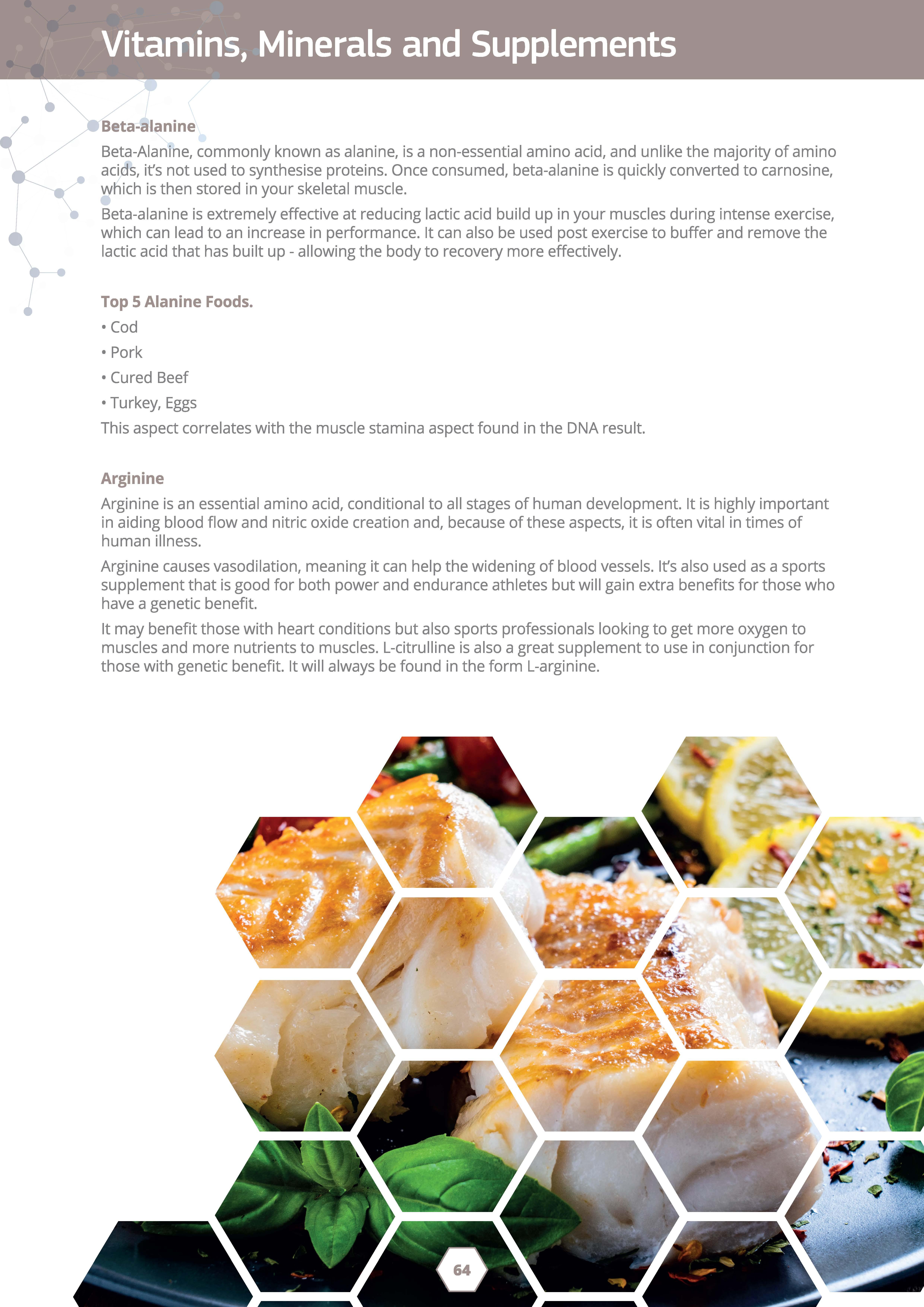
Arginine is an essential amino acid, conditional to all stages of human development. It is highly important in aiding blood flow and nitric oxide creation and, because of these aspects, it is often vital in times of human illness.
Arginine causes vasodilation, meaning it can help the widening of blood vessels. It's also used as a sports supplement that is good for both power and endurance athletes but will gain extra benefits for those who have a genetic benefit.
It may benefit those with heart conditions but also sports professionals looking to get more oxygen to muscles and more nutrients to muscles. L-citrulline is also a great supplement to use in conjunction for those with genetic benefit. It will always be found in the form L-arginine.
• •
Core Health insights provides 11 key areas surrounding various topics, which are crucial to your health and wellbeing, such as:
• Anti-Ageing
• Eye Health
• Gut Health
• Heart Health
• Immunity
• Injury Risk
• Mental Health
• Muscle Health
• Skin Health
• Sleep
• Stress
Each area is then broken down into subcategories to provide hyper personalised health recommendations as seen below.
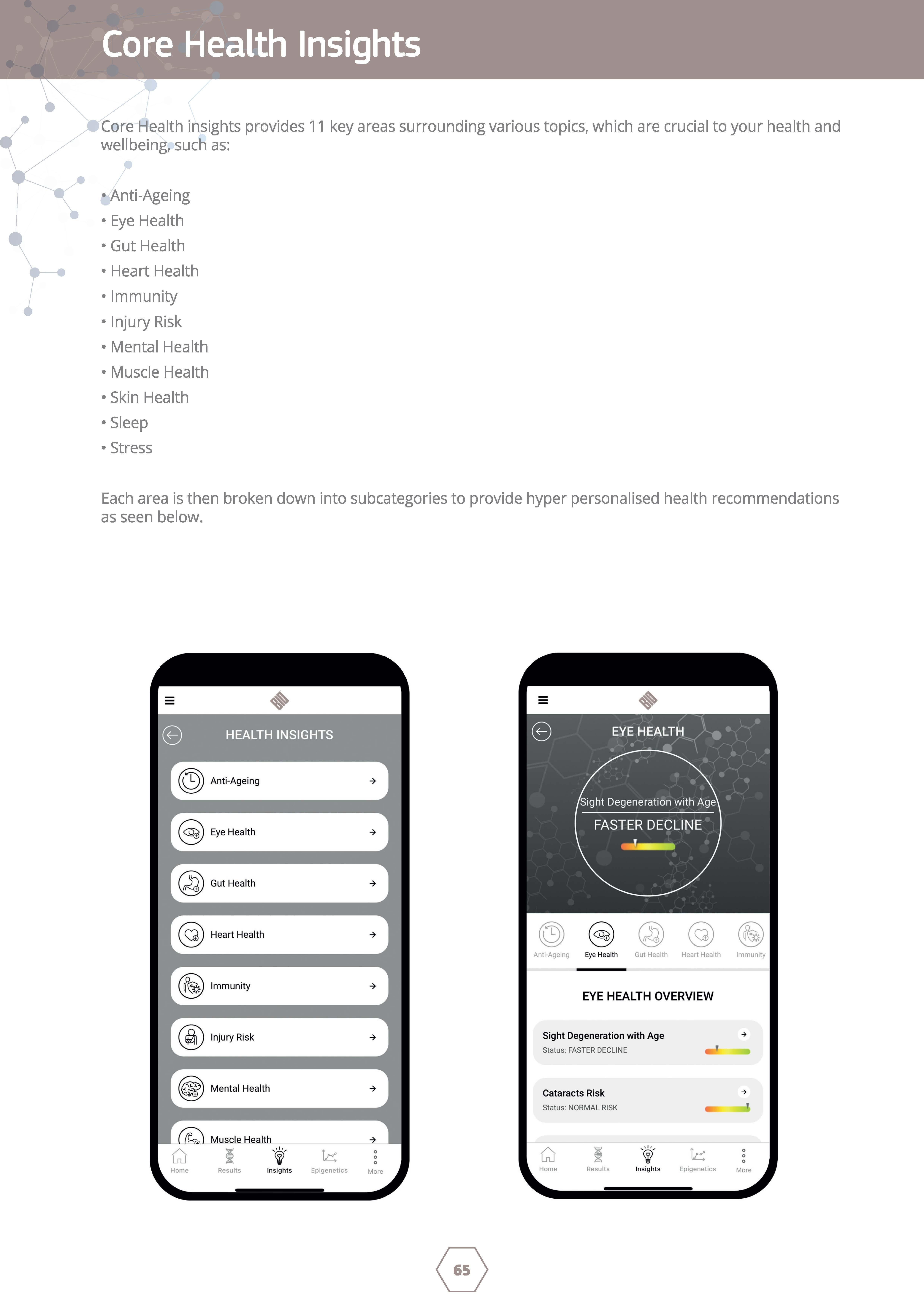
•
0 Anti-Ageing Eye Hea lt h Gut Health Heart Health Immunity EYE HEALTH OVERVIEW Sight Degeneration with Age Status: FASTER DECLINE Cataract s Ri s k Status: NORMAL RISK Home Results Insights Epigenetics More
We can now take a closer look at 3 areas which will be extremely important for both you as well as your clients in relation to training, nutrition and overall health and wellbeing.
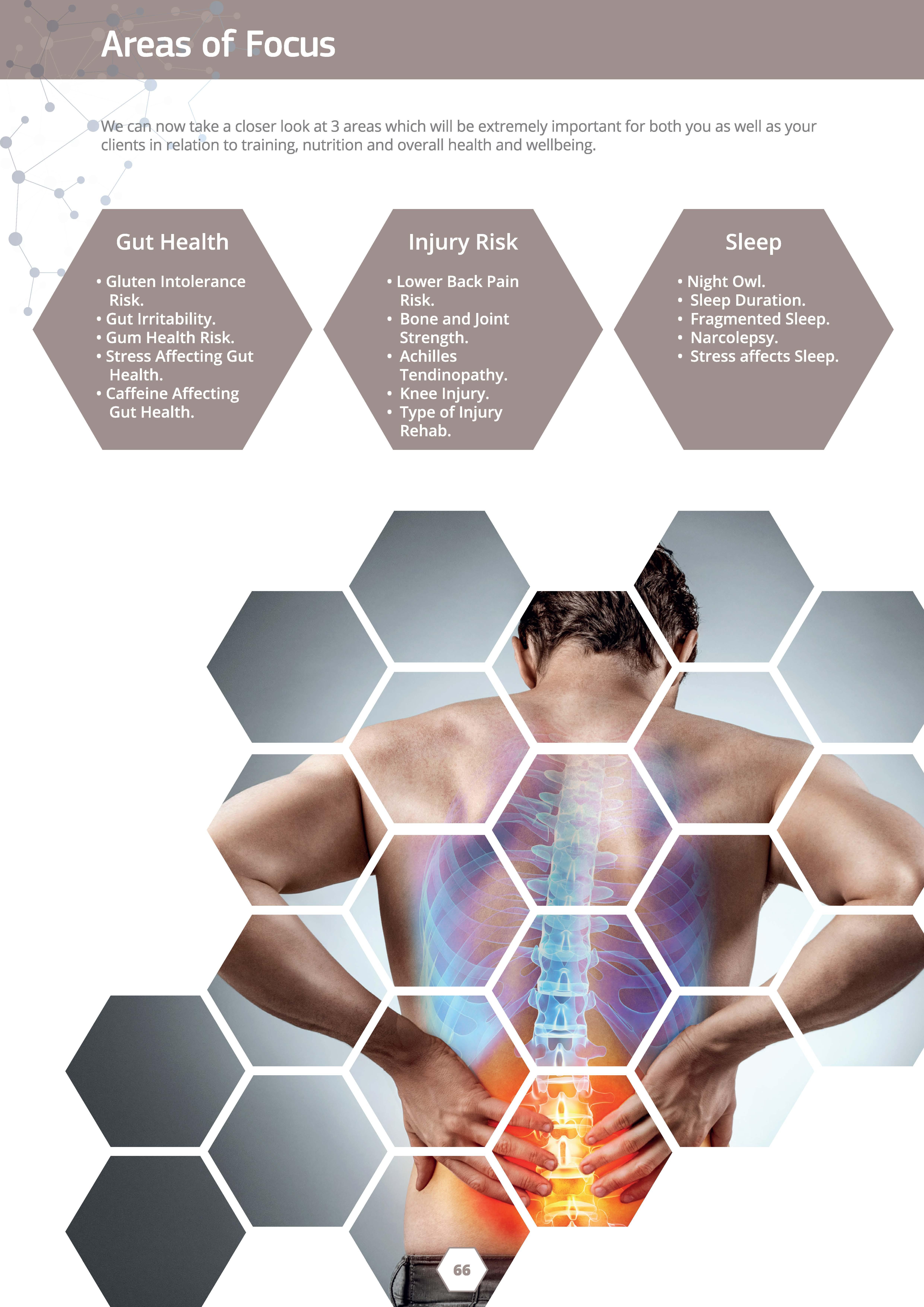
•
•
The Anti-Ageing aspect looks at 6 further areas:

• Physical decline with Age.
• Keeping cognition with Age.
• Testosterone with Ageing
• Bone strength decline with Ageing.
• Back pain with Ageing
• Stress and Ageing.
Human ageing is often just represented in time and how many years the person has been alive. However, in reality, a multitude of aspects occur and should be considered when thinking about a person's age. Physical, psychological and social changes all impact the way that a person age. Some may be positive like financial stability, maturity, and knowledge, and some negative such as a reduced reaction speed and hearing loss.
Physical fitness is an aspect heavily associated with age, with many becoming less physically active as they get older. Some genetic variants linked to this process are faster or more pronounced and this aspect looks at these variants, highlighting potential interventions you can put in place.
Physical fitness is vital in the maintenance of good quality of life, mobility, muscle strength and bone strength. Each are related to physical activity and play a huge role in ageing well vs. ageing poorly.
Physical decline with Age.
Physical fitness is an aspect heavily associated with age, with many becoming less physically active as they get older. Some genetic variants are linked to this process are faster or more pronounced and this aspect looks at these variants, highlighting potential interventions you can put in place.
Physical fitness is vital in the maintenance of good quality of life, mobility, muscle strength and bone strength. Each are related to physical activity and play a huge role in ageing well vs. ageing poorly.
•
0
Keeping cognition with Age.
Cognition is the process at which we acquire knowledge and understand experiences, senses and thought. Cognition can be an umbrella term for long- and short-term memory, knowledge formation, attention span, problem solving, language, and comprehension skills. We know that as we age cognition begins to falter and certain genetic variants are linked to this occurring at a faster rate. Understanding these can therefore help us implement changes that can help improve the process
Testosterone with Ageing.
Testosterone is the main male sex hormone. It is an anabolic agent and plays a vital role in male characteristics such as the development of male reproductive tissues, increasing muscle and bone mass, hair growth and the deepening of the voice. Testosterone is also essential for bone health, and those with lower levels have frailty and potential bone density loss.
On average males have 7 - 8 times the testosterone levels of females, however, females are more sensitive to the hormone. Testosterone in males' peaks in the 20's and then begins to decline with age. It is therefore important to know if your genes are affecting your testosterone levels as some may have higher and some may have lower.
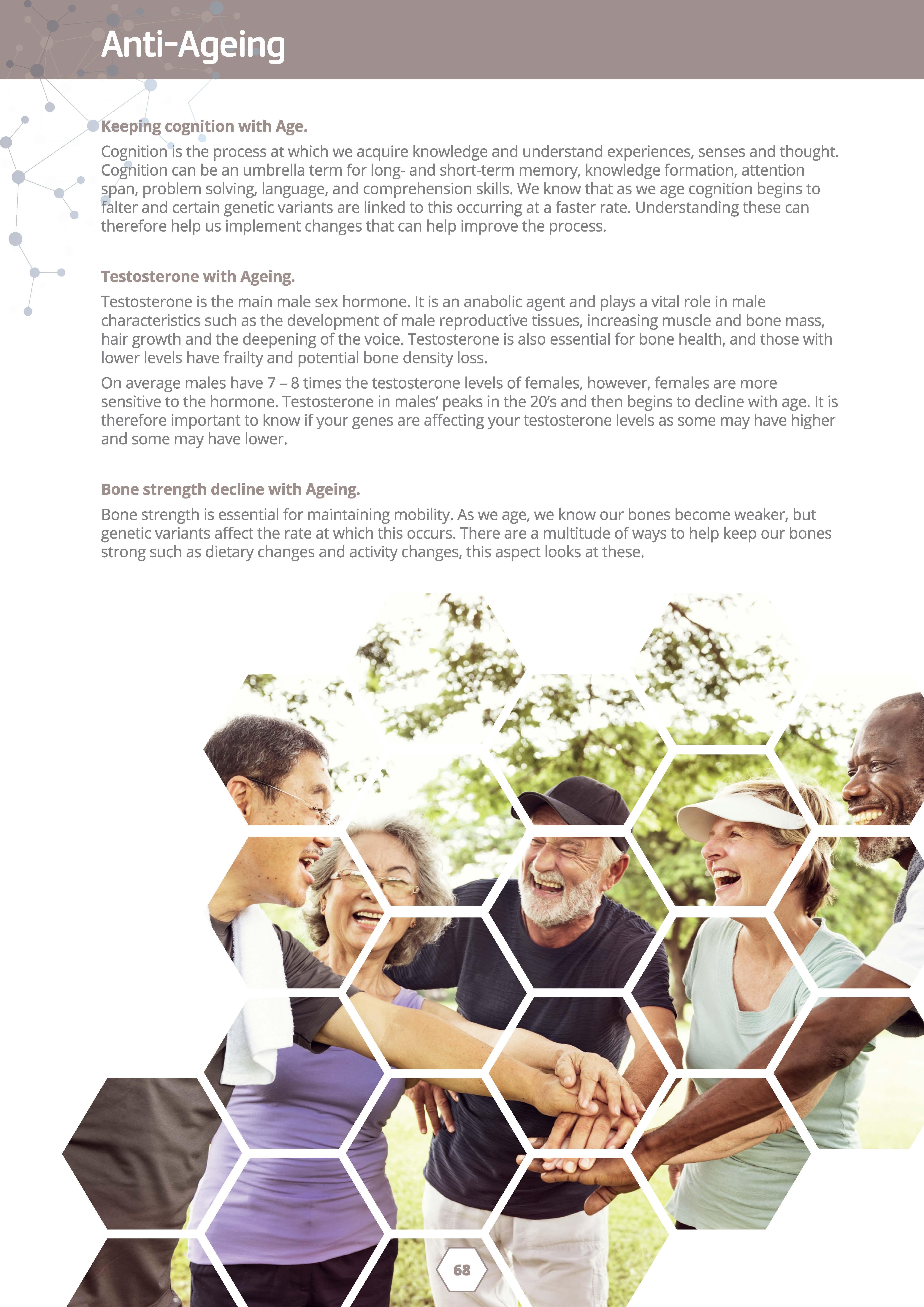
Bone strength decline with Ageing.
Bone strength is essential for maintaining mobility. As we age, we know our bones become weaker, but genetic variants affect the rate at which this occurs. There are a multitude of ways to help keep our bones strong such as dietary changes and activity changes, this aspect looks at these.
•
Back pain with Ageing.
Back pain is one of the most common complaints people have. There are a whole host of reasons why someone experiences back pain: obesity, spinal disease, trauma, smoking, general disease such as cancer. However, the most common cause is age related degeneration. •
• This aspect concentrates on the genes that affect degeneration of the spine, which include disc degeneration and general bone strength. Understanding this aspect allows superior interventional activities and dietary changes to be made
Stress and Ageing.
Stress is well known to cause premature ageing. This is down to the affect stress has on our hormones, sleep and general cognition. Keeping stress levels low allows the body to recover from the day, helps prevent high blood pressure and keep cortisol in check. Some people may find that their genes impact how they respond to stress and therefore how stress may age them, this aspect looks into that.
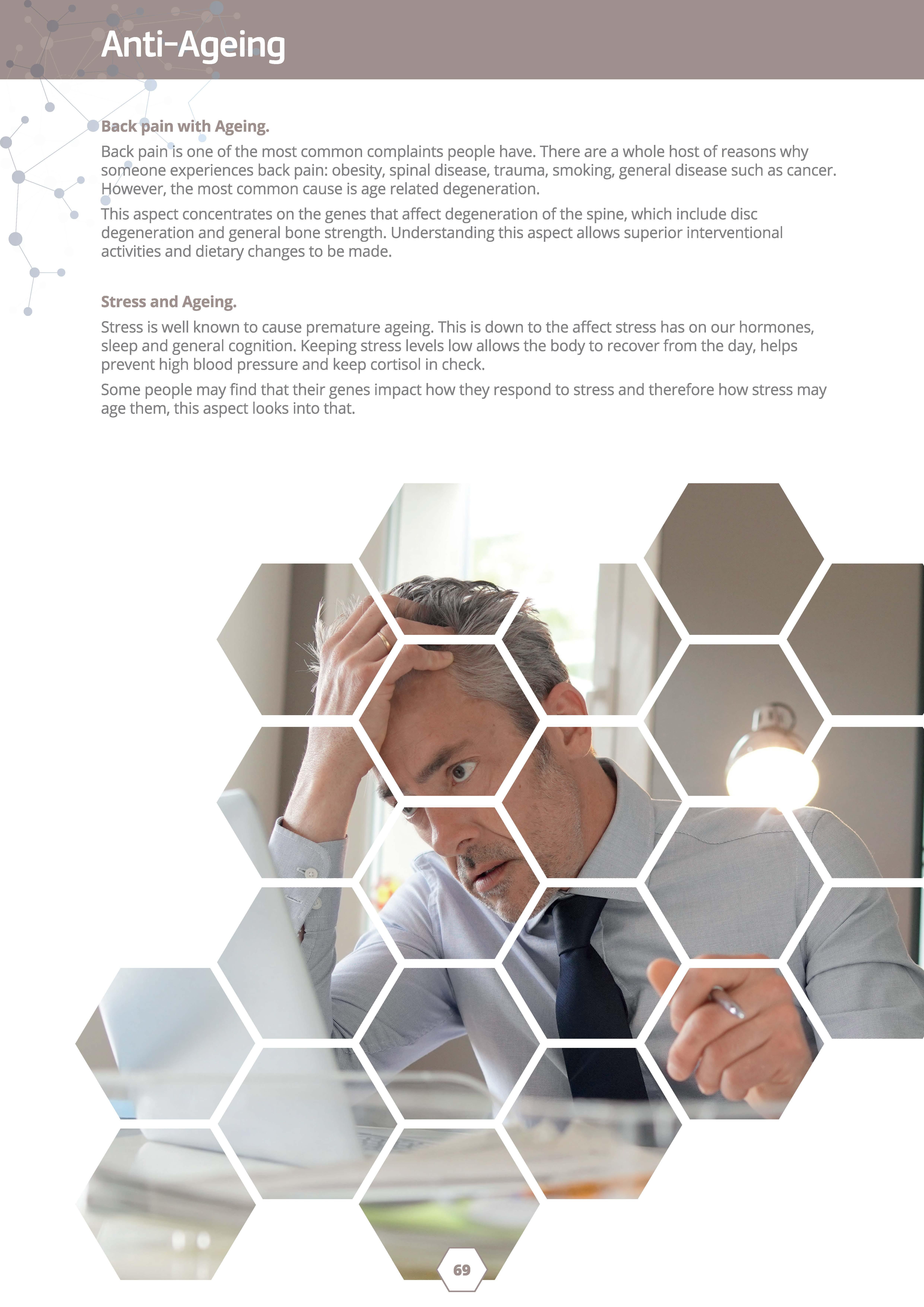
•
•
•
The eye health insight looks at 5 further areas.
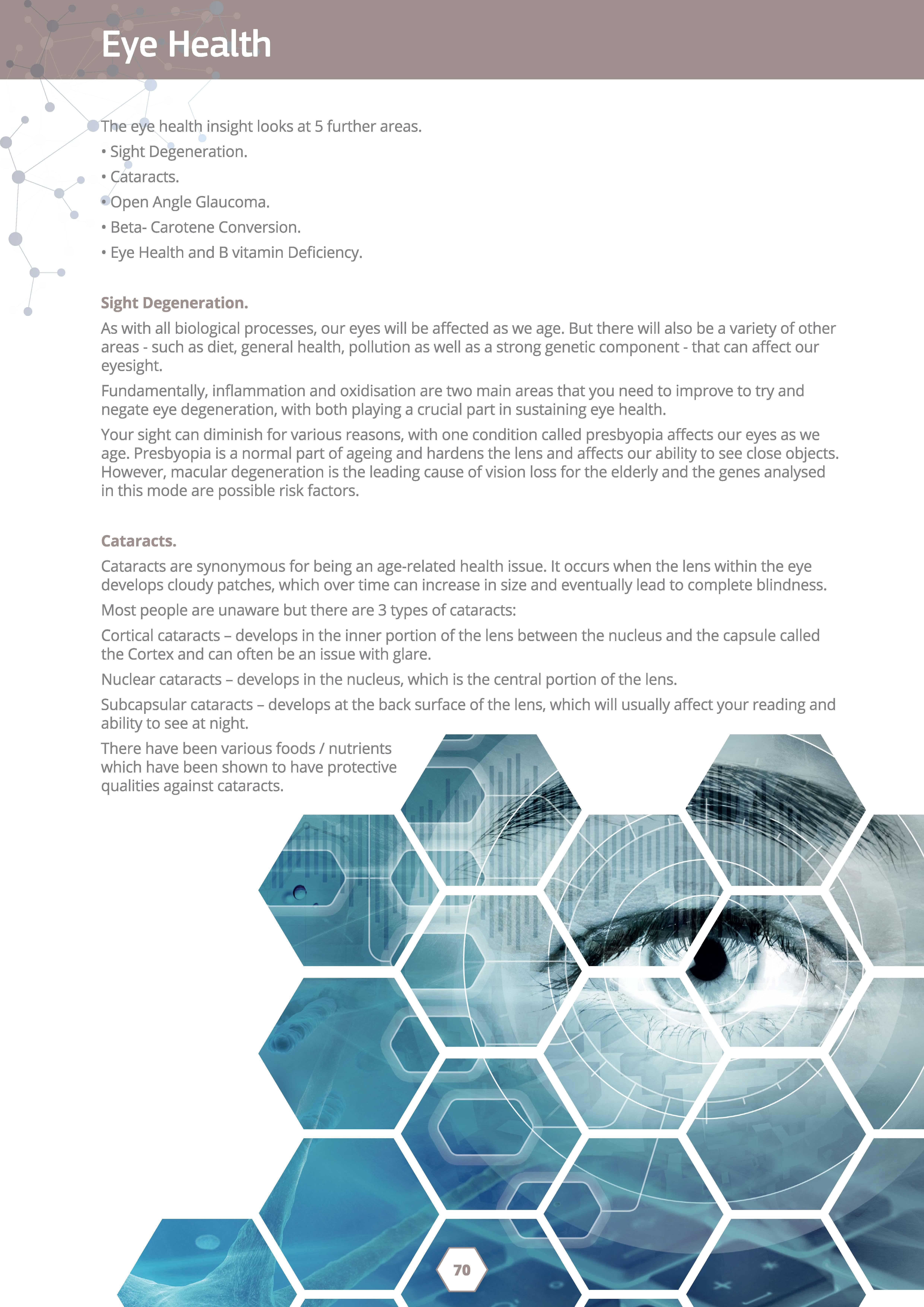
• Sight Degeneration.
• Cataracts.
• Open Angle Glaucoma
• Beta- Carotene Conversion.
• Eye Health and B vitamin Deficiency
Sight Degeneration.
As with all biological processes, our eyes will be affected as we age. But there will also be a variety of other areas - such as diet, general health, pollution as well as a strong genetic component - that can affect our eyesight.
Fundamentally, inflammation and oxidisation are two main areas that you need to improve to try and negate eye degeneration, with both playing a crucial part in sustaining eye health.
Your sight can diminish for various reasons, with one condition called presbyopia affects our eyes as we age. Presbyopia is a normal part of ageing and hardens the lens and affects our ability to see close objects. However, macular degeneration is the leading cause of vision loss for the elderly and the genes analysed in this mode are possible risk factors.
Cataracts.
Cataracts are synonymous for being an age-related health issue. It occurs when the lens within the eye develops cloudy patches, which over time can increase in size and eventually lead to complete blindness.
Most people are unaware but there are 3 types of cataracts:
Cortical cataracts - develops in the inner portion of the lens between the nucleus and the capsule called the Cortex and can often be an issue with glare.
Nuclear cataracts - develops in the nucleus, which is the central portion of the lens.
Subcapsular cataracts - develops at the back surface of the lens, which will usually affect your reading and ability to see at night.
There have been various foods I nutrients which have been shown to have protective qualities against cataracts.
Open Angle Glaucoma.
There are two types of glaucoma/ eye conditions that damage the optic nerve, open angle and angle closure. In this section we will be looking at your genetic predisposition for developing open angle glaucoma or the "Silent thief of sight'' as it is often called, and which is by far the most common. The vast majority of people with OAG usually feel healthy and have little to no changes to their vision, with their symptoms usually developing slowly over time and unfortunately with the damage being permanent.
OAG usually manifests and starts reducing your peripheral or side vision, and develops into tunnel vision over time, and that will also increase intraocular pressure (IOP), which is the fluid pressure within the eye. There will be various reasons for developing OAG, from genetics, age, lifestyle (stress and sleep) to even environmental factors such as pollution and ultraviolet build up, which if left untreated will eventually lead to blindness.
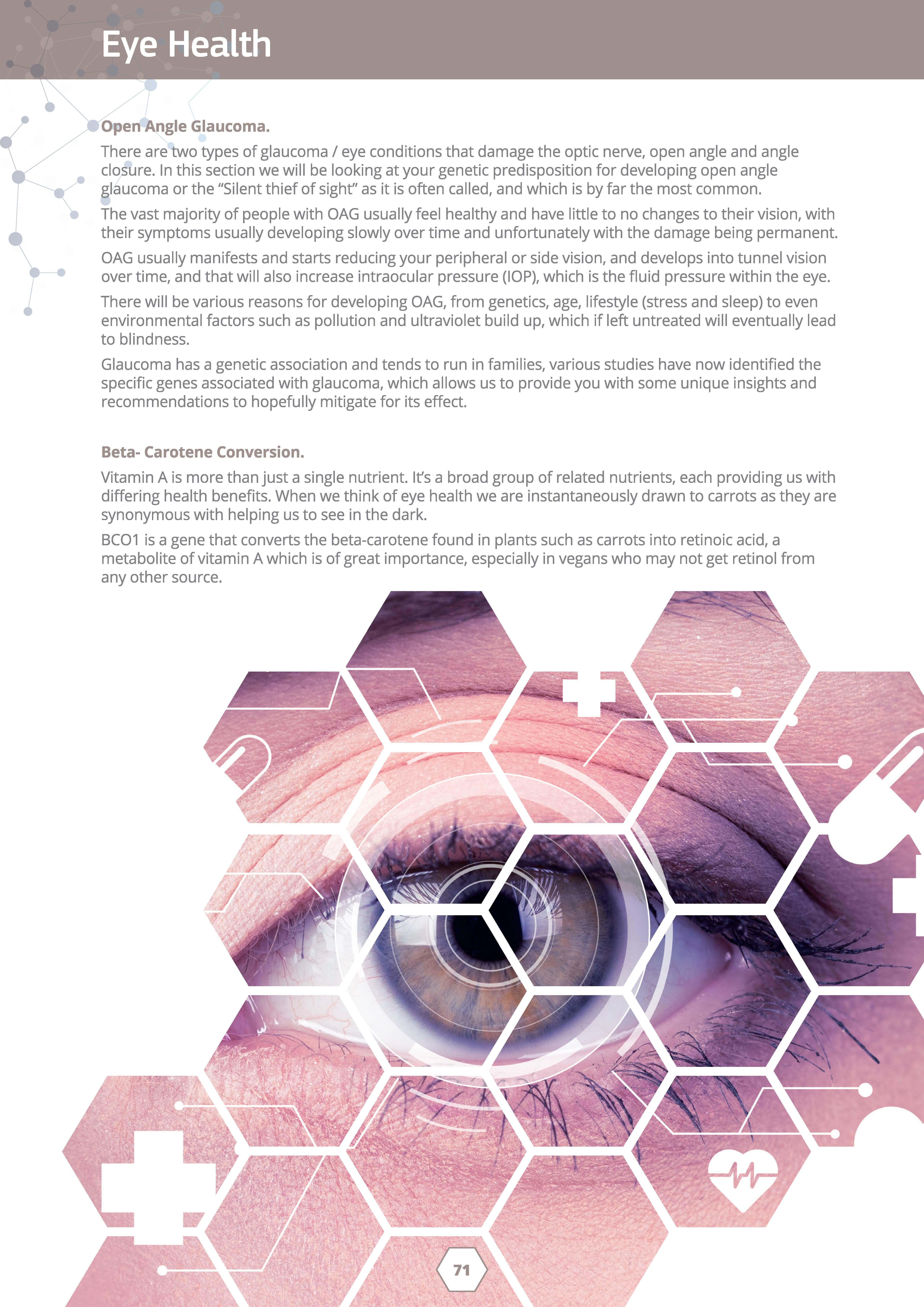
Glaucoma has a genetic association and tends to run in families, various studies have now identified the specific genes associated with glaucoma, which allows us to provide you with some unique insights and recommendations to hopefully mitigate for its effect.
Beta- Carotene Conversion.
Vitamin A is more than just a single nutrient. It's a broad group of related nutrients, each providing us with differing health benefits. When we think of eye health we are instantaneously drawn to carrots as they are synonymous with helping us to see in the dark.
BCO1 is a gene that converts the beta-carotene found in plants such as carrots into retinoic acid, a metabolite of vitamin A which is of great importance, especially in vegans who may not get retinal from any other source.
•
Eye Health and B vitamin Deficiency.
B vitamins are made up of 8 key vitamins that form the B- vitamin family. They will both individually and collectively offer a whole variety of unique health properties that can help protect your eyes. These will include reducing oxidative stress and homocysteine levels, which have both shown to cause •
• tissue degeneration and break down. B vitamins are also fundamentally important for a process called methylation, which is a process that helps regulate your gene expression otherwise known as epigenetics.
Methylation and epigenetics are extremely important as they are the intersection' between genetics, nutrition, and environment and how diet, micronutrients, exercise and sleep can all change the expression of our genes. For the most part we have two main areas that will affect our health, nature otherwise known as our genes and nurture through our lifestyle and environment, which is known as epigenetics. So, the importance of B vitamins alongside other key nutrients such as folate and choline cannot be underestimated with regards to keeping your gene health functioning in the correct way.

Anti-Ageing Eye Hea lt h Gut Health Heart Health Immunity EYE HEALTH OVERVIEW Sight Degeneration with Age Status: FASTER DECLINE Cataracts Risk Status: NORMAL RISK Home Results In sig ht s Epigenetics 0 0 0 More 0 Anti-Ageing Eye Hea lt h Gut Health Heart Health Immunity Eye Health and B Vitamin Deficiency • Genes of interest: NBPF3, MTHFR, SLC19Al Eye Health and B Vitamin Deficiency B vitamins are made up of 8 key vitamins that form the Bvitamin family. They will both individually and collectively offer a whole variety of unique health properties that can help protect your eyes. These will include reducing oxidative stress and homocysteine levels, which have hnth c:::hnwn t.n c_;:u 1.sP ti.ss::1 JP rlpm::r.npr~tinn ~nrl hn::i.;:1k Home Results In sights Epigenetics 0 0 0 More
•
•
•
The Gut health insight looks at 5 further areas.
• Gluten Intolerance Risk.
• Gut Irritability.
• Gum Health Risk
• Stress affecting Gut Health.
• Caffeine Affecting Gut Health
Gut Health looks at gluten tolerance, which helps understand if you are at risk of celiac disease, which can help alter diets to better aid your overall health.
Gut Irritability analyses the genes associated with gut inflammation and would be useful in dietary changes to help reduce irritation with food choices, drink choices and superior nutrition. The gut health test also addresses if caffeine can cause gut issues or if stress can increase gut irritability so that you can make changes to food choices and lifestyle interventions which can improve general gut health.
Gluten intolerance and gluten sensitivity are two different things.
Gluten intolerance means you should not consume any gluten. Gluten sensitivity means that an individual may still be able to consume gluten, but the amount consumed needs to be monitored to a point where symptoms occur. Keeping a food diary of symptoms is the only way to determine how much one can consume.
Gluten Intolerance Risk.
Gluten is a protein contained in wheat, barley and rye and is found in a variety of everyday food items. It allows doughs to be more elastic and pliable and this is why gluten-containing grains have been used in breads and other baked goods for many years. It can be difficult to actually know if you have an intolerance to gluten as there may be little to no symptoms.
Typical symptoms of intolerance include stomach pain with possible diarrhoea when gluten begins to damage the intestinal lining. The small intestines are covered with millions of little octopus-like arms called villi, which pull nutrients in from our foods and absorb them into the blood stream.
Our bodies create enzymes that break gluten (a protein) down, but it can't fully break it down. Damage to the villi can occur due to gluten intolerance to such an extent that they cannot function correctly, and this can lead to a tremendous amount of inflammation and pain as well as eventually leading to malnutrition.
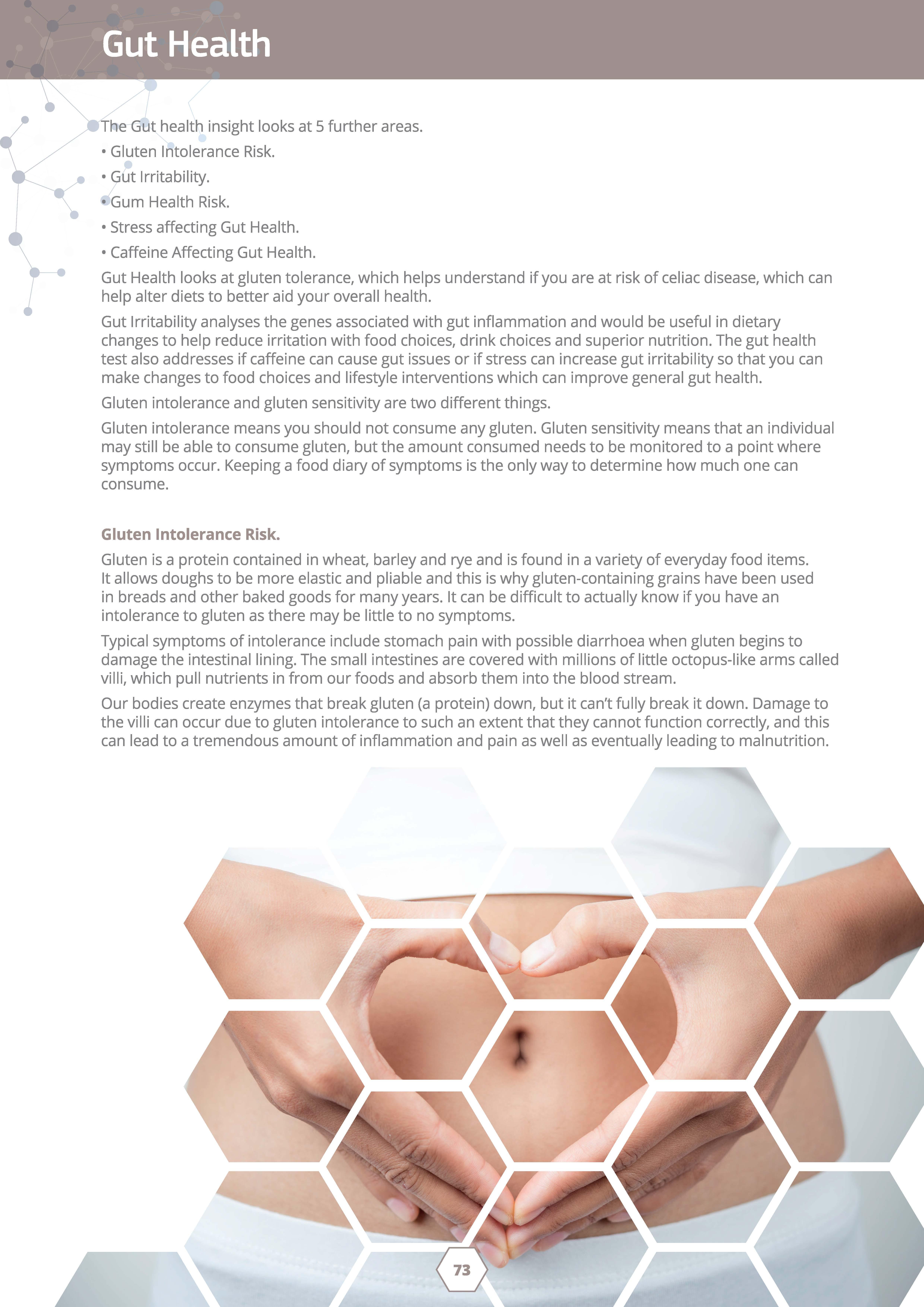
• •
Got Irritability.
Having an unhealthy gut can lead to a whole array of health issues, from IBS, leaky gut, and autoimmune iss es to raised inflammation and cholesterol. Each of us has over 100 trillion bacteria within our gut, which are required to metabolise the foods that we eat each day.
This bacterium turns food into fatty acids, proteins, amino acids and metabolises vitamins and minerals We also have the highest concentration of immune cells within the gut due to the fact it is in contact with the external environment.

Every time we have something to eat or drink the gut has to deal with it, so if there's something harmful or pathogenic inside, the immune cells within the gut will hopefully fight it off. The immune cells are separated by the gut barrier, so if this becomes run down and compromised then the immune cells start to kill the bacteria within the gut and attack the bacterial membrane.
Unfortunately, the immune cells cannot differentiate between good and bad bacteria, so if you have any issues with your gut lining you will find that many of the foods which contain "good bacteria" can actually be doing more harm than good.
Our genetics can link us to inflammation occurring within the gut and therefore it is important to have the knowledge to help our gut thrive and remain stable.
Gum Health Risk.
Gum health can be affected by both your lifestyle and certain genetic factors, from continually eating a diet high in sugar and processed foods, to smoking or being exposed to various medications or ever-increasing levels of pollution each day. There will also be a genetic component that we need to be aware of that will predispose us to having an increased risk of gum disease.
For instance, the gene CDKN2B has a strong association with periodontitis, which is a disease caused by bacteria inflaming the gums. This can lead to the teeth possibly falling out and eventual jaw damage.
•
Stress affecting Gut Health.
The connection between your brain and gut has now been well established, with the realisation that stress and anxiety will have a profound effect on our gut and overall health. This gives us some serious food for thought in regard to combating our daily stress levels. Stress can be brought on by a variety of factors, from work or family life to consuming certain types of food such as caffeine or sugar
There is also a strong genetic component, which will predispose us to having higher adrenaline levels or reduced ability to manufacture serotonin or dopamine. Obviously, we cannot legislate for what life throws • at us, but understanding specific triggers and then providing useful tools to hopefully negate their effect would prove extremely useful.
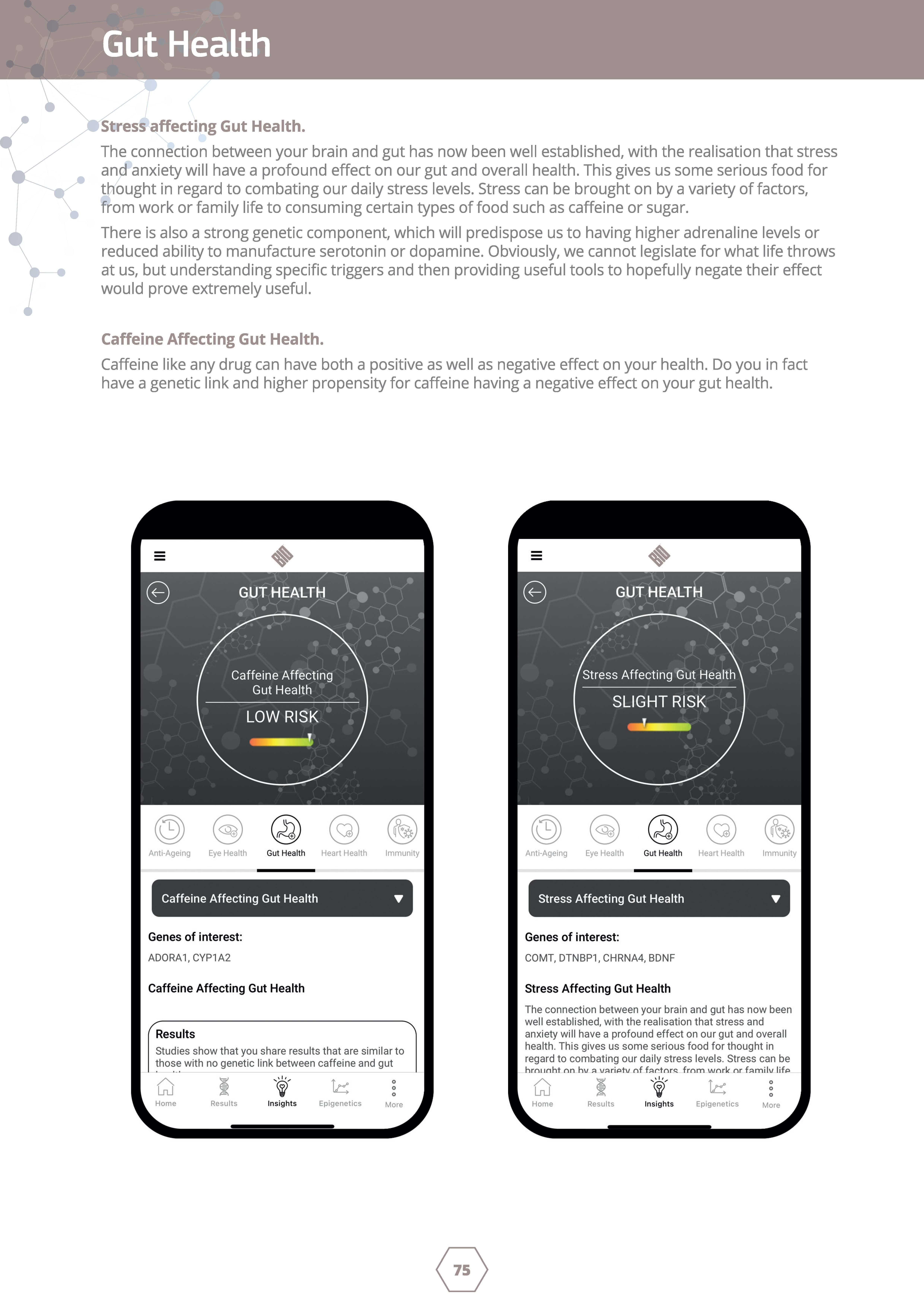
Caffeine Affecting Gut Health.
Caffeine like any drug can have both a positive as well as negative effect on your health. Do you in fact have a genetic link and higher propensity for caffeine having a negative effect on your gut health.
Anti-Ageing Eye Health Gut Healt h Heart Health Immunity Caffeine Affecting Gut Health T Genes of interest: ADORA 1, CYP1A2 Caffeine Affecting Gut Health Results Studies show that you share results that are similar to those with no genetic link between caffeine and gut Home Results Insig h ts Epigenetics More 0 Anti-Ageing Eye Health Gut Health Heart Health Immunity Stress Affecting Gut Health T Genes of interest: COMT, DTNBP1, CHRNA4, BDNF Stress Affecting Gut Health The connection between your brain and gut has now been well established, with the realisation that stress and anxiety will have a profound effect on our gut and overall health. This gives us some serious food for thought in regard to combating our daily stress levels. Stress can be hrni 1nht nn hv ;:a v;::ariPtv nf fadnr_c::: fmm wnrk nr f;::imilv lifP Home Results Insights Epigenetics More
•
•
•
The H"eart Health aspect looks at 5 further areas:
• Irregular Heart Rate.
• Genetic High Blood Pressure.
• Salt Causing High Blood Pressure
• Cholesterol LDL/HDL Imbalance.
• Cardiovascular Health Issues
The heart health mode analyses the genes associated with potential risk factors associated with cardiovascular illness and pathology. This mode contains the gene variants which are linked to an irregular heart rhythm, risk of heart disease and factors associated with a general effect of certain environmental factors on the heart such as stress and caffeine.

The insight will also look at potential genetic cholesterol issues. It can also influence a decision to remove or alter dosages of potential stimulants as pre-workouts. It can be useful to change exercises to potentially improve blood pressure and help with exercise choices that may increase blood pressure.
Irregular Heart Rate.
Heart rate refers to the number of heartbeats measured by contractions of the heart, normally tested by the minute, known as beats per minute (bpm). The heart rate varies depending on the body's physical requirements. Anxiety, stress, exercise, illness drugs and digestion all affect the heart rate.
The common accepted norm of a heart rate is generally 60-100 bpm, with a fast heart rate (tachycardia) being defined as above 100 bpm at rest and a slow heart rate (bradycardia) as below 60 bpm at rest, however variables exist within this especially in athletes and when an individual is on medications such as beta-blockers. Sleep also induces a slower heart rate.
A faster or slower heart rate can be accompanied with an irregular heart rate which is known as arrhythmia. The major causes of this are stress, caffeine and alcohol, although many disorders can also cause arrhythmias with genetics playing a role in irregular heart rates.
•
Genetic High Blood Pressure.
There are a variety of lifestyle and environmental factors that will contribute towards having high blood pressure. These include diet, lack of exercise, lack of sleep, stress and anxiety.
There is also a genetic component that we need to be aware of with genes that encode something called vasoconstriction (narrowing of the blood vessels) as well as vasodilation (widening of the blood vessels). Too much vasoconstriction will narrow the blood vessels leading to an increase in blood pressure, which can lead to a whole array of health complications
Salt Causing High Blood Pressure.
Consuming salt increases the sodium in the bloodstream and eating too much can cause issues with nutrient balance, reducing the ability of the kidneys to remove water. Blood pressure will then increase due to the extra strain from fluid build-up on blood vessels, which - if left untreated - can lead to kidney damage.
Cholesterol LDL/HDL Imbalance.
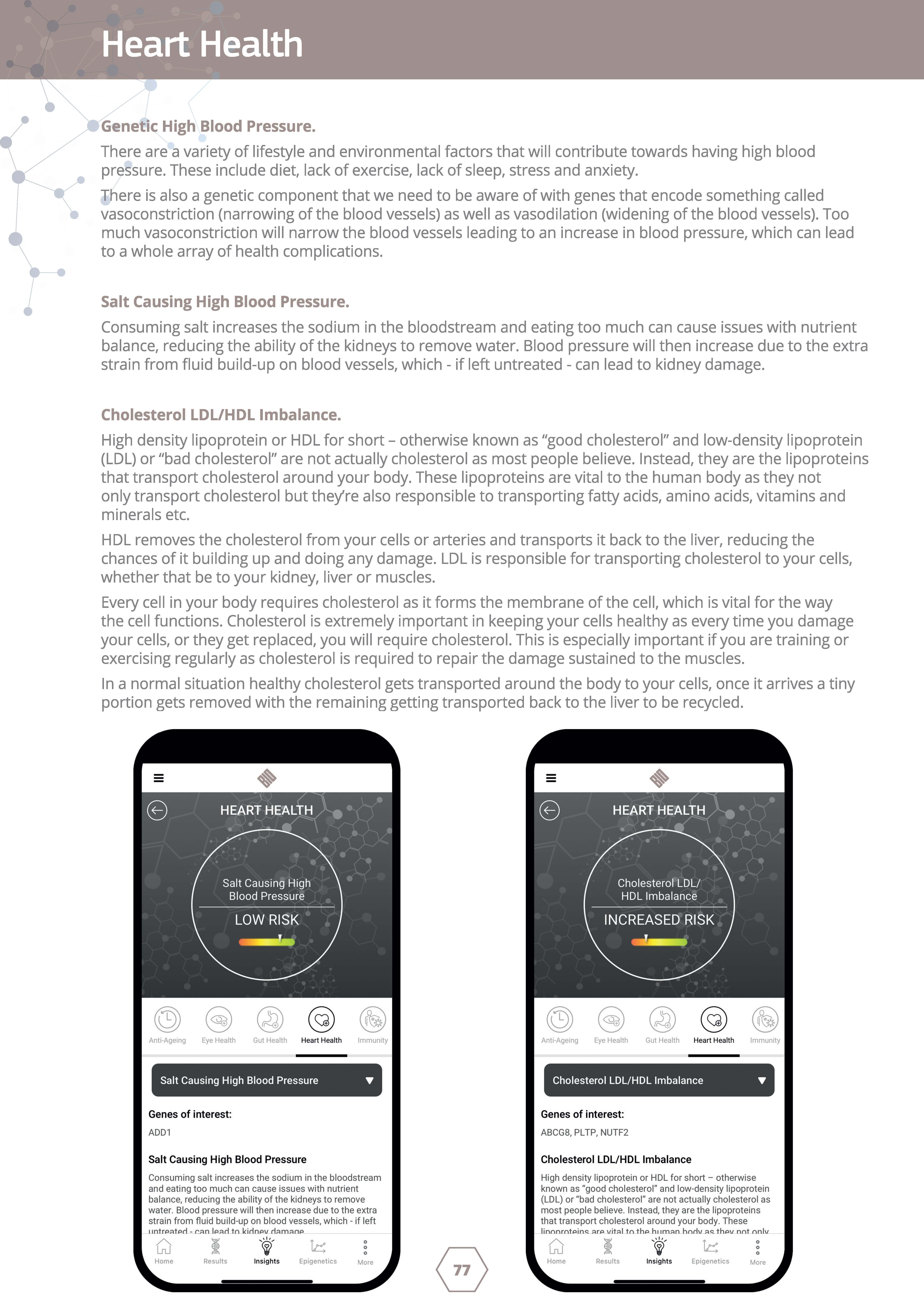
High density lipoprotein or HDL for short - otherwise known as "good cholesterol" and low-density lipoprotein (LDL) or "bad cholesterol" are not actually cholesterol as most people believe. Instead, they are the lipoproteins that transport cholesterol around your body. These lipoproteins are vital to the human body as they not only transport cholesterol but they're also responsible to transporting fatty acids, amino acids, vitamins and minerals etc.
HDL removes the cholesterol from your cells or arteries and transports it back to the liver, reducing the chances of it building up and doing any damage. LDL is responsible for transporting cholesterol to your cells, whether that be to your kidney, liver or muscles.
Every cell in your body requires cholesterol as it forms the membrane of the cell, which is vital for the way the cell functions. Cholesterol is extremely important in keeping your cells healthy as every time you damage your cells, or they get replaced, you will require cholesterol. This is especially important if you are training or exercising regularly as cholesterol is required to repair the damage sustained to the muscles.
In a normal situation healthy cholesterol gets transported around the body to your cells, once it arrives a tiny portion gets removed with the remaining getting transported back to the liver to be recycled.
Anti-Ageing Eye Health Gut Health Heart Health Immunity Salt Causing High Blood Pressure T Genes of interest: ADD1 Salt Causing High Blood Pressure Consuming salt increases the sodium in the bloodstream and eating too much can cause issues with nutrient balance, reducing the ability of the kidneys to remove water Blood pressure will then increase due to the extra strain from fiuid build-up on blood vessels, which - if left 11ntrPrltPd - r.r1n Jpr1rl tn kirlnPv rlr1m::>1nP CJ Home Results Insights Epigenetics More 0 Anti-Ageing Eye Hea lth Gut Health Heart Hea lth Immunity Cholesterol LDL/HDL Imbalance T Genes of interest: ABCG8, PLT P NUTF2 Cholesterol LDL/HDL Imbalance High density lipoprotein or HDL for short - otherwise known as "good cholesterol " and low-density lipoprote in (LDL) or "bad cholesterol" are not actually cholesterol as most people believe. Instead, they are the lipoproteins that transport cholesterol around your body. These linnnrntPin~ ;:arp vit::\I tn thP h11mr1n hnrlv ::15:. thPv nnt nn l v CJ Home Results Insig hts Epigenet ics More
The relationship that HDL has is that it removes the cholesterol from your cells or arteries and transports it back to the liver, reducing the chances of it building up and doing any damage. There are a variety of reasons why LDL cholesterol increases within the body and one of the most prevalent is through an increase in stress, oxidation and inflammation
Cardiovascular Health Issues.
Heart disease is the number one cause of death worldwide and so maintaining a healthy cardiovascular system is paramount to your overall health and wellbeing.
The cardiovascular (CV) system has a variety of different roles to play within the body from transporting air and nutrients to the cells, to the removal of carbon dioxide and waste products. However, the entirety of your cardiovascular system, which includes your heart, lungs and blood vessels, need to be healthy and free from inflammation and disease for this to happen.
The body controls blood flow by incorporating vasoconstriction and vasodilating, which is the narrowing and widening of the blood vessels. If you have too much vasoconstriction then this narrowing of the blood vessels which will cause blood pressure to go up. Certain lifestyle choices such as diet, stress, lack of exercise and sleep can all cause inflammation and oxidative stress, which contribute to the damaging of the blood vessel lining causing it to become stiff and inelastic.
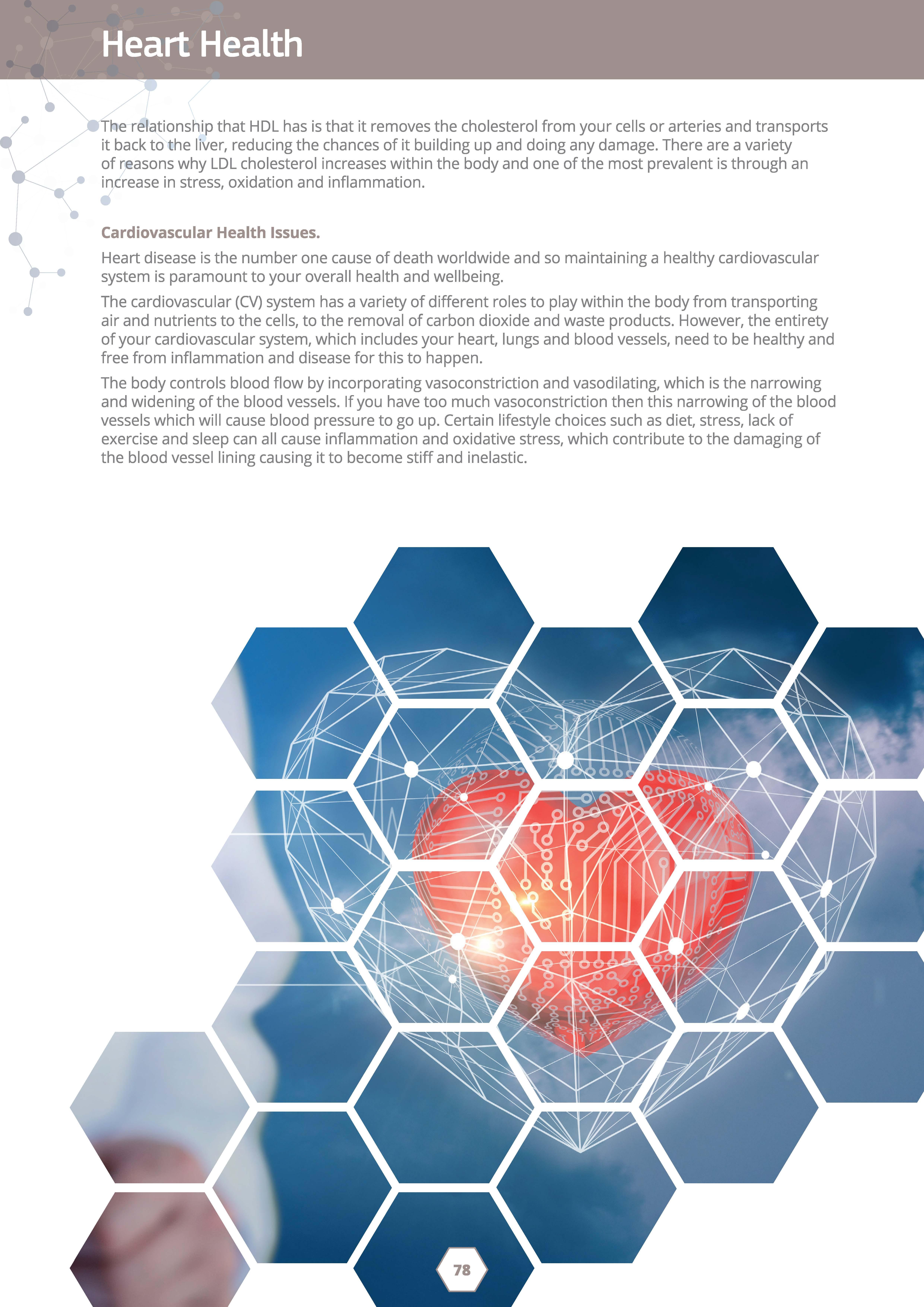
• •
At the start of last year, we thought that it might be prudent to provide a little bit of practical information surrounding Covid and the immune system. So, we designed a Covid e-guide surrounding the virus, which contains useful tips and advice as well as some of the science behind it » bit.ly/2XCYxFh «
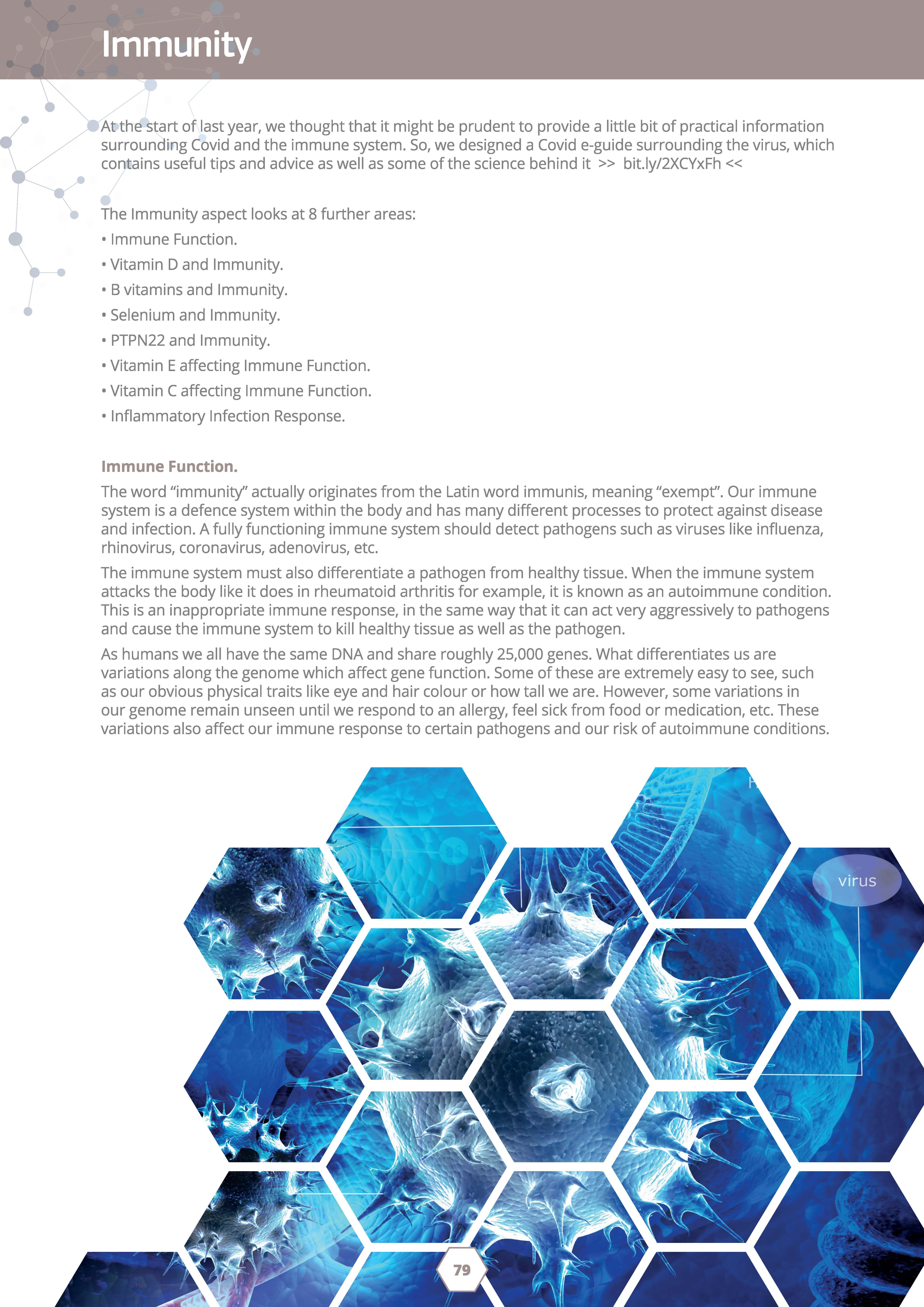
• The Immunity aspect looks at 8 further areas:
• Immune Function.
• Vitamin D and Immunity
• B vitamins and Immunity.
• Selenium and Immunity.
• PTPN22 and Immunity.
• Vitamin E affecting Immune Function.
• Vitamin C affecting Immune Function.
• Inflammatory Infection Response.
Immune Function.
The word "immunity'' actually originates from the Latin word immunis, meaning "exempt". Our immune system is a defence system within the body and has many different processes to protect against disease and infection. A fully functioning immune system should detect pathogens such as viruses like influenza, rhinovirus, coronavirus, adenovirus, etc.
The immune system must also differentiate a pathogen from healthy tissue. When the immune system attacks the body like it does in rheumatoid arthritis for example, it is known as an autoimmune condition. This is an inappropriate immune response, in the same way that it can act very aggressively to pathogens and cause the immune system to kill healthy tissue as well as the pathogen.
As humans we all have the same DNA and share roughly 25,000 genes. What differentiates us are variations along the genome which affect gene function. Some of these are extremely easy to see, such as our obvious physical traits like eye and hair colour or how tall we are. However, some variations in our genome remain unseen until we respond to an allergy, feel sick from food or medication, etc. These variations also affect our immune response to certain pathogens and our risk of autoimmune conditions.
•
This aspect looks at multiple variations in the genome which may affect certain genes that impact the immune system in one way or another. Below is a summary of the genes that are utilised in the algorithm and the reason why:
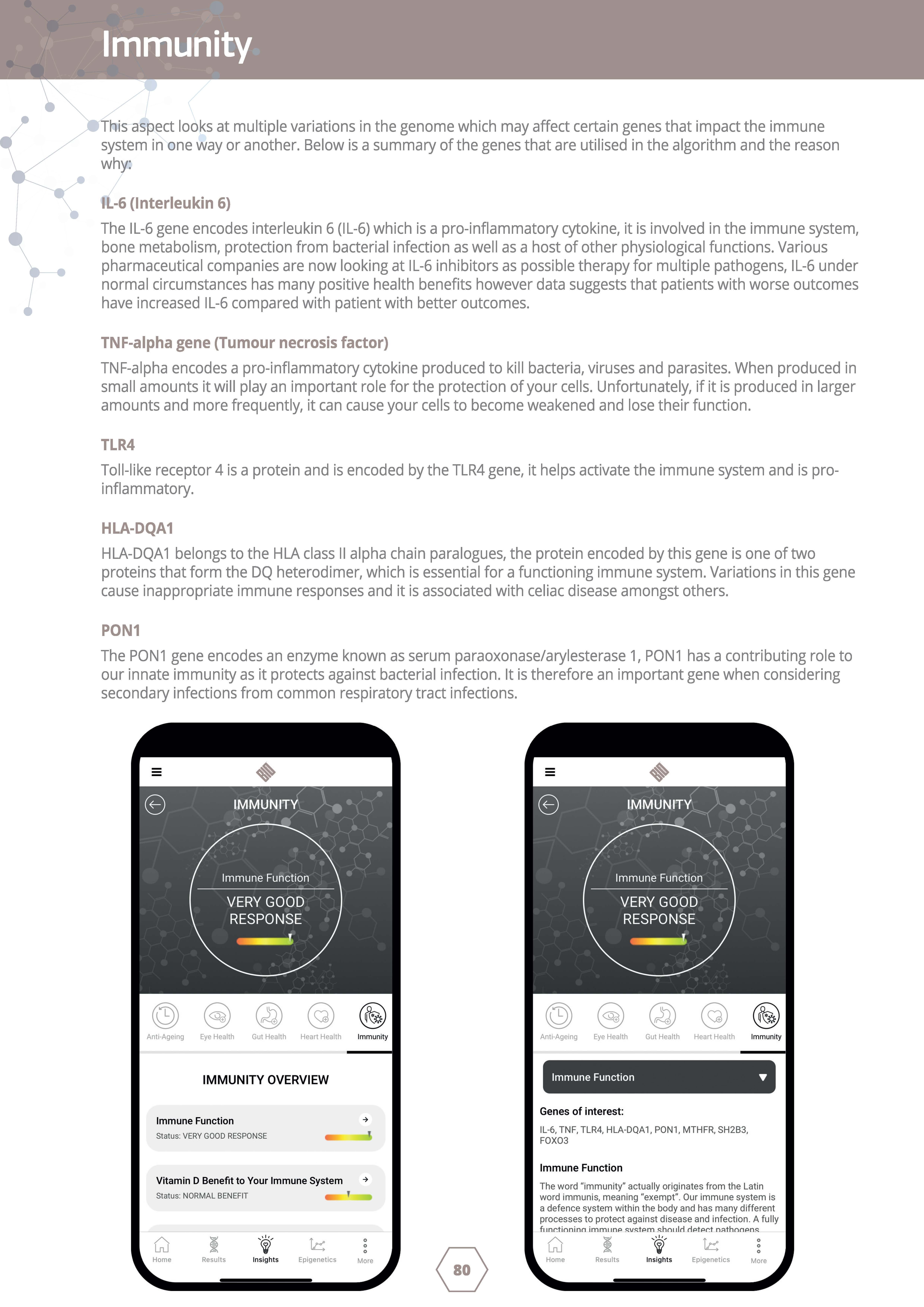
IL-6 (Interleukin 6)
The IL-6 gene encodes interleukin 6 (IL-6) which is a pro-inflammatory cytokine, it is involved in the immune system, bone metabolism, protection from bacterial infection as well as a host of other physiological functions. Various pharmaceutical companies are now looking at IL-6 inhibitors as possible therapy for multiple pathogens, IL-6 under normal circumstances has many positive health benefits however data suggests that patients with worse outcomes have increased IL-6 compared with patient with better outcomes.
TNF-alpha gene (Tumour necrosis factor)
TNF-alpha encodes a pro-inflammatory cytokine produced to kill bacteria, viruses and parasites. When produced in small amounts it will play an important role for the protection of your cells. Unfortunately, if it is produced in larger amounts and more frequently, it can cause your cells to become weakened and lose their function.
TLR4
Toll-like receptor 4 is a protein and is encoded by the TLR4 gene, it helps activate the immune system and is proinflammatory.
HLA-DQA1
HLA-DQA1 belongs to the HLA class II alpha chain paralogues, the protein encoded by this gene is one of two proteins that form the DQ heterodimer, which is essential for a functioning immune system. Variations in this gene cause inappropriate immune responses and it is associated with celiac disease amongst others.
PON1
The PON1 gene encodes an enzyme known as serum paraoxonase/arylesterase 1, PON1 has a contributing role to our innate immunity as it protects against bacterial infection. It is therefore an important gene when considering secondary infections from common respiratory tract infections.
• •
Anti-Ageing Eye Health Gut Health Heart Health Im mu ni ty IMMUNITY OVERVIEW Immune Function Status: VERY GOOD RESPONSE Vitamin D Benefit to Your Immune System Status: NORMAL BENEFIT w Home Results Insig hts Epigenetics More 0 Anti·Ageing Eye Health Gut Health Heart Health Immun ity Immune Function 'J Genes of interest: IL 6, TNF, TLR4, HLA DQA1, PON1, MTHFR, SH2B3, FO X03 Immune Function The word "immunity" actually originates from the Latin word immunis, meaning "exempt" Our immune system is a defence system within the body and has many different processes to protect against d isease and infect ion A fully f1 mc.tinninn imm1 m ~v-~tPm shni 1lrl rl~tPc.t n:::ithnnPns Home Results Insights Epigenetics More
MTHFR
Methylene tetrahydrofolate reductase is an enzyme that is encoded by the MTHFR gene, it is related to multiple conditions and this gene is used in our other modes such as folate deficiency and 812 algorithms. DNA methylation can be impaired with certain variants within the MTHFR gene, which may lead to ill health and a poor operating immune system
SH2B3
SH2B adapter protein 3 is a protein encoded by the SH283 gene, it regulates signalling pathways for inflammation, cell migration and haematopoiesis it is associated with autoimmune conditions due to its role in inflammation but is also heavily studied for its role in vascular/blood ailments.
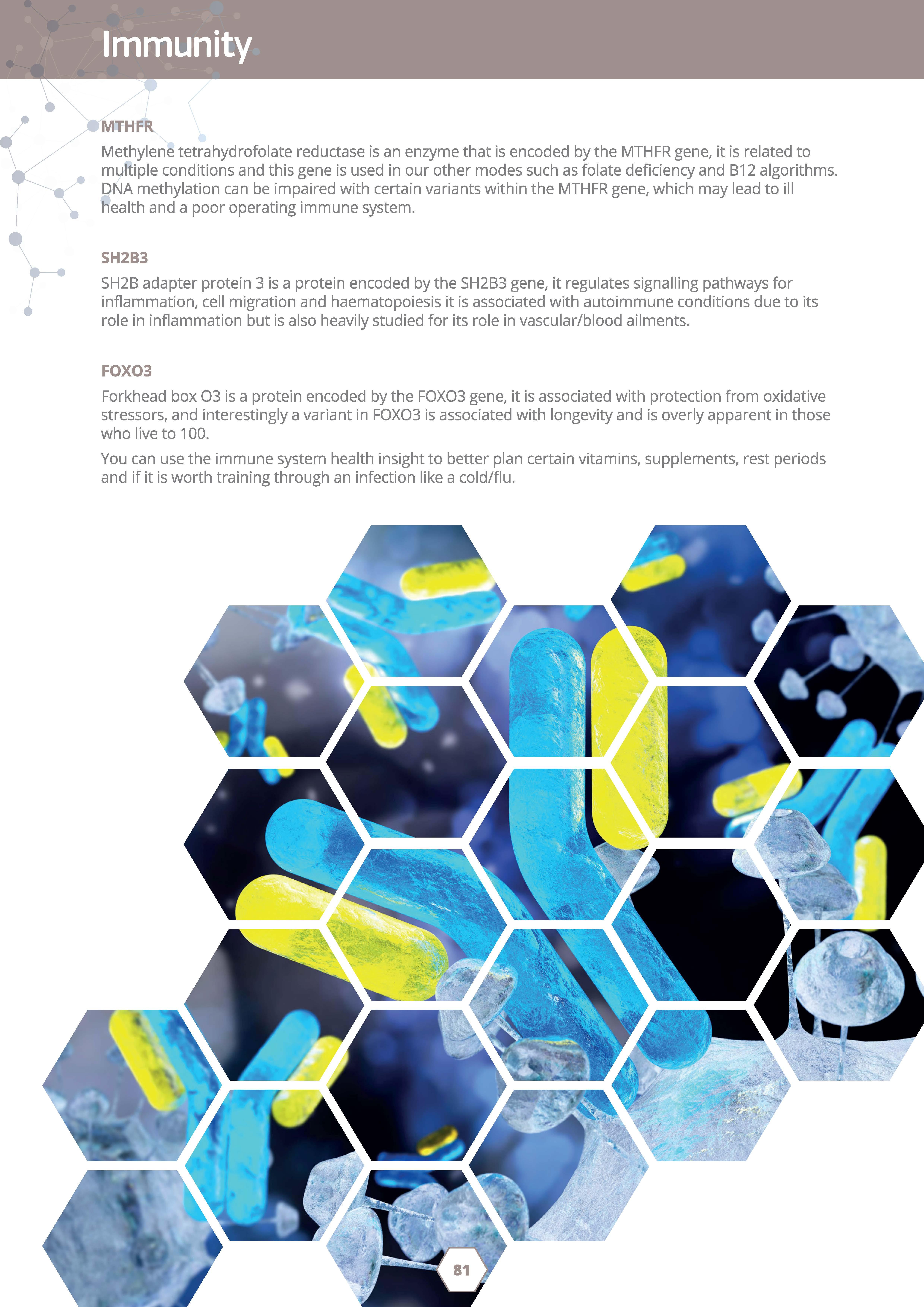
FOX03
Forkhead box 03 is a protein encoded by the FOXO3 gene, it is associated with protection from oxidative stressors, and interestingly a variant in FOXO3 is associated with longevity and is overly apparent in those who live to 100.
You can use the immune system health insight to better plan certain vitamins, supplements, rest periods and if it is worth training through an infection like a cold/flu.
• •
•
Vitamin D and Immunity.
Vitamin D helps with the enhancement and regulation of the innate immune response, which our first line of defence against bacteria, viruses and infection.
It has also been shown in various studies to have protective effect against respiratory tract infections, with daily or weekly supplementation reducing the risk of acute respiratory infections by more than 50%.
B vitamins and Immunity
B vitamins are made up of eight key vitamins that form the B- vitamin family. They will both individually and collectively offer a whole variety of health properties.
• B1 (Thiamine)
• B2 (Riboflavin)
• B3 (Niacin)
• BS (Pantothenic acid)
• B6 (Pyridoxine)
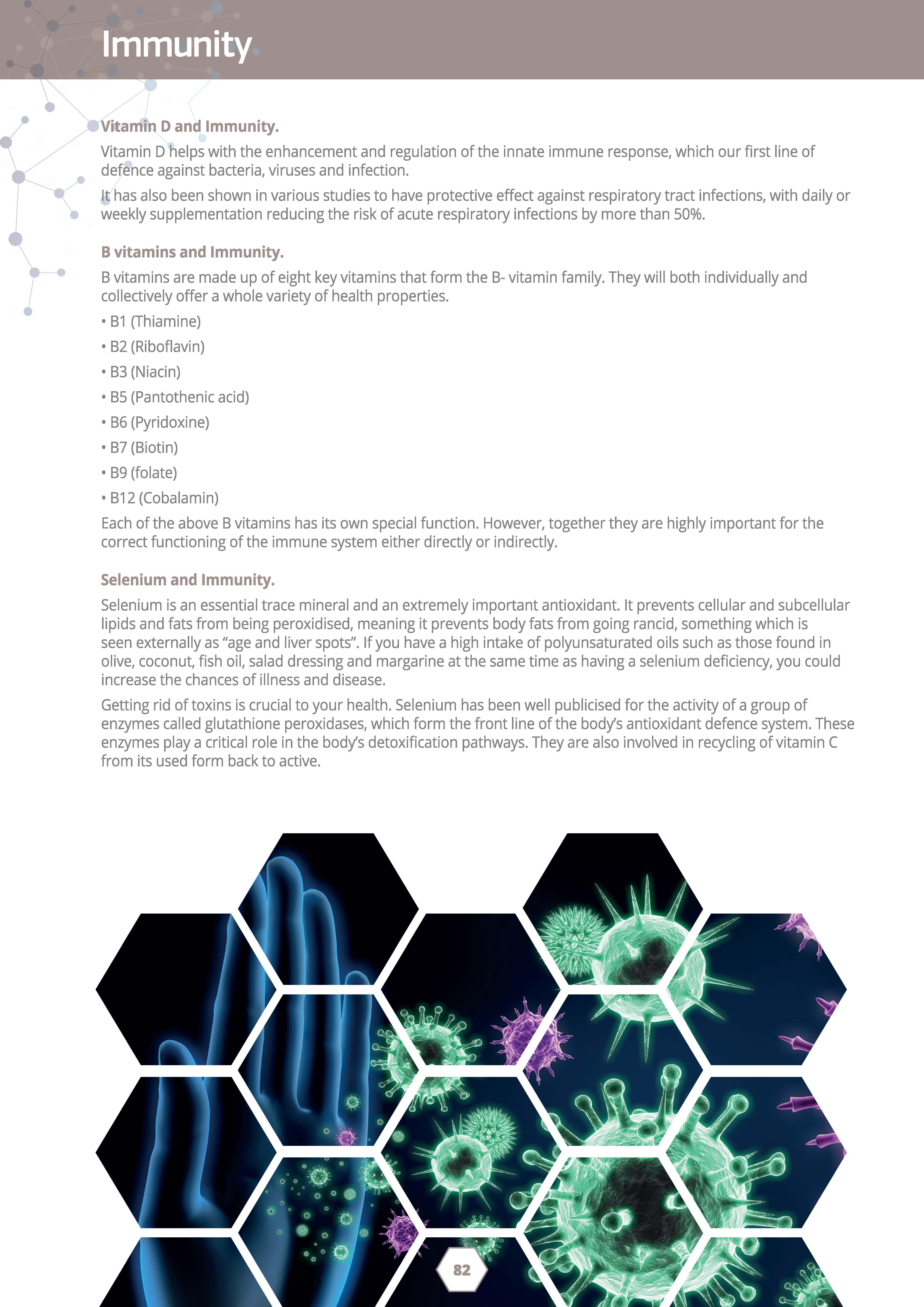
• B7 (Biotin)
• B9 (folate)
• B12 (Cobalamin)
Each of the above B vitamins has its own special function. However, together they are highly important for the correct functioning of the immune system either directly or indirectly.
Selenium and Immunity.
Selenium is an essential trace mineral and an extremely important antioxidant. It prevents cellular and subcellular lipids and fats from being peroxidised, meaning it prevents body fats from going rancid, something which is seen externally as "age and liver spots". If you have a high intake of polyunsaturated oils such as those found in olive, coconut, fish oil, salad dressing and margarine at the same time as having a selenium deficiency, you could increase the chances of illness and disease.
Getting rid of toxins is crucial to your health. Selenium has been well publicised for the activity of a group of enzymes called glutathione peroxidases, which form the front line of the body's antioxidant defence system. These enzymes play a critical role in the body's detoxification pathways. They are also involved in recycling of vitamin C from its used form back to active.
GPX1 (Glutathione peroxidase)
GPX1 is an anti-oxidant gene that neutralises hydrogen peroxide by converting it to water and oxygen. This protects cell surfaces, extracellular fluid and red blood cells as well as other cells against oxidative damage.
GPX1 is also known as a selenoprotein, meaning that selenium is required for it to function correctly. Therefore, •
• how much GPX1 you produce will depend on your selenium levels.
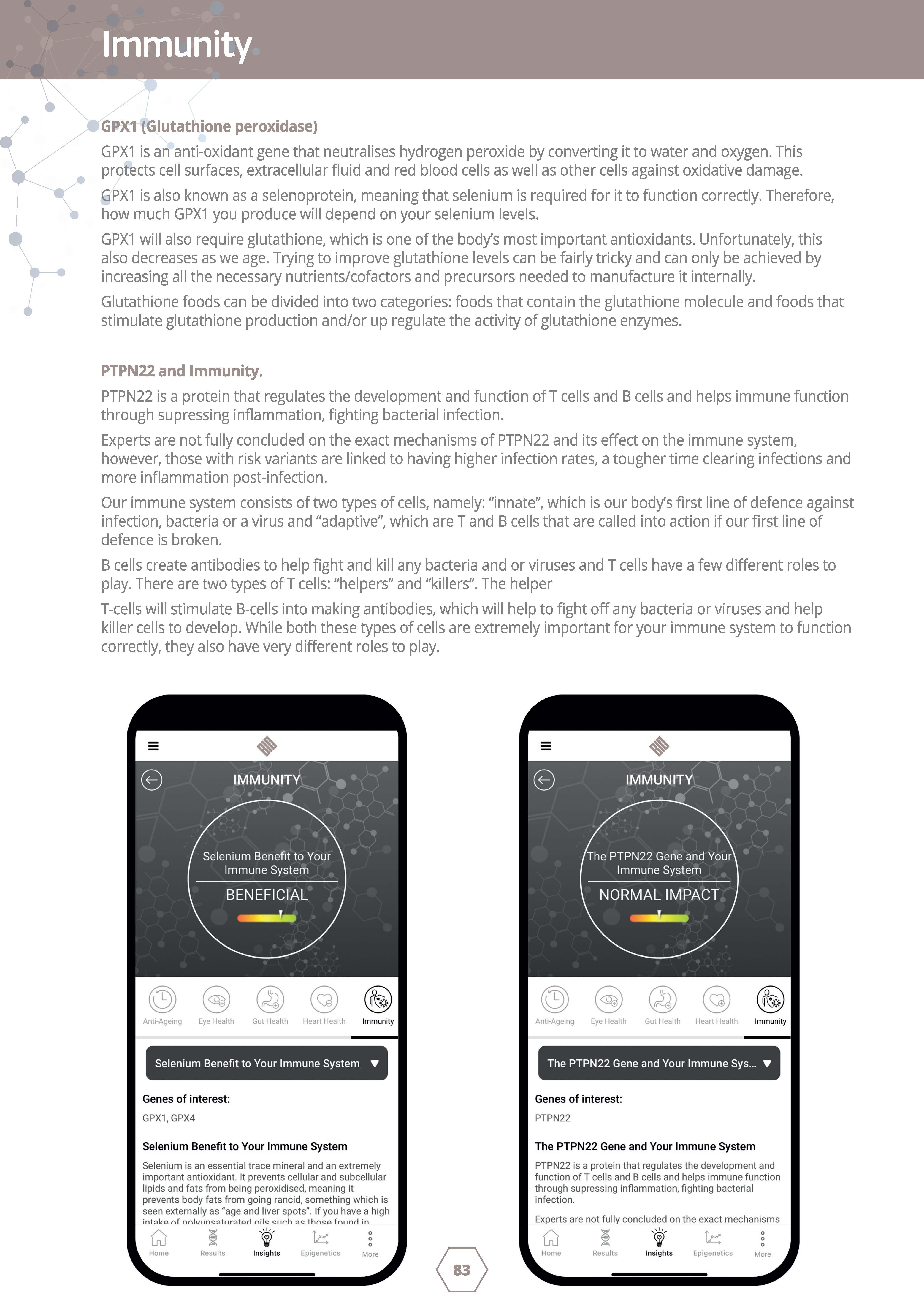
GPX1 will also require glutathione, which is one of the body's most important antioxidants. Unfortunately, this also decreases as we age. Trying to improve glutathione levels can be fairly tricky and can only be achieved by increasing all the necessary nutrients/cofactors and precursors needed to manufacture it internally.
Glutathione foods can be divided into two categories: foods that contain the glutathione molecule and foods that stimulate glutathione production and/or up regulate the activity of glutathione enzymes.
PTPN22 and Immunity.
PTPN22 is a protein that regulates the development and function ofT cells and B cells and helps immune function through supressing inflammation, fighting bacterial infection.
Experts are not fully concluded on the exact mechanisms of PTPN22 and its effect on the immune system, however, those with risk variants are linked to having higher infection rates, a tougher time clearing infections and more inflammation post-infection.
Our immune system consists of two types of cells, namely: "innate", which is our body's first line of defence against infection, bacteria or a virus and "adaptive", which are T and B cells that are called into action if our first line of defence is broken.
B cells create antibodies to help fight and kill any bacteria and or viruses and T cells have a few different roles to play. There are two types ofT cells: "helpers" and "killers". The helper T-cells will stimulate B-cells into making antibodies, which will help to fight off any bacteria or viruses and help killer cells to develop. While both these types of cells are extremely important for your immune system to function correctly, they also have very different roles to play.
Anti-Ageing Eye Health Gut Health Heart Health Immun it y Selenium Benefit to Your Immune System • Genes of int erest : GPXl, GPX4 Selenium Benefit to Your Immune System Selenium is an essential trace mineral and an extremely important antioxidant. It prevents cellular and subce llular lipids and fats from being peroxidised, meaning it prevents body fats from going rancid , something which is seen externally as "age and liver spots". If you have a high int::ikP nf nnlv11n.s.:::1t11rMPrl nil.s .s1 1c. h ::i.s thn .sP fn1 mrl in Cl i 'W 1L:'.: Home Results In sights Epigenetics More 0 Anti-Ageing Eye Health Gut Health Heart Health Immunity The PTPN22 Gene and Your Immune Sys • Genes of interest: PTPN22 The PTPN22 Gene and Your Immune System PTPN22 is a protein that regulates the development and function of T eel Is and B cells and helps immune function through supressing inflammation, fighting bacterial infection Experts are not fully concluded on the exact mechanisms Cl i 'W 1L:'.: Home Results Insights Epigenetics More
Vitamin Eaffecting Immune Function.
Vitamin E is a fat-soluble vitamin made up of eight compounds. A deficiency in this vitamin is relatively uncommon, however, that would lead to nerve problems and as a general antioxidant a lack of it will impact general wellness. Large population studies have shown that vitamin E intake at correct and controlled dosages lead to lower incidence of cardiovascular conditions, cancer, dementia, and a general improvement in wellness While this aspect does not look at your risk of vitamin E deficiency, it does demonstrate how certain studies show that genes affect circulating levels of Vitamin E and that variants in the gene GSTP1 impact your response to vitamin E. For example, while some have increased inflammation from too much vitamin E consumption, others require more vitamin Eto decrease inflammation.
Vitamin C affecting Immune Function.
Vitamin C is a water-soluble nutrient that the body does not store. Humans need vitamin C from dietary sources in order to maintain adequate levels within the body for the majority of people in "developed countries", however, this is easily done.
Vitamin C plays a vital role in a number offunctions. For example, it is essential for correct immune response, the production of collagen, L-carnitine and certain neurotransmitters. A deficiency in vitamin C is called scurvy, which is exceedingly rare at present. Nevertheless, if it does develop, it can cause joint swelling, bleeding gums, tiredness and anaemia.
Scurvy can be cured with vitamin C intake, however, taking high dosages and then suddenly ceasing intake can also cause scurvy, known as "rebound scurvy''. The genes analysed here look into the typical variants that may cause worsened responses to infection from all sources as well as the need for increased antioxidants. The gene SLC23A1 has a direct effect on the absorption of vitamin C into the body and its distribution to organs.

•
•
Anti-Ageing Eye Health Gut Health Heart Health Immun ity Vitamin D Benefit to Your Immune System T Genes of interest: CYP2R1, NADSYN1, GC, VDR Vitamin D Benefit to Your Immune System Vitamin D helps with the enhancement and regulation of the innate immune response, which our first line of defence against bacteria, viruses and infection. It has also been shown in various studies to have protective effect against respiratory tract infections, with Q I 'W Home Results Insigh t s Epigenetics More 0 Anti-Ageing Eye Health Gut Health Heart Health Immunity Vitamin C Affecting Immune Function T Genes of interest: IL-6, TNF, TLR4, HLA-DQA1, PON1, MTHFR, SH2B3, FOX03, PTPN22, SLC23A 1 Vitamin C Affecting Immune Function Vitamin C is a water-soluble nutrient that the body does not store Humans need vitamin C from dietary sources in order to maintain adequate level s within the body for the majority of people in "developed countries", however, this i<:: P~ .c:. ilv rlnnp Home Results Insights Epigenetics More
Inflammatory Infection Response.
How we respond to infection can vary dramatically. Inflammation can occur due to infection or injury and certain genes affect this response. Inflammation occurs when the body is fighting against harm in an attempt to heal itself. In this instance, chemicals are released to commence inflammation, antibodies and proteins are released as well as an increase in blood flow to damaged areas, such as injuries Inflammation is not a bad thing, although it is often portrayed as a negative. Inflammation is required for correct healing and the destruction of pathogens. When inflammation gets out of control through an excessive response from the body, or when it lasts when there is no longer need for it to (chronic inflammation), problems can begin This aspect looks at the genes associated with the inflammation response from infection, analysing the likelihood of an over response leading to a release of excess inflammatory chemicals into the body. This may cause a risk of inflammation lingering even after the infection has passed. This aspect looks at multiple variants across genes that have been identified to be important to the inflammatory response from infection.
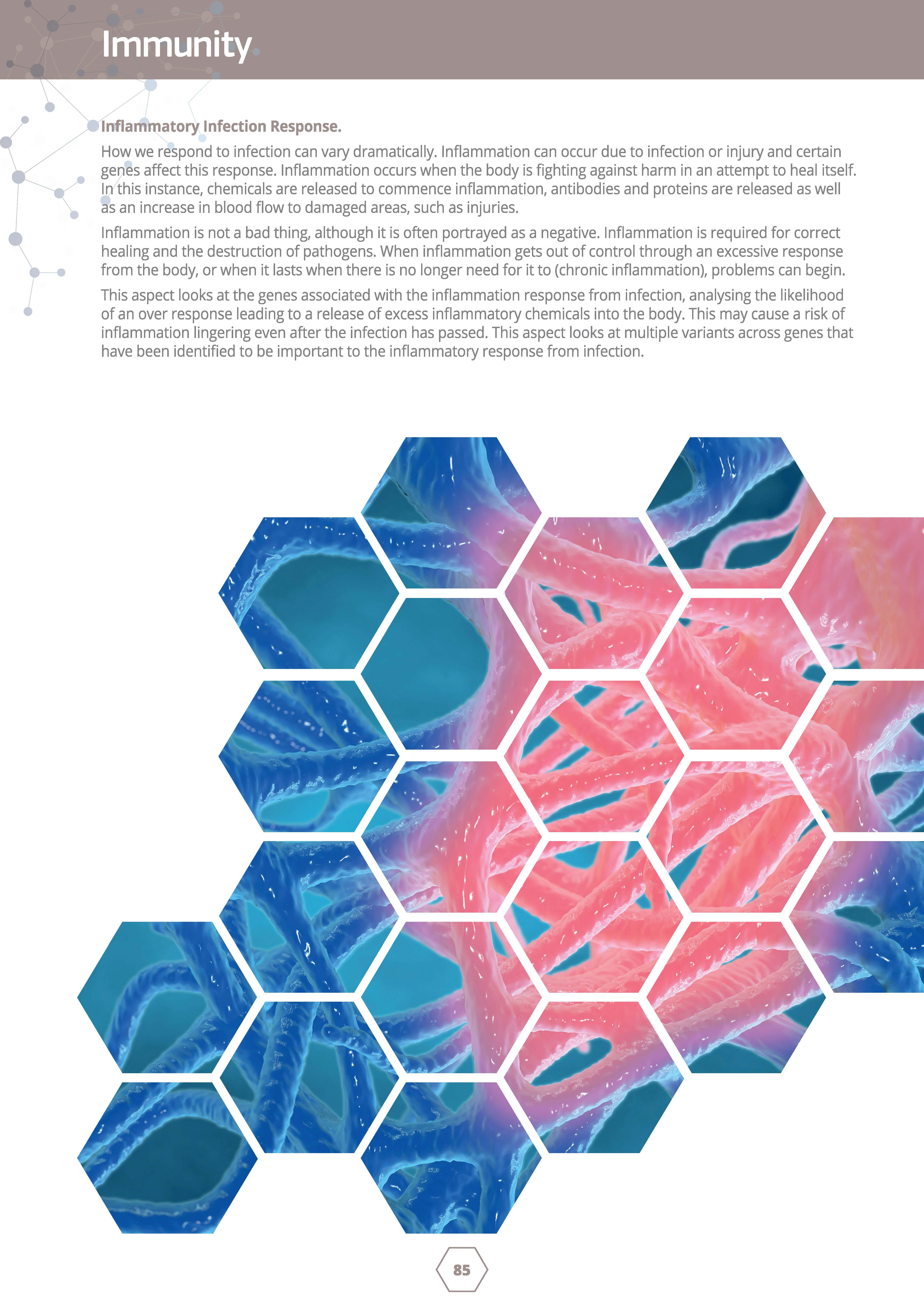
• •
0
•
•
•
The Injury Risk insight has a further 5 areas.

• Lower Back Pain Risk.
• Bone and Joint Strength.
• Achilles Tendinopathy
• Knee Injury
•
Type of Injury Rehab
Injuries are damage to the body and are usually caused by external force, however weakening of the body's defences can often lead to injury. Major trauma to the body can cause long lasting damage, paralysis, scarring and death; in fact, injuries are the 6th leading cause of death in the world.
Injuries may well be unavoidable with 30% of all major injuries coming from transportation accidents some of which may be completely out of the individual's control. However, many injuries especially sports injuries occur due to a number of factors with major trauma being an instigator but bone weakness, overuse, illness and even psychology being major contributing factors with overuse leading to injury in its own right.
Factors that need to be considered when understanding injury are:
A. The mechanism of injury.
B. Substances or environment.
C. External intent (accident vs. purpose).
D. Contributing illness or injuries.
E. Poor teaching/coaching.
F. Psychology.
G. Overreaching.
H. Overtraining/Overuse.
I. Sleep and Diet quality.
J. Poor preparation.
K. Genetics.
Our DNA impacts how the body creates collagen, helps dictate bone density and strength, our ability to absorb certain vital nutrients, affects muscle hypertrophy, recovery from training and can directly influence joint degeneration and inflammation to tendons/ ligaments/ muscles. Therefore, DNA affects injury directly and indirectly having an influence on other factors:
A. The mechanism of injury. (no genetic impact)
B. Substances or environment. (no genetic impact)
C. External intent (accident vs. purpose). (no genetic impact)
D. Contributing illness or injuries. (genetic impact)
E. Poor teaching/coaching. (no genetic impact)
F. Psychology. (genetic impact)
G. Overreaching. (genetic impact)
H. Overtraining/Overuse. (genetic impact)
I. Sleep and Diet quality. (genetic impact)
J. Poor preparation. (no genetic impact)
K. Genetics. (genetic impact)
Lower Back Pain Risk.
Lower back pain, which is also known as lumbago, is one of the most common healthcare complaints. The majority of lower back pain causes are not serious and often relieve themselves after a few weeks. However, there are some serious causes, and these can have associated symptoms or not. The most common causes of lower back pain are:
1. Muscular spasm/pull
2. Lumbar disc degeneration
3. Disc herniation
4. Nerve impingement (often causes referred pains)
5. Inflammatory conditions
6. Kidney stones
7. Obesity
This list is not exhaustive, and many conditions are both directly and indirectly linked to lower back pain. This aspect looks at the genes that can contribute to disc degeneration and collagen genes that can specifically affect lumbar structure and strength.

•
Bone and Joint Strength.
Our skeleton gives us structure and allows us to move. However, if bones are weak, they can fracture easily from trauma, spontaneously and through pathological disease. It is estimated that 500,000 fractures occur each year in the UK alone due to fragile bones.
• It is, therefore, vitally important to know any potential risk factors that may lead to weakening of the bones. Certain gene variants are linked to potentially lower bone density naturally while others can cause lower nutrient levels of important vitamins and minerals. These can determine bone and joint health, • while some variants are linked to degeneration. This aspect concentrates on these variants with a unique algorithm utilised to determine the risk factors and what interventions can be put in place to help.
Achilles Tendinopathy.
Achilles tendinopathy causes pain in the Achilles tendon - the thick tendon joining the calcaneus (heel bone) to the soleus and gastrocnemius (calf). It is a common injury that affects all age groups, sports people, and non-sports people alike. Pain, stiffness, and swelling are all potential signs of the condition and it is thought that around 150,000 people suffer Achilles tendinopathy ever year. There are multiple risk factors for the condition:
1. Obesity 2. Diabetes 3. Genetics (family history can be an indicator) 4. Inappropriate footwear 5. Overtraining 6. Increased cholesterol levels 7. Poor coaching/training
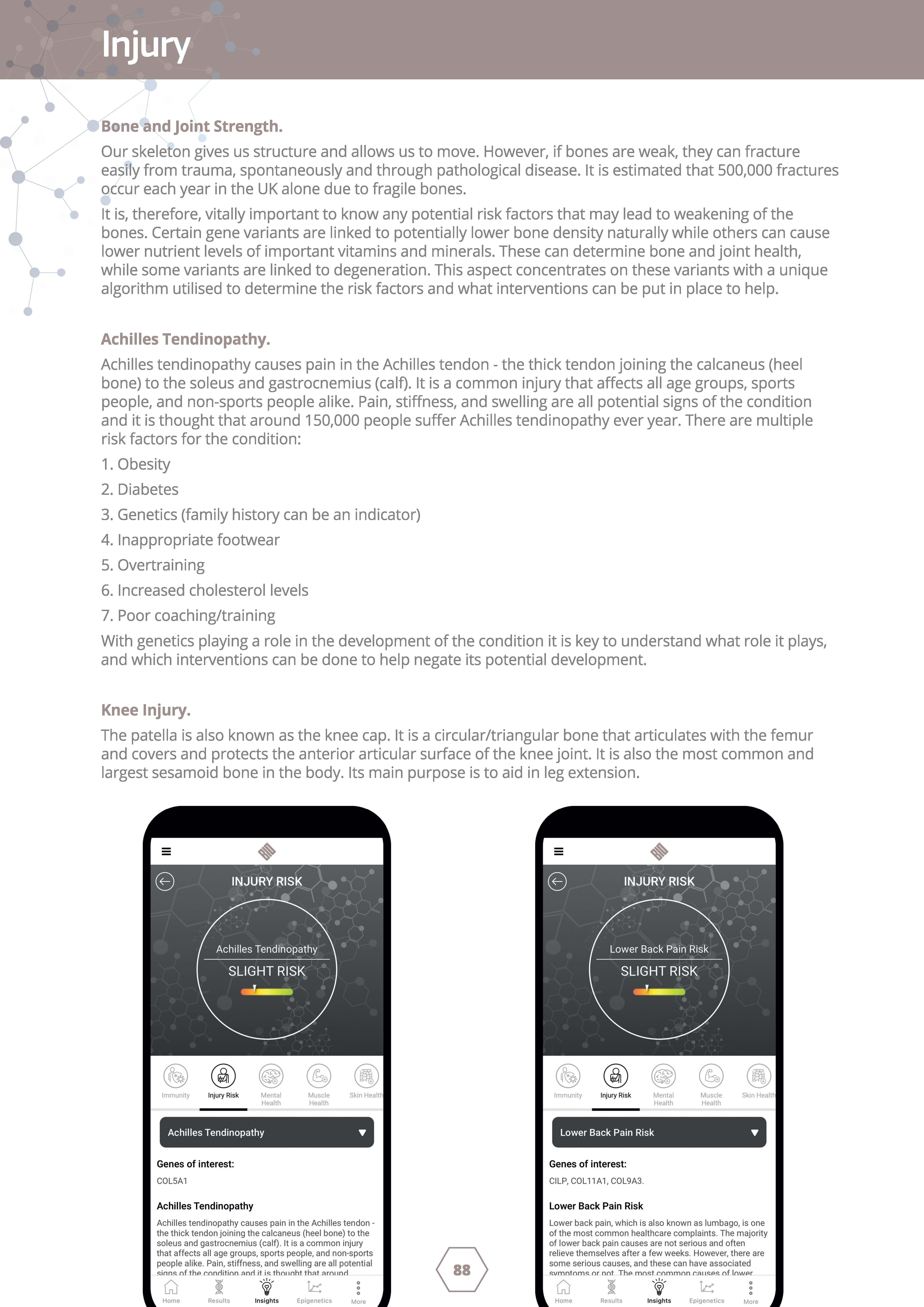
With genetics playing a role in the development of the condition it is key to understand what role it plays, and which interventions can be done to help negate its potential development.
Knee Injury.
The patella is also known as the knee cap. It is a circular/triangular bone that articulates with the femur and covers and protects the anterior articular surface of the knee joint. It is also the most common and largest sesamoid bone in the body. Its main purpose is to aid in leg extension.
Immunity In ury Risk Mental Muscle Skin Healt Health Health Achilles Tendmopathy • Genes of interest: COL5A1 Achilles Tendinopathy Achilles tendinopathy causes pain in the Achi l les tendonthe thick tendon joining the calcaneus (heel bone) to the so leus and gastrocnemius (calf). It is a common injury that affects all age groups sports people, and non -sports people alike. Pain, stiffness, and swelling are all potential 1=:inn~ nf thP r:nnrlitinn :,inrl it i/:: thni 1nht th;:at ~rn• 1nrl TL:; Home Results Insights Epigenetics More 0 Immunity Injury Risk Mental Muscle Skm Healt Health Health Lower Back Pam Risk • Genes of interest: CILP, COL 11A1 COL9A3. Lower Back Pain Risk Lower back pain, which is also known as lumbago is one of the most common healthcare complaints. The majority of lower back pain causes are not serious and often relieve themselves after a few weeks. However, there are some serious causes, and these can have associated .c::vmntnm.c:: nr nnf ThP mn.c::t r.nmmnn r.::.11.c::P.c:: nf lnwPr Q Home Results Ins ights Epigenetics More
Menisci
The menisci are the articular disks in the knee joint. It comprises two disks in total with the medial meniscus and lateral meniscus. It also involves widespread collagen fibres consisting of pseudo cartilage cells and connective tissue. Fibres run along the menisci to allow for attachments, flat over the centre of the knee joint itself, fused with the synovial membrane laterally, which moves over the tibial surface. The menisci exist to protect the bone ends from rubbing, acting as shock absorbers and therefore coming in very handy, especially for those involved with exercise and sports
ACL injury/tears
The ACL, or anterior cruciate ligament, is one of the four main knee ligaments and prevents excessive movement of the knee joint. Injuries to the ACL are the most common ligamentous injury to the knee joint and can be very debilitating. Tearing or rupture due to excessive movement is the most common cause of ACL tears with contact ACL injuries only accounting for 20% of all ACL injuries. Sports show the highest incidence of ACL injuries within society, with football, martial arts, gymnastics and skiing all being sports with particular high-risk factors. Female athletes and those over 40 also show higher incidence of ACL injuries, with certain genetic variants leading to increased incidence.
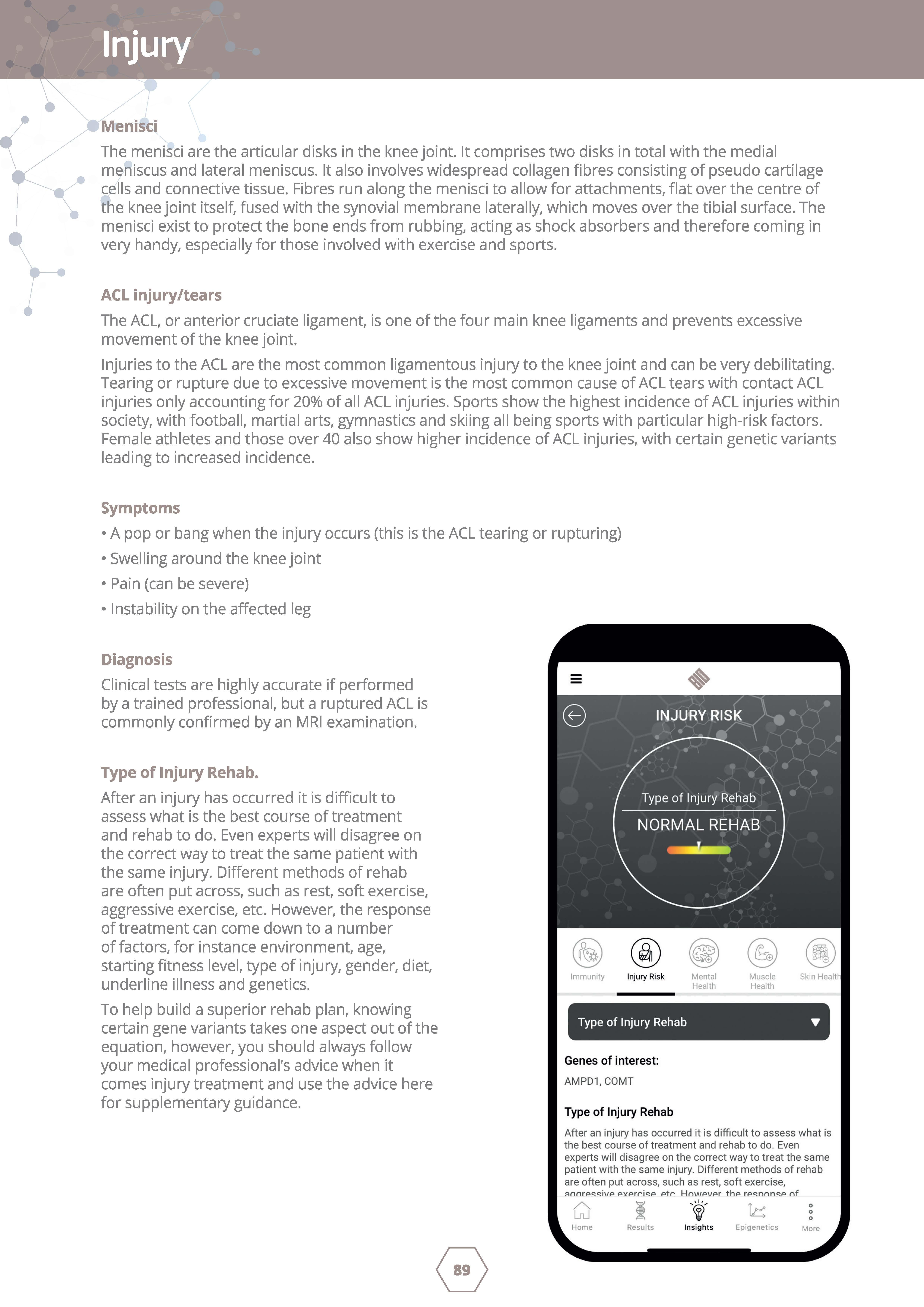
Symptoms
• A pop or bang when the injury occurs (this is the ACL tearing or rupturing)
• Swelling around the knee joint
• Pain (can be severe)
• Instability on the affected leg
Diagnosis
Clinical tests are highly accurate if performed by a trained professional, but a ruptured ACL is commonly confirmed by an MRI examination.
Type of Injury Rehab.
After an injury has occurred it is difficult to assess what is the best course of treatment and rehab to do. Even experts will disagree on the correct way to treat the same patient with the same injury. Different methods of rehab are often put across, such as rest, soft exercise, aggressive exercise, etc. However, the response of treatment can come down to a number of factors, for instance environment, age, starting fitness level, type of injury, gender, diet, underline illness and genetics.
To help build a superior rehab plan, knowing certain gene variants takes one aspect out of the equation, however, you should always follow your medical professional's advice when it comes injury treatment and use the advice here for supplementary guidance.
• •
0 Immunity Injury Ri s k Mental Muscle Skin Healt~ Health Health Type of Injury Rehab • Genes of interest: AMPD1, COMT Type of Injury Rehab After an injury has occurred it is difficult to assess what is the best course of treatment and rehab to do. Even experts will disagree on the correct way to treat the same patient with the same injury Different methods of rehab are often put across, such as rest, soft exercise, ~nnrPc:::c:::ivP P'l(Prr..ic:::P Ptr.. l-lnwPvPr thP n:::,, nnn~P nf Home Results Insights Epigenetics More
•
•
•
The Mental health insight has 5 useful areas.
• Attention Span.
• Workaholic Traits.
• Caffeine Affecting Focus
• Dealing with Memory Tasks.
• Night Productivity
• Warrior v Worrier.
Dopamine
Bio-Synergy looks at multiple variants associated with Dopamine these include, COMT, ANKK1, DRD2, SLC6A3 and others. It is difficult to go through each gene in detail however they all run on certain principles.
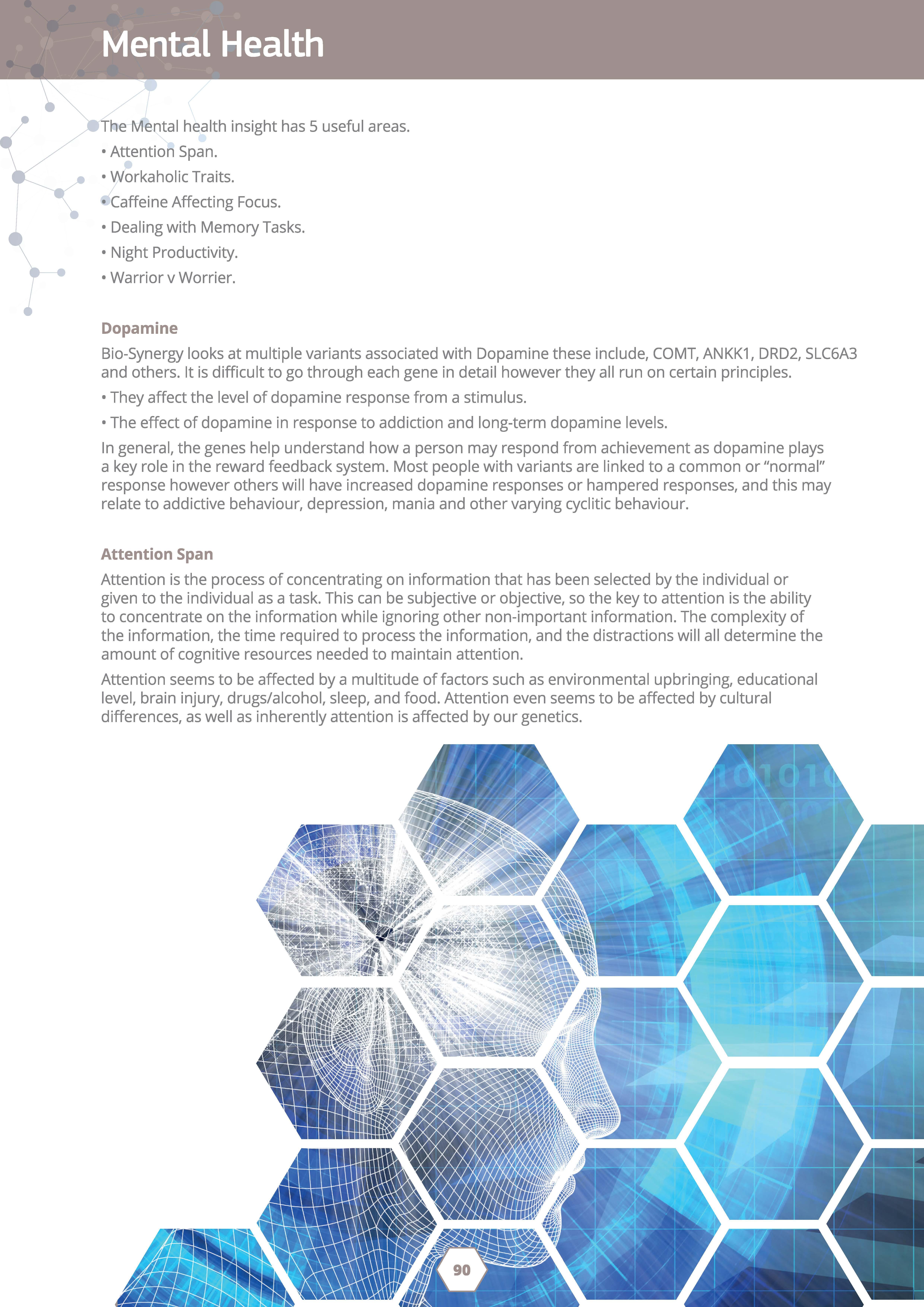
• They affect the level of dopamine response from a stimulus.
• The effect of dopamine in response to addiction and long-term dopamine levels.
In general, the genes help understand how a person may respond from achievement as dopamine plays a key role in the reward feedback system. Most people with variants are linked to a common or "normal" response however others will have increased dopamine responses or hampered responses, and this may relate to addictive behaviour, depression, mania and other varying cyclitic behaviour.
Attention Span
Attention is the process of concentrating on information that has been selected by the individual or given to the individual as a task. This can be subjective or objective, so the key to attention is the ability to concentrate on the information while ignoring other non-important information. The complexity of the information, the time required to process the information, and the distractions will all determine the amount of cognitive resources needed to maintain attention.
Attention seems to be affected by a multitude of factors such as environmental upbringing, educational level, brain injury, drugs/alcohol, sleep, and food. Attention even seems to be affected by cultural differences, as well as inherently attention is affected by our genetics.
Workaholic Traits.
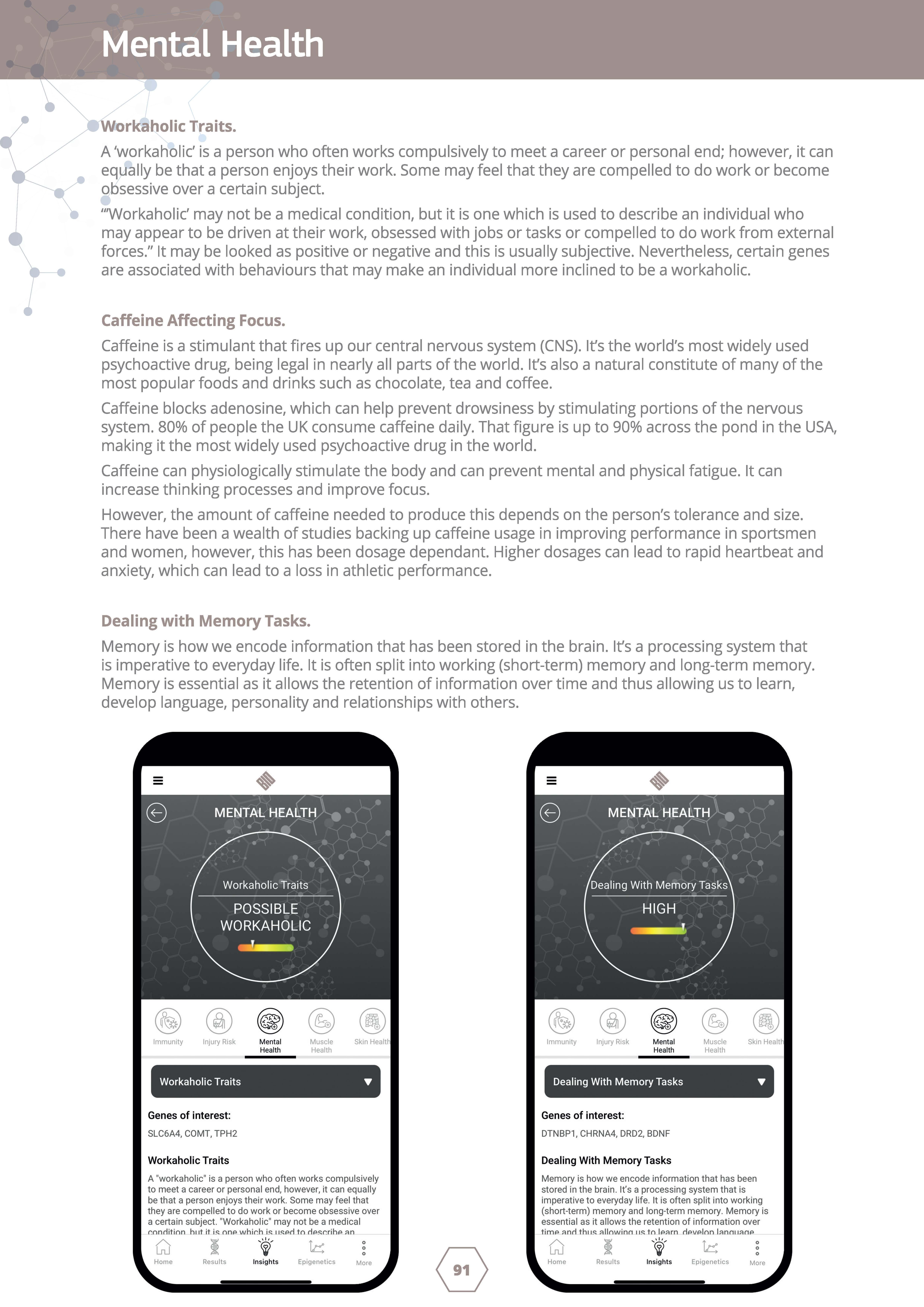
A 'workaholic' is a person who often works compulsively to meet a career or personal end; however, it can equally be that a person enjoys their work. Some may feel that they are compelled to do work or become obsessive over a certain subject.
• "Workaholic' may not be a medical condition, but it is one which is used to describe an individual who may appear to be driven at their work, obsessed with jobs or tasks or compelled to do work from external forces." It may be looked as positive or negative and this is usually subjective. Nevertheless, certain genes • are associated with behaviours that may make an individual more inclined to be a workaholic.
Caffeine Affecting Focus.
Caffeine is a stimulant that fires up our central nervous system (CNS). It's the world's most widely used psychoactive drug, being legal in nearly all parts of the world. It's also a natural constitute of many of the most popular foods and drinks such as chocolate, tea and coffee.
Caffeine blocks adenosine, which can help prevent drowsiness by stimulating portions of the nervous system. 80% of people the UK consume caffeine daily. That figure is up to 90% across the pond in the USA, making it the most widely used psychoactive drug in the world.
Caffeine can physiologically stimulate the body and can prevent mental and physical fatigue. It can increase thinking processes and improve focus.
However, the amount of caffeine needed to produce this depends on the person's tolerance and size. There have been a wealth of studies backing up caffeine usage in improving performance in sportsmen and women, however, this has been dosage dependant. Higher dosages can lead to rapid heartbeat and anxiety, which can lead to a loss in athletic performance.
Dealing with Memory Tasks.
Memory is how we encode information that has been stored in the brain. It's a processing system that is imperative to everyday life. It is often split into working (short-term) memory and long-term memory. Memory is essential as it allows the retention of information over time and thus allowing us to learn, develop language, personality and relationships with others.
Immunity lnJury Risk Mental Muscle Skin Healt Health Health Workaholic Traits T Genes of interest: SLC6A4, COMT, TPH2 Workaholic Traits A workaholic " is a person who often works compulsively to meet a career or personal end, however, it can equally be that a person enjoys their work. Some may feel that they are compelled to do work or become obsessive over a certain subject. workaholic" may not be a medica l r.nnrlitinn hut it is nnP whir.h is 11sPrl tn rlPsr.rihP ;:rn LJ i w Home Results I nsights Epigenetics More 0 Immunity Injury Risk Menta Muscle Skin Healt~ Healt h Health Dealing With Memory Tasks T Genes of interest: DTNBP1, CHRNA4, DRD2, BDNF Dealing With Memory Tasks Memory is how we encode information that has been stored in the brain. It's a processing system that is imperative to everyday life. It is often split into working (short-term) memory and long-term memory. Memory is essential as it all ows the retention of information over timP r1nrl thus r1llnwinn 11s tn IPr1rn rlPvPlnn lr1nnw'lnP i Home Results Insights Epigenetics More
Working memory takes information by encoding stimuli and can also retrieve memories needed for tasks at hand with long-term memory storing recollections which can be retrieved. Working memory appears to rely on an acoustic code for information storing and less so visual stimuli.
Genetics influence how well our memory stands the test of time and can have some effect on the speed at hich we pick up information and store it. Sleep is also highly important to memory as it allows processes that cement memories in long-term memory
Night Productivity.
Night productivity is something that many of us may have to do due to our jobs, such as shift work, which is common in healthcare, factories and those working via technology in many time zones. Our genetics might help us determine how successful we are at night working as some may actually excel better during night time hours.
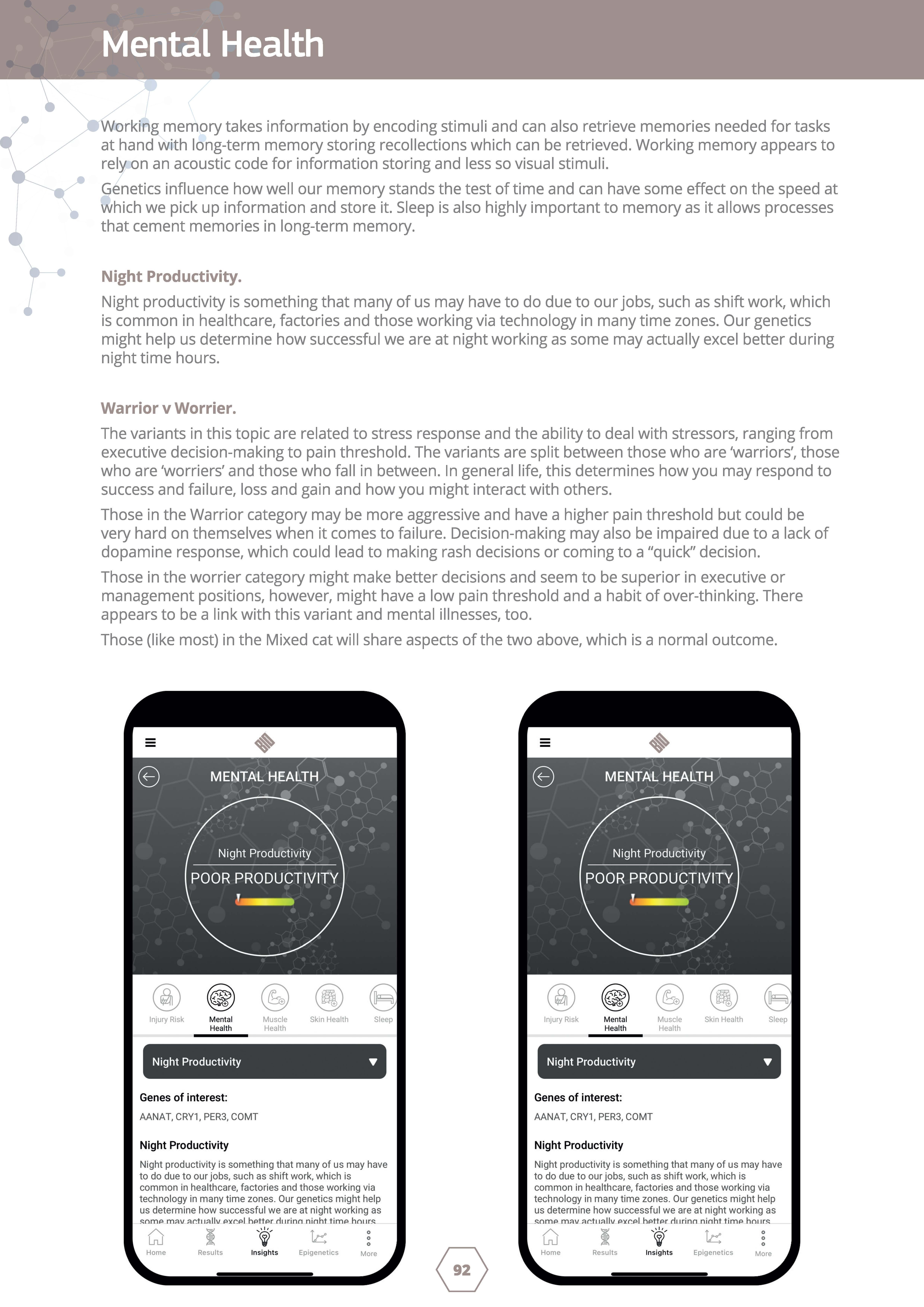
Warrior v Worrier.
The variants in this topic are related to stress response and the ability to deal with stressors, ranging from executive decision-making to pain threshold. The variants are split between those who are 'warriors', those who are 'worriers' and those who fall in between. In general life, this determines how you may respond to success and failure, loss and gain and how you might interact with others.
Those in the Warrior category may be more aggressive and have a higher pain threshold but could be very hard on themselves when it comes to failure. Decision-making may also be impaired due to a lack of dopamine response, which could lead to making rash decisions or coming to a "quick" decision.
Those in the worrier category might make better decisions and seem to be superior in executive or management positions, however, might have a low pain threshold and a habit of over-thinking. There appears to be a link with this variant and mental illnesses, too.
Those (like most) in the Mixed cat will share aspects of the two above, which is a normal outcome.
•
@ Injury Risk Mental Hea th Muscle Skin Health Sleep Health Night Productivity • Genes of interest: AANAT, CRYl, PER3, COMT Night Productivity Night productivity is something that many of us may have to do due to our jobs, such as shift work, which is common in healthcare, factories and those working via technology in many time zones. Our genetics might help us determine how successful we are at night working as - ~nmP mr1v :::ict11r1llv PYC.PI hP1tPr rl1 1rinn ninht timP hn11r5. LJ i 'f k'.; Home Results Ins i ghts Epigenetics More 0 lnJury Risk Mental Hea th Muscle Skin Health Sleep Health Night Productivity • Genes of interest: AANAT, CRYl, PER3, COMT Night Productivity Night productivity is something that many of us may have to do due to our jobs, such as shift work, which is common in healthcare, factories and those working via technology in many time zones. Our genetics might help us determine how successful we are at night working as -----5:. nmP mr1v r1r.t11r1llv PYr.PI hPttPr rlurinn ninht timP hnm ~ LJ i 'f k'.; Home Results Insigh t s Epigenetics More
•
•
•
The Muscle health insight has 5 further areas.
• Myostatin Related Performance.
• Natural Testosterone Levels (Males results only)
• Exercise Induced Muscle Pain
• Stress Related Muscle Pain.
• CoQ10 Deficiency
Myostatin Related Performance.
MSTN is a gene that makes instructions for producing myostatin, a protein that is part of the transforming growth factor beta family (TGF~), a family of proteins that control the growth of tissues in the body.
Myostatin is found nearly exclusively in the skeletal muscles where it is active before and after birth and actually controls skeletal growth by restraining it, preventing muscles becoming excessively large.
Current research that surrounds myostatin is based around its potential treatment in muscle-wasting disorders. For example, animals that have mutations in the encoding gene MSTN show greater muscle mass, strength and - in some circumstances - a reduced bodyfat, which can be known as myostatinrelated muscle hypertrophy.
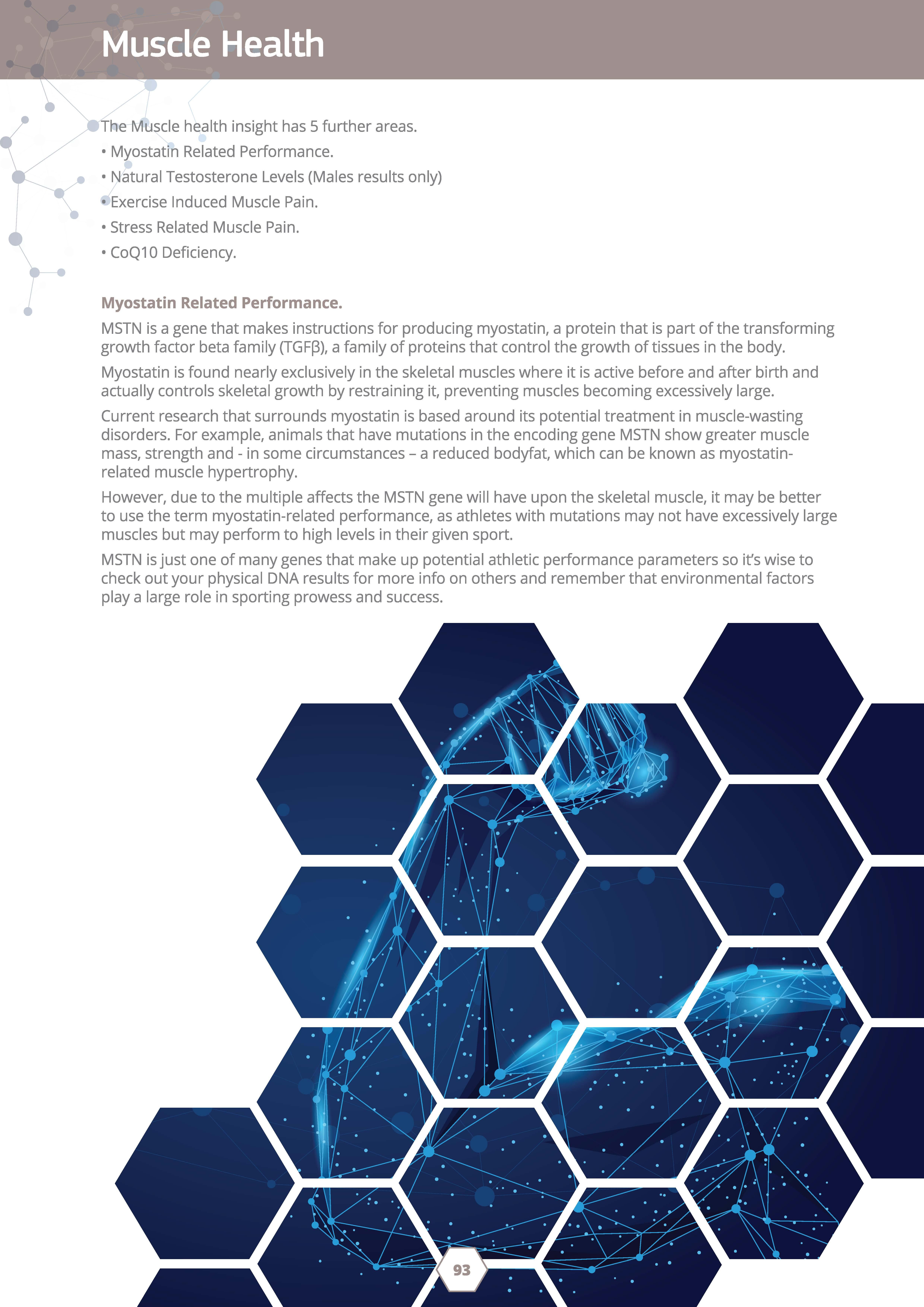
However, due to the multiple affects the MSTN gene will have upon the skeletal muscle, it may be better to use the term myostatin-related performance, as athletes with mutations may not have excessively large muscles but may perform to high levels in their given sport.
MSTN is just one of many genes that make up potential athletic performance parameters so it's wise to check out your physical DNA results for more info on others and remember that environmental factors play a large role in sporting prowess and success.
Natural Testosterone Levels (Males results only)
Testosterone is most commonly known as the male sex hormone. It is produced primarily in the testicles in men as well as in smaller amounts in the ovaries in women, and is mostly associated with sex drive, strength and male characteristics such as facial hair, deepening of voice and lean muscle. •
• Testosterone slowly builds throughout puberty and tapers off as we age. This can affect a whole variety of physiological as well as psychological factors, with low testosterone causing various health issues, such as:
• Reduced bone strength
• Decrease muscle tone and size
• Energy levels / fatigue • Depression
• Decreased mood I sense of wellbeing
• Weight gain • Decreased sex drive/ libido
As you can see from the list above, testosterone is extremely important for overall health and wellbeing and can improve our quality of life significantly. There are a few contributing factors causing fluctuating testosterone levels. These can be range from age, weight, diet, time of day as well as a strong genetic component. Fortunately, there are various areas studied, - both nutritional and lifestyle-related - which have been shown to increase testosterone levels.
Exercise Induced Muscle Pain.
There are four types of pain related to exercise, this being pain experienced during exercise or immediately after, delayed onset of muscle soreness (DOMS}, cramps and injury. This aspect looks at the genes associated with pain whilst exercising and DOMS, understanding these genes can help with altering recovery periods and may explain increased pain after exercise as well as how to deal with it.
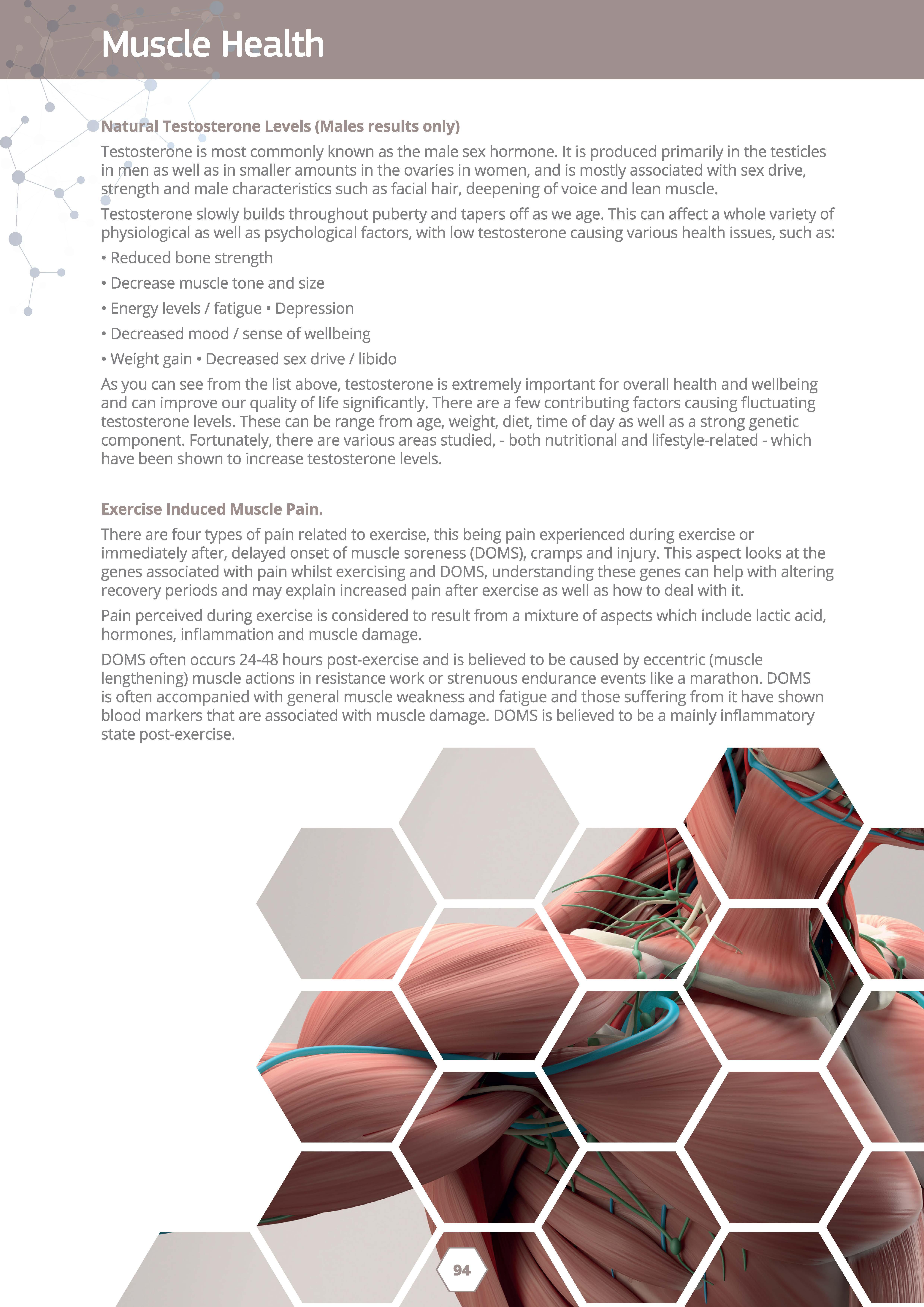
Pain perceived during exercise is considered to result from a mixture of aspects which include lactic acid, hormones, inflammation and muscle damage.
DOMS often occurs 24-48 hours post-exercise and is believed to be caused by eccentric (muscle lengthening) muscle actions in resistance work or strenuous endurance events like a marathon. DOMS is often accompanied with general muscle weakness and fatigue and those suffering from it have shown blood markers that are associated with muscle damage. DOMS is believed to be a mainly inflammatory state post-exercise.
•
Stress Related Muscle Pain.
Stress can manifest itself in a whole host of ways and is largely caused by an individual's perception of what is occurring around them (their environment), what they perceive to be occurring from others (external pressure) and internal emotions that might be deemed stressful to them. When aspects of life appear threatening, stress can accumulate, and this is heightened if the individual does not believe they have the resources required to deal with it.
The psychological effects of stress can - in many instances - have a knock-on physical effect, such as • shoulder, back and muscle pain. Addressing the cause and not the symptoms of your stress is the best course of action, but unfortunately our everyday lives get in the way sometimes.
CoQ10 Deficiency.

Coenzyme Q10 or CoQ10 - as it is referred - to comes in two forms: ubiquinone and ubiquinol. It's a compound that is naturally produced in the mitochondria within the cells and helps to keep them energised. Some genetic variants are linked to lower levels of CoQ10.
The severity, combination of signs and symptoms, and age of onset of primary coenzyme Q10 deficiency are different for nearly every individual, however, it can lead to muscle damage, pain and weakness.
Anti-Ageing Eye Health Gut Health Heart Health Immunity Stress Related Muscle Pain Risk T Genes of interest: ADRA1A, AMPD1, COMT, HCRTR2, BDNF Stress Related Muscle Pain Risk
by an individual's perception of what is occurring around them (their environment), what they perceive to be occurring from others (external pressure) and internal emotions that might be deemed stressful to thPm WhPn ;::i~nPr.t!=:: nf lifP ;:mnp;::ir thrp;::ifpninn ~trP~!=:: r.;:in i Home Results In sig ht s Epigenetics More 0 Anti-Ageing Eye Health Gut Health Heart Health Immunity Coenzyme Q10 Deficiency Risk T Genes of interest: COQBA, COQ6, COQ4, ADCK3, COQ9, COQ7 Coenzyme Q10 Deficiency Risk Coenzyme Q10 or CoQ10 - as it is referred - to comes in two forms: ubiquinone and ubiquinol. It's a compound that is naturally produced in the mitochondria within the cells and helps to keep them energised Some genetic variants are l inked to lower levels of CoQ10. The severity, r.nmhin:::itinn nf ~inns:: ;::inrl s::vmntnm~ ;::inrl ;::in.:,, nf nnc:pt nf GJ i -w Home Resu lts In sig ht s Epigenetics More
Stress can manifest itself in a whole host of ways and is largely caused
•
•
•
Skin health looks at 10 key areas.
• Sun Sensitivity.
• Skin Ageing.
• Beta-Carotene Conversion
• Gluten and Skin interaction.
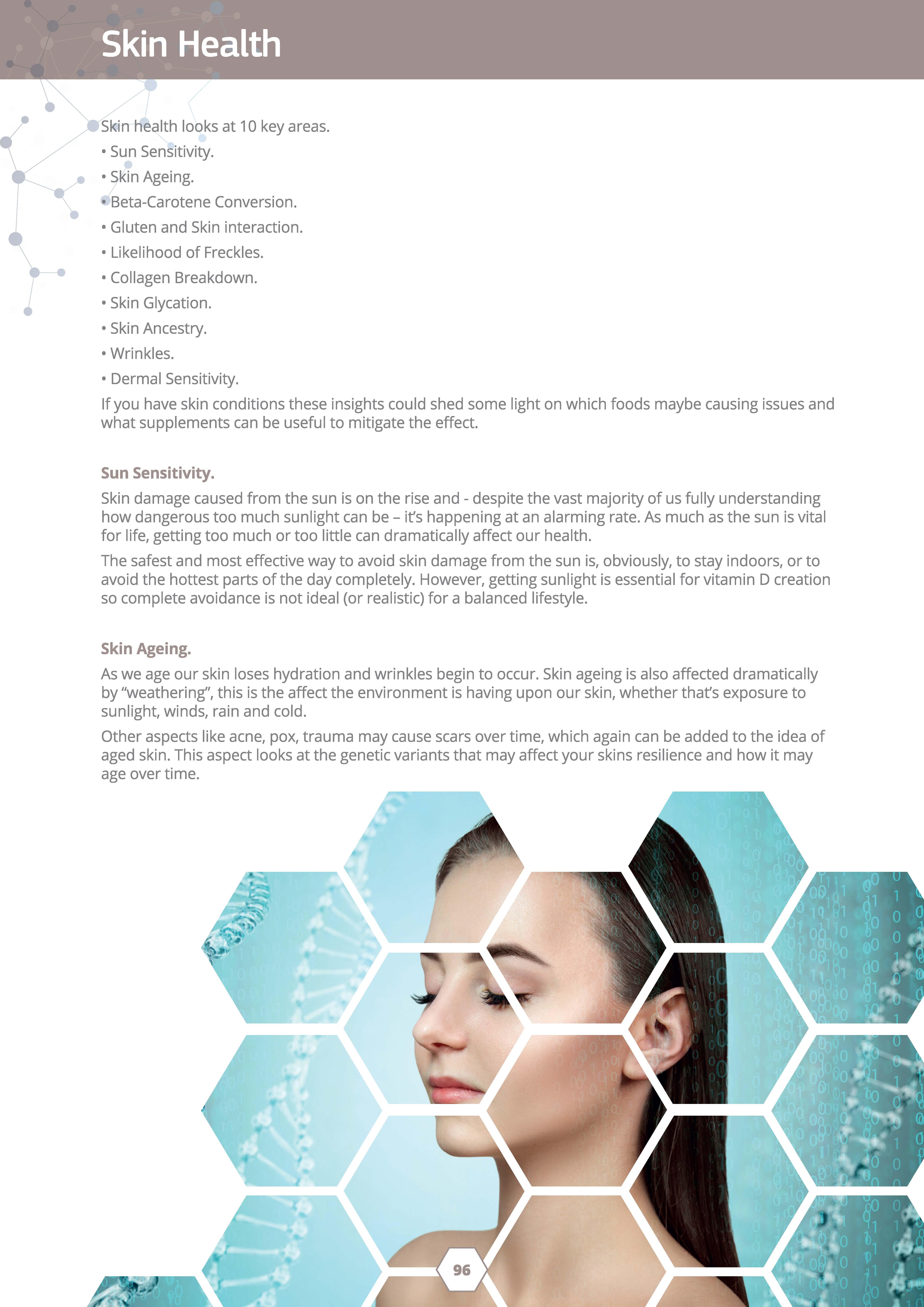
• Likelihood of Freckles
• Collagen Breakdown.
• Skin Glycation.
• Skin Ancestry.
• Wrinkles.
• Dermal Sensitivity.
If you have skin conditions these insights could shed some light on which foods maybe causing issues and what supplements can be useful to mitigate the effect.
Sun Sensitivity.
Skin damage caused from the sun is on the rise and - despite the vast majority of us fully understanding how dangerous too much sunlight can be - it's happening at an alarming rate. As much as the sun is vital for life, getting too much or too little can dramatically affect our health.
The safest and most effective way to avoid skin damage from the sun is, obviously, to stay indoors, or to avoid the hottest parts of the day completely. However, getting sunlight is essential for vitamin D creation so complete avoidance is not ideal (or realistic) for a balanced lifestyle.
Skin Ageing.
As we age our skin loses hydration and wrinkles begin to occur. Skin ageing is also affected dramatically by "weathering", this is the affect the environment is having upon our skin, whether that's exposure to sunlight, winds, rain and cold.
Other aspects like acne, pox, trauma may cause scars over time, which again can be added to the idea of aged skin. This aspect looks at the genetic variants that may affect your skins resilience and how it may age over time.
Beta-Carotene Conversion.
Vitamin A is more than just a single nutrient. It's a broad group of related nutrients, each providing us with differing health benefits. Below is a brief explanation to vitamin A, and some of the health benefits that it offers
Retinoids
There are some specific immune, inflammatory, genetic and reproductive-related benefits of vitamin A that can only be obtained from the retinoid (animal source) forms of the vitamin.
Carotenoids
These act much in the same way as retinoids in providing us with unique health benefits. They function as antioxidant and anti-inflammatory nutrients, with some having a special role to play in the protection of our health. The two forms aren't just chemically different - they also provide us with different types of health benefits. Each offer specific immune, inflammatory and genetic benefits of vitamin A, with some that can only be obtained from the retinoid (animal source) forms of the vitamin.
Retinoids are especially important with respect to pregnancy and childbirth, childhood growth, night vision, red blood cell production and resistance to infectious disease. However, retinoids in high dosages can be cause birth defects and, therefore, it is unwise to supplement retinoid-based supplements when pregnant unless otherwise specified by your physician.
In most instances we will be required to consume both retinoids and carotenoids, with carotenoids converting to retinal in the body. However, conversion of the most important carotenoid, beta-carotene, differs between individuals based on their genetic variances.

Gluten and Skin interaction.
Gluten is a protein contained in wheat, barley and rye and is found in a variety of everyday food items. It allows doughs to be more elastic and pliable and thus is why gluten-containing grains have been used in breads and other baked goods for many years. It can sometimes be difficult to know if you have intolerance to gluten as there may be little - or no - symptoms.
Typical symptoms of intolerance include stomach pain with possible diarrhoea when gluten begins to damage the intestinal lining. The small intestines are covered with millions of little octopus-like arms called villi, which pull nutrients in from our foods and absorb them into the blood stream.
• •
• •
Our bodies create enzymes that break gluten (a protein) down, but if it can't fully do so due to gluten intolerance, damage to the villi can occur to such an extent that they cannot function correctly. This can lead to a tremendous amount of inflammation and pain as well as eventual malnutrition, which can also cause skin issues. Those who have gluten sensitivities may also show symptoms of skin issues from skin flushing, rashes and irritation
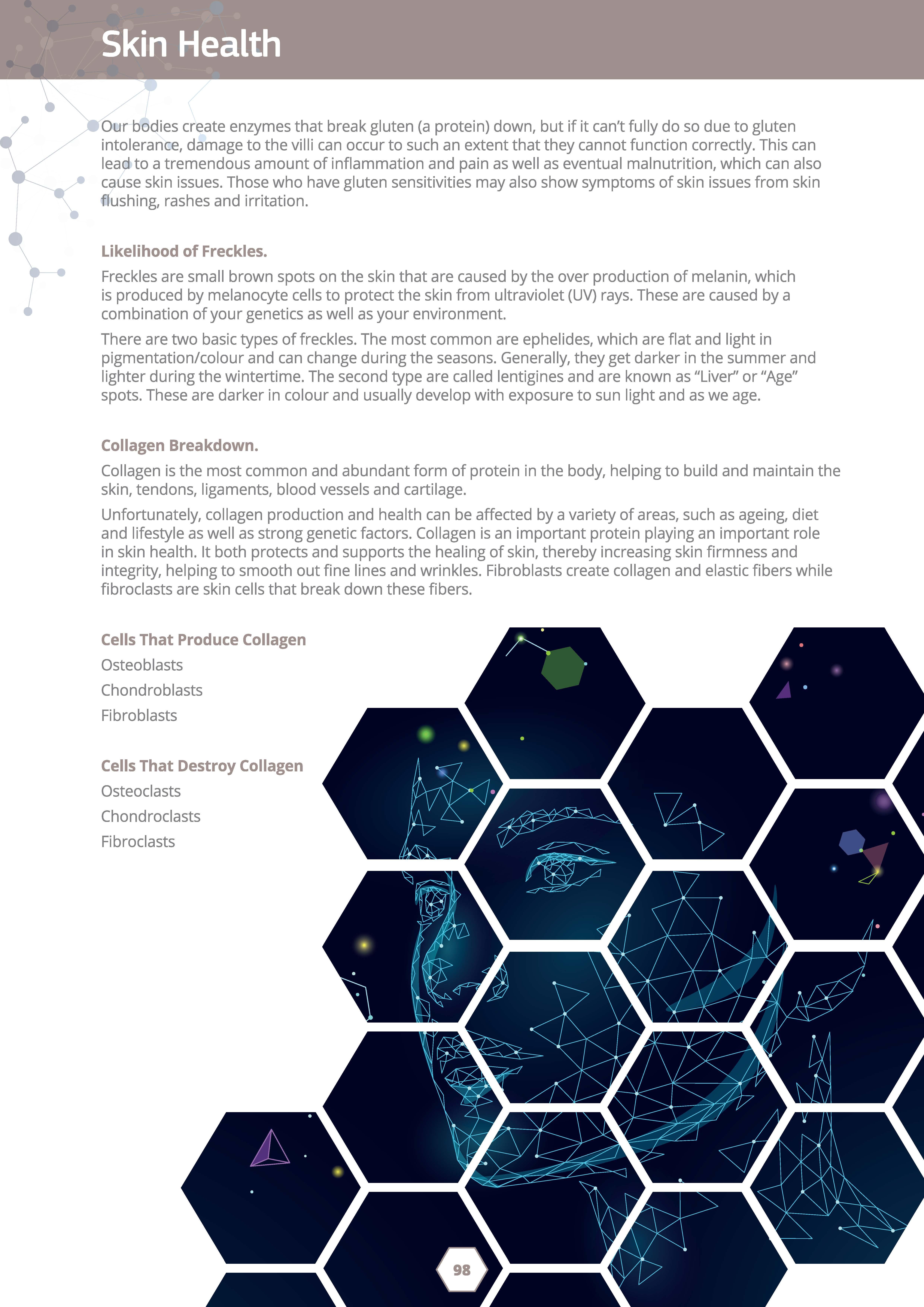
Likelihood of Freckles .
Freckles are small brown spots on the skin that are caused by the over production of melanin, which is produced by melanocyte cells to protect the skin from ultraviolet (UV) rays. These are caused by a combination of your genetics as well as your environment. There are two basic types of freckles. The most common are ephelides, which are flat and light in pigmentation/colour and can change during the seasons. Generally, they get darker in the summer and lighter during the wintertime. The second type are called lentigines and are known as "Liver'' or "Age" spots. These are darker in colour and usually develop with exposure to sun light and as we age.
Collagen Breakdown.
Collagen is the most common and abundant form of protein in the body, helping to build and maintain the skin, tendons, ligaments, blood vessels and cartilage.
Unfortunately, collagen production and health can be affected by a variety of areas, such as ageing, diet and lifestyle as well as strong genetic factors. Collagen is an important protein playing an important role in skin health. It both protects and supports the healing of skin, thereby increasing skin firmness and integrity, helping to smooth out fine lines and wrinkles. Fibroblasts create collagen and elastic fibers while fibroclasts are skin cells that break down these fibers.
Cells That Produce Collagen Osteoblasts Chondroblasts Fibroblasts Cells That Destroy Collagen Osteoclasts Chondroclasts Fibroclasts
• •
Each of these cell pairs work together in the constant process of collagen breakdown and creation. However, collagen production slows as we age, and destruction will speed up.
Skin Glycation.
Glycation is a process where insulin doesn't metabolise sugars correctly, allowing the sugar molecules to bind to fat and protein cells such as collagen and elastin. This results in the production of new harmful molecules glycotoxins called Advanced Glycation End Products (AGEs), which cause oxidative stress and chronic inflammation
If the body produces high levels or too much glycation then this will have a detrimental effect with regards to collagen and elastin production, thus negatively impacting your skin health. This process occurs mainly due to the foods we eat and the temperature we cook them at.
Those individuals with higher blood sugar levels, such as diabetics and people that eat a lot of processed foods will be more prone to glycation producing high levels of AG Es.
There is no way to completely stop glycation or remove AG Es from your diet, however, there are things you can do to reduce the amount of AG Es that you consume each day.
Wrinkles.
Wrinkles, or "rhytids" to give them their medical name are creases in the skin, which usually appear or become more pronounced as we age. The reason for this is that the skin cells divide more slowly, with the dermis (the middle layer of the skin) beginning to thin. The dermis is composed of proteins such as elastin and collagen fibres, which provide support and elasticity to the skin.
Various factors contribute towards wrinkles, from genetic, sun and smoke exposure, diet, pollution as well as our sleep patterns.
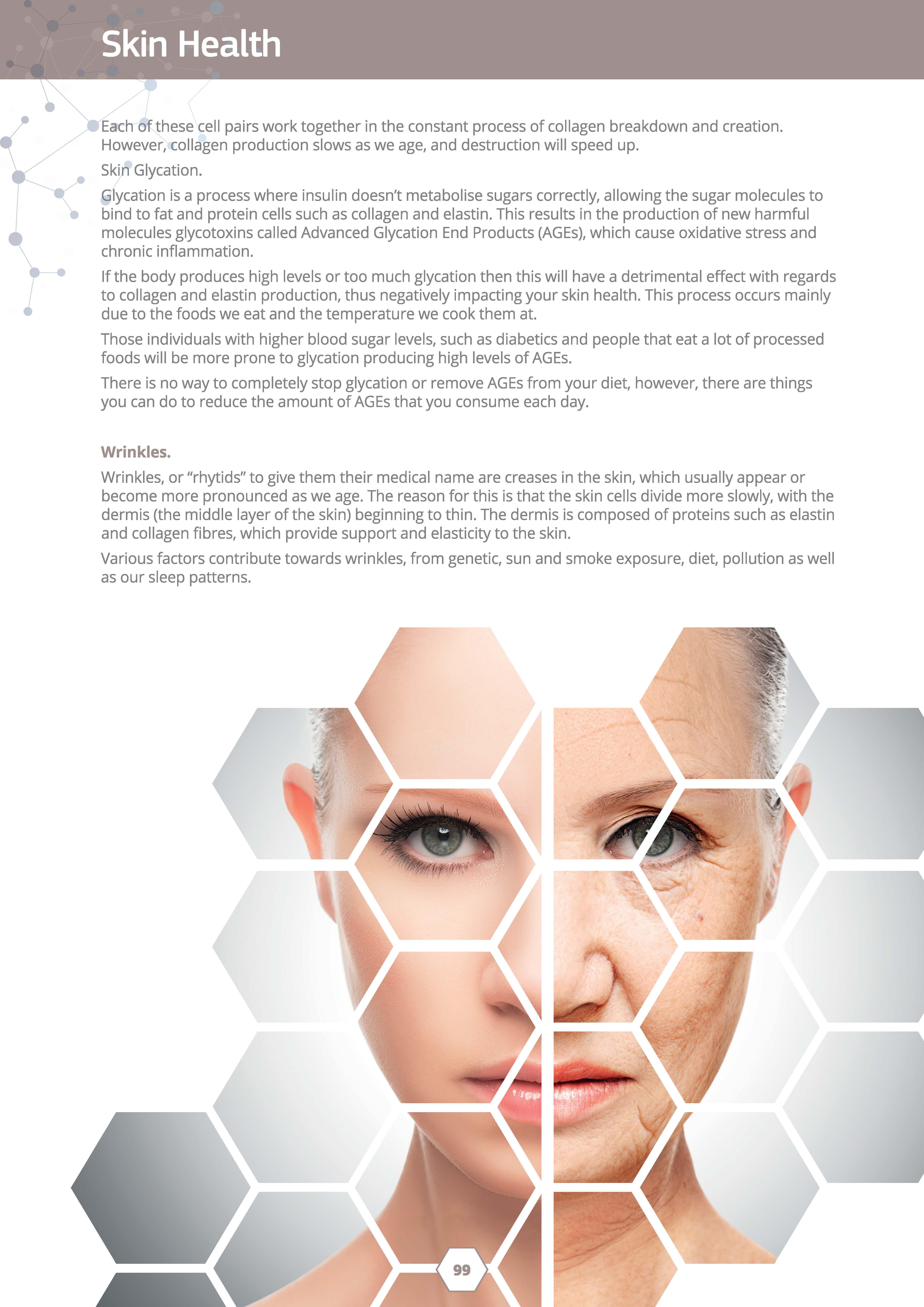
•
Dermal Sensitivity.
Sensitive or hyper-reactive skin can be caused for various reasons, either from skin disorders such as eczema or rosacea, which dehydrated or dry the skin, or even from using household or cosmetic products, which can irritate the skin causing inflammation. It can also be caused by high levels of stress or from poor tlietary choices, which will increase inflammation as well as the chances of that individual having a vitamin or mineral deficiency.
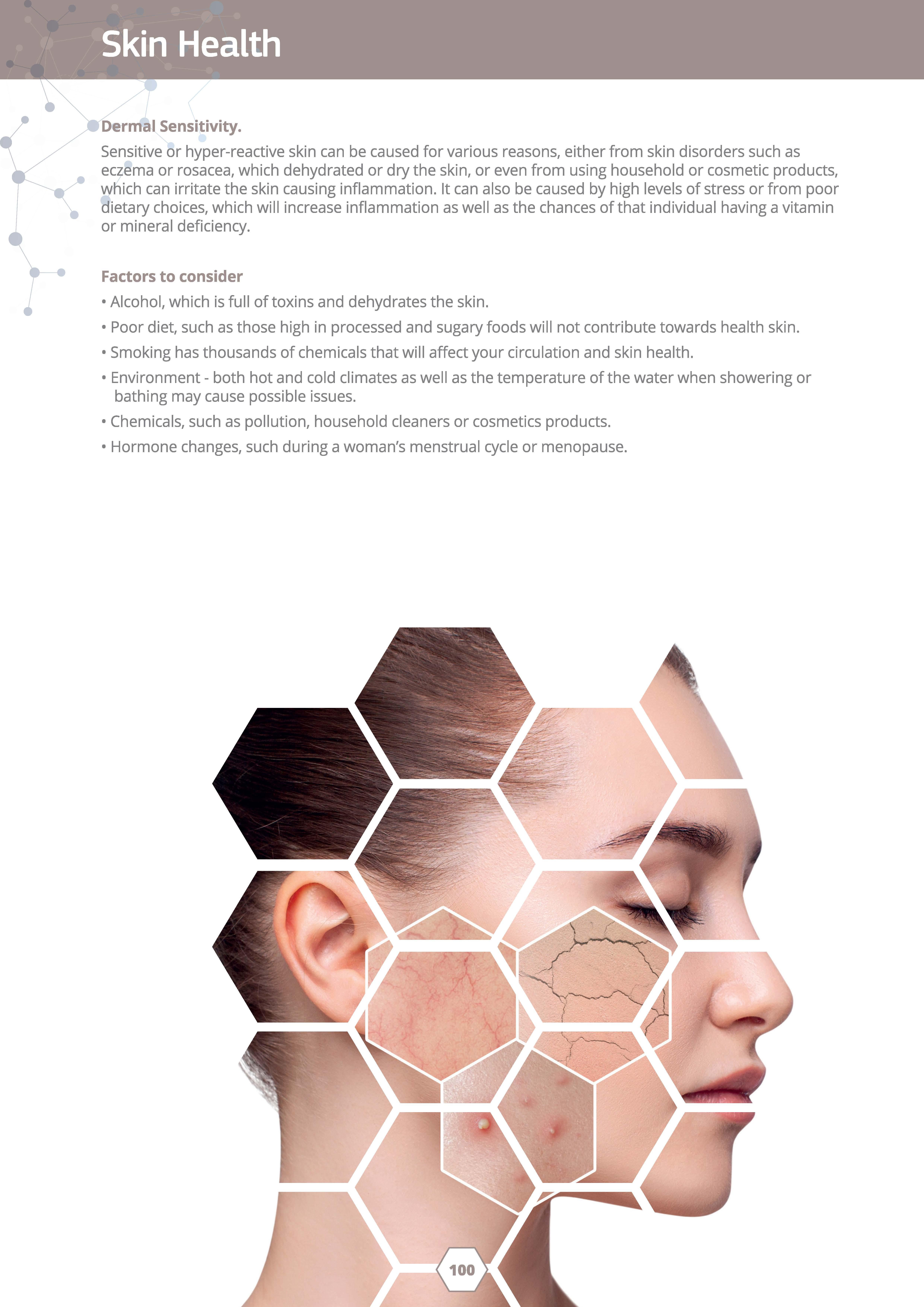
• Factors to consider
• Alcohol, which is full of toxins and dehydrates the skin.
• Poor diet, such as those high in processed and sugary foods will not contribute towards health skin.
• Smoking has thousands of chemicals that will affect your circulation and skin health.
• Environment - both hot and cold climates as well as the temperature of the water when showering or bathing may cause possible issues.
• Chemicals, such as pollution, household cleaners or cosmetics products.
• Hormone changes, such during a woman's menstrual cycle or menopause.
The pressures and fast pace of modern-day life has a whole variety of negative health connotations associated with it. Getting a good night's sleep is paramount to our health and wellbeing.
Our genetics play a role in the development of sleep disorders, quantity and quality of sleep, and if we are more likely to stay up late, get up early, or have naps, etc. These areas show the importance of particular gene variants on your own sleep patterns.
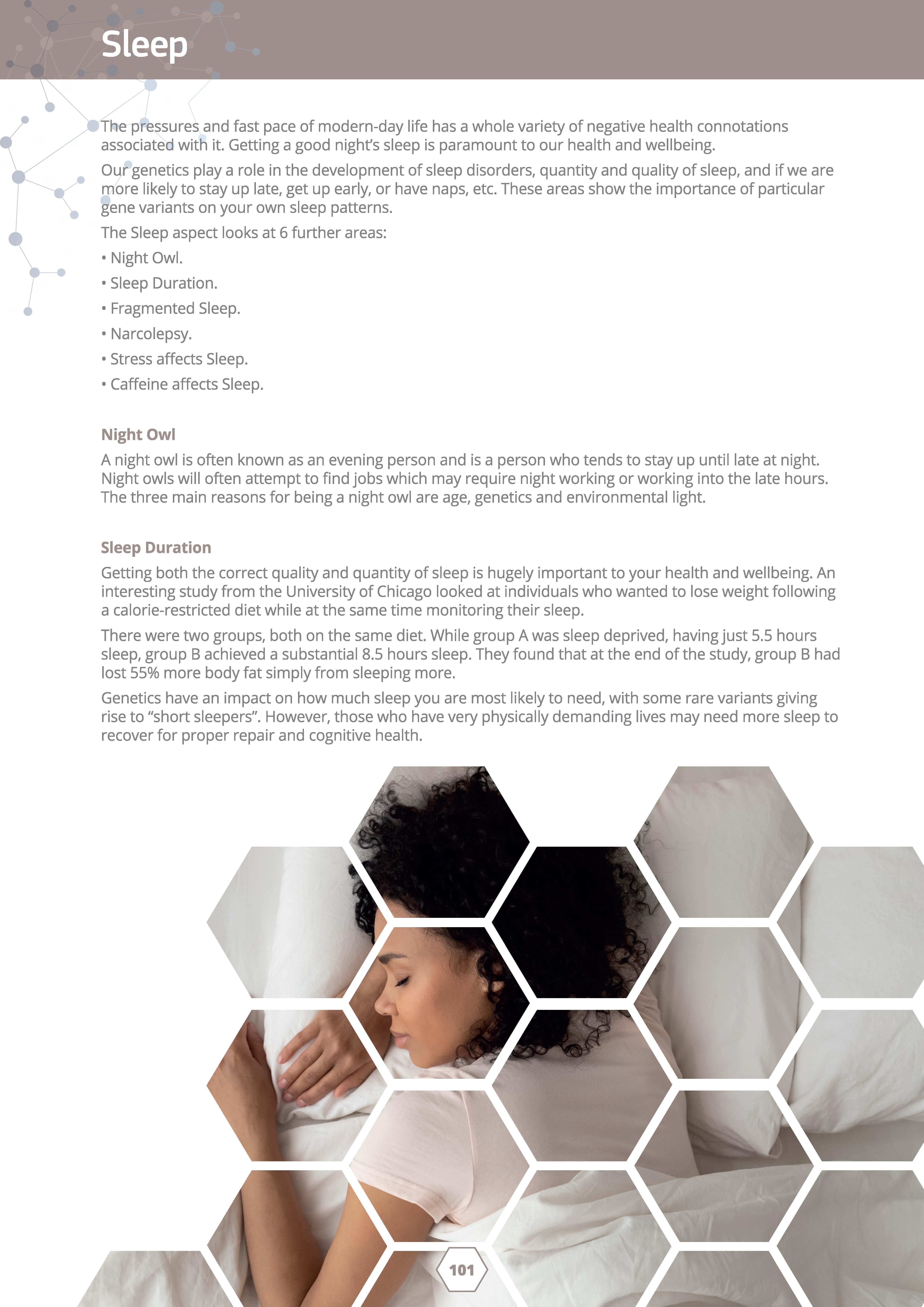
The Sleep aspect looks at 6 further areas:
• Night Owl.
• Sleep Duration.
• Fragmented Sleep.
• Narcolepsy.
• Stress affects Sleep.
• Caffeine affects Sleep.
Night Owl
A night owl is often known as an evening person and is a person who tends to stay up until late at night. Night owls will often attempt to find jobs which may require night working or working into the late hours. The three main reasons for being a night owl are age, genetics and environmental light.
Sleep Duration
Getting both the correct quality and quantity of sleep is hugely important to your health and wellbeing. An interesting study from the University of Chicago looked at individuals who wanted to lose weight following a calorie-restricted diet while at the same time monitoring their sleep.
There were two groups, both on the same diet. While group A was sleep deprived, having just 5.5 hours sleep, group B achieved a substantial 8.5 hours sleep. They found that at the end of the study, group B had lost 55% more body fat simply from sleeping more.
Genetics have an impact on how much sleep you are most likely to need, with some rare variants giving rise to "short sleepers". However, those who have very physically demanding lives may need more sleep to recover for proper repair and cognitive health.
•
Fragmented Sleep
Getting a good night's sleep will affect you in more ways than just how tired or fatigued you feel. Fragmented sleep can have a variety of negative health connotation associated with it, from increased blood pressure, reduced cardiovascular health to affecting mental and emotional health. Mutations in the gene FABP7 have also been associated with poor sleep patterns and therefore it's important to know if you have this mutation .
Narcolepsy
Narcolepsy is a chronic disorder that destroys orexin neurons, which is one of the neurotransmitters that helps regulate your sleep/wake cycle, wakefulness and appetite along with melatonin.
It can also cause long periods of daytime sleepiness and muscle weakness. Certain gene variants may put you at higher risk of developing the disorder. This aspect looks at those.
Stress affects Sleep
In many ways, stress and sleep can be the perfect chicken and the egg scenario. Having continuous stress will have a negative effect on your sleep quality and having poor quality sleep will increase your stress levels.
Your health can be affected by a variety of factors, one that is currently being studied is the effect of sleep and our circadian rhythm. Our circadian rhythm is thought to regulate around 15-20% of our genome and is tremendously important to keeping us fit and healthy as it affects our hormones, eating habits and reduces the chances of us become ill.
Caffeine affects Sleep
Caffeine is a stimulant and therefore may affect sleep regardless of your genetics. However, certain gene variants mean that the stimulating effects of caffeine may last longer, and the effect is more pronounced. Certain gene variants can mean that caffeine can affect sleep quality even if there is no stimulating effect present. Understanding this aspect might therefore lead to superior sleep and recovery.
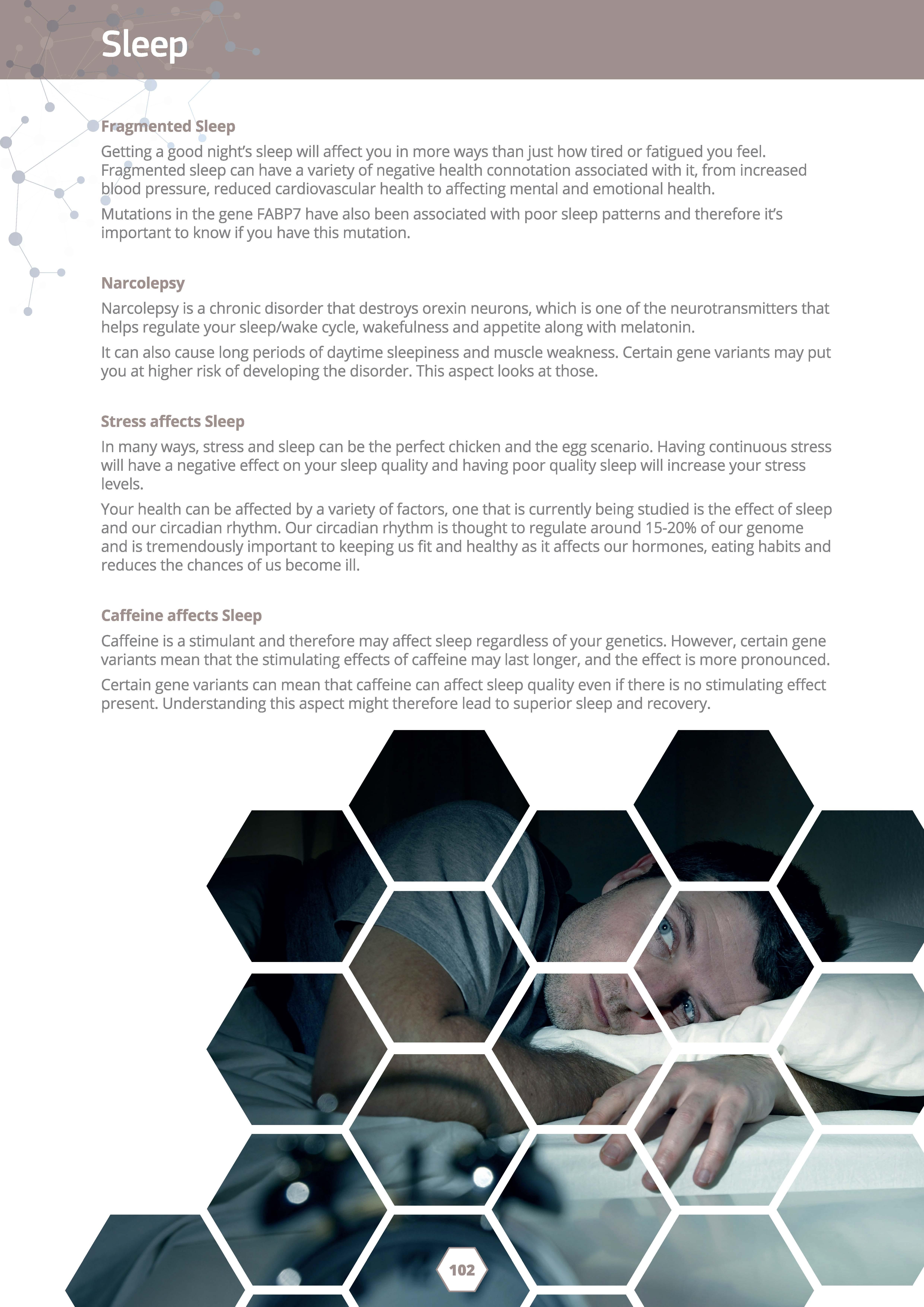
• •
•
•
The Stress aspect looks at 6 further areas:
• Stress and Pressure.
• Stress and Memory.
• Dealing with Stress
• Stress leading to Physical Symptoms.
• Stress and the Heart
• Caffeine and Stress.
Mental stress is a form of psychological pain and while it is mostly considered negative, it is often required and can be beneficial in helping athletes to reach their goals, improving motivation and aiding the body in adapting to a certain environment. Excessive psychological stress, however, is negative. Acutely, it can cause panic and chronic stress can eventually lead to psychological and physical harm.
Stress is caused by an individual's perception of what is occurring around them (their environment), what they perceive to be occurring from others (external pressure) and internal emotions that might be deemed stressful to them.
The way we deal with stress is highly important. Methods to reduce stress may include breathing exercises, meditation, eating certain foods, going to the gym or for a run, yoga, etc. However, some people are more likely to keep themselves isolated when chronically stressed and research has shown that it is better to talk with others instead of going into isolation.
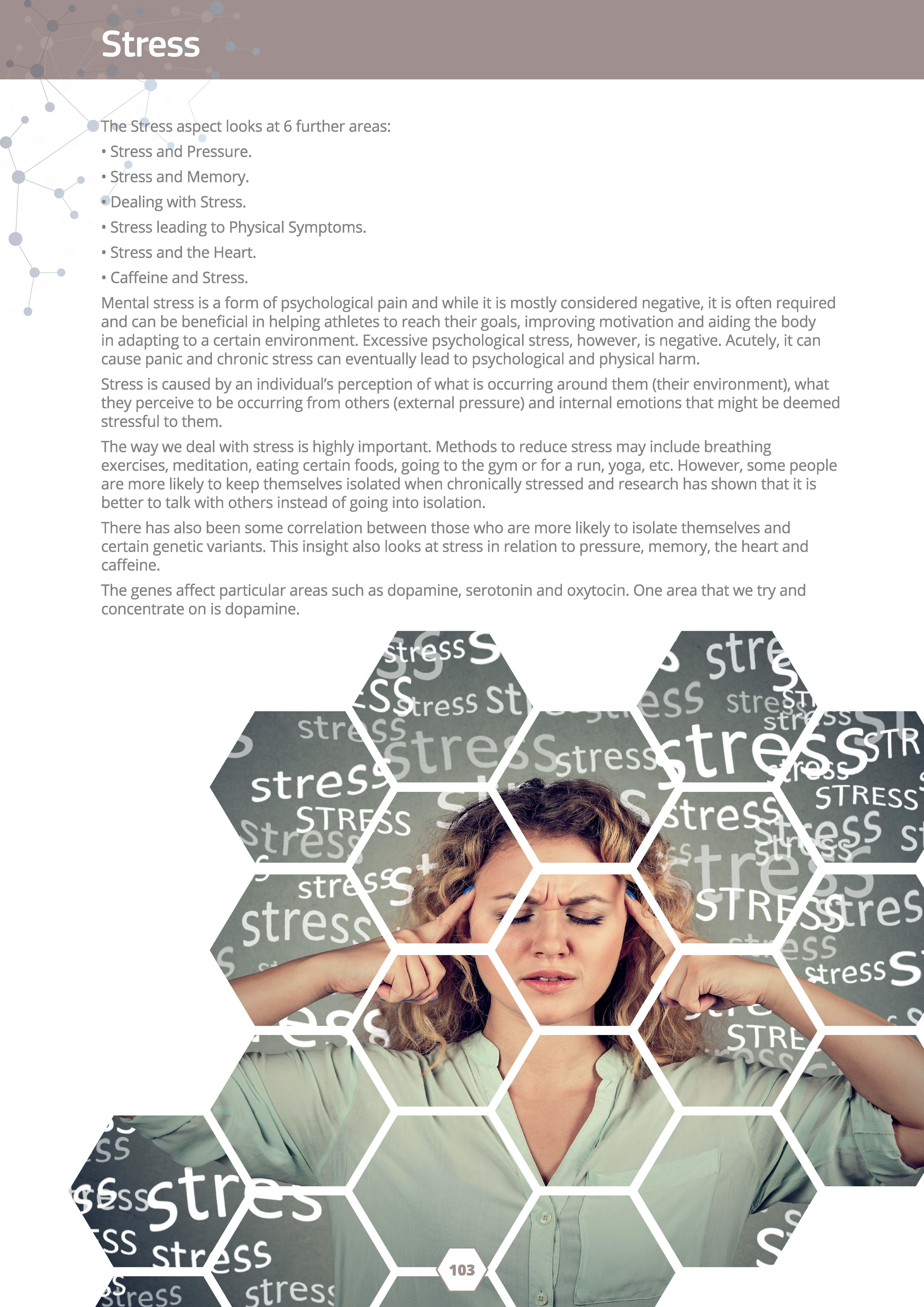
There has also been some correlation between those who are more likely to isolate themselves and certain genetic variants. This insight also looks at stress in relation to pressure, memory, the heart and caffeine.
The genes affect particular areas such as dopamine, serotonin and oxytocin. One area that we try and concentrate on is dopamine.
•
Stress and Pressure
Pressure is the perception that one may have of external factors affecting life. Many people often conclude that they are stressed due to the pressures placed upon them from finances, friends or family, perceived duty, work and a multitude of other factors.
How one responds to the situation may differ due to their gene variations and so translating this result will lead to a superior understanding of oneself.
Stress and Memory
Acute stress may cause a sudden loss of recall, which unfortunately could come at a time when you need it the most (think exams, tests, etc.). Chronic stress might also lead to an inability to actually form new memories, which - again - if you are revising, practicing for an event, or meeting new people, could be highly detrimental.
Our genes play a role in this response and understanding this may help you put into place certain pre-test rituals, methods of revising, etc. that may reduce stress levels and therefore benefit your memory.
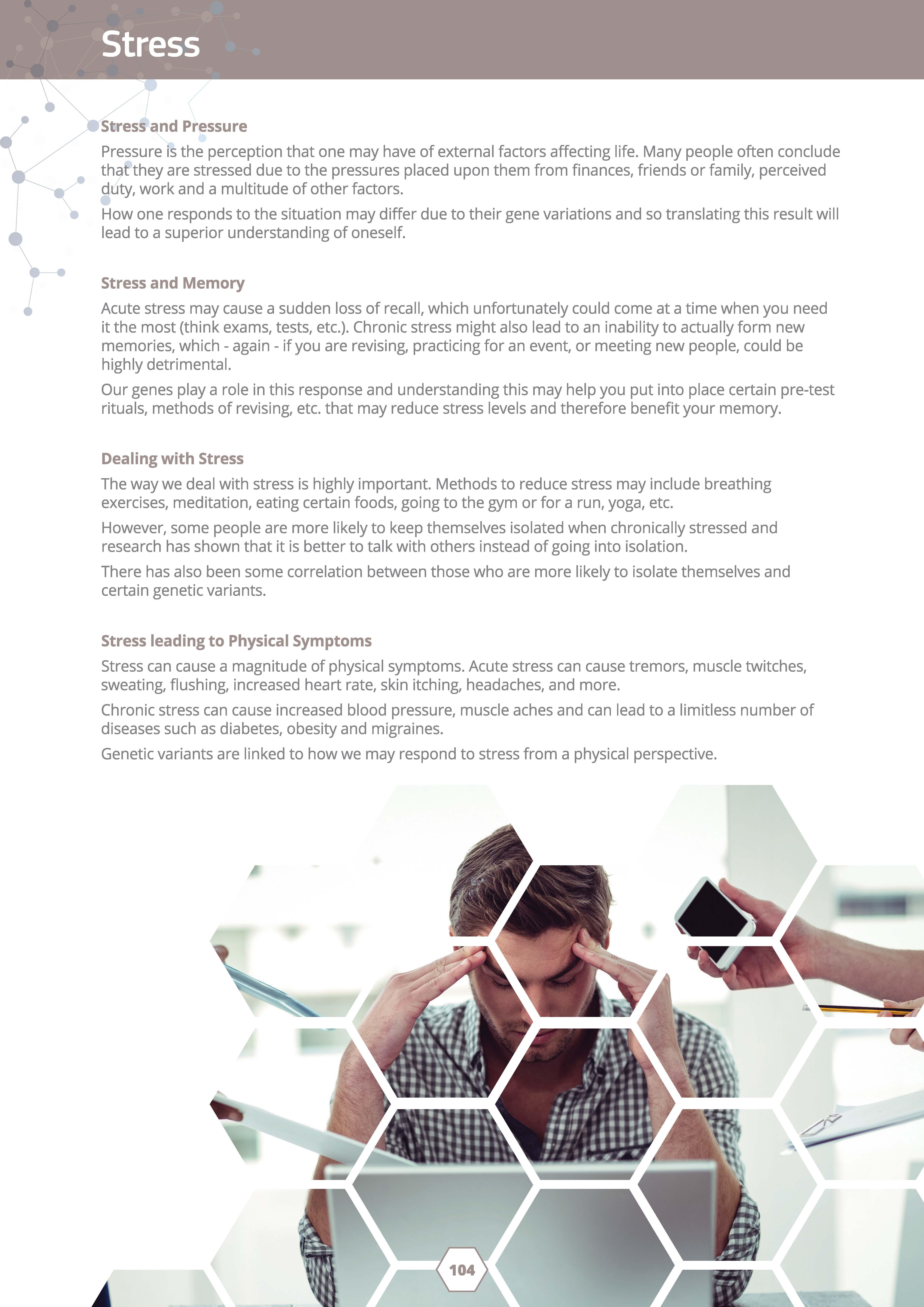
Dealing with Stress
The way we deal with stress is highly important. Methods to reduce stress may include breathing exercises, meditation, eating certain foods, going to the gym or for a run, yoga, etc.
However, some people are more likely to keep themselves isolated when chronically stressed and research has shown that it is better to talk with others instead of going into isolation.
There has also been some correlation between those who are more likely to isolate themselves and certain genetic variants.
Stress leading to Physical Symptoms
Stress can cause a magnitude of physical symptoms. Acute stress can cause tremors, muscle twitches, sweating, flushing, increased heart rate, skin itching, headaches, and more.
Chronic stress can cause increased blood pressure, muscle aches and can lead to a limitless number of diseases such as diabetes, obesity and migraines.
Genetic variants are linked to how we may respond to stress from a physical perspective.
• •
Stress and the Heart
Stress can cause a host of physical issues as highlighted in the "stress leading to physical symptoms" aspect. One major part of stress that does lead to physical symptoms is the effect it has on the heart. Stress can affect the heart in both a chronic and acute sense and these could have the same or different
• symptoms, with certain genetic variants being linked to how the heart may be affected by stress

Caffeine and Stress
Caffeine is a stimulant and as such can help to "perk" you up if you are feeling fatigued or tired. It is often utilised to help with focus before training or learning.
Caffeine, like all drugs, affects people in different ways and as such may or may not be a good choice in times of stress. In general, caffeine will increase heart rate, and this may be negative for any stressful situation.
Energy drinks containing caffeine are often used in times of exams and tests and so understanding how you may respond in these stressful situations is vital for making the correct choice.
•
Mental Health @ Muscle Health @ (§) Skin Health Sleep Stress Stress And The Heart • Genes of interest : COMT, DTNBP1, CHRNA4, BDNF, ADD1, MTHFR Stress And The Heart Stress can cause a host of physical issues as highlighted in the "stress leading to physical symptoms" aspect. One major part of stress that does lead to physical symptoms is the effect it has on the heart. Stress can affect the heart in both a chronic and acute sense and these could h;:ivp thP c::;::imp nr rliffPrPnt c::vmntnm~ with r..Prt:::iin GJ I -w Home Resu lts Insight s Ep igenetics More e Mental Health Muscle Skin Health Sleep Health Stress Caffeine And Stress • Genes of interest : ADORA2A, CYP1 A2 Caffeine And Stress Caffeine is a stimulant and as such can help to "perk" you up if you are feeling fatigued or tired. It is often utilised to help with focus before training or learning. Caffeine, like all drugs, affects people in different ways and as such may or may not be a good choice in times of stress In nPnPr;:i.l r.;::iffpinP will inr.n:1;:i.~p hp;::irt r;:itp ;:inrl thi!=:: m:::iv hP GJ I -w Home Resu lts Insights Epigenet ics More
• •
Understanding that a lot of health areas such as the immune system, athletic performance, injury risk, to how well you sleep will all interlink and influence one another.
You must not look at aspects in isolation and learn to look at the holistic view. Please move onto the next 3 sections, which will provide you with examples to look at, to help you understand results in the Bio-Synergy J pp, whether they are yours or possibly the results of your clients
Immunity
Our immune system is affected by numerous factors that interlink with each other as outlined by the diagram in your manual. Please take the time to read through the information before moving onto the next section.
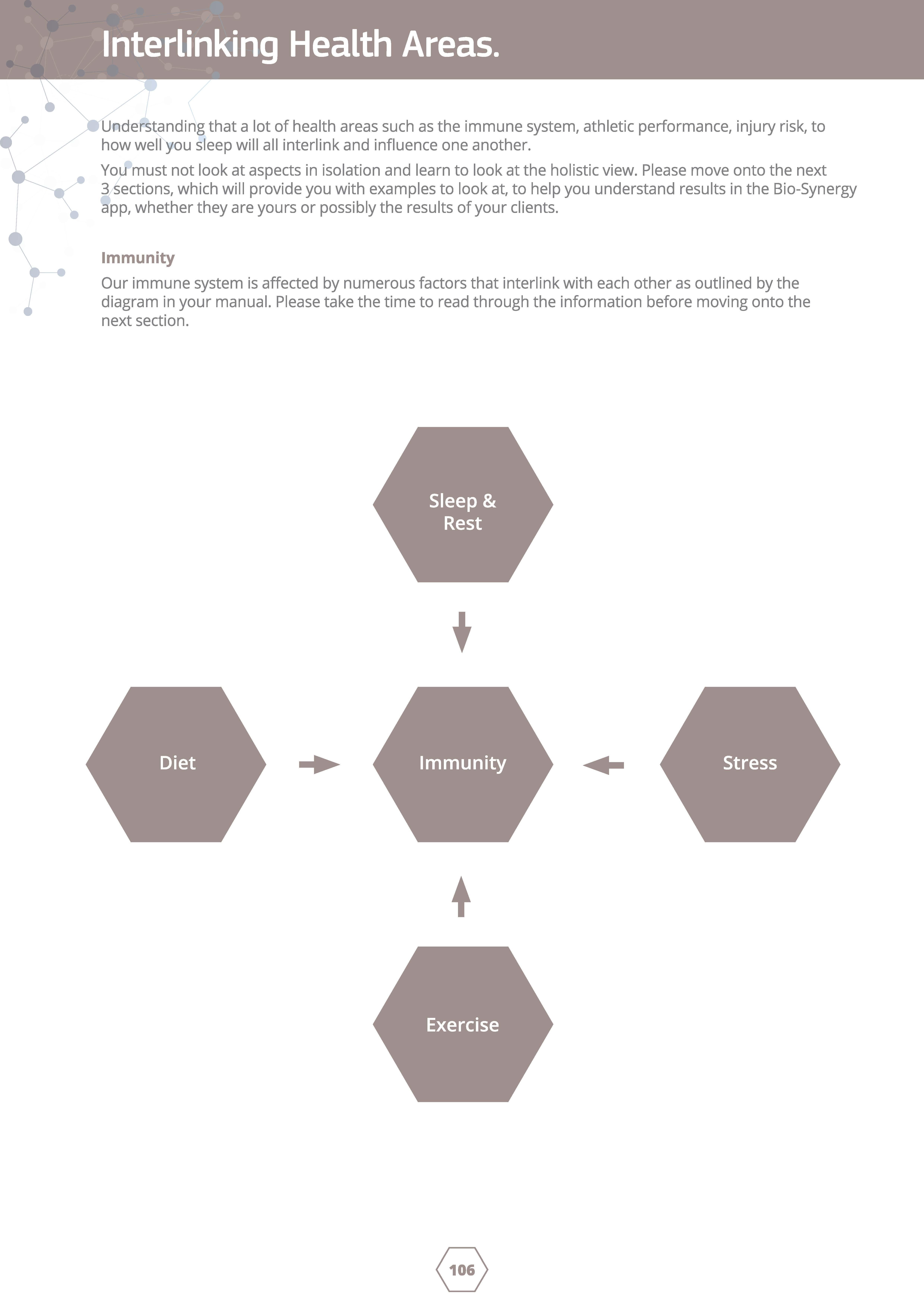
e
•
Our immune system is affected by numerous factors that interlink with each other as outlined in the above diagram.
Recommendations to help support the immune system are as follows; it is vital that you maintain your health with a balanced diet, regular exercise and getting enough sleep as well as staying clear of pathogens found in ollution and smoking
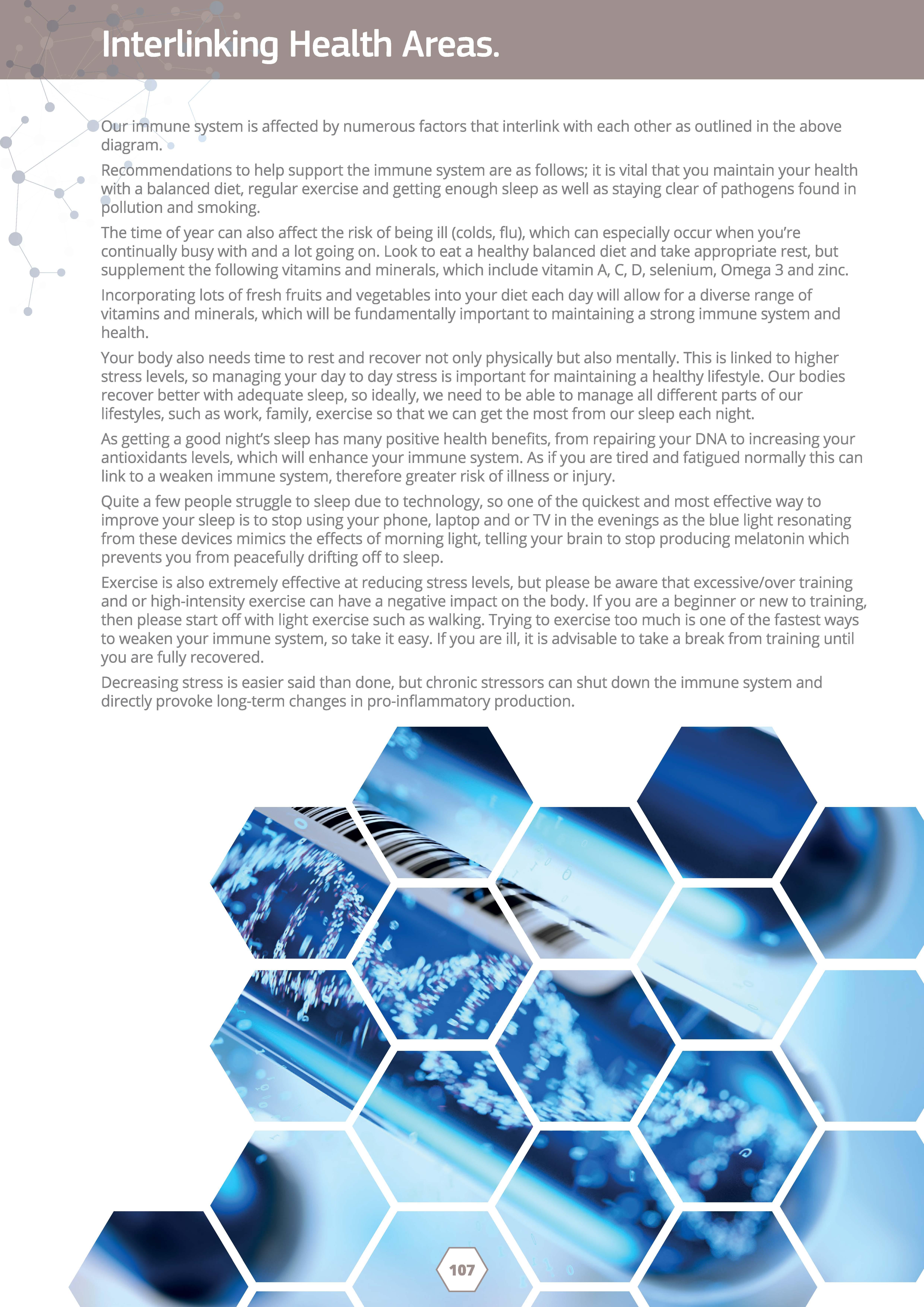
The time of year can also affect the risk of being ill (colds, flu), which can especially occur when you're continually busy with and a lot going on. Look to eat a healthy balanced diet and take appropriate rest, but • supplement the following vitamins and minerals, which include vitamin A, C, D, selenium, Omega 3 and zinc.
Incorporating lots of fresh fruits and vegetables into your diet each day will allow for a diverse range of vitamins and minerals, which will be fundamentally important to maintaining a strong immune system and health.
Your body also needs time to rest and recover not only physically but also mentally. This is linked to higher stress levels, so managing your day to day stress is important for maintaining a healthy lifestyle. Our bodies recover better with adequate sleep, so ideally, we need to be able to manage all different parts of our lifestyles, such as work, family, exercise so that we can get the most from our sleep each night.
As getting a good night's sleep has many positive health benefits, from repairing your DNA to increasing your antioxidants levels, which will enhance your immune system. As if you are tired and fatigued normally this can link to a weaken immune system, therefore greater risk of illness or injury.
Quite a few people struggle to sleep due to technology, so one of the quickest and most effective way to improve your sleep is to stop using your phone, laptop and or TV in the evenings as the blue light resonating from these devices mimics the effects of morning light, telling your brain to stop producing melatonin which prevents you from peacefully drifting off to sleep.
Exercise is also extremely effective at reducing stress levels, but please be aware that excessive/over training and or high-intensity exercise can have a negative impact on the body. If you are a beginner or new to training, then please start off with light exercise such as walking. Trying to exercise too much is one of the fastest ways to weaken your immune system, so take it easy. If you are ill, it is advisable to take a break from training until you are fully recovered.
Decreasing stress is easier said than done, but chronic stressors can shut down the immune system and directly provoke long-term changes in pro-inflammatory production.
e
Performance can mean different things to different people, but from a generic point of view the term performance encompasses "the action or process of performing a task or function". Again, there be a whole variety of areas that will feed into your performance and or to perform a specific task well.

There are exercise and training implications on performance, so dependent on your goal this will help you identify the best methods of training. Try to keep your programming simple and set yourself targets to achieve and the most appropriate methods to achieve them.
When looking at training over a period of time make sure you adapt your training, simple rule of thumb is look at the changes that have occurred in approx. 4 weeks. If at this point your body is still adapting, you may want to make a few small adaptations but nothing major as why change programming if you are progressing. However, if you are plateauing this is where you need to look at why and evaluate your programming.
•
e
There are lots of ways to adapt training, for example; time under tension, method of training, sets, reps, rest. There are also a number of external factors such as stress, sleep, diet, overtraining and rest days. This is why it is important to look at the holistic view of your lifestyle and not necessarily blame your programming for no results or progressions.
It is important to have a routine you follow in relation to nutrition, sleep, training and recovery. This allows you to be more effective and efficient with time to prepare yourself in the best possible way and reduce stress but also allow more free time to relax and enjoy life with your friends and family.
Habits can be hard to build, so with the Bio-Synergy app it provides you with an action planner to help you build in the best way. Learning not to try and change too much at once, set one simple target a week to achieve.
Nutrition, vitamin & mineral deficiencies are critical for you to understand and thus allowing you to add them to your daily intake through whole foods or supplementation. Your diet provides you with energy for your daily activities including exercise. If you are exercising frequently please make sure you get the correct nutrition to aid recovery, repair and hopefully avoid getting injured.
Understanding which particular foods to eat as well as when to eat them is always important. These foods and supplements recommendations are found in various sections of the Bio-Synergy app.
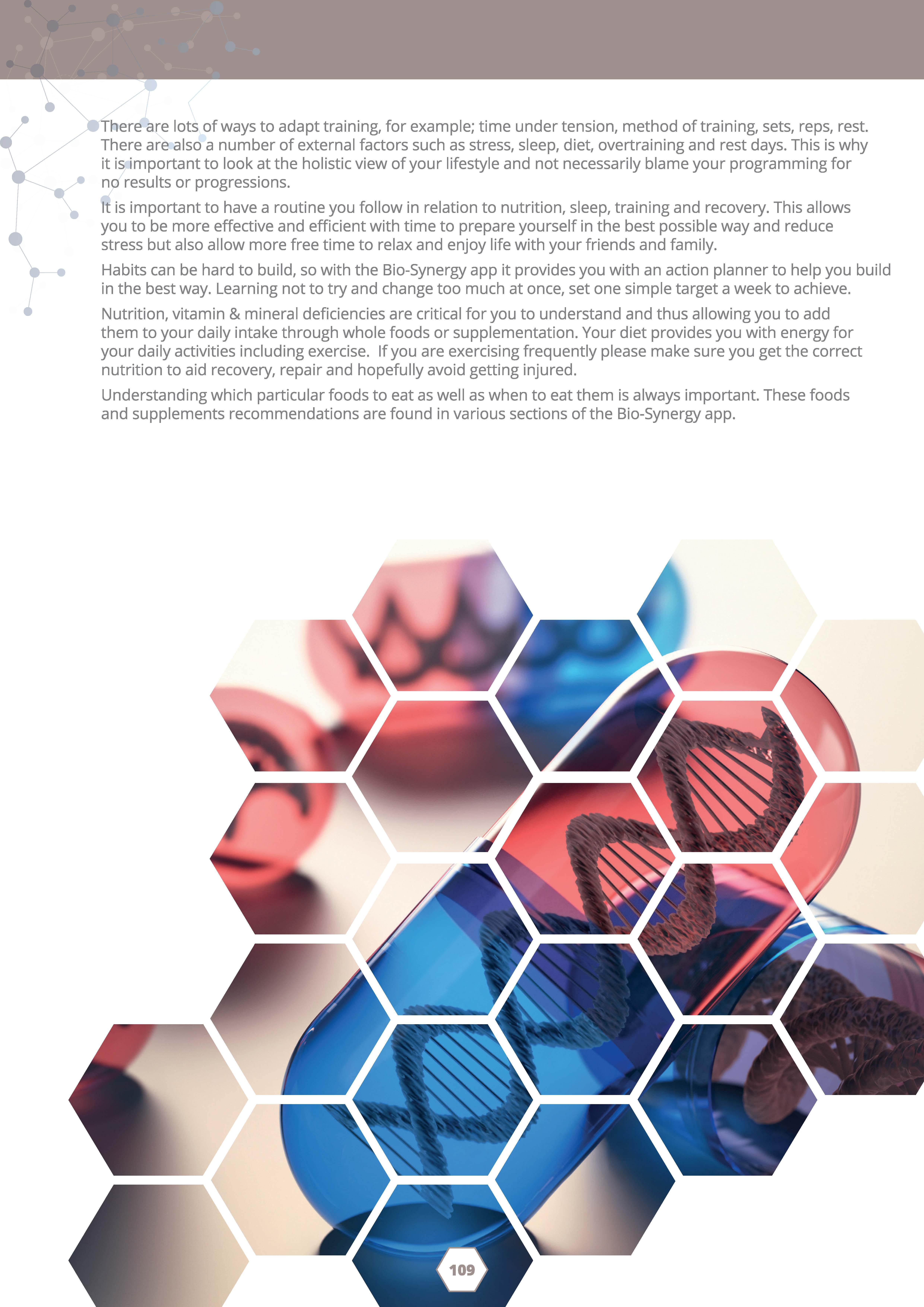
•
Sustaining an injury will usually happen for one of two reasons. Externally, such as when a player is tackled during a football match, or internally due to tissue failure. The latter can happen for a whole multitude of neasons such lack of warm up, poor dietary choices, poor technique to possibly having heightened inflammation
By understanding what aspects genes play on injury risk, interventions, prehab and rehab, it can be better personalised to impact every individual, maximising recovery speed, minimising injury risk and decreasing overall negative injury impact.
Post-exercise inflammation is a positive process, one which aids in adaptation, growth and recovery. However, if the body is already in an inflamed state, adding additional inflammation following exercise can have negative consequences on the body.
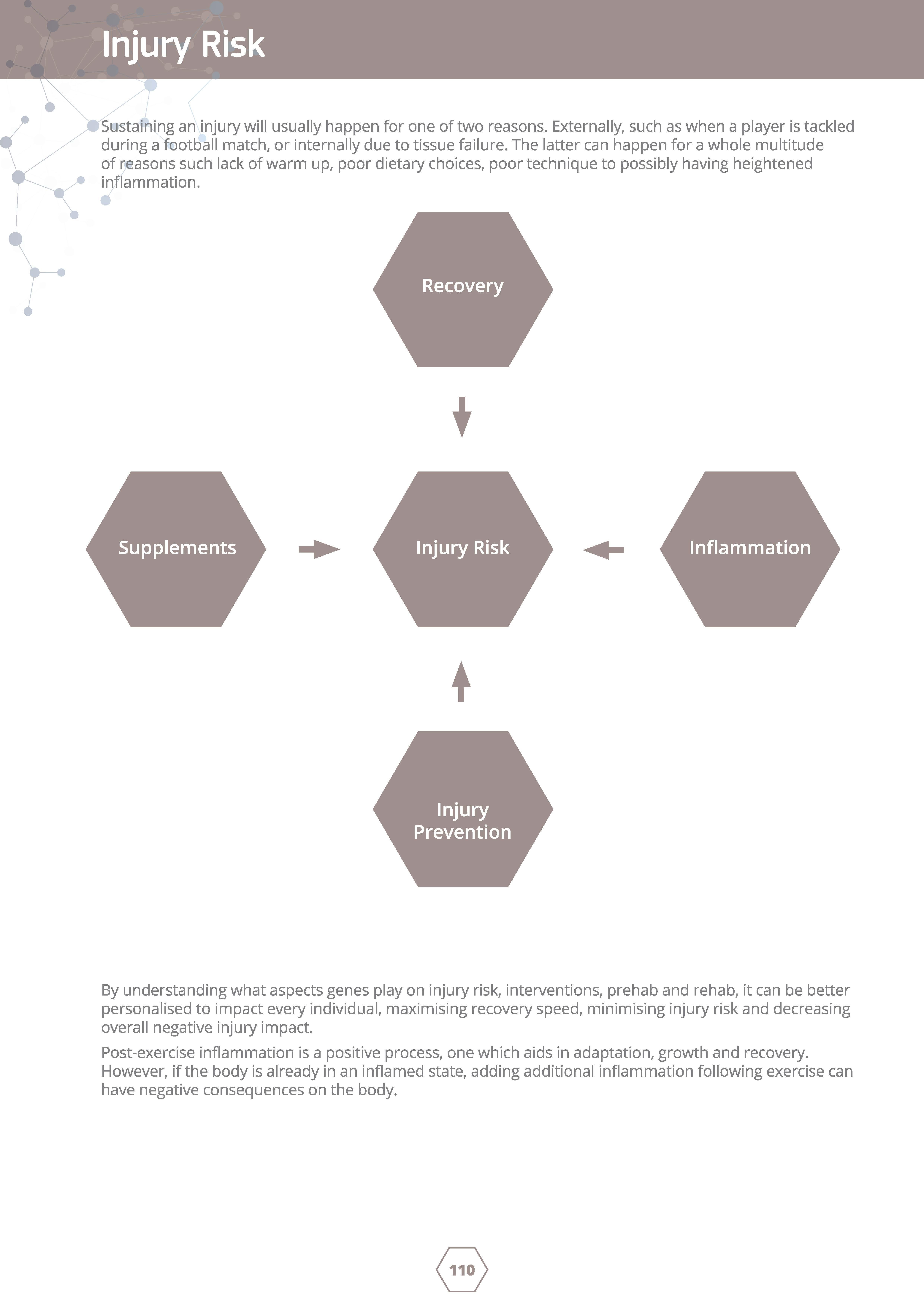
• •
e
• Sugar is by far the worst for inflammation and is void of any nutritional value, so you should aim to keep sugars low in the diet.
• Refined/processed grains have no fibre and have a high glycaemic index, which is combined with a poor diet can lead to inflammation.
• Additives such as MSG

• Trans Fats that are found in fast foods and margarine.
Inflammation will affect speed of recovery so if you can reduce inflammation by enhancing your recovery protocols as listed above. This is also including diet and training, making sure you are eating the correct foods for your body, which helps your body recover and repair.
Finally, if you can add injury prevention exercises, this will strength the joints, muscles, tendons and ligaments to reduce the risk of injury. There a number of exercises in the app to support you with different joints and muscles.
Now please take the time to go through the other interlinking areas.
• •
Yo/Yo diet
The Yo-Yo diet is the notion that an individual loses weight and regains weight in an inconsistent pattern. Normally, this relates to people trying to adapt their weight prior to a holiday in a short period of time. This is not healthy or sustainable, which affects the body in a number of ways and can cause issues with health and mental perception.
Negative connotations associated with genes involved in ''Yo-Yo" diet response, means that the possibility of gaining fat after the reintroduction of calories following a calorie deficit diet is much higher. These individuals need to be careful and change their diets slowly and progressively.

• .... • •
e
Our gut is a sensitive environment and many factors can affect the functionality of it. For everyone, stress and the production of cortisol has negative effects on the body and specifically the gut. But for some individuals with specific genetic traits the response to removing cortisol from the system is worsened and these people are more likely to have worse gut health.

Caffeine is a stressor in our body and for some people they can be affected more so from caffeine intake. This is why we at Bio-Synergy are looking into the response of caffeine, so that these individuals can reduce caffeine intake and may have to switch to other beverages, which are de-caffeinated.
If we have poor gut health, then we also have poor absorption of vitamins and minerals as well as other organic compounds. For athletes, having better gut health is key to recovering from exercise and for optimising performance. Contrary to this, over-exercising can also increase the amount of cortisol that we have in our body as well as decreasing our immune system. This can all have a negative impact on gut health. It is important therefor to look at how many days a week are suggested for the individual training, in order for them to have adequate rest to allow their bodies to recover.
• .... • •
e
•
•
To mitigate negative gut health, we recommend:
• Adequate sleep and rest for, not just athletes, but for everyone.
• Limit sugar intake, which can "feed" bad bacteria in the gut and cause an overproduction of these bacteria potentially leading to a leaky gut, IBS or other similar conditions.
• Limit caffeine intake to not overstress the body and gut. Caffeine increases peristalsis (the movement of the intestines) and this speeds up gut transit and therefore can limit absorption
• Consume adequate amounts offibre from different sources such as starches, legumes and fruits.
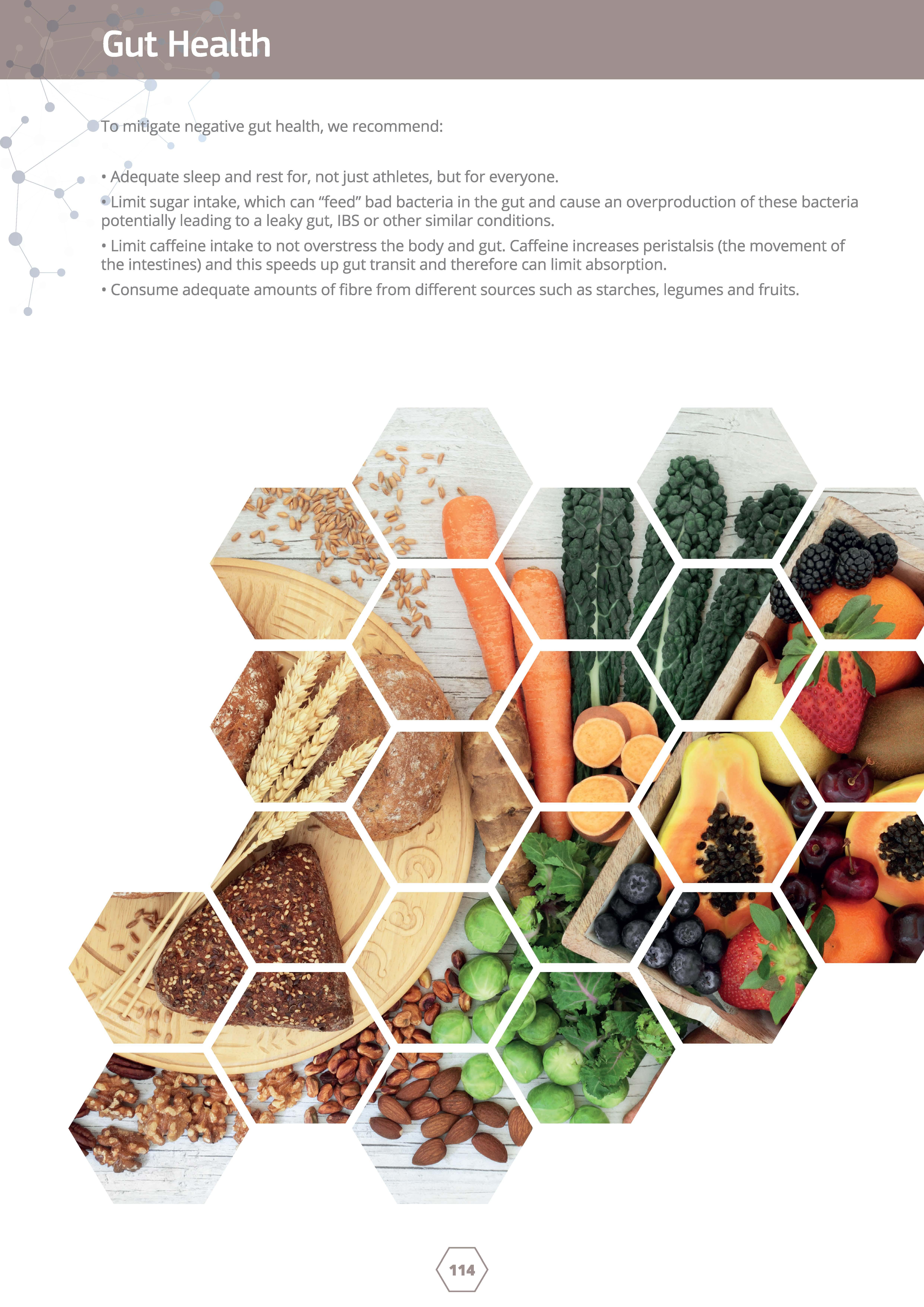
•
e
:-------
Stress can be brought on for a whole variety of reasons, from physical stressors such as: falling sick or getting injured or hurt; chemical stressors from high levels of pollution; or the myriad of household products people use each day. Then we have emotional stress, which most people will encounter, such as a friend or family member passing away, pressure at work, or financial difficulty.

Caffeine can increase our physical stress by increasing the amount of cortisol that we have in our body. Some people respond more negatively to caffeine intake; therefore, these individuals should reduce caffeine, especially if their stress response is naturally low. Studies have shown that even 1 day of poor sleep can increase both our physical and mental stress. Ensuring that you have adequate sleep quantity AND quality is crucial to reduce allosteric load.
A poor diet consisting of high fat and high sugar foods is also associated with higher amounts of physical and mental stress. Mental stress can be associated with a poor diet due to negative connotations and feelings of guilt. High fat and high sugar diets have been correlated with incidence of mild depression in adults. Stress and sleep can be the perfect chicken and the egg scenario. Having continuous stress will have a negative effect on your sleep quality and having poor quality sleep will increase your stress levels.
Without sleep we cannot recover both physically and mentally. Light and deep sleep are the times during sleep when our bodies repair physical damage however, during REM sleep this is when our mental processes are "organised". So, without adequate sleep, we cannot fully recover from work, daily life stress or physical stress associated with exercise.
• .... • •
e
In many ways sleep is the most important factor alongside vitamins and minerals. Without sufficient rest/ sleep your speed, power, mental ability, concentration and motivation will all be vastly reduced. We all have certain sleep traits that affect us so understanding this and ways to improve sleep will help in a number of ways day to day.

Stress and sleep can be the perfect chicken and the egg scenario. Having continuous stress will have a negative effect on your sleep quality and having poor quality sleep will increase your stress levels.
Your body needs time to rest to recover not only physically but also mentally. This is linked to stress and managing stress levels is important to a healthy lifestyle. Our bodies recover better with sleep and we need to be able to manage all different parts of our lifestyles, such as work, family, exercise so that we can get the most from our sleep.
Getting a good night's sleep has many positive health benefits, from repairing your DNA to increasing your antioxidants levels, which will enhance your immune system. As if you are tired and fatigued normally this can link to a weaken immune system, therefore greater risk of illness or injury.
Quite a few people struggle to sleep due to technology, so one of the quickest and most effective way to improve your sleep is to stop using your phone, laptop and or TV in the evenings as the blue light resonating from these devices mimics the effects of morning light, telling your brain to stop producing melatonin which prevents you from peacefully drifting off to sleep.
• .... • •
e
Caffeine is a stimulant and as such can help to "perk" you up if you are feeling fatigued or tired. It is often utilised to help with focus before training or learning. Caffeine, like all drugs, affects people in different ways and as such may or may not be a good choice in times of stress. In general, caffeine will increase heart rate, and this may be negative for any stressful situation.
Energy drinks containing caffeine are often used in times of exams and tests and so understanding how you may respond in these stressful situations is vital for making the correct choice. Caffeine is a stimulant and therefore may affect sleep regardless of your genetics.
If your genetics link you to research that shows an increased stress response with the usage of caffeine and therefore you should NOT use caffeine, especially in stressful situations like exams. Caffeine will cause an increased heart rate, and this could cause issues, especially if your genes link you to heart or physical symptoms from stress. Caffeine can also dehydrate you, which in turn increases cortisol levels significantly and could lead to further symptoms of chronic stress.
If our genetics are linked to caffeine having an impact on sleep and therefore it is unwise to have caffeine before bed. It will still act as a stimulant, which may prevent you getting to sleep and will affect the quality of REM sleep if you do manage to drift off. It would be wise to stop all caffeine intake for at least 4 hours before sleep, with 6 hours before sleep being an even safer option.

• .... • •
e
• •
Dependant on your sensitivity this will affect the amount of caffeine you can have a day with no adverse effects. If you consume too much you will be more prone to anxiety issues and caffeine affecting your sleep, so avoid it 6-8 hours before bed.

Make sure you remain hydrated throughout the day and if drinking coffee or tea make sure you increase our water intake - Caffeine can heighten anxiety and can affect sleep Caffeine can also dehydrate you, which in turn increases cortisol levels significantly and could lead to further symptoms of chronic stress
Hydration is very important, and you will always see me with a bottle of water. Water is required for absolutely every biological function within the body, from circulation, digestion, detoxification and health reasons so even if you are slightly dehydrated then all of these areas will be affected.
e
•
The Bio-Synergy App will also provide you with some unique features and worlds firsts for the health and fitness technology. This section will explain the Virus Risk Score in greater detail and how your score gets calculated.
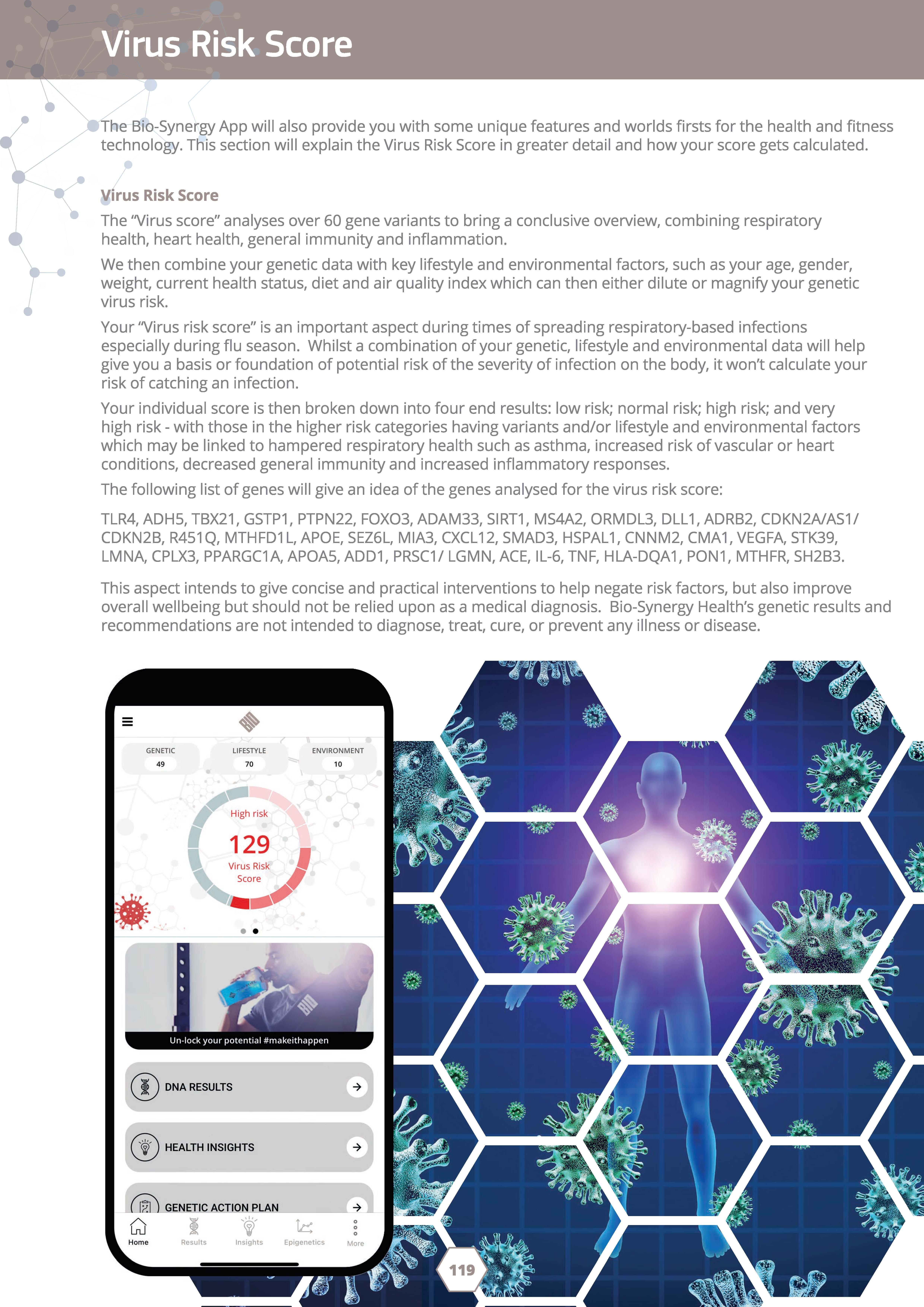
\(irus Risk Score
The 'Virus score" analyses over 60 gene variants to bring a conclusive overview, combining respiratory health, heart health, general immunity and inflammation.
We then combine your genetic data with key lifestyle and environmental factors, such as your age, gender, weight, current health status, diet and air quality index which can then either dilute or magnify your genetic virus risk.
Your 'Virus risk score" is an important aspect during times of spreading respiratory-based infections especially during flu season. Whilst a combination of your genetic, lifestyle and environmental data will help give you a basis or foundation of potential risk of the severity of infection on the body, it won't calculate your risk of catching an infection.
Your individual score is then broken down into four end results: low risk; normal risk; high risk; and very high risk- with those in the higher risk categories having variants and/or lifestyle and environmental factors which may be linked to hampered respiratory health such as asthma, increased risk of vascular or heart conditions, decreased general immunity and increased inflammatory responses.
The following list of genes will give an idea of the genes analysed for the virus risk score:
TLR4, ADHS, TBX21, GSTP1, PTPN22, FOXO3, ADAM33, SIRT1, MS4A2, ORMDL3, DLL 1, ADRB2, CDKN2NAS1/ CDKN2B, R451 Q, MTHFD1 L, APOE, SEZ6L, MIA3, CXCL 12, SMAD3, HSPAL 1, CNNM2, CMA1, VEGFA, STK39, LMNA, CPLX3, PPARGC1A, APOAS, ADD1, PRSC1/ LGMN, ACE, IL-6, TNF, HLA-DQA1, PON1, MTHFR, SH2B3.
This aspect intends to give concise and practical interventions to help negate risk factors, but also improve overall wellbeing but should not be relied upon as a medical diagnosis. Bio-Synergy Health's genetic results and recommendations are not intended to diagnose, treat, cure, or prevent any illness or disease.
GENETIC LIFESTYLE ENVIRONMENT 49 70 1 0 I High risk 129 I VirusRisk I Sco re __ , ® DNA RESULTS ® HEALTH INSIGHTS [;7.] GENETIC ACTION PLAN LJ Resu l ts Insights Epigenetics
As we are all fully aware the pollution levels in our towns and Cities is increasing at an alarming rate and can prove to be extremely detrimental to your health and wellbeing. As they will not only be affected by the variety of foods which you choose to eat each day, but also by your body's ability to remove waste products and toxins known as 'xenobiotics'.
Toxins such as Benzene from pollution will interfere with cell functions, which can lead to the development of many diseases. Your body must be able to remove these toxic substances efficiently before they do significant harm with your liver being the primary organ that carries out this detoxification. Its function is to render toxic substances less harmful, allowing them to be successfully flushed from your body. Other parts of the body that carry out detoxification include the skin, lungs, kidneys and colon.
A healthy immune system is obviously extremely important to us all. As every minute of every day your body is either under attack from toxins, bacteria and viruses or producing reactive oxygen species (ROS), also referred to as free radicals.
Research is demonstrating that free radicals cause oxidative stress and damage your DNA, which leads to ageing and underlies all disease processes, including cardiovascular disease, dementia and diabetes, premature ageing and plays a role in the development of cancer.
A great feature within the Bio-Synergy App is our new pollution tracker, which provides a simplistic score for you to understand the pollution levels in your local area.
Your score is taken from your phones GPS, which is then aligned to the nearest weather station that provides hourly air quality index updates
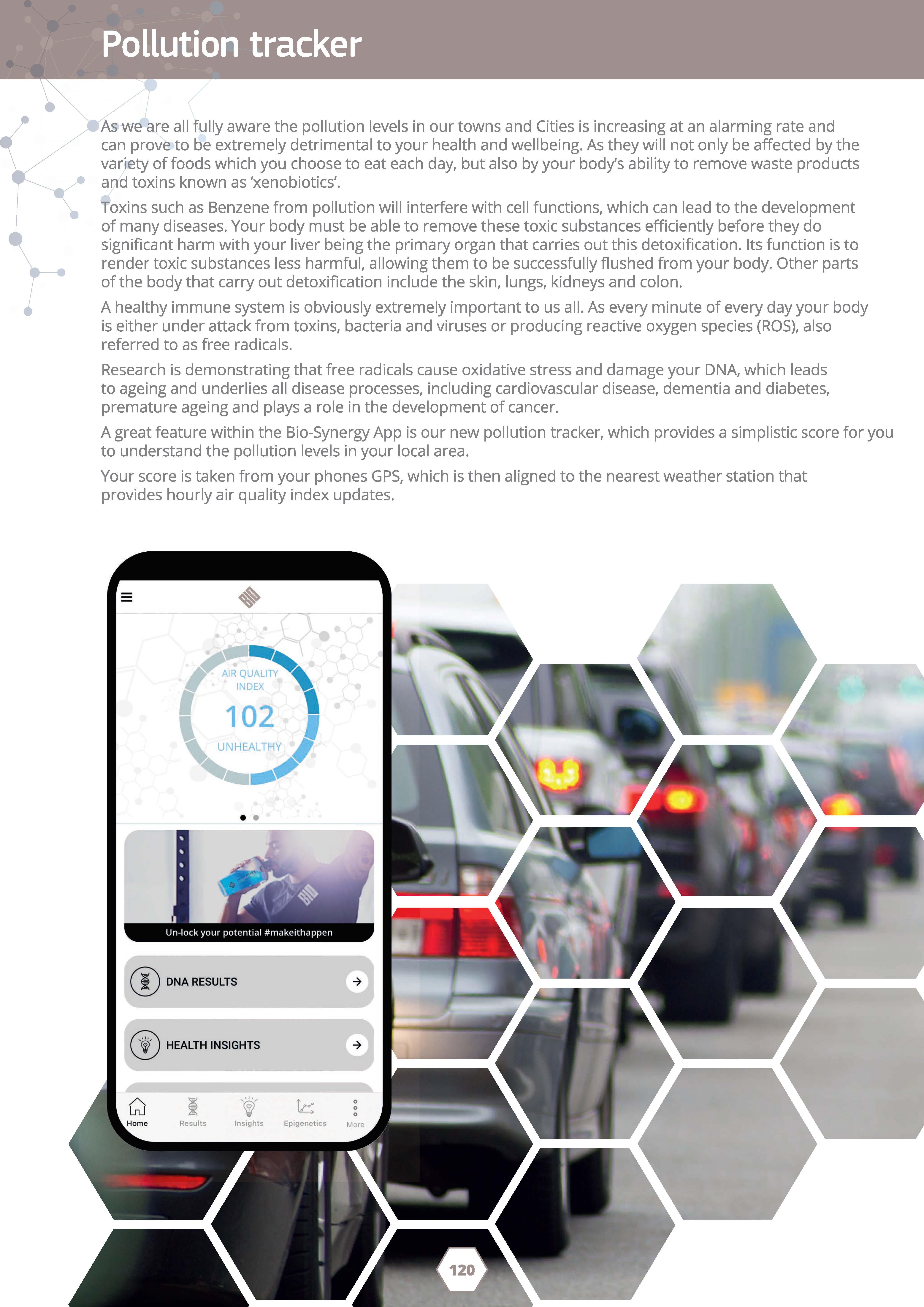
• •
• , "'IRQ~~.. INDEX \ ( 102 I UN HEALTHY , , __ , ® DNA RESULTS ® HEALTH INSIGHTS Results Insights Epigenetics
• •
The next section will explain our genetic action planner in greater detail then move on to goal setting and utilising the SMART goals concept with your clients.
Genetic Action Plan:
Once you have completed the questionnaires the app will produce your Action Plan. The questionnaire is to identify key points about you including, lifestyle, training, nutrition, vitamins, minerals, supplements and medication
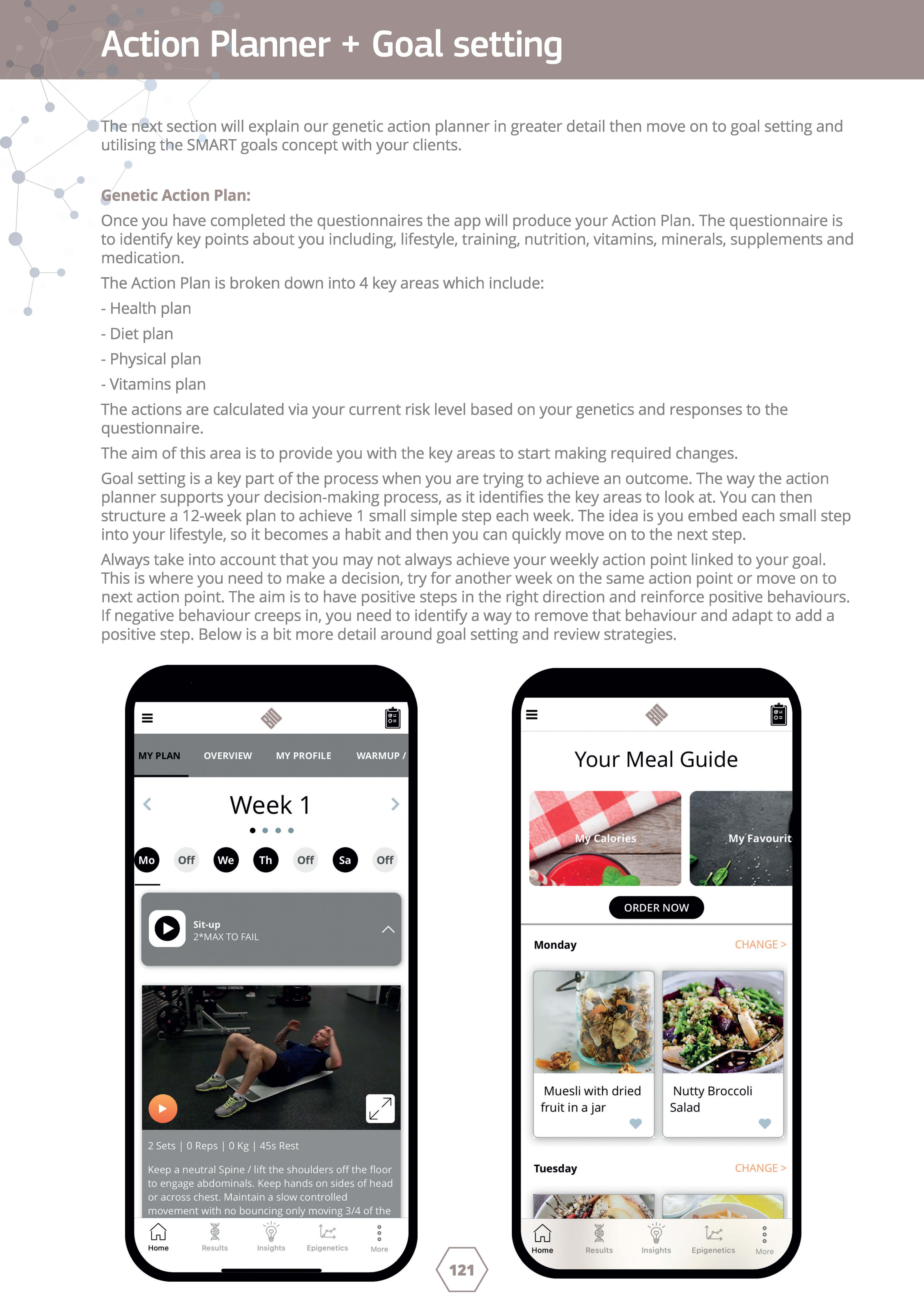
The Action Plan is broken down into 4 key areas which include: - Health plan - Diet plan
- Physical plan - Vitamins plan
The actions are calculated via your current risk level based on your genetics and responses to the questionnaire.
The aim of this area is to provide you with the key areas to start making required changes.
Goal setting is a key part of the process when you are trying to achieve an outcome. The way the action planner supports your decision-making process, as it identifies the key areas to look at. You can then structure a 12-week plan to achieve 1 small simple step each week. The idea is you embed each small step into your lifestyle, so it becomes a habit and then you can quickly move on to the next step. Always take into account that you may not always achieve your weekly action point linked to your goal. This is where you need to make a decision, try for another week on the same action point or move on to next action point. The aim is to have positive steps in the right direction and reinforce positive behaviours. If negative behaviour creeps in, you need to identify a way to remove that behaviour and adapt to add a positive step. Below is a bit more detail around goal setting and review strategies.
Week 1 > • • • • Off O 8 Off e Off 0 Sit-up A 2*MAX TO FAIL Keep a neutral Spine/ 11ft t to engage abdominals Kee or across chest Maintain a ' . Home Results Insights Epigenetics More e Your Meal Guide Monday Muesli with dried fruit in a jar • Tuesday CHANGE> Nutty Broccoli Sa lad • CHANGE> 7 0 0 0 More
• •
Understand how to set and adapt meaningful SMART goals linked to a client's individual needs, wants and motivators .
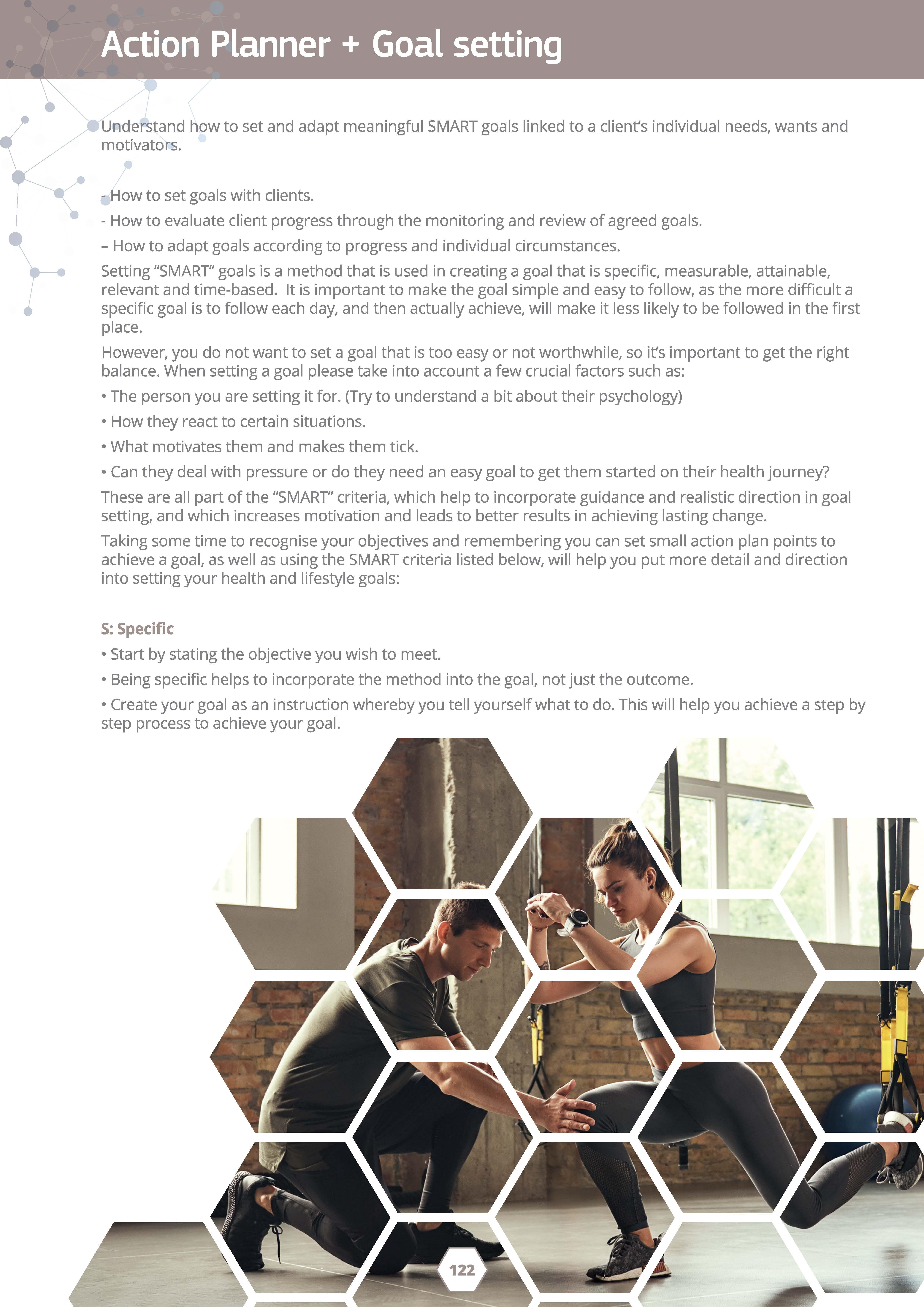
How to set goals with clients
- How to evaluate client progress through the monitoring and review of agreed goals.
- How to adapt goals according to progress and individual circumstances.
Setting "SMART" goals is a method that is used in creating a goal that is specific, measurable, attainable, relevant and time-based. It is important to make the goal simple and easy to follow, as the more difficult a specific goal is to follow each day, and then actually achieve, will make it less likely to be followed in the first place.
However, you do not want to set a goal that is too easy or not worthwhile, so it's important to get the right balance. When setting a goal please take into account a few crucial factors such as:
• The person you are setting it for. (Try to understand a bit about their psychology)
• How they react to certain situations.
• What motivates them and makes them tick.
• Can they deal with pressure or do they need an easy goal to get them started on their health journey?
These are all part of the "SMART" criteria, which help to incorporate guidance and realistic direction in goal setting, and which increases motivation and leads to better results in achieving lasting change.
Taking some time to recognise your objectives and remembering you can set small action plan points to achieve a goal, as well as using the SMART criteria listed below, will help you put more detail and direction into setting your health and lifestyle goals:
S: Specific
• Start by stating the objective you wish to meet.
• Being specific helps to incorporate the method into the goal, not just the outcome.
• Create your goal as an instruction whereby you tell yourself what to do. This will help you achieve a step by step process to achieve your goal.
•
M: Measurable
• Measurable criteria to your goal will allow you to measure progress -you need to state the method of measurement and be specific, so it is valuable, reliable and authentic.

• Measuring results can help you adjust your goals as you work towards meeting your objectives. You need • to be able to measure your goal or otherwise how do you know if you are achieving it.
• A: Attainable
• Make sure you set a realistic goal and it is agreed by both client and trainer.
• Break large goals into smaller goals and spell out the process required to achieve your objectives.
• Make sure that the process is also realistic so that you can achieve all of the individual steps that you need.
R: Relevant
• Your goal should be meaningful to you, set by you and not set by someone else.
• Each step of attaining the goal should make sense.
• The goal should be inspiring enough that it motivates you to succeed. If you are not determined to meet your goal, obstacles will be very difficult to overcome.
T: Time Based
• When will you achieve your goal? You need to choose a time that is realistic but not too far off into the future. You can add in small week action points to achieve the goal and it is easier to stay on track or identify if you are not on target to meet goal in given time period.
The following tips can help you better achieve success in reaching your goals:
• Focus on process goals instead of just an outcome.
• Work on changing behaviours and habits.
• For sustained lifestyle changes, feel free to set long-term goals to keep the big picture in mind.
• Share it with others. It's much more difficult to give up on your goals when others know about it.
• Don't set yourself up for failure.
• Accept and understand that sometimes things happen and failing to reach a goal is part of the learning process. Do not beat yourself up and instead evaluate your progress and your goals to see whether you missed a SMART criterion or step.
•
It is important to make sure you review progress of your clients. Typically, you would review people weekly or monthly. You need to gauge this 1. on the person and 2. on the goal you have set. To ensure clients keep training you must highlight their progress and link it to their actions.
When you monitor and help support your clients then progress reviews are a great tool to identify where a client is in relation to action points or goals. Progress reviews give you a formal opportunity to brain storm with a client and work out why the training approach is or is not working and/or what could be improved. By far this is one of the most valuable uses of your time.
• Progress reviews work to eliminate as much of that risk as possible and, at the same time, provide a client with a very strong perspective on what is going on and how much progress they have truly made!

The objectives when conducting a progress review with a client is to:
• Make sure the client understands the progress they have made (preferably as a % improvement/ achievement towards their actual target). See if the client understands why this progress has happened (essentially what are the key elements to their success). Or if progress has not occurred why and what can now be done to rectify it moving forwards.
• Try to remove any barriers that your client has put in the way of achieving a goal and help them form good habits and lifestyle changes to enable them to make adaptations and start making progress. Make sure the client understands what their next training month will look like and agree to the implementation of any changes in what they do and what you are doing to support them.
Remember, deadlines create urgency. Targets create focus. Seeing progress creates further motivation. Once the training behaviour and quality is established you can stretch the review cycle.
The key is if a client hasn't made any progress then typically all that is required is monitoring and support. Unless you want to shock them, a full review of progress where there is none is definitely de-motivating. If your client isn't training well/consistently, then you should pick it up within days and action the intervention strategy you established in the clients initial training plan. Don't use client progress reviews to tell clients off.
• Allows tracking of what were until recently invisible genetic markers within the body that will change far earlier than blood markers, physical signs and symptoms.
• These markers can be early indicators of potential health issues and by tracking them preventative • measures can be put in place to slow down or stop these processes. The great part is that multiple tests • can track these changes
• It gives you a visual insight to show the benefits of exercise and correct nutrition aligned to your genetic makeup
Epigenetic tracking
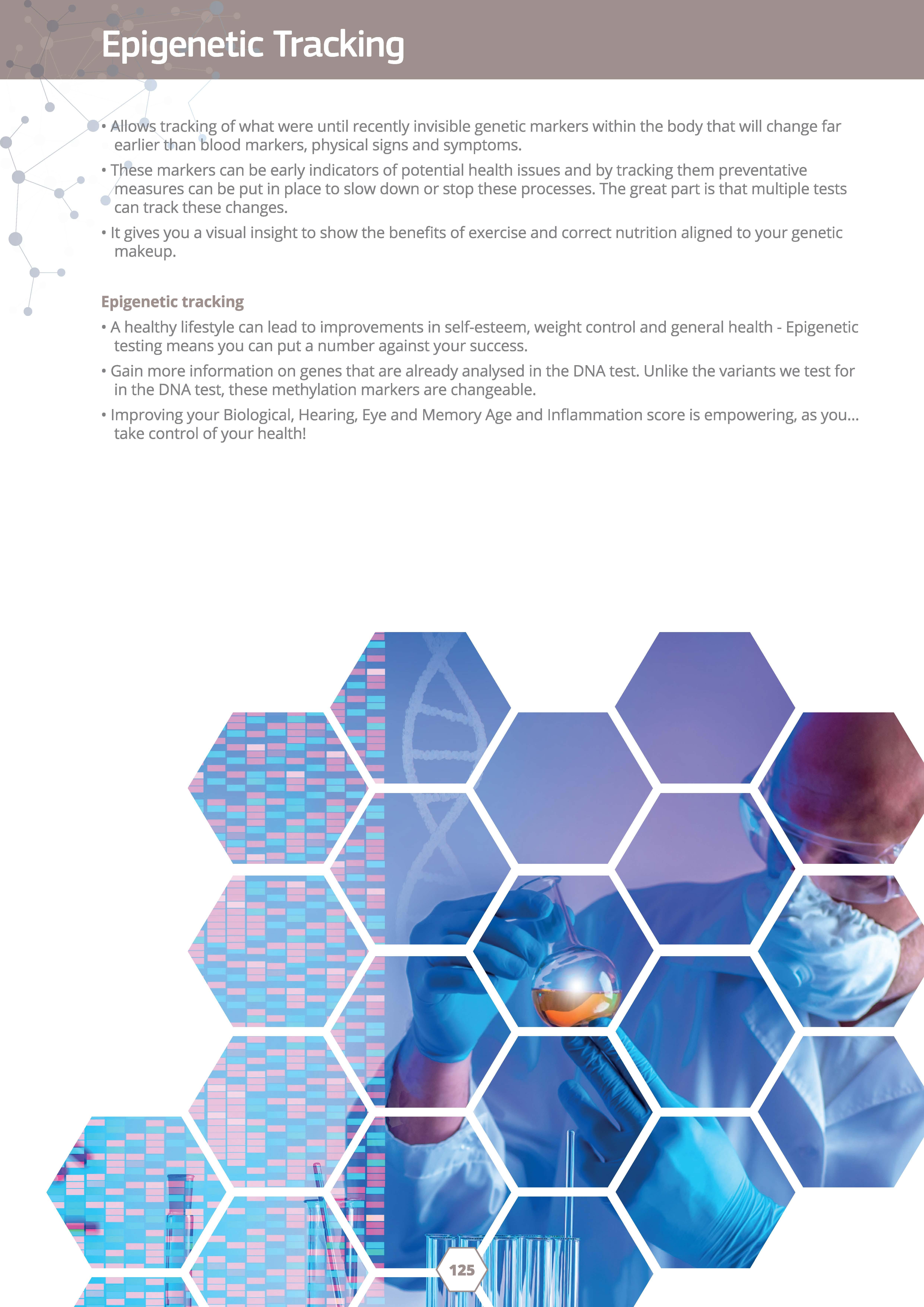
• A healthy lifestyle can lead to improvements in self-esteem, weight control and general health - Epigenetic testing means you can put a number against your success.
• Gain more information on genes that are already analysed in the DNA test. Unlike the variants we test for in the DNA test, these methylation markers are changeable.
• Improving your Biological, Hearing, Eye and Memory Age and Inflammation score is empowering, as you take control of your health!
•
The DNA Diet alongside the Virus Risk Score is also another world's first.
The DNA Diet calculates a unique diet aligned to both your DNA, food preferences such as vegan, gluten or dairy free as well as your chosen goal.

Once you have answered a few easy lifestyles questions your diet will be calculated, which will then
• provide you with a whole variety of interesting areas, such as Genetic Calories Burn Rate, Caloric Daily Split, Macronutrients, Water Intake, Supplements and selected Recipes aligned with your food preferences, goal and genetic vitamin and mineral deficiency risks
•
Buckwheat crepes with pears Brea k fast 4 SER VING 329 .0Ca or es 1 6.5 Prot ein I 5 1.8Ca r bs I 21.2 Suga r 11 6 Satu rated Fat 111 1 Fi bre I 1.oSo di um I 11. 8Fa DIRECTIONS 60 g I buckwheat flour 60 g I g lu ten -free pl ain flour mix 1 I large egg 125 ml I soy milk 125 ml I water 1 pinch I sa lt IL'.: Hom e Results Insights Epigenetics More A g lu tenfre i vegan burger mad e from chickpeas, millet an d sweet potatoes Lunch 6 SERVING 404.0 Calor es I 5 8 Pro t ein I 62.0 Carbs I 1 1.8 Suga r I 1.4 Satu rated Fat I 12 1 Fib re I 0 699 Sod ium I 18.6 Fa 140 g I sweet potato 88 g I millet 225 ml I water DIRECTIONS 240 g I canned chickpeas (garbanzo beans) 2 cloves I gar li c (),; I 11n1M::1vo:>rl lo:>mnn IL'.: Insights Epigenetics More Thi s i s sp lit into: Mea l 1: 506 kcal Meal 2: 1012 kcal Mea l 3: 506 kcal The recipes that are given may need to be altered by ei t h er in creasi ng or decreasing t h e ingredients to meet you r da il y kcal total and to meet your macros. RECOMMENDED DIET LJ H ome Results Insights Epigenetics More Dairy-free Tuna and Seafood Stew with Cou scous Di n ne r 4 SERVING 499 .0 Calori e s I 6 9.0 Prote in I 24.6 Ca rbs I 5.2 Sugar I 1.6 Satura t ed Fat I 2.5 Fib re 1 1.106 So di u m I 11 .8 Fat 1 INGREDIENTS +·OMSIHUM Hea t the o li ve oi l in a la rge saucepa n set over a moderate heat until hot. Add the gar li c and fry for 30 seco nd s before stirr ing in the couscous. Cook for a further m inute and then cover 2 w it h the stock and passata. Stir we ll and brin g the broth to a simmer Home Cover and cook over a reduced h eat for 10 mini 1tp, c; c:t ir ri n o- nrr;:ac: inn ;:alh, Arlrl thP Results Insights Epigenelics More
•
•
•
Once you have read through your results, the next step is to go to the training guide, which provides.
• Workout plan.
• Warmup/cool down.
• Injury prevention
• Lower Body Injury Prevention.
• Whole Body Home Injury Prevention .
Workout Plan
This option will take you to an online consultation where you will be asked to answer a few quick and easy questions.
Your answers will help us understand you better and will be linked with your DNA results to provide you with personalised training advice and planner.
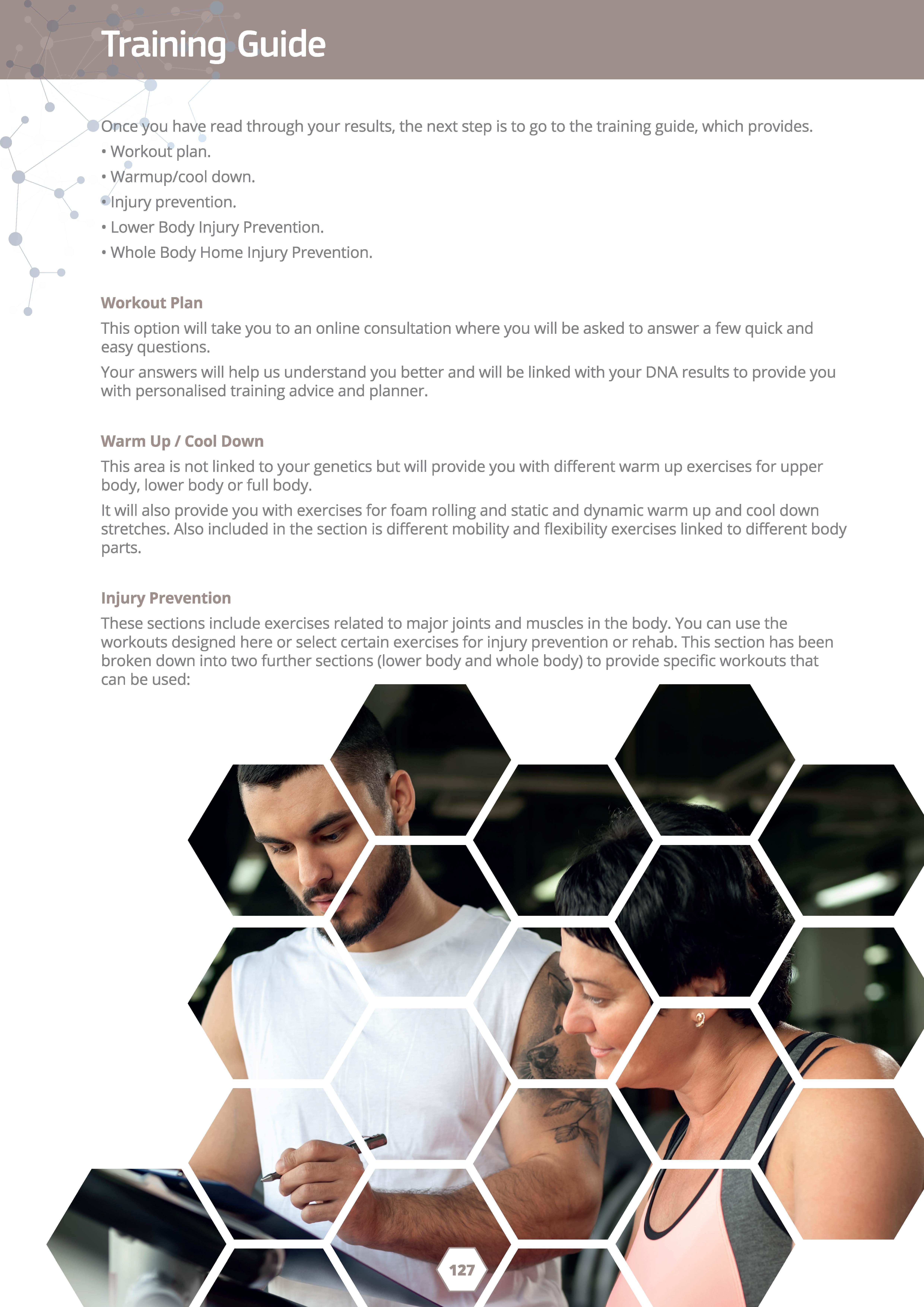
Warm Up/ Cool Down
This area is not linked to your genetics but will provide you with different warm up exercises for upper body, lower body or full body.
It will also provide you with exercises for foam rolling and static and dynamic warm up and cool down stretches. Also included in the section is different mobility and flexibility exercises linked to different body parts.
Injury Prevention
These sections include exercises related to major joints and muscles in the body. You can use the workouts designed here or select certain exercises for injury prevention or rehab. This section has been broken down into two further sections (lower body and whole body) to provide specific workouts that can be used:
•
Across the top of the exercise section you will be able to view your genetic workout plan, change your goal and you can "favourite" different workouts from other sections including injury prevention, warm up I cool downs and training from the wellness section.
•
Finally, you will be provided with an overview. This will include different goals - strength, hypertrophy, endurance and cardiovascular training. Within each area it will explain sessions per week, rest days, sets, reps, rest, time under tension and different training systems.
When designing a training plan there are some important factors to also take into consideration:
• Periodisation
• Goal - psychology
• Consultation
• GAP analysis
•Screening/ testing
•Volume/ load / intensity
• Accumulation of training over time
• Nutrition
• Supplements
• Sleep
• Stress
• Lifestyle/ commitments
• Wellness reports
Never take one area in isolation, as they are all interlinked, which was briefly explained above in earlier sections.
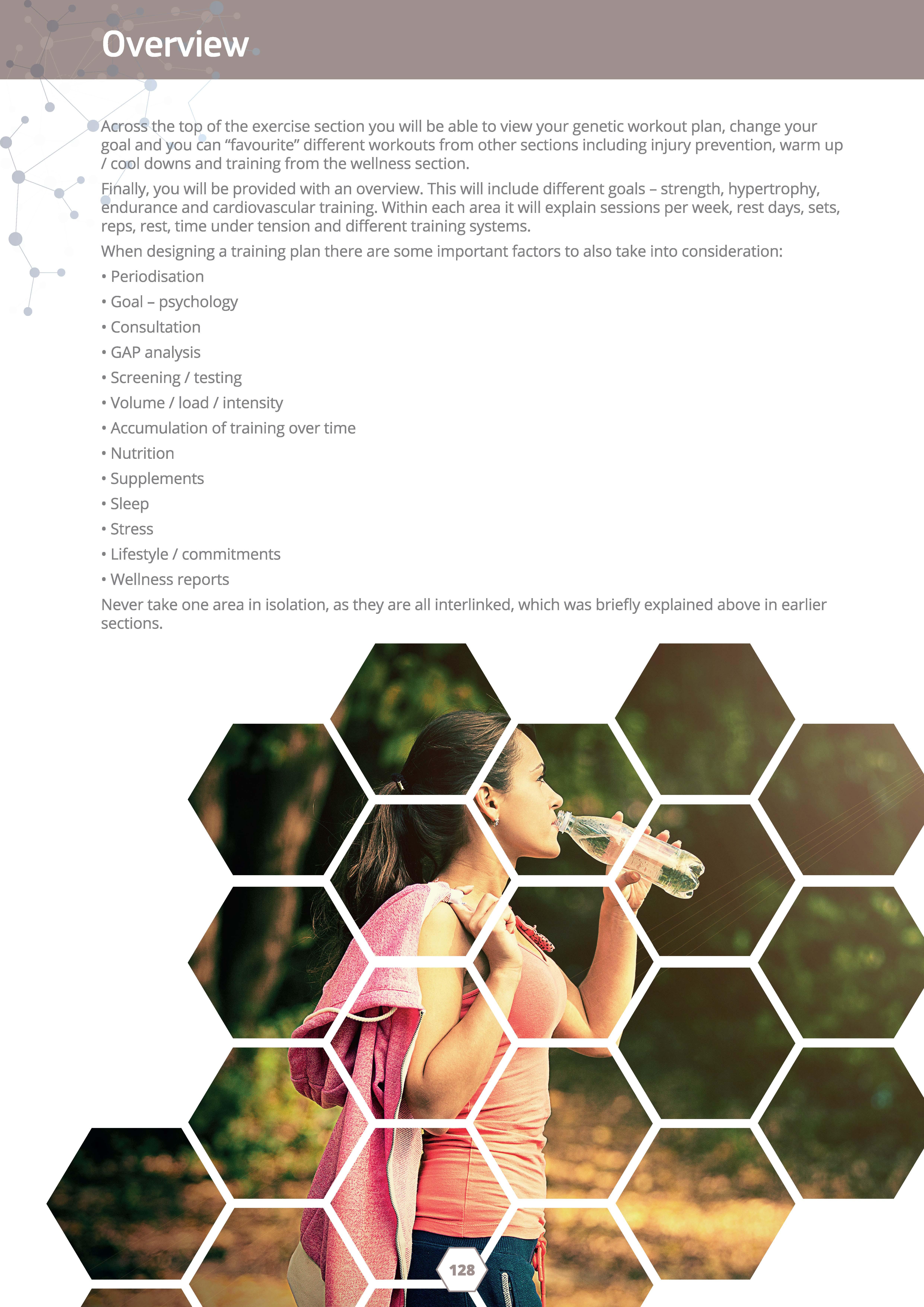
Bio-Synergy understand that if you cannot track and then understand the small subtle changes that you make to your lifestyle, and the effect that they can have on your health, then in many instances it will be hard to stay motivated and continue with those positive habit and lifestyle changes.
The good news is that with Bio-Synergy you can actually start to track and see how the effects of your day-toclay life such as your diet, exercise, stress, sleep as well as your environment are having on your genes and internal health.
Bio-Synergy provides a fully interactive preventive and curative solution, available 24/7
A genetic health profile addresses a range of personal risk factors that include excess weight, inactivity, issues associated with ageing, nutrition and emotions.
Our engaging genetic health insights provide motivation for reduced reliance on clinical interventions and medication, together with lessening the pressure of worker sickness absence and associated costs.
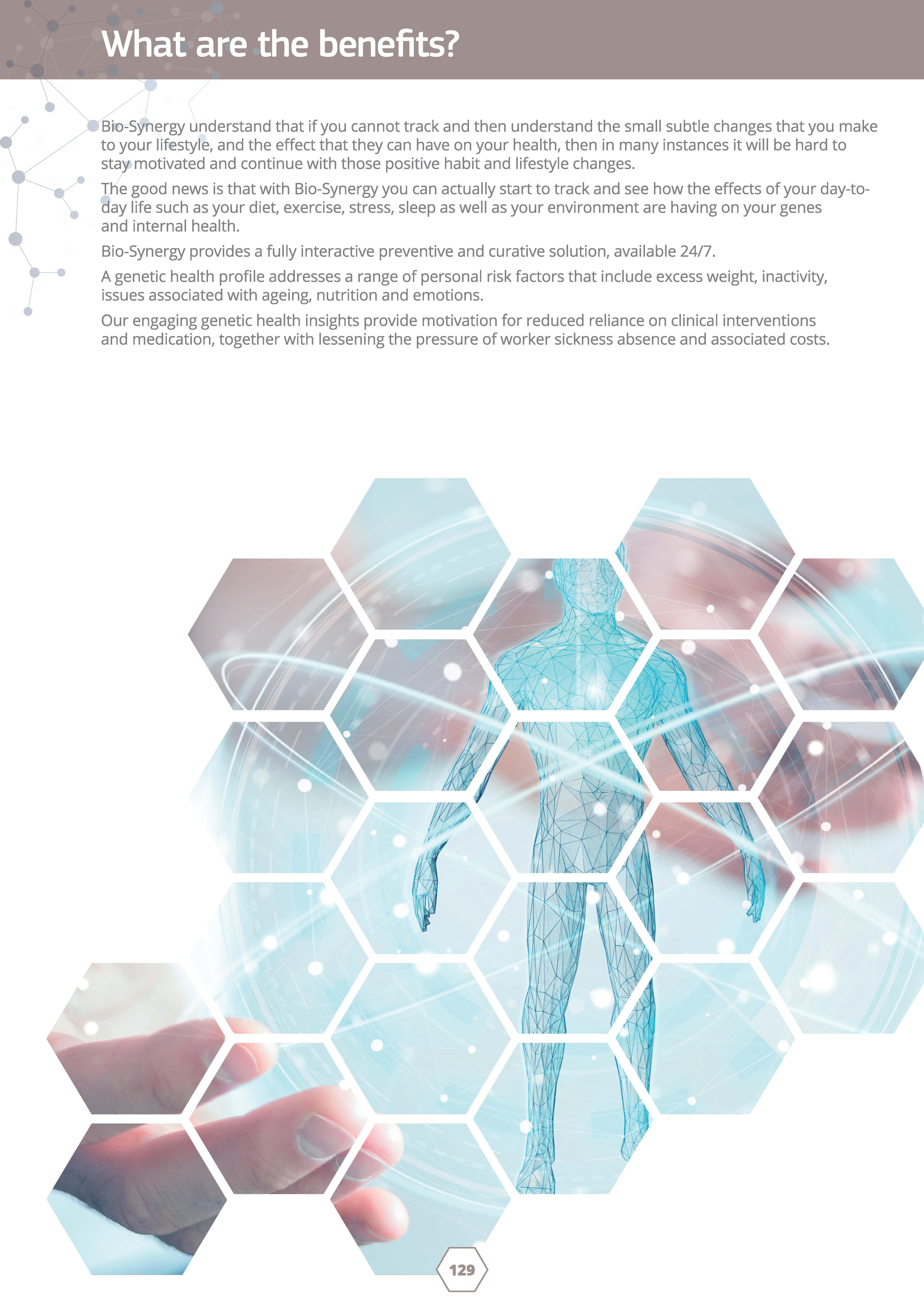
• •
ii e
,r
• •
DNA and epigenetic testing help you to understand the individual and unique requirements of your clients, helping with their performance, nutrition, recovery and overall health.
Discover the advantages of looking at all health areas, both individually and collectively. How they interact and work in synergy, affecting a variety of health outcomes, such as sleep, stress and injury, etc.
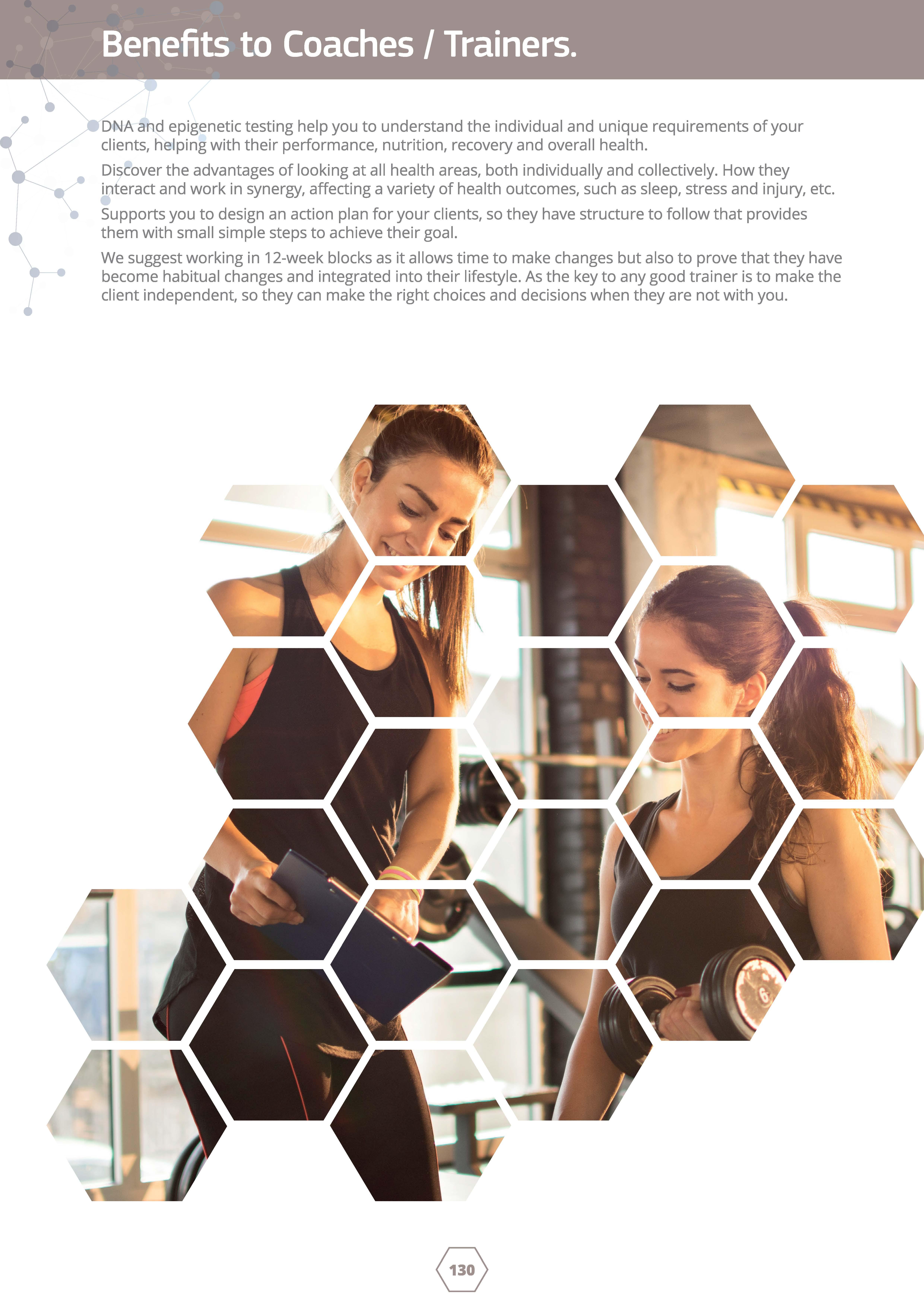
Supports you to design an action plan for your clients, so they have structure to follow that provides them with small simple steps to achieve their goal.
We suggest working in 12-week blocks as it allows time to make changes but also to prove that they have become habitual changes and integrated into their lifestyle. As the key to any good trainer is to make the client independent, so they can make the right choices and decisions when they are not with you.
e
Nutrition
Provide the correct energy and recovery through a balanced diet including necessary vitamin, minerals and supplements linked to their genetic outcomes.
Also understanding the importance of your gut health is critical to the absorption process of key nutrients such as minerals, which act as the spark plug for every metabolic reaction within the body.
Performance
Genetic insights surrounding key areas such as:
• Muscle power and Stamina.
• 02 Usage.
• Lactate Threshold
• Recovery.
• Soft tissue Inflammation.
Will enhance your ability to design and plan more effective and tailored programs for your clients, to maximise their results whilst minimising the chance of injury.
Lifestyle
Identify the key lifestyle areas and predispositions that might affect your clients, enabling you to improve their sleep, stress levels and overall health and longevity.
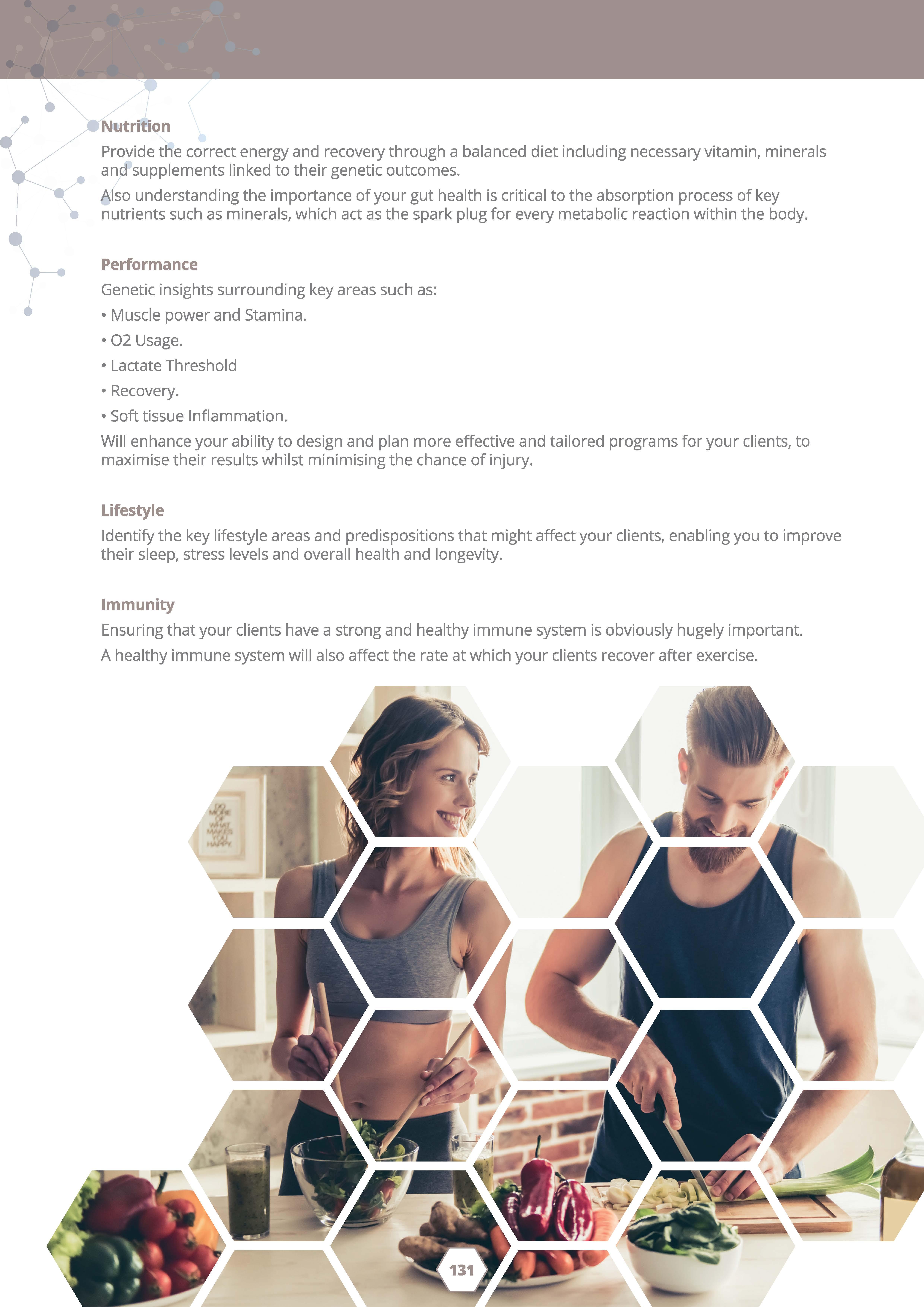
Immunity
Ensuring that your clients have a strong and healthy immune system is obviously hugely important. A healthy immune system will also affect the rate at which your clients recover after exercise.
•
lrrcrease your income
Improve client retention and growth by achieving your client's goals quicker, more efficiently and effectively, meaning your client can maintain their results
Increase your own productivity
By understanding your body at a genetic level and following the recommended actions, you will improve your overall health which will allow you to increase productivity. This will help you to be more time efficient and enable you to add more clients to your business.
Understand your clients better
Take the guesswork out of the support you provide your clients and interact with them on a more personal level. You'll be able to communicate with your clients in a way that builds trust and be able to identify lifestyle changes that will really support your client when they are not with you.
Hyper-personalised plans
Via the Bio-Synergy app you'll have access to a genetically matched overview to support you with planning lifestyle change, including nutrition and training. Again, this will support you to help the client become more independent when they are away from you, which means you can achieve more sustainable results.
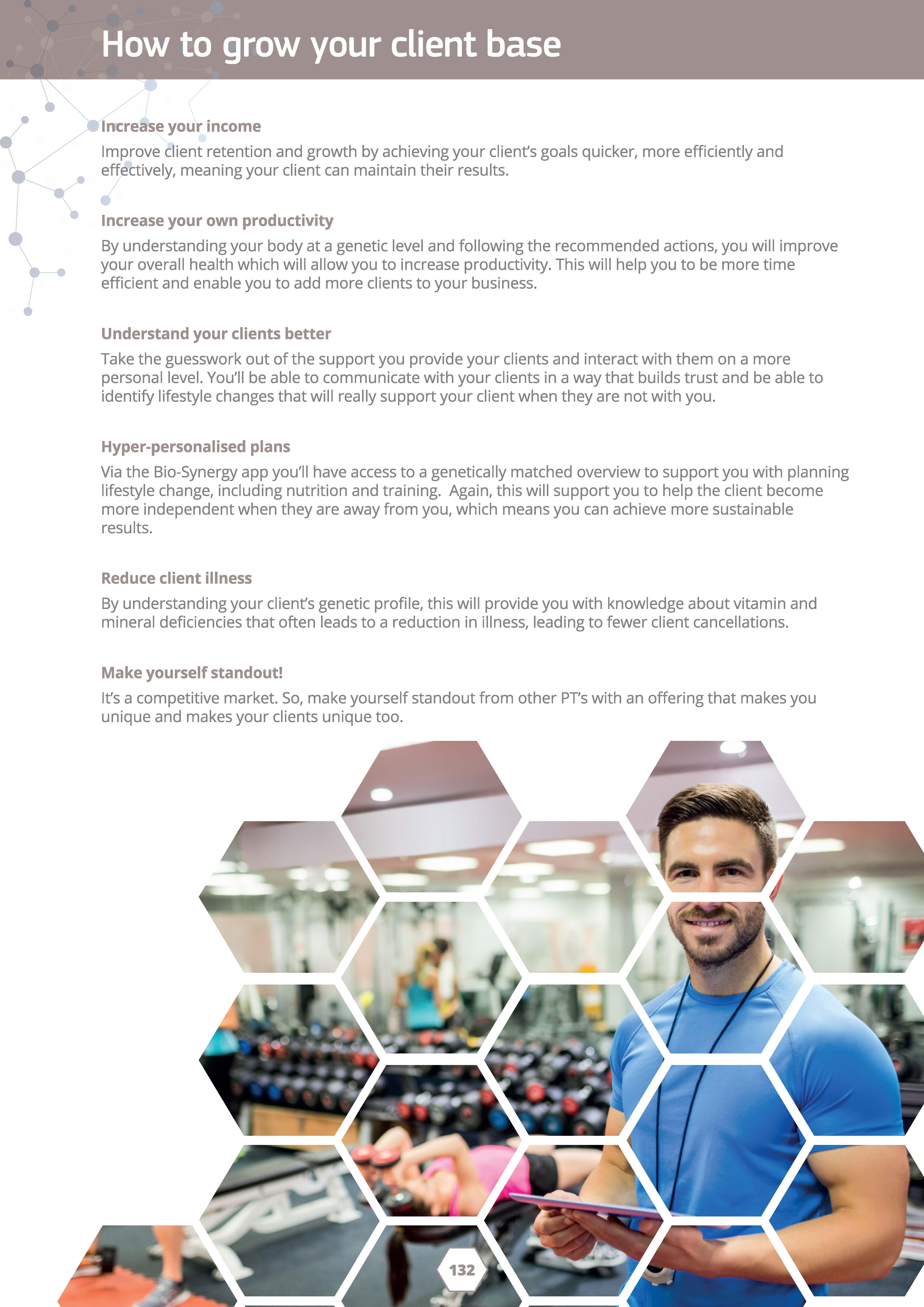
Reduce client illness
By understanding your client's genetic profile, this will provide you with knowledge about vitamin and mineral deficiencies that often leads to a reduction in illness, leading to fewer client cancellations.
Make yourself standout!
It's a competitive market. So, make yourself standout from other PT's with an offering that makes you unique and makes your clients unique too.
• •

.... / . • e


